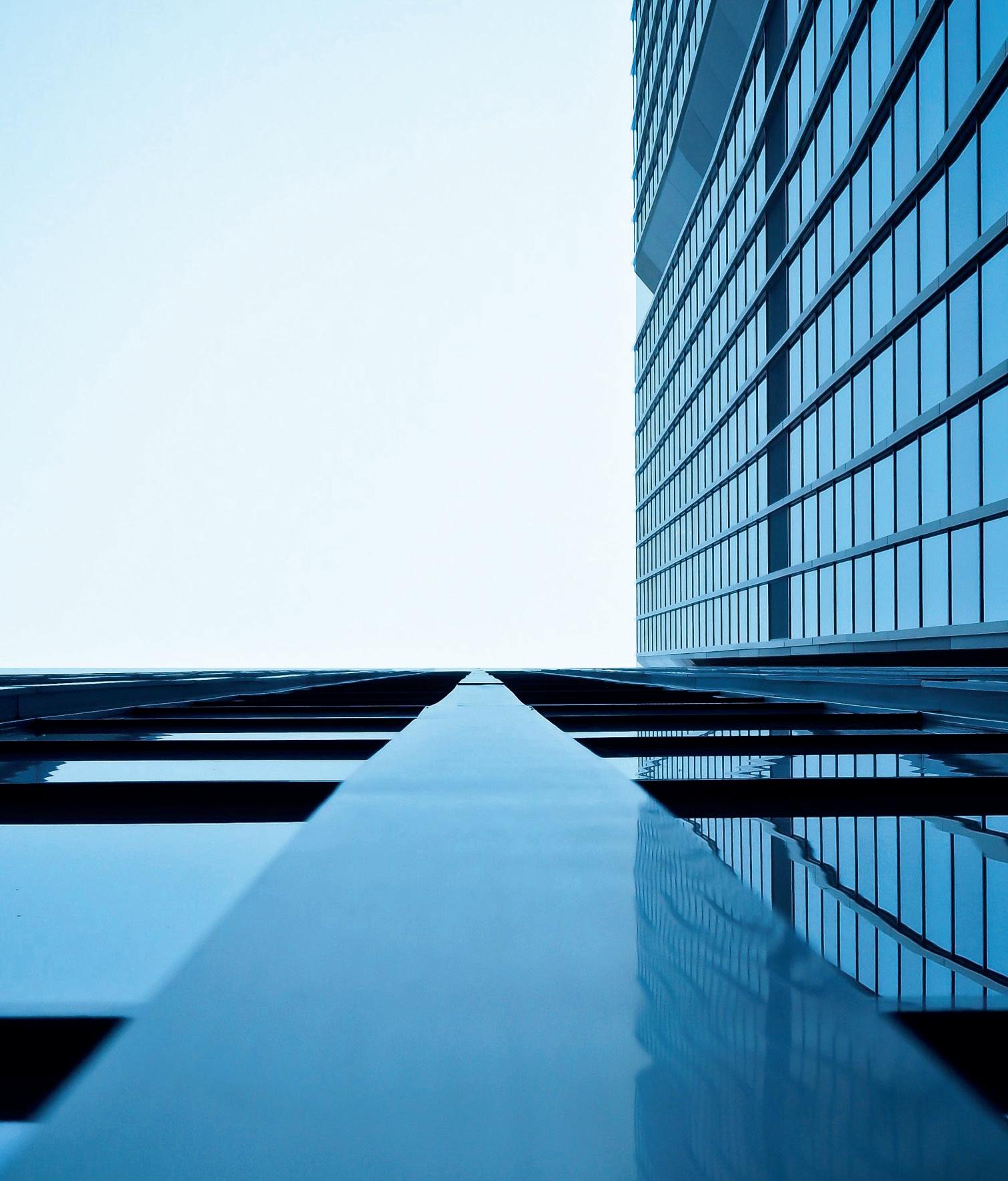




LEADING INNOVATION IN THE AGE OF DIGITAL TRANSFORMATION

Un evento in collaborazione con Milano Audiovisual Forum
29-30 Ottobre
Fiera Milano Rho
Centro Congressi Stella Polare






LEADING INNOVATION IN THE AGE OF DIGITAL TRANSFORMATION

Un evento in collaborazione con Milano Audiovisual Forum
29-30 Ottobre
Fiera Milano Rho
Centro Congressi Stella Polare
PENTASTUDIO SRL Editore
PAOLO DALLA CHIARA Presidente pdallachiara@pentastudio.it
LUCA BALDIN Direttore responsabile lbaldin@pentastudio.it
CHIARA BENEDETTINI Direttore editoriale c.benedettini@connessioni.biz
ILARIA REBECCHI Capo redattore irebecchi@pentastudio.it
GRAZIELLA PIVATO Art director gpivato@pentastudio.it
MONICA BASSAN Graphic designer mbassan@pentastudio.it
Contributi
CHIARA BENEDETTINI, MARIA CECILIA CHIAPPANI, MATTEO FONTANA, MICHELE FUCCI, NICOLA MARTELLO, SIMONE MADONI, MARCO PELLEGRINATO, JULIA POPESCU, ILARIA REBECCHI
CLAUDIA DI TRANSO Segreteria di redazione cditranso@pentastudio.it
PENTASTUDIO SRL Advertising Pedemuro San Biagio 83, 36100 Vicenza, Italy Tel. +39 0444 543133 info@pentastudio.it connessioni@pentastudio.it www.pentastudio.it www.connessioni.biz
LOGO SPA Stampa Borgoricco (PD)
CONNESSIONI MAGAZINE
publication is edited in Italy by Pentastudio (all right reserved) www.pentastudio.it
Registrazione del Tribunale di Pesaro N. 540 del 09/10/2006
©2024 Pentastudio S.r.l., tutti diritti riservati. Nessuna parte della pubblicazione può essere riprodotta in qualsiasi forma rielaborata con l'uso di sistemi elettronici senza l'autorizzazione dell'editore. Testi, fotografie e disegni: riproduzione vietata © Tutti i diritti di riproduzione in qualsiasi forma, compresa la messa in rete, che non siano espressamente per fini personali o di studio sono riservati. Per qualsiasi altro genere di utilizzo è necessaria l'autorizzazione da parte di Pentastudio S.r.l.. Qualsiasi tipo di materiale inviato in redazione, anche se non pubblicato, non verrà in alcun modo restituito. Non si risponde per eventuali attribuzioni, fedeltà nei colori e notizie soggette a variazioni.
06 12 16 21 22 28 32 38 40 44 46
Quale evoluzione per la TV broadcast?
MAF - MILANO AUDIOVISUAL FORUM 2024
Una tecnologia, cento canali, mille Broadcaster
Un Broadcasting “prêt-à-porter”
EMG Italy, le migliori tecnologie broadcast per sport ed eventi live
La rete di digital signage di Screenlight per Autostrade
Broadcast e sport?
Tutta la versatilità che serve
Post produzione senza confini con Digitalis Multimedia
Un secolo di Radio Rai fra tradizione e innovazione
ANIBA al MAF 2024: Innovazione e Qualità nel Broadcast TV Italiana
L'evoluzione dei LED nel Broadcast: Virtual Set e oltre
L'evoluzione dell'illuminazione nel mondo del Broadcast professionale: dai sistemi tradizionali ai LED
p. 6
Virtual Production dall’A alla Z con Audiosales
Contacta per i bambini dell’Istituto Statale per Sordi di Roma
Installazione e rental, due anime di un’innovazione costante
Conferenze di qualità a misura di integratore
SMART BUILDING LEVANTE: l’appuntamento fondamentale del mezzogiorno per l’innovazione dell’edificio
Smartbuilding.edu@Didacta Italia 2024 Per scuole moderne e inclusive
Tecnologia e Natura: circolo chiuso o corto circuito?
Viaggio stampa con Harman Il reportage
Passato, Presente e Futuro delle Virtual Production
Intelligenza artificiale un futuro di innovazione e opportunità
BRAND LIST
Audiosales www.audiosales.it
Exertis http://exertisproav.it
Blackmagic Design www.blackmagicdesign.com/it
Frenexport www.frenexport.it
Hikvision www.hikvision.com
Prase Media Technologies www.prase.it
ScreenLight www.screenlightsrl.it
Lavorare a questo numero è stato molto stimolante: ha dato la possibilità a tutta la redazione di approfondire l’evoluzione in atto nel settore Broadcast, teatro in questi ultimi anni di ibridazioni interessanti con il mondo dell’AV professionale, dal punto di vista delle tecnologie ma specialmente del mercato. In passato abbiamo più raramente parlato di Broadcast perché, anche se dal punto di vista tecnologico la distanza era relativa, da quello del mercato e degli operatori era piuttosto ampia, con dinamiche diverse, operatori concentrati sul proprio settore, fiere autonome.
Oggi invece l’AV Broadcast sta in qualche modo traghettando tutto il settore verso una maggiore integrazione con l’AV pro, tanto che lo si sta cominciando a considerare un vero e proprio settore verticale di applicazione.
Le tecnologie di trasmissione e produzione di contenuti sono diventate più accessibili, permettendo una maggiore produzione di contenuti di alta qualità.
Le aspettative dei consumatori per video e audio di alta qualità sono elevate, e stanno spingendo i progetti audiovisivi a migliorare sempre più il livello.
L'era digitale ha portato a un boom dello streaming, con una forte domanda di contenuti live e on demand: eventi dal vivo, concerti e conferenze con configurazioni audiovisive sofisticate. La conseguenza è una crescente produzione di contenuti video di qualità Broadcast anche in settori educativi, alberghieri e commerciali, segnando un importante cambiamento nelle comunicazioni. Dal lato delle tecnologie, l’IP sta rivoluzionando la trasmissione AV, offrendo infrastrutture più flessibili ed efficienti. Insomma, un settore in grande evoluzione di cui Connessioni magazine si occuperà sempre di più, a partire da questo stesso numero, sulla base di un progetto di sviluppo su due filoni che procederanno in via sinergica: da un lato quello editoriale, dall’altro MAF – Milano Audiovisual Forum – il nostro evento sviluppato in collaborazione con Fiera Milano e HD Forum, che si svolgerà il 29 e 30 ottobre prossimi.
Durante MAF verrà fatto il punto sul settore della produzione e distribuzione di contenuti audiovisivi grazie ai maggiori esperti e player del settore, con occhi puntati verso tutti gli operatori, dai produttori agli editori, dai system integrator ai distributori alle rental company, fino alle società di comunicazione e di pubblicità. Appuntamento per tutti a Milano il 29 e 30 ottobre 2024.
Artificial Intelligence a Future of Innovation and Opportunity
How will TV broadcasting evolve in the future?
MAF - MILANO AUDIOVISUAL FORUM 2024
A single technological solution, one hundred channels, one thousand broadcasters
‘Ready-for-use’ broadcasting
EMG Italy the best broadcasting technologies for sport and live eventse
Screenlight digital signage network for Motorways
Broadcasting and sports? Fully versatile solutions
Unlimited post-production with Digitalis Multimedia
Rai Radio celebrates 100 years of broadcasting Tradition and innovation
ANIBA at MAF 2024: Innovation and Quality in Italian Broadcast
The evolution of LEDs in broadcasting: Virtual sets and beyond
A focus on Broadcasting/IP
The evolution of lighting in the world of professional broadcasting: from traditional systems to LEDs
Virtual Production from A to Z with Audiosales
Contacta assists the children of the State Institute for the Deaf in Rome
Installation and rental services: two key elements within a sphere of constant innovation
High-quality conferences enhanced by integration
SMART BUILDING LEVANTE: a key appointment in Southern Italy for the innovation of buildings
For modern and inclusive schools
Technology and Nature: a closed circle or a short circuit?
Press trip with Harman The reportage
The Past, Present and Future of Virtual Production


29 | 30 OTTOBRE 2024
Centro Congressi Stella Polare Fiera Milano Rho
Working on this issue has been a very stimulating experience. I have had an opportunity to delve more deeply into the ongoing evolution of the broadcasting sector and I imagine all of my colleagues in the editorial team would share my feelings. We have been able to learn more about this scenario, which in recent years has undergone interesting forms of hybridisation with the world of professional AV, considering technology and, in particular, the relative market itself. In the past we have rarely focussed on broadcasting. From the technological point of view the distance was a relative factor, but with regard to the market and operators the division was fairly distinct. In this sense we may note that there were diverse dynamics: operators concentrating only on their own sector, separate trade fairs and so on. Nowadays, however, AV broadcasting - which, by way of a modern convention, we would now refer to as the field of Virtual Production - is in some way drawing the entire sector towards a higher degree of integration with pro AV and to such an extent that one may now consider the sector as an authentic ‘vertical’ area of application. Content transmission and production technologies have become more accessible, allowing for a more extensive generation of high-quality content. Consumer expectations with regard to high-quality video and audio are elevated and act as a stimulus, whereby audiovisual projects are constantly induced to raise the level of their quality. The digital age has led to a boom within the sphere of streaming. There is a strong demand for live and on-demand content, such as live events, concerts and conferences with sophisticated audiovisual setups. Consequently, there is an ever-growing production of high-quality video content also in the educational, hotel accommodation and commercial sectors, marking an important change in communication. With respect to technology, IP is revolutionising AV transmission, offering more flexible and efficient infrastructures. In short, this is a highly evolving sector which Connessioni will investigate more and more, starting from this very issue of the magazine, following a development project along two lines, which will proceed in a synergic manner. On the one hand we will produce editorial overviews and on the other we will continue our studies through the Milan Audiovisual Forum (MAF), the event we have developed in collaboration with The Milan Trade Fair and the HD Forum, which will take place on 19 and 30 October 2024. The HD Forum will examine the current status of the sector dedicated to the production and distribution of audiovisual content thanks to the presence and participation of leading experts and operators in the field. The forum in fact attracts all operators, from producers to publishers, system integrators, distributors to rental companies, and communication and advertising companies.
We look forward to seeing all of you in Milan on 29th and 30th October this year.
Marco Pellegrinato
Quest'anno si celebra in Italia un doppio anniversario, assai importante per il mondo della Comunicazione: i cent’anni della Radio e i 70 anni della Televisione
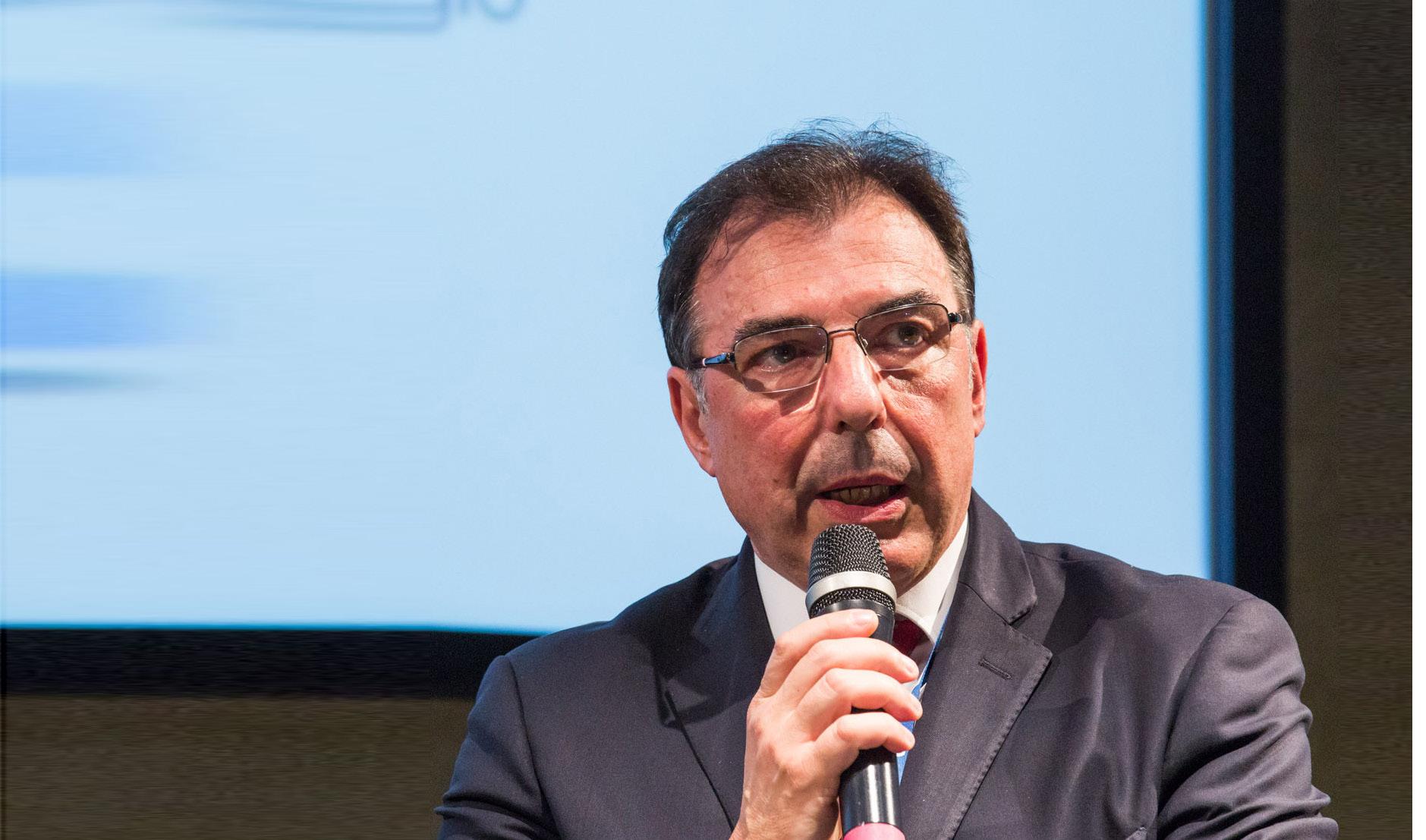
Marco Pellegrinato Standard & Innovation Advisor - Gruppo MEDIASET

Negli anni '50, le TV erano ingombranti, con schermi piccoli e immagini in bianco e nero sbiadite. Oggi, la televisione è evoluta: schermi sottili, grandi, luminosi e a colori, offrendo un'esperienza visiva straordinaria.
La televisione per gli italiani è un fatto esistenziale. Sin dalla sua comparsa nel ‘54, ha caratterizzato la vita degli italiani, la loro storia con le proprie radici, la loro formazione con la propria cultura. Agli albori, la TV si fruiva dapprima in spazi socializzanti, generalmente al bar sotto casa per poi entrare a far parte dell’arredo domestico con uno spazio tutto suo per sviluppare gran parte della nostra formazione, nonché dell’arricchimento della nostra identità culturale, ma anche e soprattutto del vivere il nostro intrattenimento quotidiano.
Agli albori, la televisione ha caratterizzato principalmente le nostre serate con programmi leggeri di informazione o di intrattenimento come i giochi a quiz, prodotti nella fattispecie dalla RAI-Radio audizioni Italia, dapprima EIAR (Ente Italiano per le Audizioni Radiofoniche) dal 1944, poi divenuto RAI-Radiotelevisione italiana il 3 genn. 1954 quando la RAI iniziò il servizio di radiodiffusione Televisiva.
Col tempo, la televisione ha caratterizzato sempre più momenti della nostra quotidianità, il pomeriggio con la televisione dei ragazzi con programmi di formazione didattica e successivamente in occasione di eventi fieristici, con una programmazione di vecchi Film. Oggi, anche se non ce ne rendiamo conto, la televisione tradizionale, o una sua evoluzione, ci fa compagnia in gran parte della giornata, caratterizzando profondamente il nostro vivere quotidiano, informandoci su tutto, e a volte sin con troppa veemenza.
Da TV generalista è divenuta prima multicanale e poi tematica, nel senso che sono presenti diversi canali con tipologie di offerta differenziata, così da soddisfare i gusti più diversificati degli ascoltatori, ma anche con alcune centinaia di canali di

I televisori hanno subito una notevole evoluzione nelle dimensioni. Oggi, schermi da oltre 100" sono comuni nelle case italiane, con una media di 48"-52" per i flat screen residenziali e una crescente diffusione di TV da 65", 75" e persino 100".
informazione locale, regionale, nazionale che forniscono qualsiasi tipo di notizie, telegiornali, informazione e dibattiti a qualsiasi ora.
Il Centenario della Radio, insieme ai settant’anni della Televisione, sono eventi di peculiare importante dato che, in questi decenni di Radio e TV, essi sono stati profondamente attraversati da un’evoluzione straordinaria, una trasformazione che parte proprio dalla forma e dalla dimensione del televisore: il mezzo di comunicazione di massa per eccellenza.
Negli anni 50, l’apparecchio televisivo era assai voluminoso, dotato di uno schermo molto quadrato, con immagini in bianco e nero assai sbiadite. Aveva una caratteristica particolare, era una scatola ingombrante e pesante, molto profonda, sebbene la superficie visiva fosse assai ridotta (< 15 pollici) e dotata di una risoluzione minima. Ciononostante, ebbe un grande successo! In tutti questi anni la televisione ha vissuto un evoluzione straordinaria, che ha toccato molteplici aspetti qualitativi, diventando più luminosa e dotata di immagini a colori sin dagli anni 70, migliorando le tecnologie degli schermi TV, con aspetti estetico/funzionali pregevoli, assottigliando lo schermo, aumentandone allo stesso tempo dimensione e risoluzione visiva.
Basti pensare che alla fine dell'era analogica, pre 2000, la dimensione del televisore ancora dotato di cinescopio, ovvero
il tubo a raggi catodici, aveva raggiunto la una considerevole dimensione di 30”, 32”, 33” pollici, con un o schermo a forma più rettangolare, che quadrato, ma soprattutto aveva raggiunto profondità molto più contenute rispetto agli schermi televisivi degli anni 50.
Ma è con l'avvento del flat screen nelle case degli italiani che si consacra il nuovo modello della TV Digitale. Grazie ai TV ultrapiatti con schermi a cristalli liquidi e loro evoluzioni LED, O-LED, Q-LED, Crystal LED o Micro LED, unitamente alle tecnologie di produzione e distribuzione delle reti televisive digitali, l'evoluzione tecnologica della televisione raggiunge livelli di qualità straordinari e impensabili sino a qualche decennio prima.
Colori estremamente brillanti con oltre un miliardo di sfumature cromatiche, luminosità ad alta gamma dinamica (HDR10) con rapporti di contrasto incredibili di 1000-1500 nit nei nuovi display con risoluzione Ultra-HD High Dynamic Range, rispetto agli schermi SDR (Standard Dynamic Range) con una luminosità di picco di soli 200-300 nit. Il tutto in spessori estremamente ridotti.
Anche sul fronte delle dimensioni i televisori hanno avuto una evoluzione significativa. Schermi TV di oltre 100” pollici sono oggi presenti nelle installazione domestiche italiane. Oggigiorno, la grandezza media dei flat screen nel mrcato residenziale va
dai 48” ai 52” pollici, ma sono sempre più numerosi gli utenti che si dotano di TV da parete con schermi di grandezze ragguardevoli: 65”, 75”, anche 100” pollici.
Bene, in questa corsa all’evoluzione tecnologica non poteva mancare anche la dimensione esperienziale di fruizione della TV, con immagini a definizione impeccabile (UHD 4K e 8K), con un suono straordinariamente fedele, preciso, ed estremamente avvolgente grazie alla dimensione immersiva della multicanalità sonora, che tanto contribuisce al coinvolgimento dello spettatore già stimolato dalle immagini vivide ed estremamente reali presenti sullo schermo, ahimè ancora plano-scopici. Per la TV olografica invece dovremo attendere ancora un po’…
Con la proliferazione di canali televisivi resi disponibile dall’efficienza della TV Digitale, anche la dimensione editoriale della TV di oggi non è da meno, essa ha subito nel corso degli anni un analogo processo evolutivo. La TV oggi è molto più informativa in tutti gli ambiti possibili: locali, regionali o nazionali, caratterizzata com’è dalla presenza di innumerevoli canali tematici di film, serial, life style, live sport, documentari, o anche di programmi all-news di sola informazione. Una profonda trasformazione rispetto ai tempi in cui la televisione veniva definita semplicemente “generalista”, perché capace di offrire
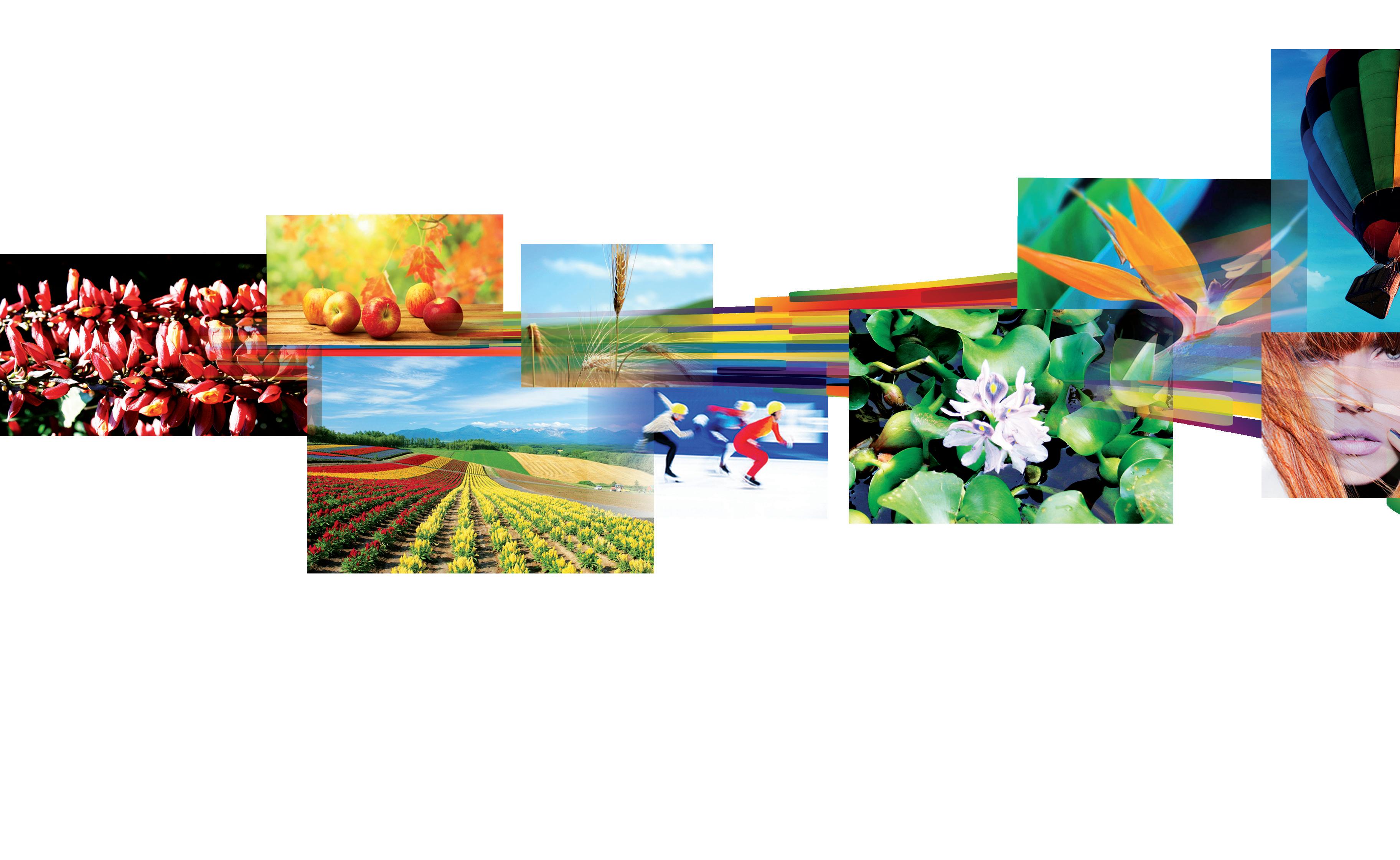
contenuti che fossero alla portata di tutti, per tutte le stagioni e per tutti i consumi. Da circa una ventina d'anni l’ibridazione di Internet con la televisione ha aggiunto un nuovo grado di maturità e di libertà nella scelta e visione dei programmi TV, grazie alla modalità di interazione chiamata “on demand”, che consente di scegliere il programma desiderato e di vederlo in qualsiasi momento, dotandosi quindi di un palinsesto personale. Non più quindi una programmazione lineare suggerita dalla rete o dall’editore. Oltretutto è possibile, in questa evoluzione della ibridazione televisiva, disporre anche di tecnologie interattive che consentono di rivedere un programma dall'inizio: “Re-Start” o “RePlay”, in modo da riprendere il filo logico a programma in onda già iniziato.
Tutti questi meccanismi sono entrati ormai nella consuetudine degli italiani, soprattutto perché il paradigma di fruizione del piccolo schermo è rimasto semplice e immutato per come è stato da sempre concepito. La televisione terrestre, con i trasmettitori sulle montagne e le antenne domestiche sui tetti delle case, fino alla fine degli anni 90 era di tipo analogico. Dal 2003 in Italia mantiene la medesima canalizzazione di frequenze televisive (UHF) ma con trasmissioni digitali che consentono una maggiore efficienza trasmissiva: molteplicità di canali, potenze ridotte e grande versatilità di trasporto del segnale.
In tutti questi anni la televisione digitale ha mantenuto il medesimo approccio tecnologico digitale (DVB) sia per la piattaforma terrestre (DTT) che per quella satellitare (SAT), caratterizzata anche dalla presenza di una modalità di fruizione sia a pagamento (accesso condizionato), come per esempio i canali Premium o SKY, ma anche free per la TV pubblica, o la TV commerciale, come TivùSat, l’esperienza italiana della
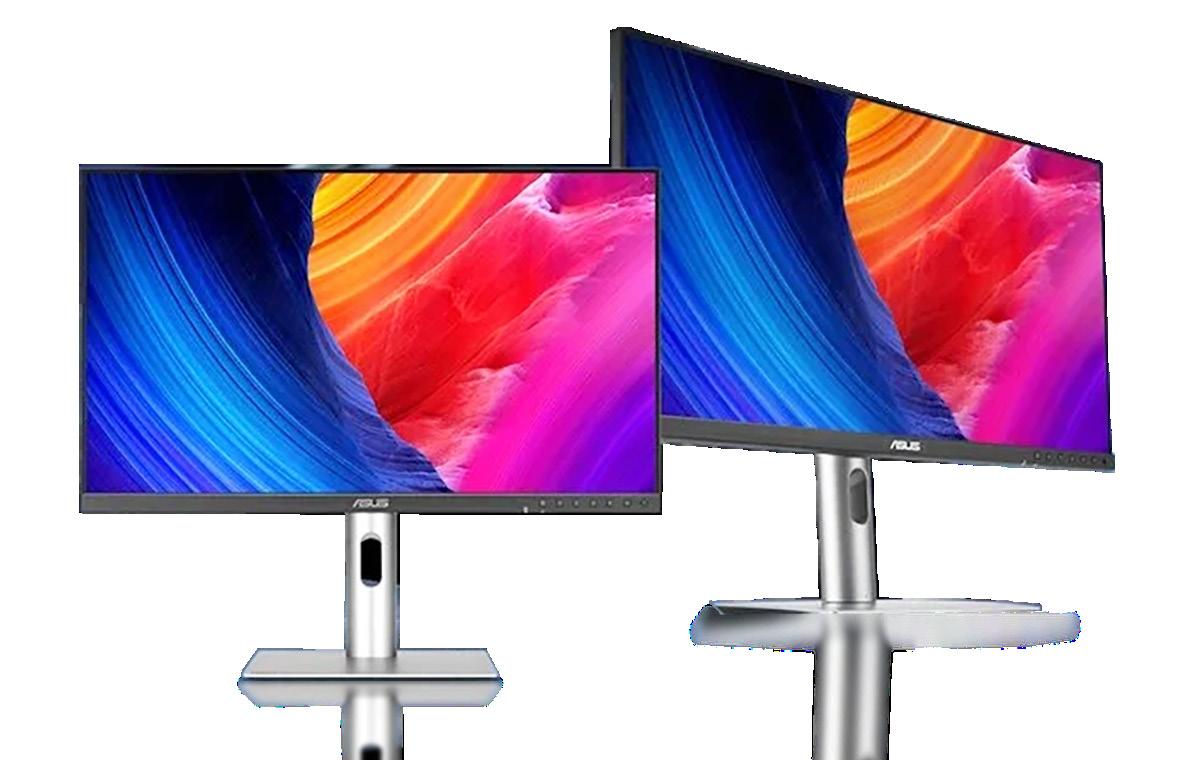
TV satellitare Free. Questa concezione ha consentito agli italiani di poter ricevere i medesimi programmi e reti del digitale terrestre in qualsiasi parte dell'Italia ma via satellite, anche nelle aree dove la ricezione terrestre era critica.
L’avvento di Internet a banda larga ha poi favorito quella connettività che noi definiamo “online”, che ha consentito l’ibridazione della TV come ulteriore punto di ricezione per molti altri editori non solo broadcasters, in grado di fornire contenuti e servizi attraverso internet come accade per i FAST channels, sostenuti commercialmente dalla pubblicità. In particolare, si sta parlando proprio del futuro della televisione lineare come l’abbiamo sin qui conosciuta, e dell’esistenza della stessa su tutte le piattaforme disponibili, incluso Intenet larga banda e mobilità 5G, oltre a quelle tradizionali DTT e Satellite. Nell'ultima conferenza WRC di Ginevra (World Radiocommunication Conferences) di fine 2023, si sono stabiliti i criteri per l’assegnazione dello spettro radio elettromagnetico per l'utilizzo delle frequenze UHF che attualmente sono ancora adibite
alle trasmissioni televisive (refarming 600 Mhz.). Con l'avvento della televisione digitale negli anni 2000, lo spettro radio frequenziale della televisione è stato oggetto di vari “refarming”, ovvero di devoluzioni di porzioni di spettro radiotelevisivo, all'utilizzo della telefonia mobile cellulare: di terza (3G), quarta (4G) e quinta generazione (5G), rispettivamente con i refarming degli 800 Mhz (2013), dei 700 Mhz (2022) e in prospettiva dei 600 Mhz.
Se la futura riallocazione dello spettro UHF con attuale canalizzazione radiotelevisiva (600 Mhz.) sarà oggetto di devoluzione ai dispositivi mobili di 5° generazione, che fine farà la televisione lineare che conosciamo? ... quella di sempre?
Questa fondamentale questione di estrema attualità è in questi giorni sul tavolo di diverse Autorità di Regolamentazione Europee e non solo. Anche il regolatore inglese Ofcom si è posto la medesima questione: “Quale futuro per il brodcasting TV dalla fine dell’attuale decennio?
-) migrazione della TV lineare su Internet. -) switchoff del Digitale Terrestre o coesistenza nello spettro radio elettromagnetico con la telefonia cellulare mobile di 5^

I nuovi display
Ultra-HD HDR-10 offrono oltre un miliardo di colori e una luminosità eccezionale di 10001500 nit, superando gli schermi SDR con soli 200-300 nit, in spessori ridottissimi.
generazione delle Telco ma su porzioni di spettro limitate per il broadcasting TV, magari con nuove tecnologie a più alta efficienza trasmissiva.
I maggiori broadcasters europei si stanno confrontando sul proprio futuro. BBC ed altri networks indipendenti britannici hanno risposto alla consultazione pubblica di Ofcom, evidenziando diverse criticità sul paventato spegnimento o riduzione del servizio di Broadcast TV terrestre soprattutto per quella parte di popolazione anziana che ha meno dimestichezza con internet. Di fatto un passaggio tout-court della TV lineare su Internet deve prevedere garanzie di accesso, pluralismo, net neutrality e qualità di servizio tipici del broadcasting via etere per una transizione compatibile ed omogenea, garanzie che oggi le Telco non sono in grado di asseverare sulle proprie infrastrutture di rete a banda larga attuali, se non attraverso una revisione/adattamento di alcune componenti di sistema.
Tutto ciò dovrà trovare un’adeguata nuova collocazione dal 2030 anche se, alcuni effetti legislativi da parte degli enti regolatori europei vedranno la luce già molto prima. Molti paesi hanno già considerato funzionale il passaggio dello spettro radiotelevisivo alle Telco mobili per il 5G, e lo hanno già in parte attuato o sono in via di attuazione.
L'Italia, nel recente WRC di Ginevra, ha acquisito la posizione di “No-Change”, tanto sostenuta dai broadcasters italiani. Ciò significa in sostanza che, fino al 2030 la canalizzazione radiotelevisiva dello spettro radio elettromagnetico italiano rimarrà destinata al broadcasting TV italiano, con ovvio rispetto delle garanzie di non sconfinamento che tali frequenze avranno per i paesi limitrofi, proprio a tutela dei criteri
del WRC. Evidentemente, ci viene posto il problema di come utilizzare al meglio lo spettro elettromagnetico oggi dei broadcasters e di come evolvere in modo armonico il modello della televisione lineare nello spettro in dotazione, ma al tempo stesso di prevedere una migrazione totale o parziale della TV anche attraverso una distribuzione via Internet (DVB-I), almeno per i canali con audience più limitate, lasciando le reti ammiraglie dei broadcaster sul digitale terrestre e sul satellite.
Siamo quindi in presenza, ancora una volta, di una svolta epocale della televisione, che si avvale ancora di più dell'innovazione tecnologica per trovare una soluzione che mantenga la televisione un fatto semplice, facile nell'accesso e nel discovery dei canali. Poiché la televisione è oltremodo un elemento unificante e caratterizzante l’identità e la cultura del paese ospitante, è quindi doveroso mantenere per essa una semplicità e facilità di accesso all’informazione per tutti i cittadini, consentendo alla televisione una presenza unificante nelle trasmissioni via etere, ma anche nelle trasmissioni via Internet.
Una delle caratteristiche più importanti di questa trasmissione TV via Internet, proprio quella che si prefigge di mantenere intatte le caratteristiche di interfaccia utente e di utilizzabilità dell'utente finale (User Experience) propria della televisione che tutti conosciamo, si chiama DVB-I (internet), che dopo il DVB-T (terrestre) e il DVB-S (satellite) è l’ultima nata della famiglia di standard internazionali della TV Digitale, definita dal DVB (Digital Broadcasting Project) l’organizzazione per la definizione degli standard, ratificata poi dall’ETSI: l’Ente di standardizzazione Europea. La TV via internet, ossia il DVB-I è stato sviluppato da qualche anno e ratificato come standard ETSI nel 2020,

affermandosi in modo importante anche nella coniugazione che porta i canali della televisione lineare su Internet, mantenendo allo stesso tempo tutte quelle caratteristiche organolettiche di utilizzabilità ed interfacce utente. DVB-I è uno standard molto promettente perché pur portando la televisione ad essere distribuita e quindi fruita attraverso le reti Internet a banda larga, garantisce le medesime peculiarità del modello di accesso e di fruizione della televisione tradizionale senza che nulla cambi per l’utente finale. Con il DVB-I, la fruizione della TV Digitale terrestre, satellitare o via internet è perfettamente integrata, interoperabile e senza soluzione di continuità, mantenendo nel contempo la medesima user experience di fruizione, controllo e accesso ai canali TV tramite il telecomando e l’LCN (Logical Channel Numbering), l’ordinamento canali stabilito dall’Autorità di Regolamentazione locale.
Quindi ancora una volta gli standard della TV Digitale: DVB per il terrestre, per il satellite e per internet, si coniugano e si completano vicendevolmente, integrandosi perfettamente con lo standard di interattività della TV Digitale, ovvero HbbTV. DVB-I consente quindi all'utente finale di dotarsi di televisori compatibili che possono ricevere segnali televisivi contemporaneamente dal digitale terrestre, dal satellite digitale o da internet, senza che nulla cambi per l'utente finale che continua ad operare il medesimo controllo del TV, con lo stesso remote control per accedere ai canali TV, oggi evoluto anche con la presenza del “voice recognition”.
Fondamentalmente il televisore DVB-I è in grado di ricevere il segnale televisivo migliore tra le diverse piattaforme di ricezione terrestre, satellitare o internet, scegliendolo laddove l'emittente lo stia effettivamente distribuendo. In questo caso lo standard DVB-I si dimostra per-
fettamente funzionale e integrato per i broadcaster, consentendo loro una nuova modalità di interazione con il modello di fruizione della televisione attuale (DTT e Sat) e con le future evoluzioni. I broadcaster nei diversi paesi europei stanno studiando da vicino sia l’approccio alla TV via Internet che nello specifico lo standard DVB-I. Sono diversi gli aspetti competitivi che caratterizzano le diverse scelte dei broadcaster pubblici e di quelli commerciali per la possibile adozione di un modello o l’altro. Un open standard di sistema come il DVB-I, sarebbe preferibile dai broadcasters tradizionali, ma è invece molto diverso da soluzioni più verticali e proprietarie, ideali per gli operatori FAST Channels, dai videoeditors internet only o dagli streamers, che offrono i propri canali nelle widget-gallery dei TV manufacturer attraverso contratti commerciali ad-hoc. Inoltre, la scelta tra un sistema o l’altro è vieppiù caratterizzata dalla presenza di una regolamentazione all’accesso, insito nel modello aperto DVB-I, standard da TV di sistema, rispetto ad un modello verticale non vincolato alle autorità di regolamentazione ma strettamente basato su contratti commerciali. Ovviamente l’ordinamento canali LCN è appannaggio del solo sistema regolamentato. Nel modello FAST channels, la posizione di numerazione è strettamente regolata dal contratto in essere con il TV manufacturer.
Una ulteriore condizione di successo o criticità della televisione via Internet, al di là dello standard tecnologico adottato, è proprio insito nella modalità di distribuzione attraverso le reti broadband delle Telco e nella modalità di accesso universale da garantire all’utente finale della TV. Nel modello attuale della TV via etere è sufficiente un’antenna sul tetto o una parabola satellitare per ricevere i canali free trasmessi dai broadcasters senza ulteriori costi celati. Con la TV via Internet al contrario si deve
disporre di un abbonamento oneroso con una Telco e di una connettività larga banda con tanto di canone e consumo. Questo è un fattore discriminante all’accesso rispetto alla TV broadcast, soprattutto alla luce della qualità di servizio offerta dalle tecnologie broadcast via etere (continuità di servizio), rispetto ad una qualità di servizio (best effort) delle reti broadband non dotate di specifiche tecniche punto-multipunto (multicast).
Il timore è che la elevata qualità di servizio che la televisione digitale ha offerto sino ad oggi, H24, 7 giorni su 7, 365 giorni all'anno a decine di milioni di teleutenti, deve necessariamente essere garantita anche dalle Telco attraverso la distribuzione broadband Internet. Questa è cosa assai più complessa per le Telco, non essendo le reti Internet disegnate per un traffico televisivo lineare sostenuto indirizzato ad una moltitudine di utenti concorrenti.
Le tecnologie broadcast lineari sono disegnate per la presenza contemporanea di una moltitudine di utenti, come spesso si evidenza in presenza di grandi eventi live, es una partita di calcio di una finale. Nella fattispecie, questo comporterebbe qualche difficoltà per le reti di distribuzione via Internet data la loro conformazione punto-punto.
Questa è una criticità rilevante nel passaggio alla TV via Internet perché presuppone un lavoro di adeguamento o aggiornamento delle tecnologie delle reti broadband da affrontare insieme alle Telco, per consentire un traffico agevole ed efficiente dei canale televisivi lineari, un po’ come quello che accadde per la Cable Television, che consentiva con tecnologie di tipo broadcast la ricezione della TV a milioni di utenti concorrenti senza per questo produrre inefficienze sia nel trasporto che nel delivery che nella qualità di servizio offerta, identica a quella broadcast.
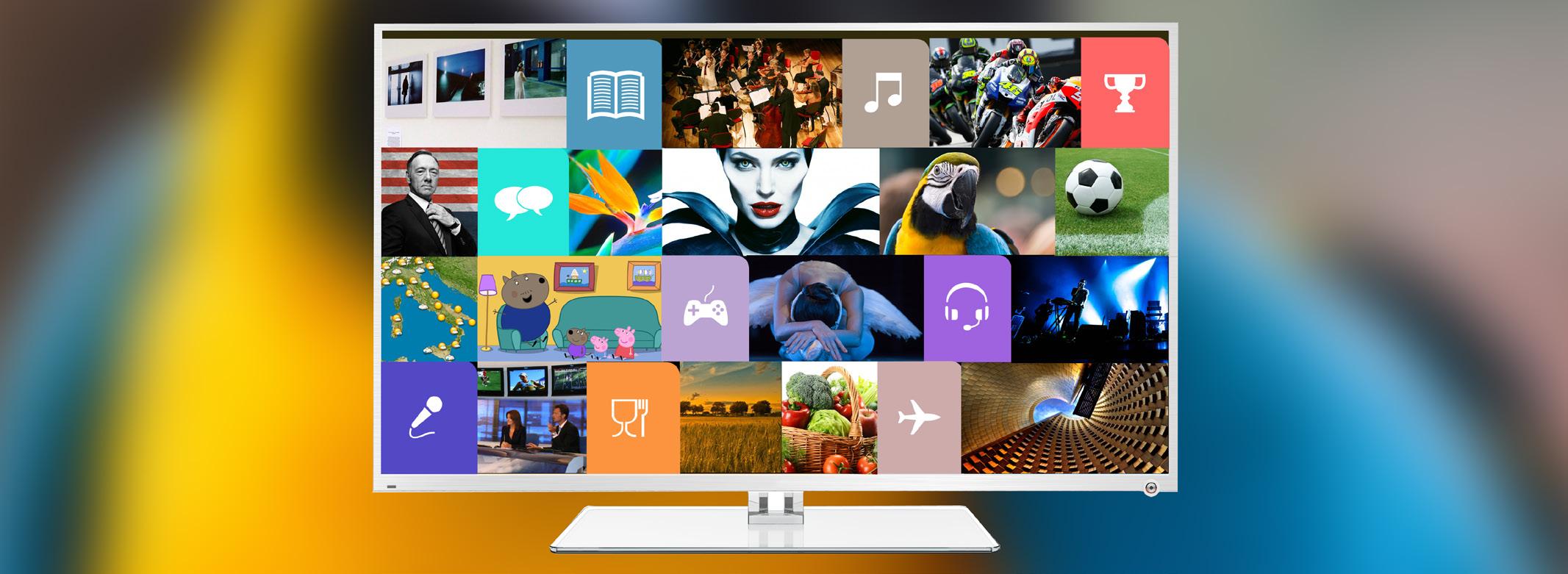

Il nuovo ATEM Television Studio 4K8 è uno switcher professionale per la produzione dal vivo integrato in un pannello di controllo per il broadcast, adatto ai lavori di alta fascia e allo stesso tempo super portatile. Dispone di 8 ingressi 12G-SDI con conversione di standard, 10 uscite ausiliarie 12G-SDI, 4 chiavi cromatiche, 2 chiavi secondarie, SuperSource, 2 lettori multimediali e tantissime transizioni.
Facile da usare e veloce da imparare
Nessun altro switcher è così facile da usare, perché basta premere i pulsanti del bus di programma sul pannello frontale per alternare le sorgenti video o per inserire numerose transizioni, ad esempio una dissolvenza, o effetti più marcati come un passaggio con colore o un DVE di tipo Squeeze o Push. Puoi usare il DVE anche per l’effetto immagine nell’immagine con grafica personalizzata, e poi mandare il programma completo in diretta streaming!
Switcher tutto in uno di qualità broadcast ATEM Television Studio 4K8 è perfettamente portatile perché abbina switcher e pannello di controllo in un solo dispositivo. Il pannello ospita i pulsanti per selezionare le sorgenti, innescare le transizioni e impostare gli effetti video. Puoi anche contare su una leva per il controllo manuale delle transizioni. Inoltre il pannello incorpora una sezione audio innovativa per controllare il mixer, con gli indicatori di livello in un apposito display LCD.
Potente elaborazione SuperSource
Oltre agli effetti DVE, ATEM Television Studio 4K8 vanta un avanzato processore multilivello SuperSource. Qualsiasi ingresso video si può usare come sorgente per ciascun DVE, e poi sovrapporre tutto a uno sfondo personalizzato del Media Pool o al video dal vivo. SuperSource è perfetto per realizzare interviste con una grafica interessante per ognuno degli intervistati.
Mixer audio Fairlight interno Il mixer audio Fairlight all’interno di ATEM Television Studio 4K8 consente un mixaggio dal vivo sofisticato, con un numero di canali tale da soddisfare tutti gli ingressi SDI, oltre a quelli aggiuntivi per gli ingressi XLR, RCA e MADI! Ciascun canale vanta EQ parametrico a 6 bande ad alta prestazione, compressore, limitatore, espansore, noise gate, livelli e panning.
ATEM Television Studio 4K8
29 e 30 ottobre 2024 Centro Congressi Stella Polare Fiera Milano Rho
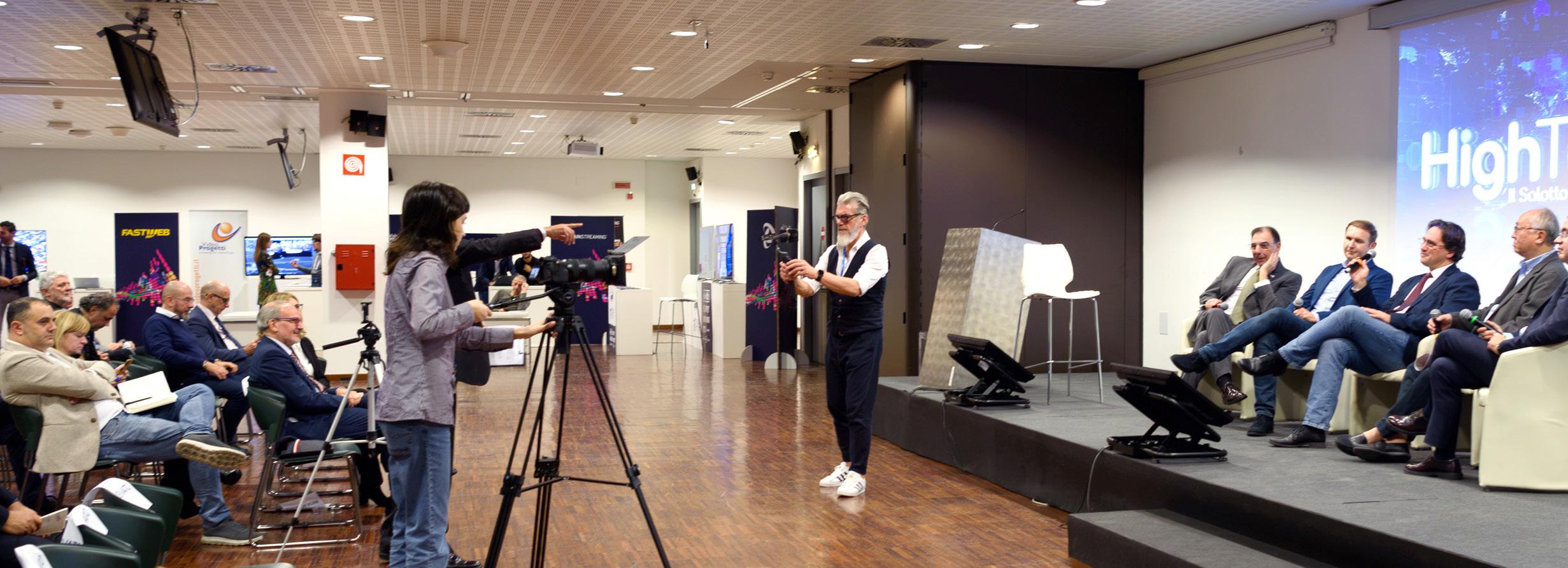
La HD Forum Annual Conference 2023 ha supportato il neonato MAF, riunendo esperti del broadcasting, telecomunicazioni e produzioni audiovisive in Italia ed Europa. Con una partecipazione oltre le aspettative, ha affrontato temi chiave come il 5G Broadcast, il DVB-I e l'AI Generativa, confermando il suo ruolo centrale nell'innovazione audiovisiva.



OAppuntamento il 29 e 30 ottobre con la 18a edizione della conferenza annuale di HD Forum Italia
Centro Congressi
Stella Polare Fiera Milano Rho
Simone Madoni
biettivo primario del progetto MAF è sicuramente voler affrontare il concetto dell’Open Innovation, introdotto nel mercato dei Media e delle Telecomunicazioni e che oggi, più che mai, consente l’accesso a una vasta gamma di idee, soluzioni e competenze per analizzare le tendenze tecnologiche emergenti che supportano la creazione del contenuto audiovisivo. Il tutto per integrare in modo strategico prodotti e soluzioni per potenziare l’esperienza visiva e focalizzare l’attenzione sulla rivoluzione tecnologica che sta ridefinendo il paradigma della produzione e la distribuzione dei contenuti multimediali.
Questi contenuti e tecnologie troveranno dunque la loro collocazione nell’ambito del Milano Audiovisual Forum (MAF): un evento annuale, frutto della collaborazione strategica tra Pentastudio, HD Forum Italia e Fiera Milano. Un’iniziativa di portata internazionale che troverà sede presso il prestigioso Centro Congressi Stella Polare di Fiera Milano Rho il 29 e 30 ottobre 2024 e che ambisce a presentare e valorizzare soluzioni di alto profilo tecnologico. Si tratterà di un ricco programma di attività pensato per analizzare in modo critico le trasformazioni tecnologiche attuali, dove i maggiori esperti del settore indicheranno
le linee guida da seguire. Sarà un momento di formazione ed informazione, di ascolto, di analisi, di valutazioni attraverso dibattiti, aree dimostrative, aule di formazione Qui, speaker di indiscusso valore ci supporteranno nel coltivare le competenze e consolidare un tessuto rivolto all’innovazione.
Il settore e i protagonisti
Milano Audiovisual Forum 2024 sarà quindi un evento che si rivolge a tutta la filiera dell’audiovisivo: al mercato televisivo e radiofonico, ai detentori dei diritti, ai produttori di contenuti, all’industria di settore, alle aziende di fornitura servizi e di integrazione di soluzioni ad alto valore aggiunto, agli operatori di rete, alle piattaforme di distribuzione
In un mercato in continua evoluzione risulta infatti determinante comprendere e valorizzare la produzione e la distribuzione del contenuto audiovisivo in tutte le sue forme e declinazioni per guidare il cambiamento e per essere complementari nella definizione di nuove modalità organizzative e di innovativi modelli di business.
HD FORUM ITALIA
Un ruolo determinante e di assoluto valore, all’interno del Milano Audiovisual Forum, sarà rappresentato dalla conferenza
annuale di HD Forum Italia, un’associazione finalizzata a promuovere, sostenere e diffondere l’uso di contenuti audiovisivi e multimediali, i prodotti e le tecnologie in Alta Definizione, Ultra-Alta Definizione e altre soluzioni audiovisive evolute.
Nata nel 2006, HD Forum Italia riunisce in associazione i protagonisti italiani del settore e le rappresentanze italiane di Società estere dell’audiovisivo, allo scopo di creare un centro catalizzatore di esperienze e interessi che risponda all’esigenza di affrontare adeguatamente uno scenario evolutivo inedito.
Lo scorso anno
L’edizione 2023 di HD Forum Annual Conference ha sostenuto lo sviluppo del neonato MAF. L’evento ha riunito esperti ed operatori del mercato italiano ed europeo nei settori del Broadcasting, delle telecomunicazioni e delle produzioni audiovisive ed è stato un successo che è andato ben oltre le aspettative degli organizzatori. I numeri dicono che il MAF 2023 ha raggiunto un target molto ampio di utenti e categorie di settori e che un 36% circa delle presenze era rappresentato da dirigenti e manager aziendali.
Le stesse tematiche affrontate sono la dimostrazione del valore espresso dalla manifestazione: dal 5G Broadcast per la distribuzione di contenuti multimediali al nuovo standard di trasmissione DVB-I, dalle teche per la valorizzazione e la conservazione del patrimonio visivo agli effetti del AI Generativa sul prodotto audiovisivo, fino alla produzione di grandi eventi di intrattenimento attraverso i virtual studios.

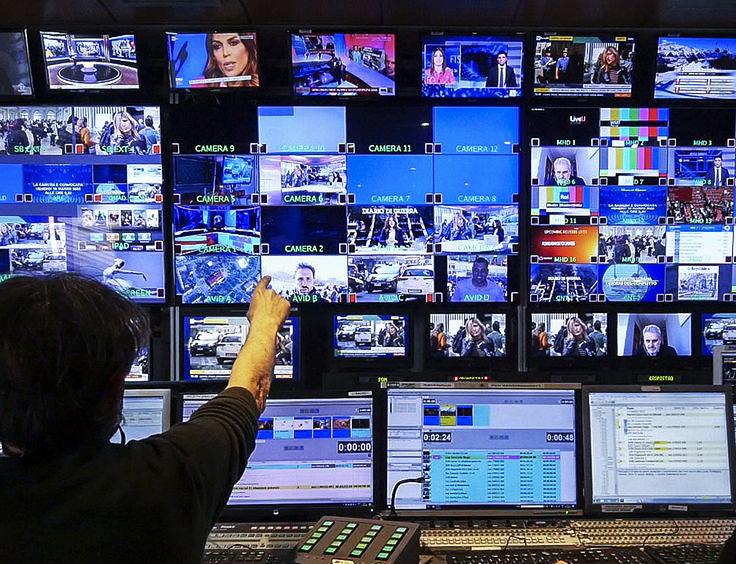

Dalle trasmissioni analogiche agli streaming on-demand, il mercato broadcast è stato rivoluzionato dall'HD, dai contenuti digitali e dalle piattaforme OTT, ridefinendo il modo di fruire contenuti audiovisivi.
L’edizione 2024: temi e target
Nell’edizione 2024 andremo oltre: esploreremo ancora di più gli scenari futuri del mercato cercando di anticipare le sfide e di capitalizzare le opportunità emergenti. Il convegno rappresenterà infatti un fondamentale momento di riflessione e di dialogo sui temi cruciali del settore.
Esperti di fama internazionale, leader di mercato si confronteranno su scenari, prospettive e opportunità per creare un ambiente di apprendimento, di condivisione di esperienze e conoscenze. Il mercato televisivo tradizionale, la serialità TV, gli editori di contenuti, i produttori e post produttori, le piattaforme Over the Top, le piattaforme satellitari e del digitale terrestre, il settore radiofonico: tutto si incastonerà in una matrice ideale con le tecnologie emergenti.
Inoltre, grazie anche alla presenza delle industrie leader di mercato e di importanti società in ambito system integration, Broadcast ed Information technology, si delineeranno le reali applicazioni delle cloud applications, della remote production, del dab e della visual radio
Con il supporto e la presenza di direttori della fotografia ed esperti di color correction si parlerà di realtà virtuale, un processo di produzione ormai in via di consolidamento, che, nella sua trasversalità, costituisce un elemento di congiunzione nella realizzazione di contenuti nel Cinema, nella Produzione TV e nella produzione delle Serie TV.
Il tutto al cospetto dell’intelligenza artificiale generativa, con i suoi infiniti campi di applicazioni. Non mancherà poi un focus sul mercato. I modelli di Subscrition Video
On Demand (SVOD, servizi su abbonamento con canone) rappresentano infatti la quasi totalità della spesa del consumatore, mentre quelli Transactional Video
On Demand (TVOD, basati sull’acquisto o noleggio di singoli contenuti) sono sempre più marginali. In questo contesto i key player del mercato pubblicitario ci aiuteranno a comprendere le soluzioni ibride e i modelli ASVOD (Ad-supported Subscription Video On Demand) che si stanno oggi imponendo.
Le aree dimostrative del MAF rappresenteranno infine un elemento attrattivo dell’evento, un luogo dove l’innovazione diventa tangibile: un’occasione per esplorare prodotti e servizi che stanno guidando il futuro del settore. E a completamento
del progetto saranno presenti anche le Masterclass dove si avrà l’opportunità di approfondire tematiche di sicuro interesse attraverso sessioni di formazione altamente qualificata che consentiranno loro di acquisire competenze specifiche. Sarà per tutti un'occasione di confronto per sviluppare e consolidare relazioni, e per promuovere un costante dialogo tra tutti gli stakeholder, creare valore e mantenere competitività e sostenibilità; nella sua totalità, ci aiuterà ad “unire i puntini” di un ecosistema complesso ed estremamente affascinante.
www.audiovisual.forum
www.hdforumitalia.it
events@pentastudio.it
Tel.: +39 0444 543133
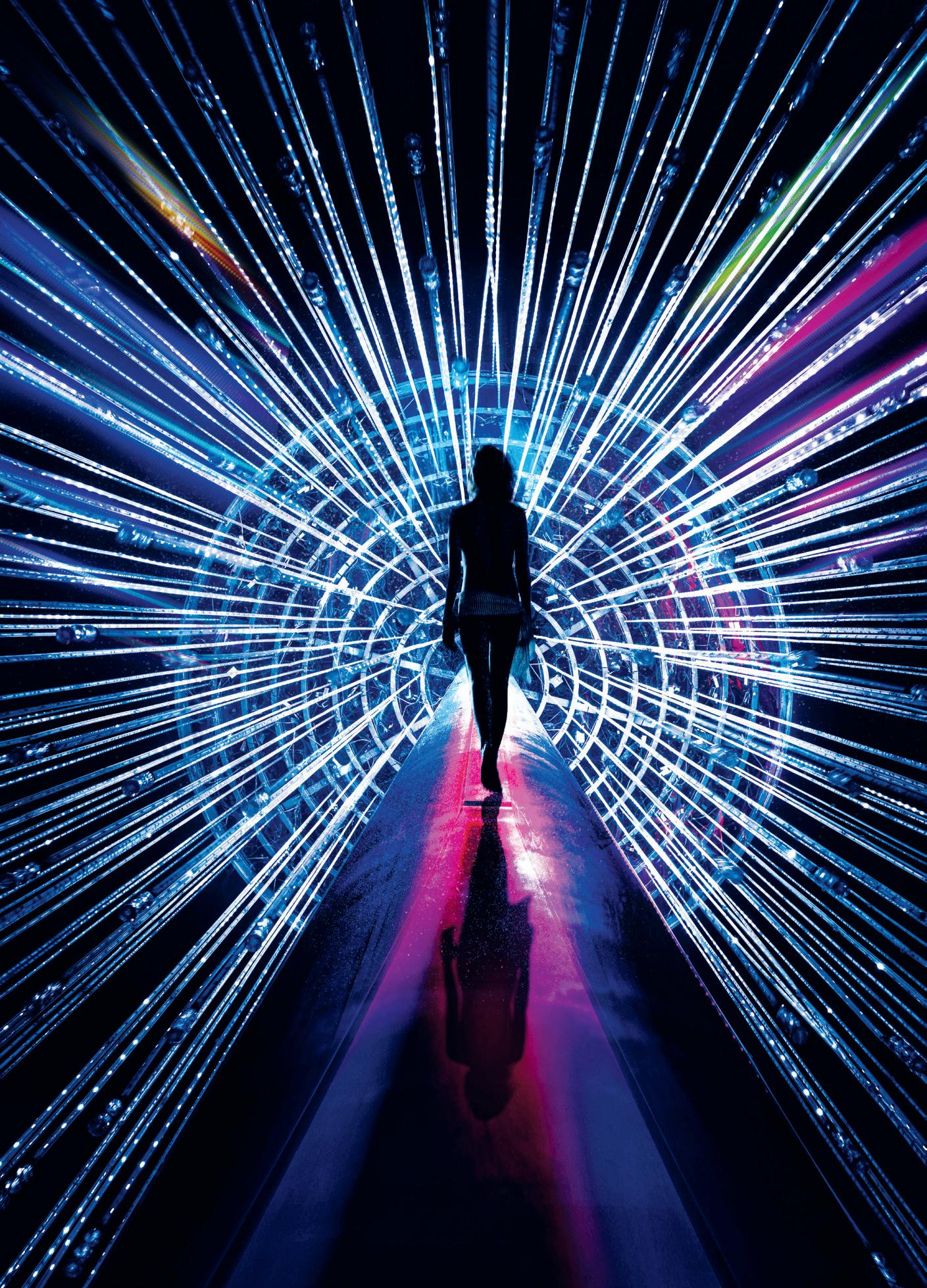
Nel 2023 a ISE già si erano visti alcuni studi virtuali in mostra negli stand dei principali produttori specialmente di LED, nel 2024 il loro numero e spettacolarità sono aumentati in maniera esponenziale, e si è cominciato a parlare di AV Broadcast. Un modo per nominare la progressiva ibridazione tra il Pro AV e il Broadcast, dal punto di vista delle tecnologie ma soprattutto del mercato.
La Virtual Production, di pari passo con i set virtuali, aumenta in numero e qualità, in parallelo si stanno moltiplicando i canali di accesso al contenuto, e si stanno affacciando tecnologie come l’Intelligenza Artificiale o le ambientazioni immersive. In mezzo a tutto questo, tuttavia, il contenuto resta centrale, come e anche più di prima, dato che il mezzo sta divenendo liquido e le modalità di fruizione per gli utenti sempre più variegate.

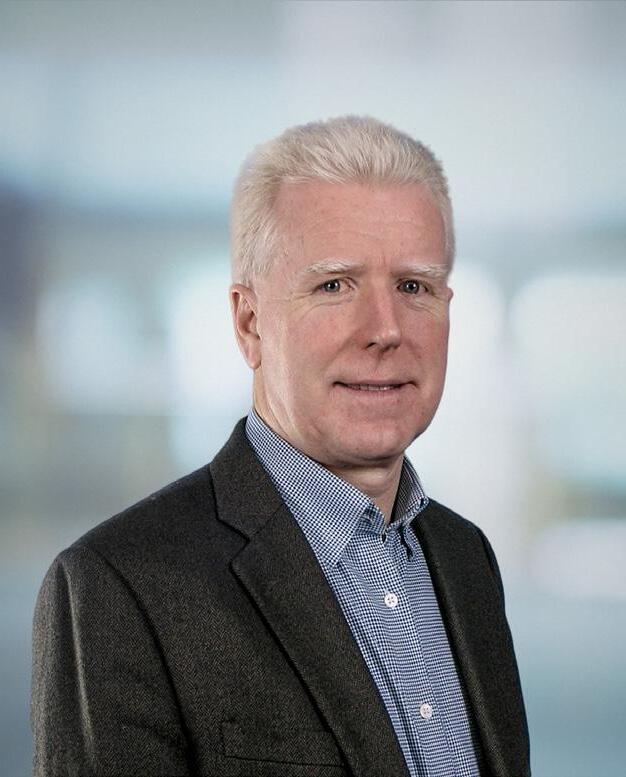
Questo articolo cerca di fare il punto sui nuovi scenari di ibridazione tra AV e Broadcast grazie al contributo di Ciàran Doran, Managing Director di Deep Blue Sapphire e moderatore dell’evento proposto a ISE Content Production&Distribution Summit, Simone Madoni, Project Manager per MAF – Milano Audiovisual Forum, il nostro evento in collaborazione con Fiera Milano e HD Forum (29-30 ottobre) e le testimonianze di ISE e IBC, le fiere di riferimento europee per i settori Integrazione di Sistemi e Broadcasting.
Un mondo di nuovi Broadcaster
Le ibridazioni tra il mondo del Broadcast e dell’Audio Video professionale sono ormai assodate, ma come siamo ci siamo arrivati?
Ciàran Doran – Negli ultimi anni è divenuto
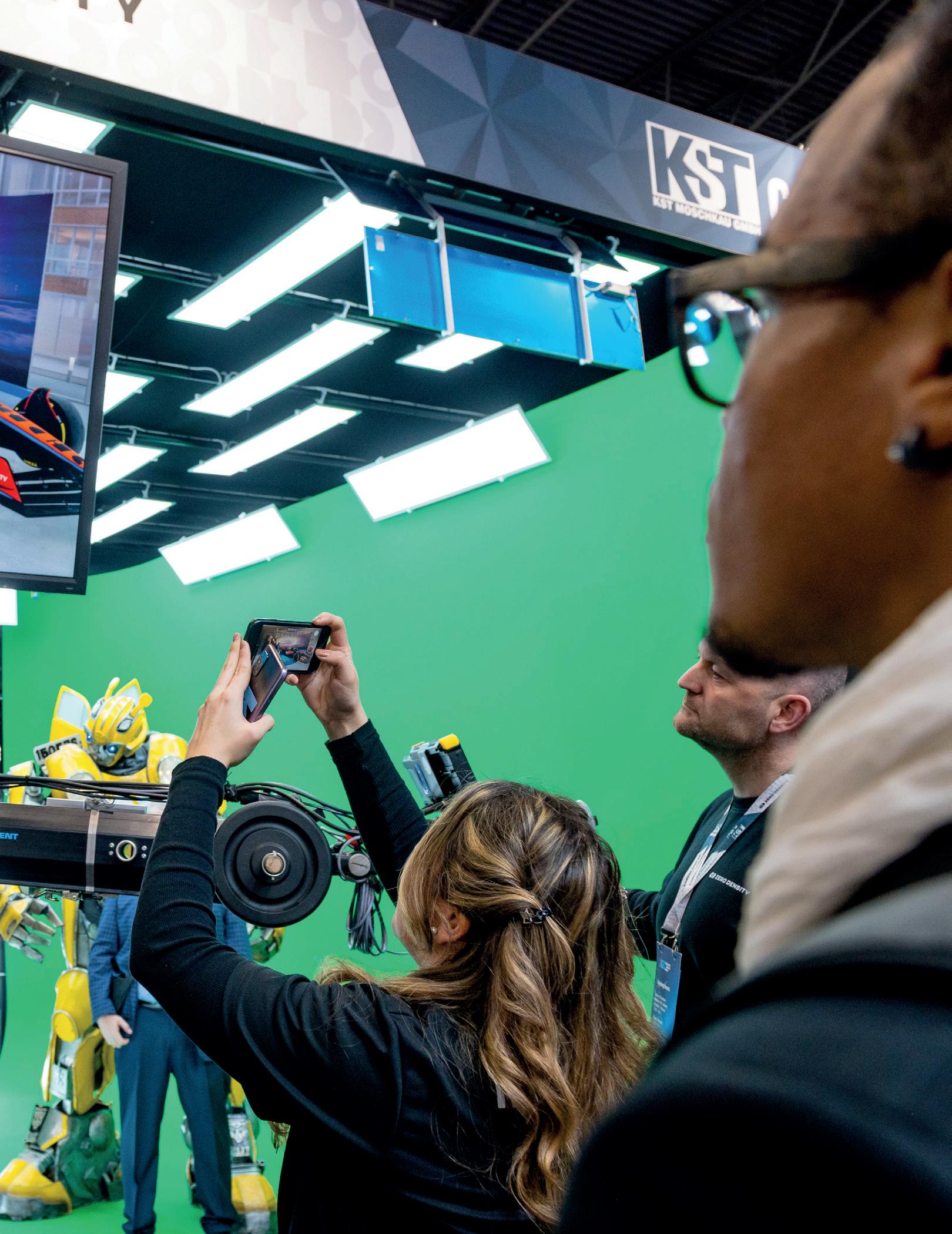
più facile produrre contenuti di qualità: la tecnologia è sempre più performante e sono nati i set virtuali.
Parallelamente, i canali di fruizione si sono moltiplicati, tendenza tutt’ora in evoluzione: siamo passati dalla TV da guardare in salotto alla miriade di occasioni di fruizione di contenuti più o meno strutturati, più o meno lunghi, su molti device differenti.
Ma bisogna tenere in mente che il canale è solo un mezzo.
Oggi siamo abituati a una miriade di proposte di contenuto…
Si, e stiamo assistendo a un nuovo passaggio: se qualche anno fa abbiamo assistito al proliferare di contenuti brevi, di intrattenimento, promozionali o un mix tra i due, su You Tube prima e su TikTok dopo,
oggi ci stiamo abituando anche grazie al migliorare delle tecnologie e degli standard di visione, a un salto di qualità. Stiamo così assistendo alla nascita dei canali dei brand che rinsaldano il rapporto con i clienti diretti attraverso contenuti di alto profilo, dialogando con gli utenti direttamente, senza più mediazioni.
Può fare un esempio?
Circa due anni fa il whisky Macallan produsse un corto dal titolo The spirit of 1926: 8 minuti di cinema per raccontare la storia di Janet Harbinson, vedova del fondatore della distilleria che decide di portare avanti l’impresa in un’epoca, l’inizio del secolo scorso, nella quale le donne tradizionalmente non lavoravano e meno che mai nell’industria degli alcolici. Ebbene, il corto
Nel 2024 all'ISE, la presenza di studi virtuali è cresciuta esponenzialmente, segnando l'ibridazione tra Pro AV e Broadcast. La Virtual Production e le tecnologie immersive, come l’IA, aumentano, mantenendo il contenuto centrale.
è di ottima qualità, girato magistralmente sotto la guida di Mike Newell1, Emily Mortimer impersona la protagonista. Quegli 8 minuti mi hanno catturato e, anche se il whisky resta in sottofondo mentre la storia di amore e di empowerment è protagonista, non scorderò che si trattava del whisky Macallan. Confesso di aver desiderato che vi fosse almeno un sequel!
Questo perché ciò che coinvolge le persone, ovviamente, non è il prodotto in sé ma la storia e le emozioni che scaturiscono da essa, questo dovrebbero tenerlo a mente i marketer dei grandi gruppi.
Pensa che i canali come Netflix o Prime Video potranno sostituirsi alla TV?
Credo piuttosto che i canali dei brand prenderanno sempre più piede, scalzando non solo la TV ma affiancandosi ai canali come Netflix. Osservo insomma che i marchi stanno utilizzando sempre più le tecnologie pro AV e quelle legate alla produzione e allo streaming per creare contenuti propri, che riflettano la qualità del brand e instaurino un rapporto diretto con il cliente. Tuttavia, non credo che i nuovi Broadcaster stiano “uccidendo” la TV tradizionale che, a sua volta, sta cercando nuovi canali di dialogo con il pubblico, capaci di sostenere le spese di creazione di contenuti.
Pensa che le nuove produzioni, le produzioni virtuali, richiederanno nuove professionalità?
Non credo che il lavoro di un direttore della fotografia sia molto diverso in un set tradizionale o in un set virtuale, credo invece che la virtual production crei nuove opportunità, qualitativamente e numericamente, per le professioni esistenti.
Inoltre, osservo una sorta di “democratizzazione” grazie alla virtual production: se prima per lavorare era indispensabile essere sul posto o spostarsi quando la produzione era delocalizzata (si pensi alle regie di eventi sportivi che si svolgono in determinate location nel mondo), oggi si può per esempio controllare una videocamera da remoto, consentendo a tutti di lavorare da qualunque luogo.
Qual è secondo lei il rapporto tra tecnologia e creatività.
L’una consente l’altra?
È vero che le nuove tecnologie, e metto dentro questa parola dalle tecniche per le produzioni virtuali all’immersività fino all’IA, possono cambiare significativamente il prodotto finale, ma allo stesso tempo non penso si possa essere più creativi grazie alle tecnologie.
Come sempre, dipende molto dal talento delle persone che le utilizzano: un ottimo strumento in mano a un operatore poco creativo darà comunque risultati medi.
Tuttavia, la tecnologia aiuta la creatività, è come un assistente invisibile che lavora nelle retrovie.
Perché le produzioni investono negli studi virtuali?
Perché facilitano, abbattono i costi e alle volte risolvono. Per esempio consentono di produrre con maggiore sicurezza nei modi e nella durata – non ci sono imprevisti – non c’è bisogno di spostare i set, si accorciano i tempi dal momento della scrittura alla realizzazione del prodotto finito.
I set virtuali rappresentano una opportunità anche per i costruttori di tecnologia?
Come negli altri settori, anche qui assistiamo a una corsa all’innovazione che alle volte anticipa addirittura le necessità degli utilizzatori.
Tuttavia le produzioni virtuali coinvolgono aziende che normalmente operavano in altri settori e nel Broadcast solo marginalmente (costruttori di LED, di matrici di distribuzione ecc.). Senza dubbio l’evoluzione tecnologica aiuta nell’abbattimento dei costi, e a mantenere competitive anche le piccole case di produzione.
Cosa ne pensa dell’ “Incrocio” tra AV broadcast e Digital Signage?
In effetti non mi spiego come aziende tipo SKY, DAZN o altri non pensino a utilizzare i network di DS per ampliare il raggio dei propri contenuti, a maggior ragione perché hanno in mano il rapporto con le agenzie pubblicitarie. Può darsi che ne farò il tema del prossimo Forum a ISE!
Abbiamo raccolto alcuni esempi recenti di content production di alto profilo da parte di brand, veri e propri corti con collaborazioni e budget importanti, dove lo story telling è lo strumento per dialogare con il cliente. Forse a breve creeremo le nostre playlist a partire dai brand e non solo consultando le piattaforme?

The Long Goodbye , corto di Aneil Karia e Riz Ahmed del 2020, prodotto da WePresent. WeTransfer viene spesso utilizzato per trasferire file video, da qui nasce la piattaforma editoriale WePresent. Il corto ha vinto l’Academy Award per il Best Live Action Short Film nel 2022, e racconta una storia di intolleranza e riscatto.
The Spirit of 1926, 2022
Prodotto dal marchio di whisky Macallan, racconta la vita di Janet Harbinson (interpretata da Emily Mortimer), vedova del fondatore della distilleria, che decide di portare avanti l’impresa in un’epoca in cui le donne tradizionalmente non lavoravano. Una storia d’amore e di empowerment
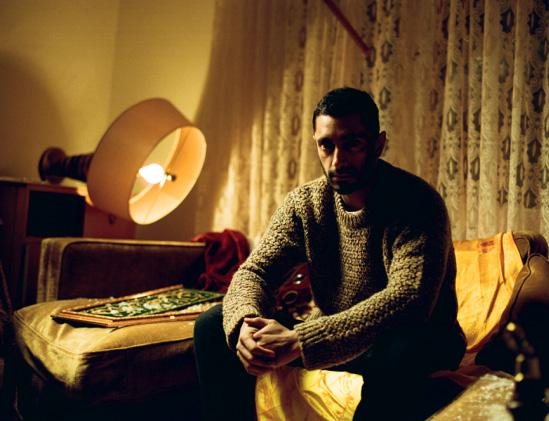

RB19, filmato di lancio dell’auto di Formula 1 RedBull RB19, del 2013. L’auto appare in contesti impossibili nella realtà, come strade e ponti cittadini, lungomare ecc. La virtual production ha risolto il problema e reso possibile cambi di location veloci e senza imprevisti.
Volendo dare uno sguardo sul versante delle tecnologie nell’AV Broadcast, i due aspetti che appaiono di maggiore interesse, in questo momento, sono la parcellizzazione della visualizzazione, che implica considerazioni sia in merito a reti e connettività che per quanto riguarda supporti e canali, e il mondo della produzione virtuale, con i suoi LED, le nuove problematiche in post-produzione, la gestione dei segnali e dei dati.
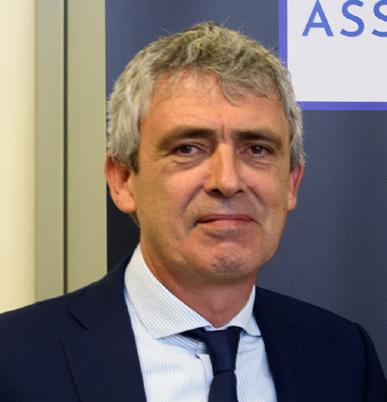
Simone Madoni, da che parte vogliamo iniziare?
Da ciò che risulta familiare al pubblico, la visualizzazione dei contenuti: oggi ci siamo abituati non solo a una pluralità di canali, ma anche a tante modalità di fruizione dello stesso canale, dal lato dei supporti come delle tempistiche e modalità. Lo stesso contenuto è disponibile in diretta oppure on demand, visibile sulla TV in salotto o su un device personale, dal PC allo Smartphone. Nonostante questo, la TV lineare sta tenendo il colpo, almeno in Italia, e il grosso della raccolta pubblicitaria fa ancora capo a lei.
Broadcast e AV, o AV Broadcast?
Anche se ogni anno si evidenzia una dispersione di circa 1 milione di spettatori dalla TV lineare, non credo sia possibile definire con precisione dove e come questi spettatori si ricollocano e a favore di quali piattaforme. La ricerca della fidelizzazione dell’utente è una materia estremamente complessa. Cosa offre di più e di diverso la frammentazione degli ascolti che solitamente approda alle piattaforme OTT?
Per l’utente significa contenuti on-demand praticamente illimitati, possibilità di scegliere il device di fruizione ecc. Ovvio che quando il contenuto è forte e l’editoria lo rende disponibile su tutti i canali, non necessariamente l’uno penalizza l’altro: Sanremo quest’anno è stato bellissimo sia a livello visivo che del contenuto, i dati di ascolto hanno toccato tutti i target – chi si sarebbe aspettato che avesse tanto successo tra i giovani – e abbiamo avuto sia la diretta sui RAI 1 che la diffusione simulcast su RaiPlay, la complementarità è stata funzionale ad ampliare il bacino d’utenza. Per gli editori, nella visione della total audience, la grande novità di studio e analisi è rappresentata dalla profilazione dell’utente.
Veniamo ai Set Virtuali
La possibilità di creare ambientazioni potenzialmente infinite tramite l’utilizzo di
Per sviscerare il nodo che lega, sempre più strettamente, AV e Broadcast, abbiamo interpellato ISE, la fiera che rappresenta in Europa il mercato dell’AV Pro. Negli ultimi due anni la manifestazione ha ampliato fortemente il filone (formazione, area dedicata ecc.) sul Broadcast. Ecco il parere di Mike Blackman, Managing Director di ISE
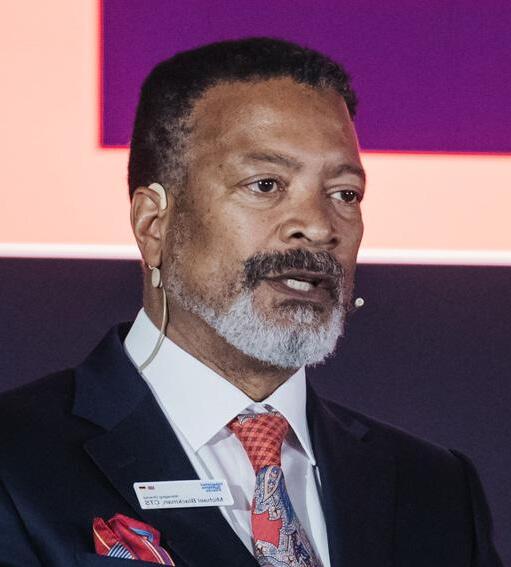
AV e Broadcasting si stanno fondendo, quando e come avete deciso di includere questa nuova tendenza in fiera?
Mike Blackman - Il mercato del Broadcasting, una pietra angolare dell'industria dei media e dell'intrattenimento, ha subito trasformazioni notevoli nel corso degli anni. Pur mantenendo la sua rilevanza, stiamo assistendo a una crescente domanda di applicazioni Broadcast all'interno di progetti AV, attribuibile a diversi fattori come l'evoluzione della tecnologia, le abitudini di consumo dei media ecc. Questa convergenza è in corso da diversi anni, ma ha accelerato più di recente. A ISE abbiamo risposto a questa tendenza integrando attivamente contenuti e funzionalità che dimostrano come queste tecnologie siano complementari: abbiamo introdotto una Content Production&Distribution Technology Zone e lanciato il Content Production&Distribution Summit a ISE 2023, replicato nel 2024, e continueremo a sviluppare questo tema per ISE 2025.
effetti speciali, dei videoserver e dei nuovi modelli di LEDwall sta rivoluzionando il workflow di produzione, e i VS sono una modalità sempre più utilizzata specialmente per la realizzazione di serie TV. I driver che spingono utilizzo sono noti: l’ottimizzazione dei tempi, la flessibilità, il vantaggio economico. Si richiedono tuttavia grandi competenze professionali e un accurato lavoro di finalizzazione in post-produzione. Lo abbiamo chiesto anche a Ciàran Doran: i virtual set richiedono nuove professioni o professionalità?
Sulla formazione siamo ancora indietro, ci sarebbe bisogno di creare valore perché si tratta di una tecnologia emergente e complessa. Si rendono necessarie competenze specifiche per ogni singolo ambito della filiera.
Qual è il ruolo dell’audio?
Come sempre nel Broadcast si parla più di video che di audio, a torto a mio parere. Nella realizzazione dei film e della serialità TV si investe molto nella produzione audio per aumentare il coinvolgimento del pubblico e per dare maggiore enfasi alle emozioni. L’audio immersivo sembra la strada giusta, ma di questo ne parleremo approfonditamente il 29 e 30 Ottobre ’24 al Milano Audiovisual Forum.
Inoltre, nel corso degli anni, abbiamo presentato keynote speaker che portano preziose intuizioni dall'industria del broadcasting a ISE e alla comunità AV professionale, come BK Johannessen, di Epic Games, e la regista premiata agli Academy Awards Sharmeen Obaid-Chinoy.
Pensa che avrà un impatto importante anche sul mercato del Broadcasting?
MB - Oltre ai cambiamenti nei set virtuali, questa trasformazione sta rivoluzionando l'intero mercato del Broadcasting. Non è solo una tendenza passeggera. La fusione delle tecnologie AV e Broadcast facilita l’immersività, aumenta l'efficienza della produzione e apre nuove strade per il coinvolgimento del pubblico. I marchi e le aziende stanno sfruttando queste tecnologie per creare contenuti più dinamici e visivamente accattivanti, che a loro volta stanno aumentando il coinvolgimento degli spettatori e ampliando la loro portata.
E per quanto riguarda il mercato AV?
MB - La convergenza delle tecnologie sta ridisegnando significativamente il mercato AV. Questa integrazione consente ai professionisti nuovi approcci precedentemente associati al Broadcast. Di conseguenza, possono adottare metodi di produzione e strumenti più sofisticati, migliorando la qualità e la varietà dei loro progetti. Inoltre, la crescente domanda di contenuti di alta qualità in tempo reale, resa possibile dalle avanzate tecnologie di Broadcasting, sta guidando l'innovazione e creando nuove opportunità di business all'interno del settore AV. www.iseurope.org

Le fiere, si sa, riflettono il mercato che rappresentano. Abbiamo quindi chiesto a Steve Connolly, Direttore di IBC, la fiera di riferimento in Europa per il Broadcasting, la sua visione sulla sempre maggiore ibridazione tra AV e Broadcast.
AV e Broadcasting sono sempre più connesse. Pensa che sia solo una tendenza tecnologica o che questo avrà un impatto importante nel mercato?
Steve Connolly - La convergenza tra AV e Broadcasting è più di una semplice tendenza tecnologica, come dimostrato dai tassi di crescita impressionanti registrati nel settore. Un'analisi recente di Caretta Research ha mostrato che il settore dovrebbe crescere di quasi il 3% ogni anno dal 2023 al 2027, evidenziando significative opportunità di business e un entusiasmante slancio industriale.
Incorporando tecnologie AV avanzate come la produzione virtuale, i broadcaster possono migliorare la qualità dei loro contenuti, creando esperienze di visione più coinvolgenti e immersive. Questa convergenza consente tecniche di narrazione innovative, fondendo metodi di trasmissione tradizionali con strumenti AV all'avanguardia. Man mano che queste tecnologie diventeranno più integrate nei flussi di lavoro quotidiani, aiuteranno a sviluppare nuovi modelli di business, aumentando l'efficienza operativa e alimentando contenuti creativi, così che i broadcaster rimangano competitivi in un mondo sempre più digitale.
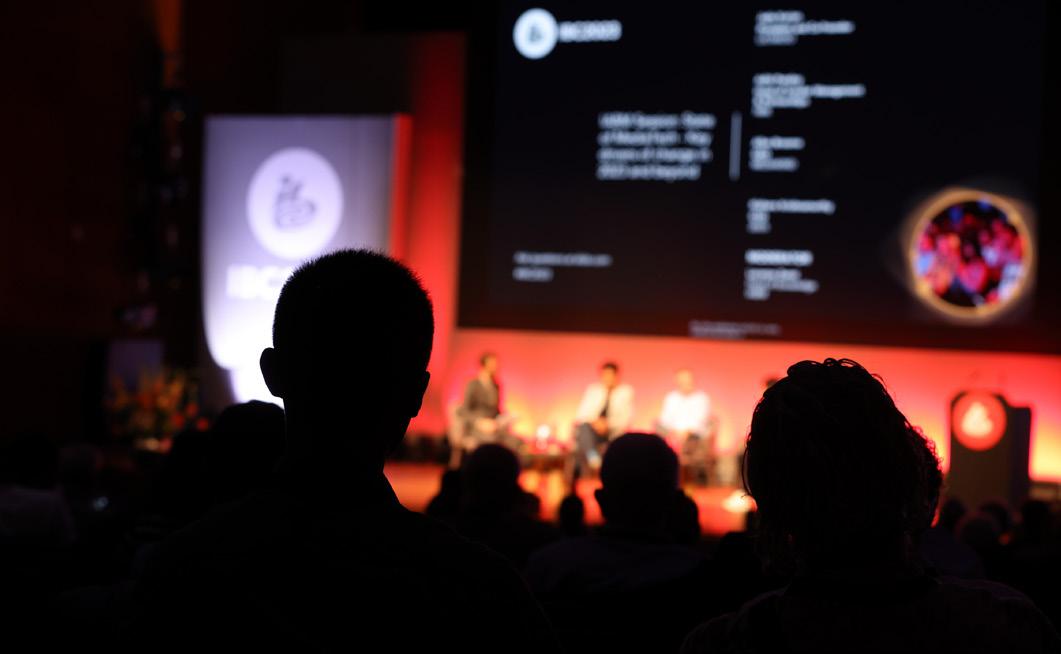
I visitatori dell'IBC2024 potranno sperimentare molte novità AV nelle aree espositive come durante le presentazioni, nelle masterclass e nelle demo, il tutto farà parte di un programma di contenuti focalizzato su temi come AI, 5G, Cloud, Esports, Esperienze Immersive, OTT & Streaming, AdTech e Tecnologie Connesse.
Come pensa che l'IA influenzerà la produzione di contenuti?
L'IA è ovunque e sarà un focus di IBC2024. La nostra nuova AI Tech Zone farà il suo debutto quest'anno, con aziende e tecnologie rivoluzionarie che renderanno possibile l’uso dell'IA nei media e nell'intrattenimento.
L'IA avrà un impatto sostanziale sulla produzione dei contenuti, migliorando l'efficienza: l'automazione delle attività di routine aiuterà i professionisti a concentrarsi sugli aspetti più complessi della produzione. Vediamo già che l'IA sta influenzando la creazione e personalizzazione dei contenuti attraverso l’analisi dei dati, una tecnica che consente ai Broadcaster di personalizzare la produzione. Numerosi fornitori, inoltre, utilizzano l'IA per migliorare i servizi di sottotitolazione e traduzione, rendendo i contenuti più accessibili a un pubblico più ampio.
L'IA è anche un tema chiave dell'Accelerator Media Innovation Programme di quest'anno, che riunisce utenti finali e professionisti e affronterà temi come la produzione basata su cloud, la disinformazione nei media, la sostenibilità o lo streaming sportivo a bassa latenza. L'AI Media Production Lab proporrà di lavorare sulla creatività nella narrazione, approfondendo il coinvolgimento del pubblico e sfruttando le analisi predittive in tempo reale per personalizzare la visione di eventi sportivi dal vivo.
https://show.ibc.org
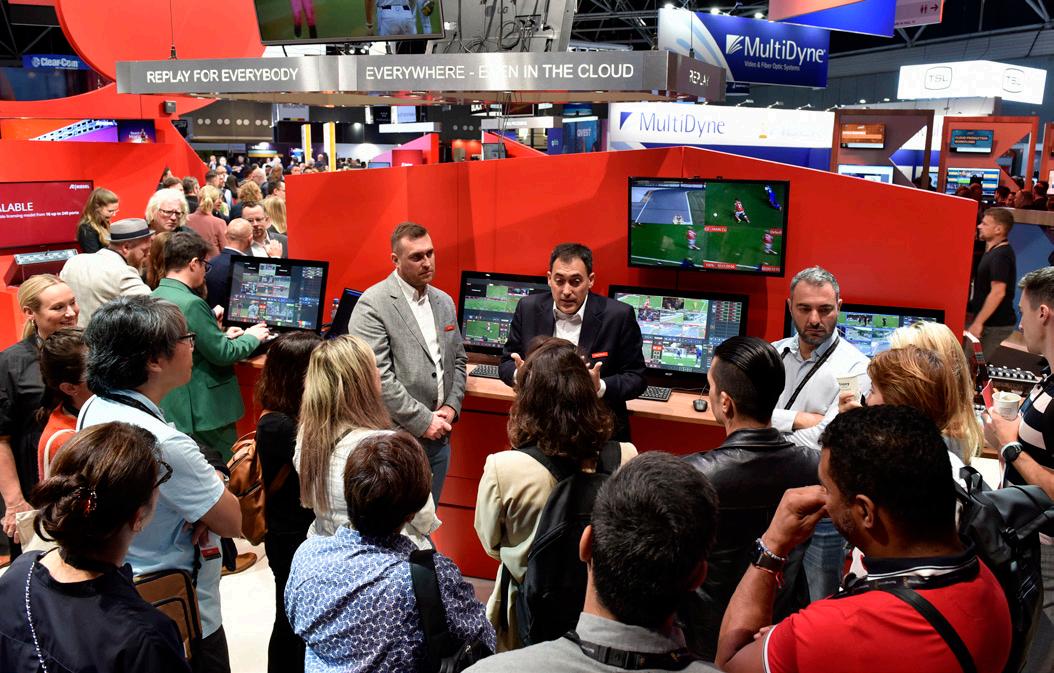
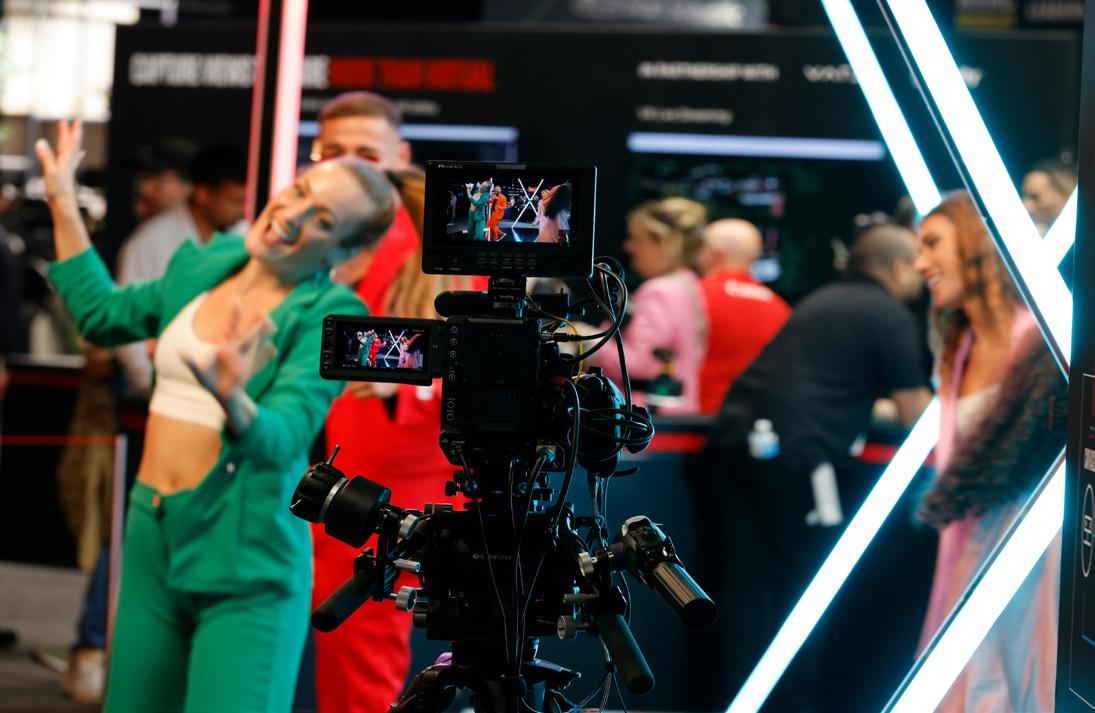

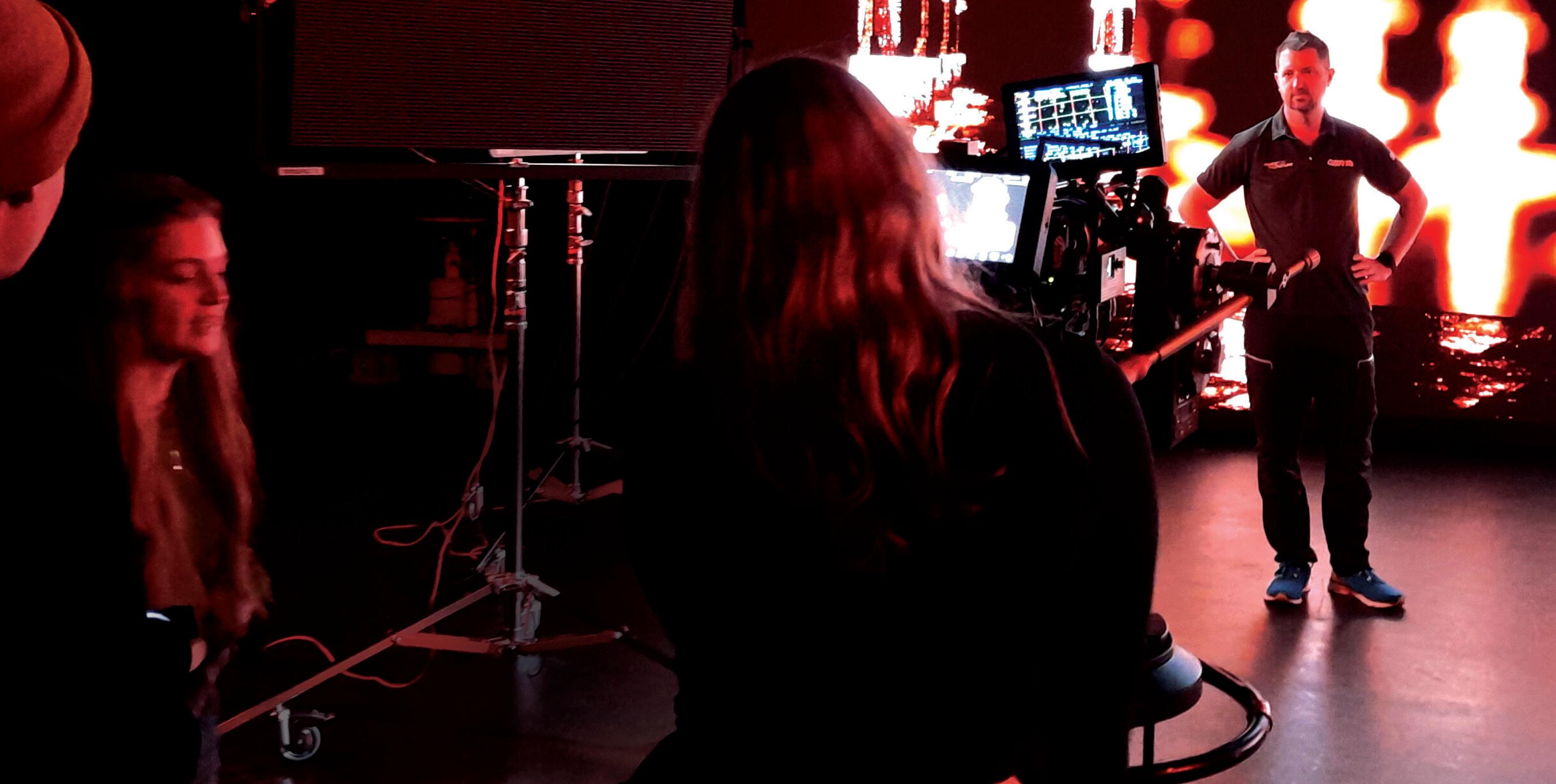
Insieme a Enrico Borghesi di Exertis Pro AV Italy abbiamo esplorato, dal punto di vista tecnico e di mercato, un filone del Broadcasting legato alle piccole produzioni e ai piccoli studi.
Ma in questo caso piccolo vuol dire semplice, non banale
Durante le interviste fatte per questo numero dedicato alle tendenze del “nuovo” Broadcast, è emerso un filone di piccoli studi, tecnologicamente validi anche se semplici, dotati di prodotti di buon livello spesso mutuati dal settore AV professionale, sovente noleggiati da rental company. Una tendenza emersa durante la pandemia, quando comunicare era diventato complicato e Università, aziende, enti di formazione hanno avviato canali propri di dialogo con il pubblico.
Oggi questa tendenza si è stabilizzata e vediamo tanti soggetti che non sono né Broadcaster, né case di produzione cinematografica o canali OTT, che hanno mantenuto e magari sviluppato i canali di comunicazione con il pubblico aperti a suo tempo; a loro si sono aggiunti Web TV, agenzie che si occupano di streaming di eventi di tutti i tipi, dalla moda al professionale, personalità pubbliche e dello spettacolo e tantissimi youtuber, alcuni dei quali possono contare su migliaia di utenti, che hanno avviato filoni e canali autonomi. Esploriamo questa tendenza in compagnia di Exertis che, per assecondare le necessità di alcuni sui clienti principalmente del mondo Corporate, ha iniziato un proprio cammino in questo filone del Broadcasting, oggi ampliato e sostenuto da continue conferme.
Ce ne parla Enrico Borghesi, Channel Manager Exertis ProAV Italy
Enrico Borghesi - Negli ultimi quattro anni molte delle forniture in ambito Broadcasting sono state per Web TV, Atenei Universitari, aziende per la costituzione di Virtual Set tecnologicamente validi anche se non di livello cinematografico, dove le caratteristiche di auto focusing, gestione remota, automazione si una telecamera
PTZ risultano più utile di una videocamera di ripresa televisiva, e dove i mixer grafici hanno primaria importanza per la gestione degli schermi a LED o dei Green Screen. Spesso la vendita si concretizza tramite rental company introdotte in questo settore, e prodotti e soluzioni vengono, più spesso noleggiate – sovente per periodi anche molto lunghi - piuttosto che vendute, ai clienti finali: una evoluzione anche nel modello di acquisto, che passa più attraverso l’acquisizione di una soluzione con un servizio, piuttosto che del prodotto in sé.
Come vi siete accreditati nel settore Broadcast?
Abbiamo iniziato perché volevamo offrire una risposta efficace ai nostri clienti con queste necessità, ma poi entrarci di diritto non è stato semplice. Si tratta di un settore piuttosto tradizionalista e non molto aperto a proposte tecnologiche e di marchi nuovi. Ci siamo inseriti grazie all’aiuto di alcuni nostri clienti e partner già presenti e conosciuti nel settore: col tempo abbiamo strutturato un vero e proprio filone aziendale, gestito da me e dal collega Stefan Ivanovic. Quali marchi e soluzioni sono stati trainanti?
Come azienda specializzata nell’AV professionale abbiamo diversi marchi già conosciuti nel settore, con prodotti che trovano applicazione sia nel mercato AV che nel Broadcasting. Il nostro “Cavallo di Troia” è stato inizialmente Barco, un marchio già ampiamente accreditato tra i broadcaster e semplice da proporre, e in particolare i mixer grafici, utilizzati per la gestione dei segnali in maniera ottimale sui LED wall. Da qui siamo entrati nel mondo dei LED, oggi a passo sempre più stretto, fino ormai a 0.8 o 0.6, con marchio anche qui Barco. Importanti anche le telecamere PTZ, per
noi col marchio Sony e Lumens, che risultano più adatte agli studi piccoli rispetto alle telecamere televisive: sono dotate di focus e movimentazione automatica e tracking, sono gestibili da remoto, dotate di connessione LAN, un vero ibrido tra Broadcasting e AV.
Da non dimenticare il mondo dell’audio, rappresentato per noi da Yamaha, in particolare dai mixer da banco, la serie QL per esempio, un prodotto di fascia alta che risulta fondamentale nelle produzioni. Quali saranno secondo voi le necessità nei prossimi anni?
Si va verso soluzioni agili e prodotti che corrispondano a esigenze molteplici. Credo che il mondo del Broadcasting diventerà sempre più vario e parcellizzato con una moltitudine di canali in mano a operatori non necessariamente specializzati: stanno diventando broadcaster le aziende, gli enti di formazione, personaggi pubblici ecc. Ci sarà sempre più necessità, quindi, anche di studi con una buona qualità ma anche molto agili, e qui la prospettiva di chi viene dall’AV pro può essere molto utile.
Dal lato tecnico, inoltre, crediamo che sarebbe importante una riunione dei formati, nell’audio ci siamo arrivati con Dante ma nell’ambito video ancora ci sono diversi formati; sarebbe infine auspicabile anche una razionalizzazione nel trasporto: il progredire del 4K e l’abitudine del pubblico a un buon standard visivo fanno aumentare il “peso” dei flussi, e la gestione di un segnale non compresso diventa sempre più complessa. Algoritmi di compressione adeguati al caso specifico possono risultare utili sia per la progettazione dell’infrastruttura che nella gestione interna dei segnali. https://exertisproav.it/
Con una lunga esperienza nel mondo dei media e del broadcast, EMG Italy è in grado di offrire ai propri clienti una grande affidabilità nei servizi ma, soprattutto, una continua ricerca verso l’innovazione tecnologica e l’aggiornamento delle risorse, per produzioni costantemente all’avanguardia

Il nome EMG Italy fa pensare immediatamente a due cose: sport ed eventi live. Il tutto, ovviamente, declinato in chiave di broadcast televisivo. L’azienda, infatti, nata dalla fusione di società storiche come Netco Sports, 3zero2 Tv e Global Production, è operativa non solo in Italia ma, con il gruppo EMG/Gravity Media anche in Europa, Stati Uniti, Middle East e Australia, ed è partner di diversi importanti eventi internazionali sia in ambito sportivo (giusto per citarne qualcuno, il Giro d’Italia, la Champions League e il campionato mondiale Superbike) che in ambito più generale di spettacolo live (e anche qui si parla di eventi universalmente noti come l’Eurovision Song Contest).
Insomma, quando si dice EMG si dice grande sport e spettacolo di alto livello, e la specialità dell’azienda, maturata in anni di esperienza, consiste nel fornire al mondo broadcast attrezzature e grafiche di prima qualità, con attenzione all’aggiornamento tecnologico, fondamentale in un ambiente
in cui occorre sempre crescere e migliorare non solo per andare incontro alle esigenze del pubblico, ma anche per stupire gli spettatori con tecnologie capaci di suscitare il cosiddetto “wow effect”.
Il broadcast: un poker giocato al rilancio
Il mondo broadcast, di fatto, è sempre “affamato” di novità, sia per quanto riguarda la qualità e la tipologia delle riprese (si pensi al recente investimento di alcuni grandi marchi cinematografici nelle filiere di camere broadcast, per portare anche nel mondo televisivo una “qualità cinema” che racconti al meglio l’epica di certe imprese sportive o di certi spettacoli artistici) che per l’importantissimo ambito delle grafiche in tempo reale, irrinunciabili in particolare per raccontare al meglio gli eventi sportivi, con dati, statistiche e informazioni di cui il pubblico non può fare a meno.
Da ultimo, sempre nell’ottica di un costante aggiornamento dei mezzi produttivi si inscrive anche la dotazione di LEDwall nei
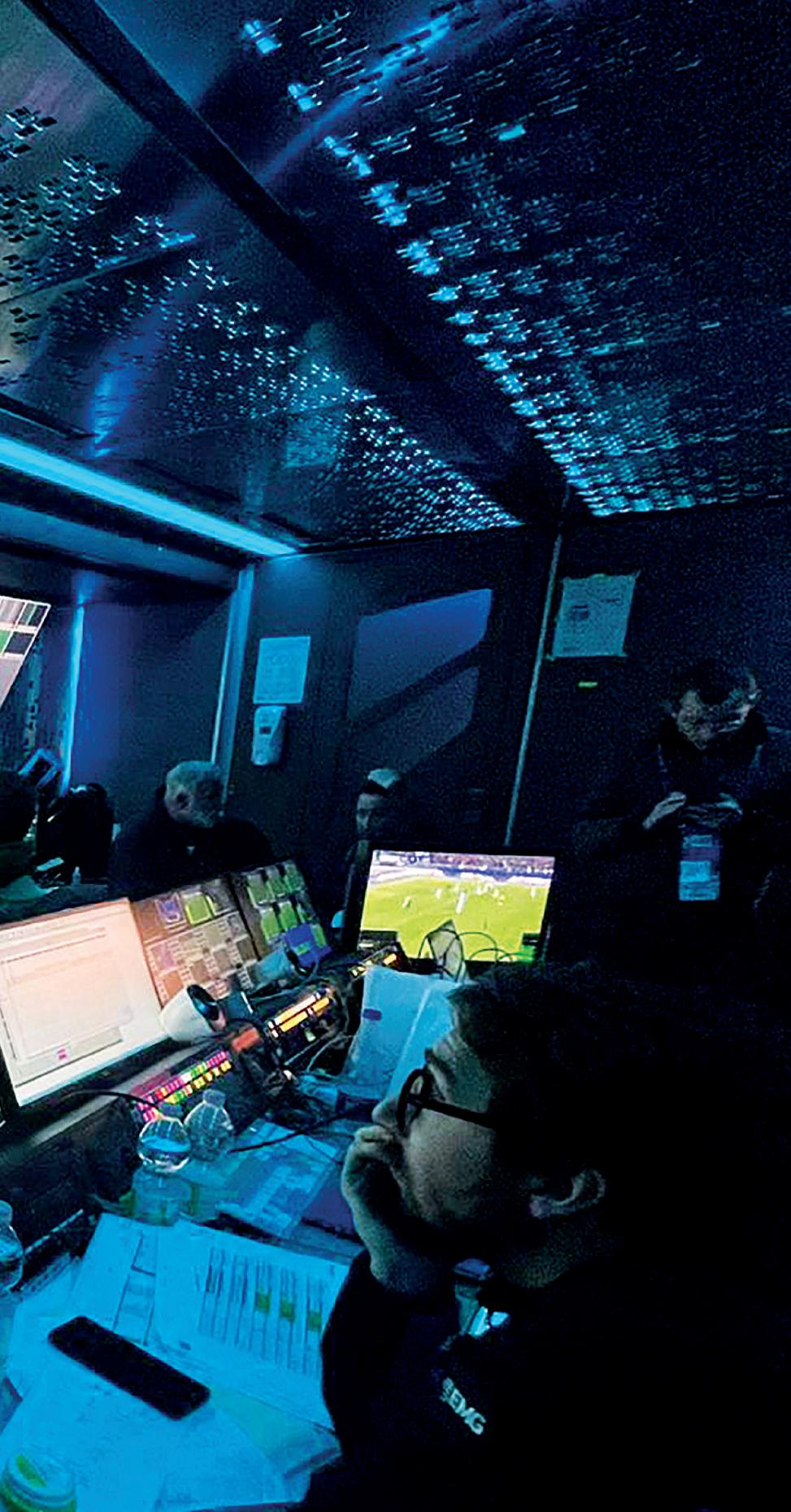
teatri di posa che, sia per la produzione televisiva che per quella cinematografica, sta guadagnando terreno sul “tradizionale” green screen (ovviamente, a seconda delle esigenze di espressione artistica e creativa). Insomma, è come una partita di poker in cui occorre sempre saper rilanciare, con innovazioni e miglioramenti che incidano sull’estetica stessa del mezzo televisivo, e ottengano da parte del pubblico quel “wow effect” cui accennavamo poco sopra, fondamentale soprattutto per spettacoli live ed eventi sportivi. Abbiamo avuto la possibilità di fare una lunga chiacchierata con Alessandro Curti, Head of Graphics Italia di EMG, che si è prestato con grande disponibilità e gentilezza a darci una panoramica del suo lavoro e dell’operato dell’azienda. Alessandro è in EMG dal 2005 e dall’inizio di quest’anno è diventato responsabile del reparto che si occupa di grafiche in ambito sportivo, occupandosi anche di planning, gestione degli operatori e commercializzazione dei servizi. Un ruolo di grande rilevanza e responsabilità che corona una carriera tutta all’insegna delle tecnologie informatiche per il broadcast.

Alessandro, come descriveresti in poche parole il vostro lavoro?
Ci occupiamo di grafica televisiva a carattere informativo e didascalico per lo sport, allo scopo di fornire tutto quello che serve allo spettatore per comprendere al meglio che cosa sta succedendo nella partita o nell’evento sportivo.
Abbiamo dei van grafici coi quali ci muoviamo in Italia e in Europa per le produzioni. I nostri tecnici montano l’impianto in loco, si prova tutto col regista, quindi si verificano i contenuti con la parte editoriale. Il nostro lavoro non è puramente tecnico, prevede anche un’ampia parte di creatività.
Quali sono le esigenze dei vostri clienti?
Quello che ci chiedono più di frequente è il cosiddetto “wow effect”, vogliono soluzioni che suscitino interesse e meraviglia nel pubblico. Ovviamente, non sempre i clienti sono perfettamente a conoscenza di quello che si può fare, tecnicamente, in quest’ambito.
Sta a noi guidarli e accompagnarli all’interno del nostro mondo, tenendo presente anche la potenzialità e l’importanza di questa tecnologia per le sponsorizzazioni: il cliente può “spendersi” le grafiche all’avanguardia per i suoi sponsor, e questo fa crescere il suo giro d’affari, e di rimando il nostro. I partner commerciali dei clienti finali
traggono grande beneficio dalla grafica in realtà aumentata, che consente sponsorizzazioni immersive e quasi interattive.
Lo sport come show: l’esempio della Coppa Italia
Ed ecco entrare nel discorso, con puntualità e immediatezza, due concetti a nostro avviso fondamentali: lo sport come spettacolo e l’applicazione della realtà aumentata in ambito grafico. Un evento sportivo molto recente, la finale di Coppa Italia tra Juventus e Atalanta, andata in scena allo Stadio Olimpico di Roma mercoledì 15 maggio, e conclusasi con la vittoria dei bianconeri, ci dà – letteralmente – l’assist per affrontare questi cardini tematici.
Hai parlato di realtà aumentata in riferimento alla grafica per gli eventi sportivi: puoi spiegarci quanto incide questa nuova tecnologia sulla produzione di questi eventi?
Lo sport sta diventando sempre più uno show. Noi abbiamo un’esperienza più che decennale nelle grafiche sportive, e l’ultimo livello della grafica live è proprio la realtà aumentata, che è in grado di far pervenire le informazioni al pubblico in modo molto più coinvolgente, valorizzando sia il prodotto in sé (la produzione televisiva) che i dati tecnici di uno sport (per esempio,
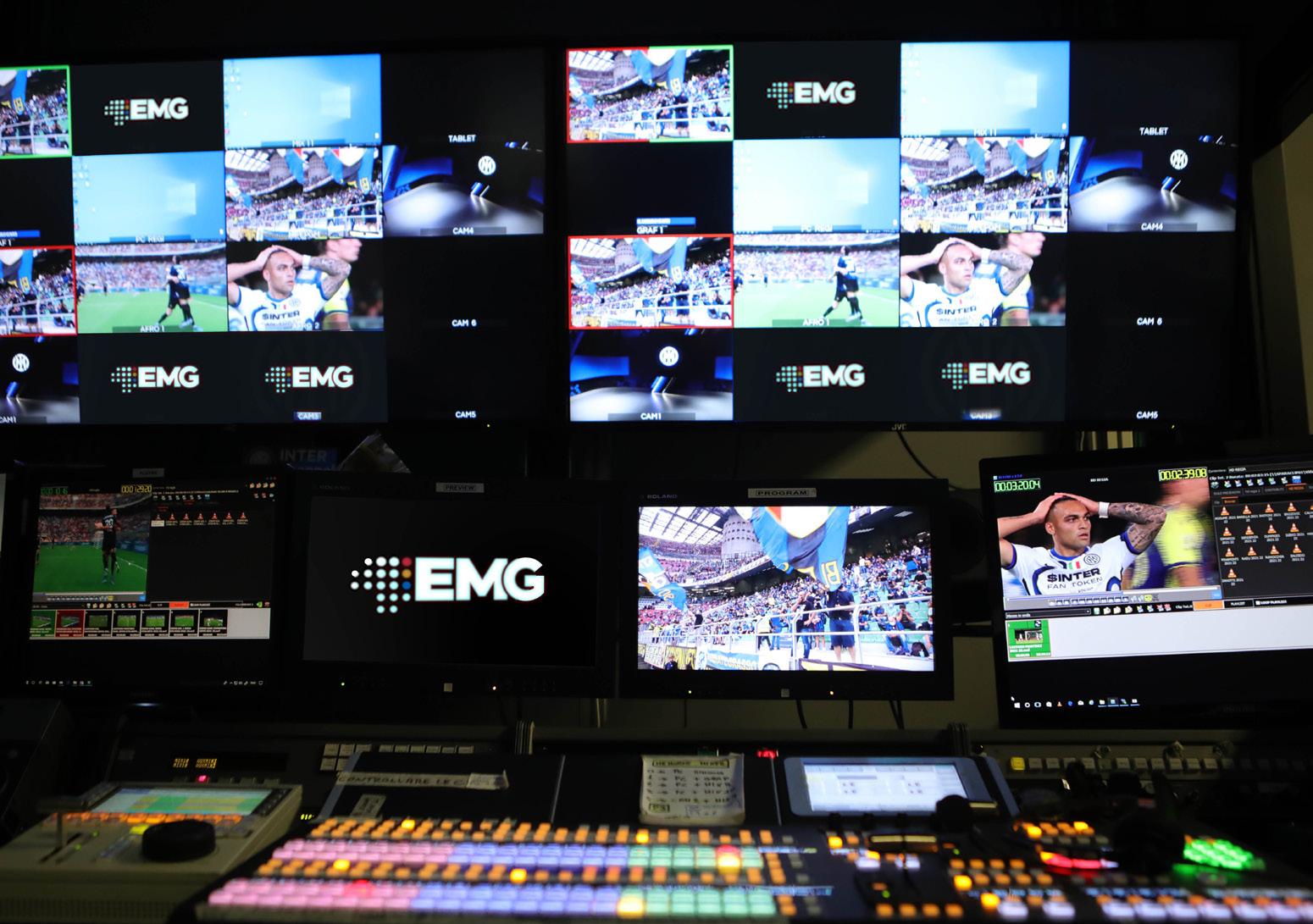
nel caso della finale di Coppa Italia, con le figure in 3D dei calciatori sullo schermo e le statistiche della loro stagione).
La realtà aumentata dunque è un valore aggiunto?
Sicuramente. Nel mondo dello sport le statistiche e i dati grafici sono sempre stati importanti, noi ci occupiamo, oltre che di calcio, anche di pallavolo e pallacanestro, sport per il quale curiamo anche, già da due stagioni, il lato VAR, con la instant review e dieci postazioni che raccolgono le immagini in tempo reale e le consegnano agli arbitri della partita, in contatto coi nostri operatori.
Come si svolge, all’atto pratico, il vostro lavoro?
Si parte sempre da un briefing col cliente, nel quale si individuano le esigenze e si identificano le template e gli elementi che si vogliono inserire. I nostri motion designer e i nostri grafici creano elementi 3D che siano abbinati alle esigenze del cliente. Ci incontriamo di nuovo e raffiniamo la versione delle grafiche, poi si entra nello step operativo.
Qui il punto cruciale è che dalle grafiche on screen siamo passati a realizzarle in uno spazio virtuale dedicato. Le nuove tecnologie e le nuove camere permet-
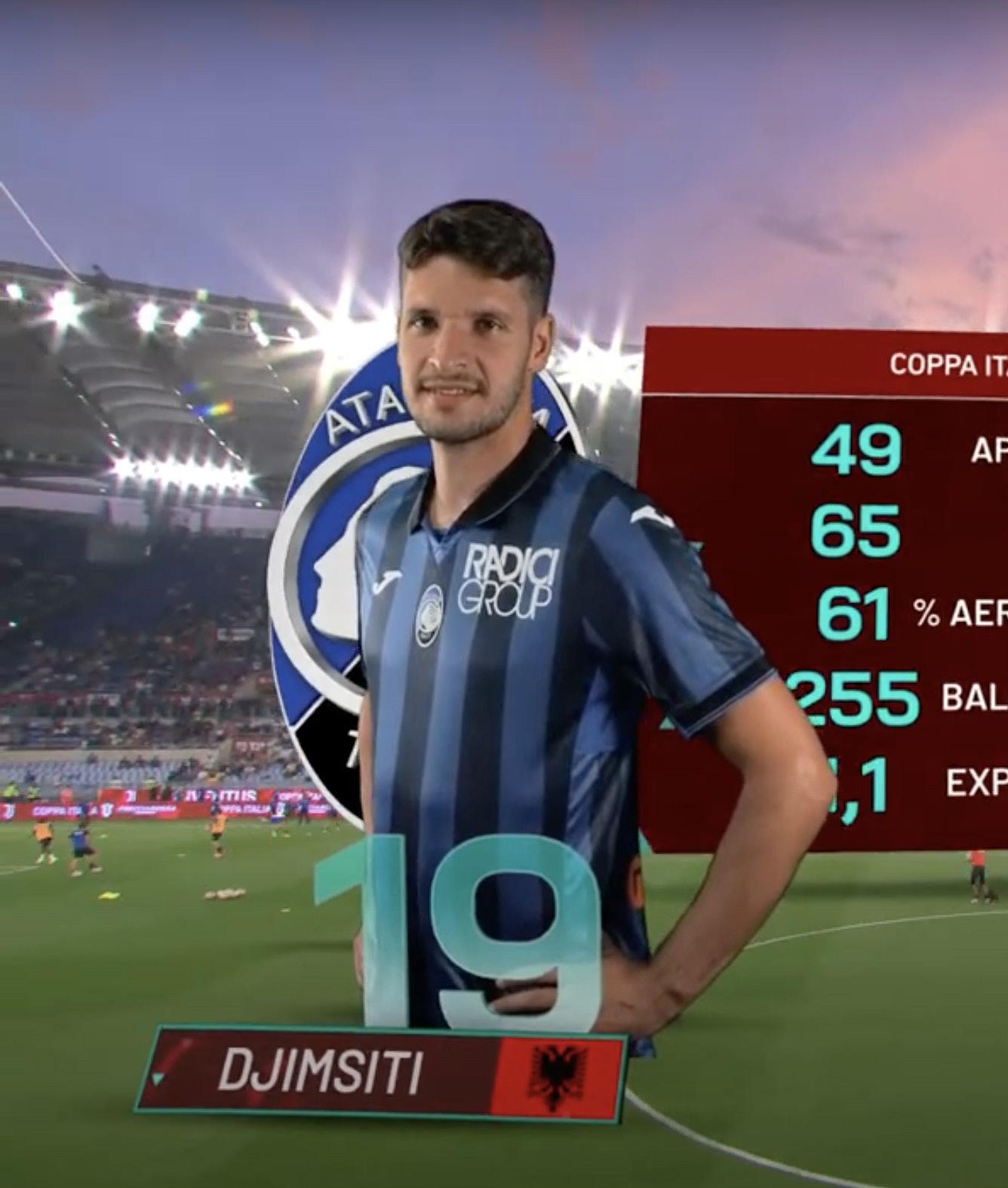
tono di valorizzare gli elementi grafici in 3D e di creare un racconto speciale dell’evento sportivo, a partire dal momento in cui si illustrano le formazioni che scenderanno in campo.
Cosa intendi per nuove camere? Tecnologie di ripresa innovative, più cinematografiche che televisive? Sì, e anche camere speciali, dedicate a determinati tipi di evento. Per esempio, all’Olimpico di Roma per la finale di Coppa Italia abbiamo avuto la Robycam, una camera girostabilizzata con innovativi sensori di movimento e di posizione, ancorata in quattro punti, per la modalità 3D, e agganciata a cavi che permettono di muoverla sopra il campo. La testa può realizzare panoramiche a 360°. Il segnale viene trasmesso tramite cavo in fibra ottica, quindi è estremamente affidabile per la produzione di eventi dal vivo. In più, la tecnologia Compass AR Tracking consente di aggiungere oggetti virtuali e grafica in realtà aumentata nel feed video in tempo reale. Anche i droni ormai sono molto diffusi: stiamo lavorando per sviluppare grafiche utilizzabili con le riprese effettuate dai droni, per le quali occorre un accurato tracking sui tre assi di movimento della camera perché l’elemento grafico venga collocato nel giusto spazio.


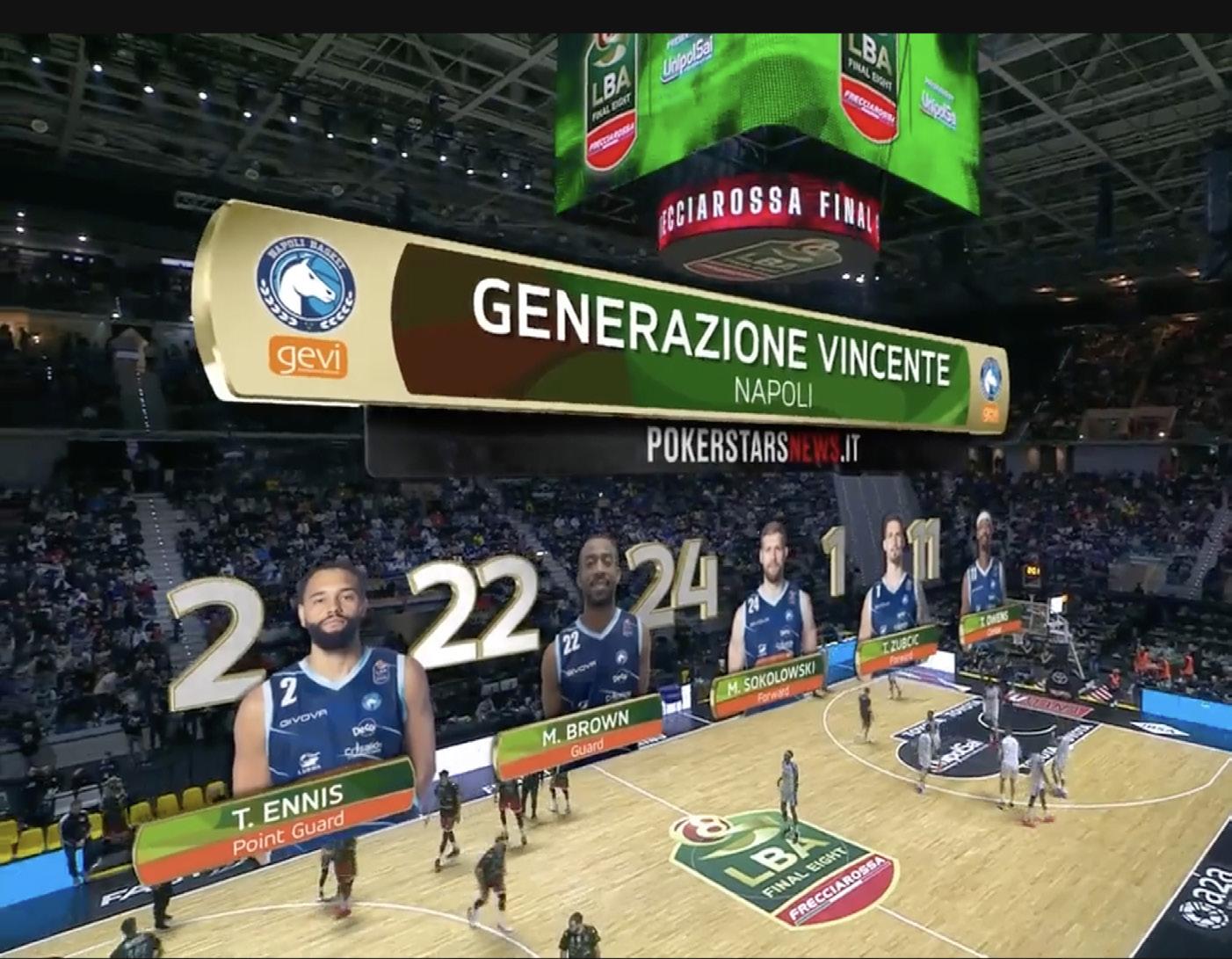
Scendendo nel dettaglio, visto che disponiamo di un esempio pratico recente: com’è andata la finale di Coppa Italia all’Olimpico di Roma?
Direi che è stata un successo. In questo caso il nostro cliente era LNPA, ovvero la Lega Serie A, che ci ha incaricati a fine aprile, quindi molto a ridosso dell’evento. Questa partita ha segnato un momento importante perché è stata per noi la prima volta che, in partnership con LNPA, è stata utilizzata la realtà aumentata per un evento calcistico.
L’unico precedente, sempre a nostra cura, era un test fatto in autunno, a San Siro, in occasione del match Milan – Fiorentina, ma non andò in onda.
Per Juventus – Atalanta di Coppa Italia, invece, abbiamo curato tutta la grafica con elementi innovativi come le schede di confronto tra le squadre e i singoli giocatori. Da un paio d’anni ci muoviamo decisamente in questa direzione, e abbiamo realizzato grafiche con realtà aumentata sia per la pallavolo che per il basket.
La grafica in realtà aumentata, insomma, sta soppiantando le grafiche tradizionali? È questo il futuro?
Più che altro, grafica tradizionale e realtà aumentata vanno di pari passo, si integrano e interagiscono, l’una arricchisce l’altra. Infatti, noi facciamo sia grafica tradizionale che grafica in realtà aumentata, anche in altri Paesi come Germania, Belgio, Svizzera e Francia. Per gli eventi in diretta, il punto centrale consiste nel mandare le grafiche in tempo reale: il sistema viene sviluppato perché funzioni live.
Oltre alle tecnologie, servono anche operatori formati appositamente per gestire questo tipo di produzione.
Quali sono, nei tratti essenziali, le attrezzature e le infrastrutture su cui si basa il vostro lavoro?
Software e hardware proprietari, nonché computer molto potenti. I software li sviluppiamo internamente da trent’anni a questa parte, grazie alla piattaforma grafica NEXT, su cui carichiamo i nostri progetti. Per la realtà aumentata ci appoggiamo a
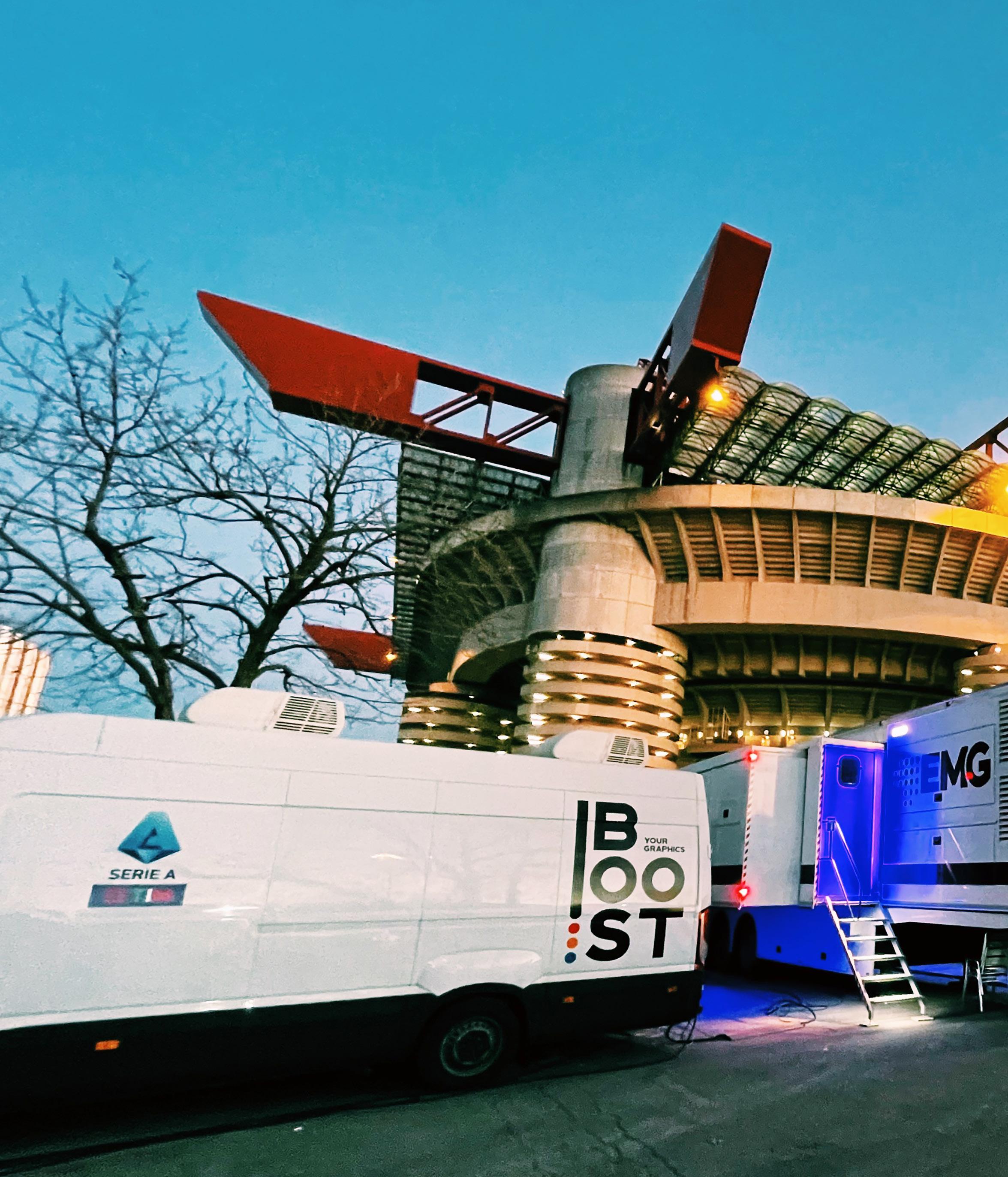
Vizrt, che sviluppa hardware e software dedicati alla grafica televisiva. Abbiamo dieci van grafici per l’Italia, e una cinquantina per tutta l’Europa, attrezzati con apparecchiature all’avanguardia.
La nostra azienda nella sua divisione italiana si chiama EMG Italy, ma sul piano internazionale da gennaio di quest’anno figuriamo come EMG/Gravity Media, realtà operativa in Europa, USA e Australia. Infine, tengo molto a sottolineare che un valore imprescindibile è rappresentato da tutta la squadra con cui lavoro, persone che hanno grande dedizione per questo mestiere che spesso non ha orari e impegna anche in giorni festivi.
In particolare, vorrei citare Dario Lombardi, responsabile sviluppo software, Elio De Ponti, che si occupa del design grafico, Lorenzo D’Alessandro per il playout e i centri di produzione, Antonello Grippo, project manager ciclismo, e infine Antonio Inglese, che segue la parte tecnica e gestisce la dotazione e il materiale.

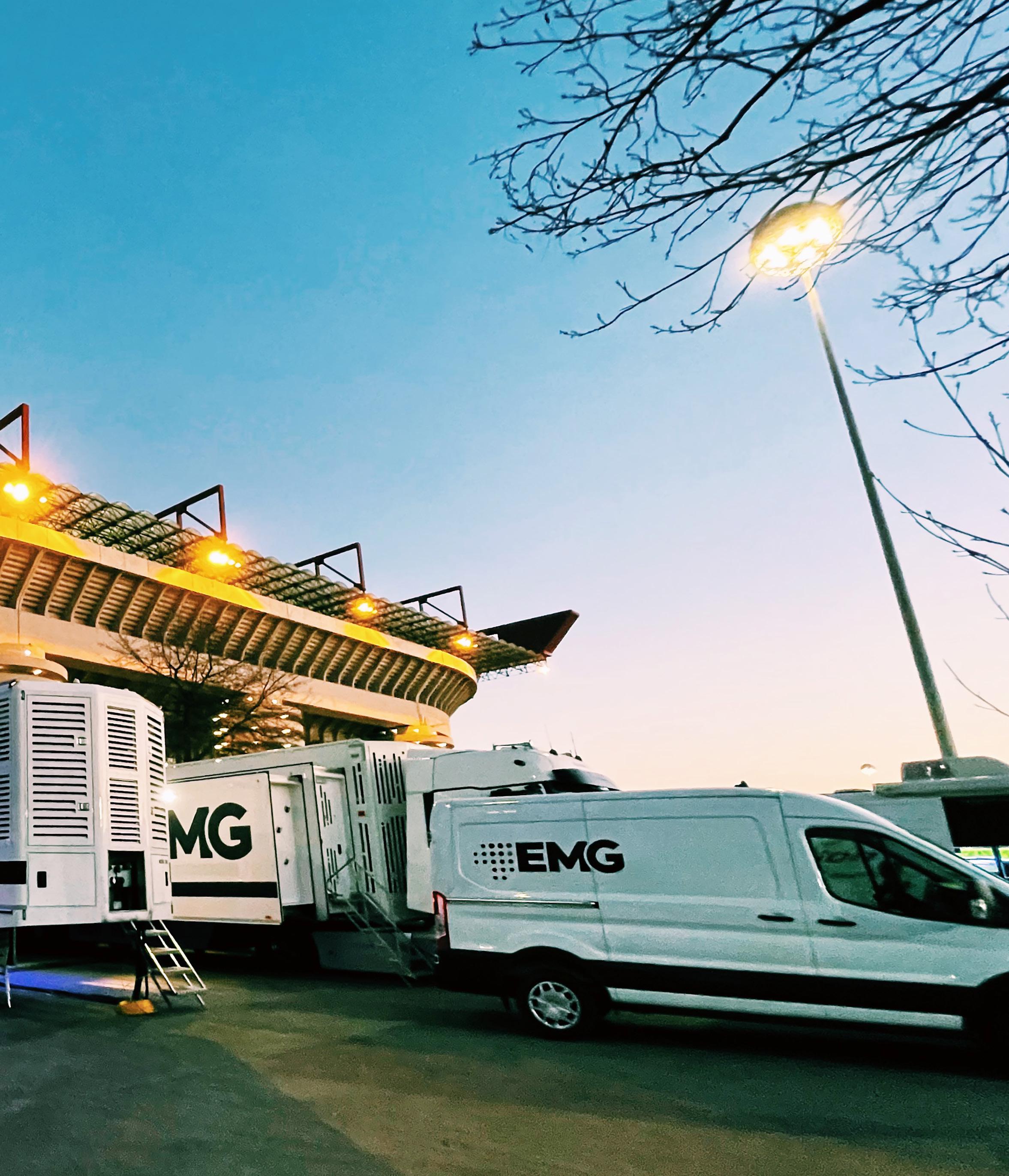
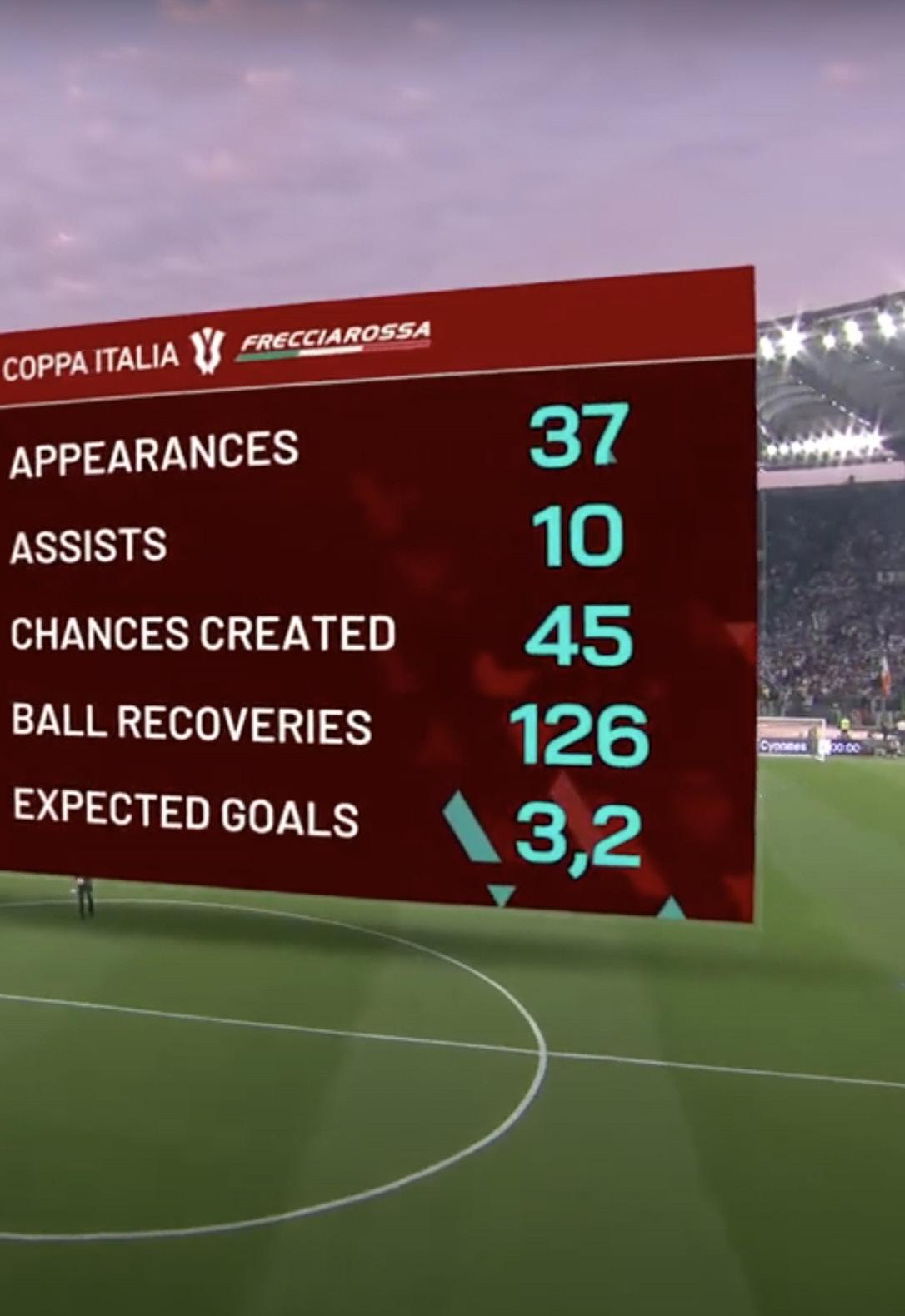
Un’ultima domanda: come vedi il futuro del vostro settore? Quali possibili implementazioni e sviluppi?
La nostra attività è in netta espansione. Per quanto riguarda l’immediato futuro, l’Intelligenza Artificiale è il cavallo che sta trainando lo sviluppo un po’ in tutti i settori: sta entrando ovunque, a piccoli passi, e gli sviluppi sono potenzialmente molto grandi. Abbiamo già fatto, per esempio, dei test coi comandi vocali in una produzione televisiva, e abbiamo provato a usare l’AI in ambito problem solving o sull’elaborazione di immagini di altissima qualità in tempo reale. In futuro, l’Intelligenza Artificiale potrebbe rappresentare una grande acquisizione anche per la gestione del tracking: già adesso la usiamo per seguire in automatico i soggetti in movimento, per esempio nel ciclismo.
Durante le dirette delle tappe delle grandi corse, i ciclisti vengono seguiti in automatico e si aggiungono in real time elementi grafici di approfondimento o statistiche.
https://it.emglive.com/

Nicola Martello
Circa 800 schermi LED sono distribuiti lungo l’intera rete di Autostrade per l’Italia e fanno
tutti capo a Screenlight, che li gestisce dalla sua cabina di regia. Alcuni di questi display fanno parte dell’installazione presso l’Autogrill Casilina Est, un impianto di riferimento per completezza e ricchezza di elementi installati
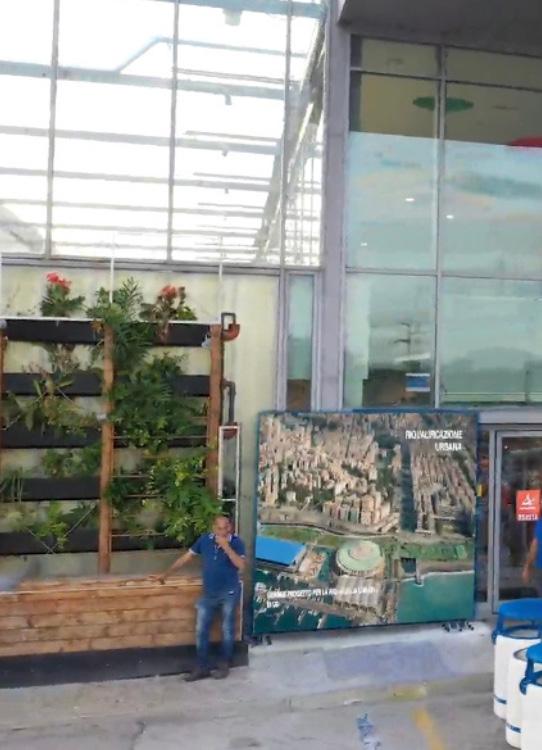
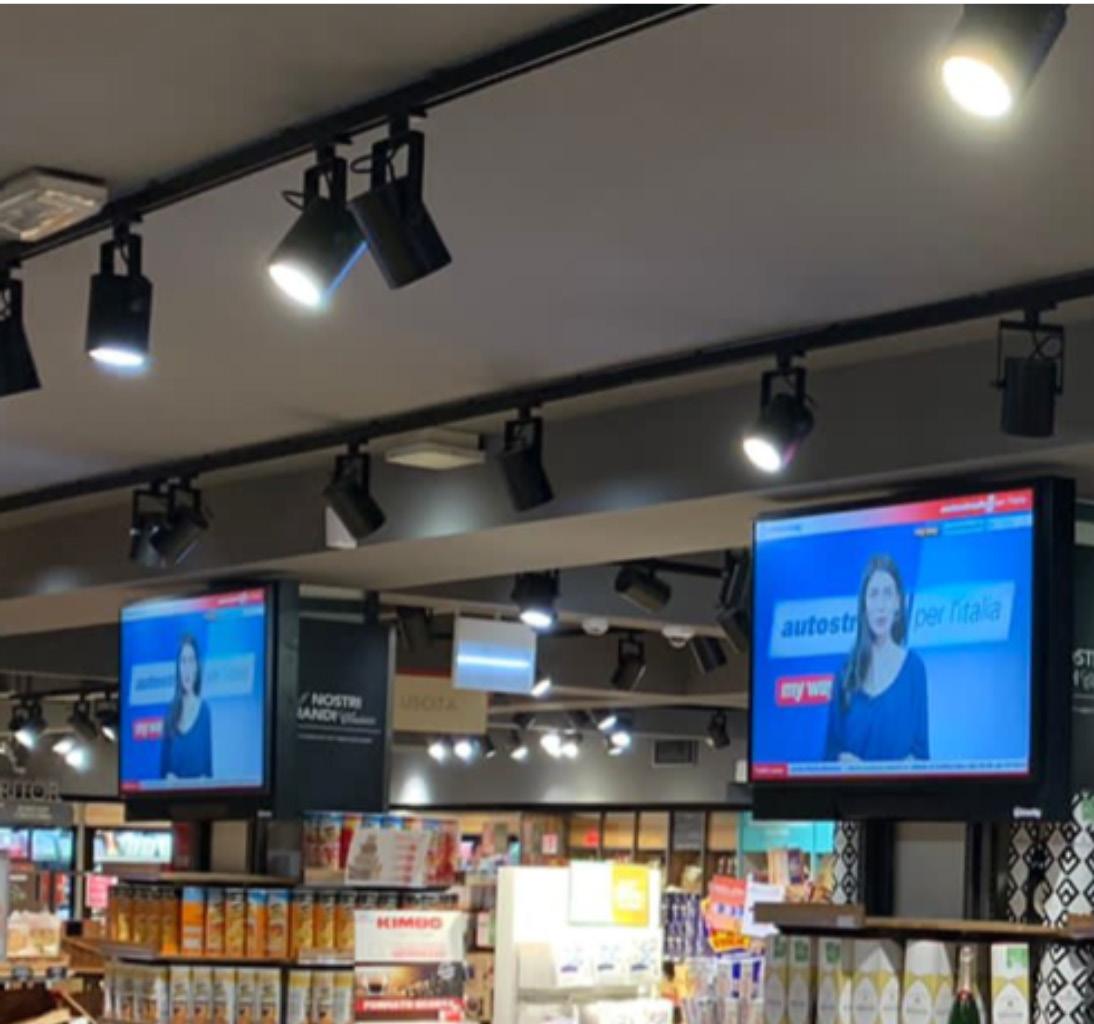
L’azienda romana Screenlight è specializzata in allestimenti dal forte impatto visivo, che utilizzano grandi schermi adatti a eventi, installazioni permanenti e digital signage.
Tra i suoi clienti annovera Autostrade per l’Italia, per la quale gestisce circa 800 display sparsi nelle aree di servizio dell’intera rete autostradale. A seguito dell’inaugurazione dell’impianto dell’Autogrill Casilina Est, un riferimento in quanto a soluzioni visive e interattive, abbiamo parlato con Andrea Betti, che collabora con Screenlight e che ci ha descritto le peculiarità di questa installazione.
La collaborazione con Autostrade per l’Italia
Il rapporto di Screenlight con Autostrade

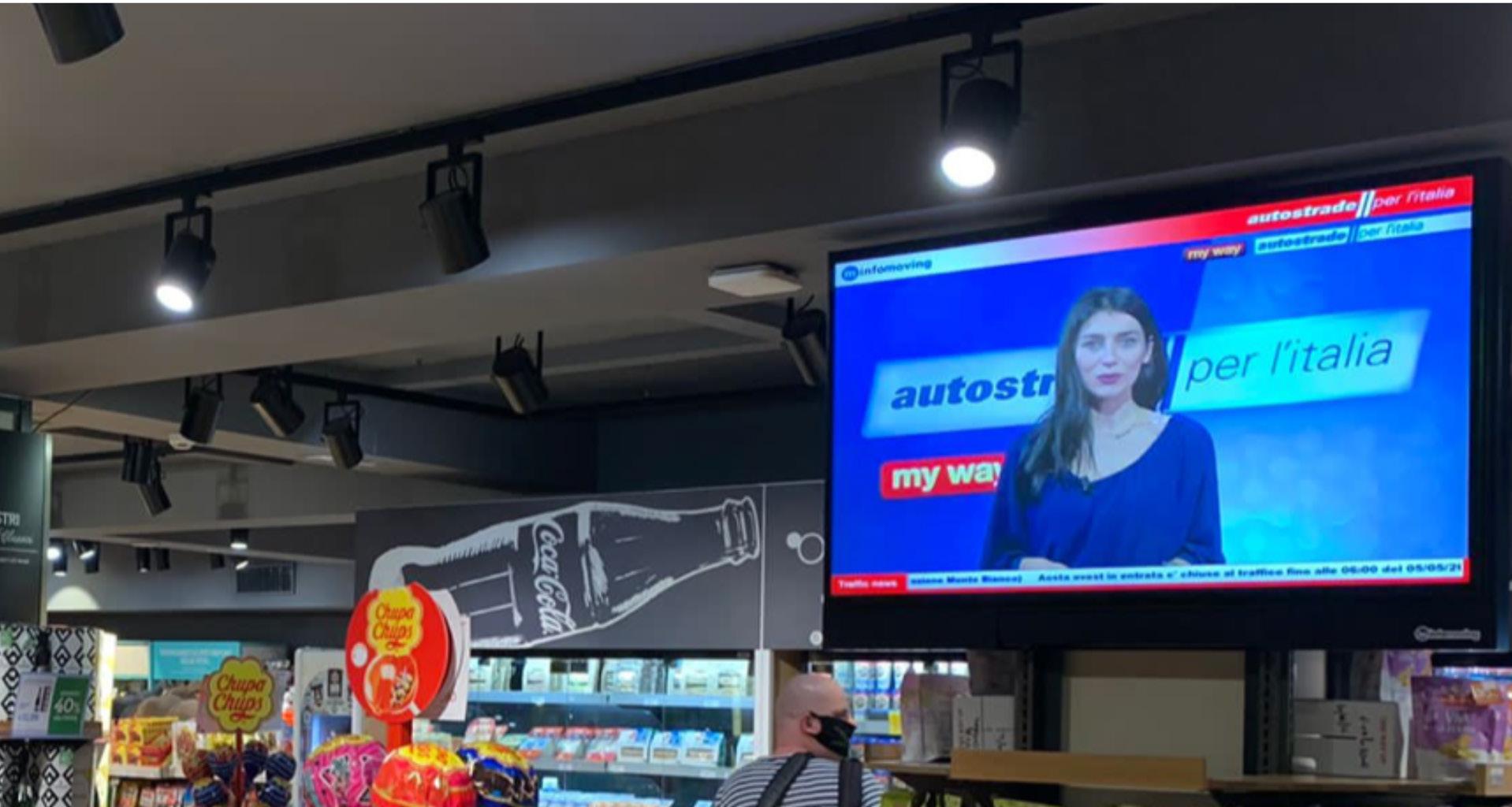
è iniziato circa 14 anni fa a seguito di una iniziativa di Betti, che ha portato a una prima installazione di 20 schermi led in corrispondenza di quattro dei più importanti Autogrill del circuito autostradale. Questo intervento è stato finanziato totalmente da Screenlight, con un investimento finalizzato a dimostrare ad Autostrade la validità e l’efficacia del digital signage, all’epoca poco conosciuto e sfruttato.
La fornitura dei contenuti multimediali è stata a carico di InfoMoving, società del gruppo Autostrade, mentre la gestione della pubblicità era in mano a un’agenzia che girava a Screenlight un terzo del fatturato ottenuto con i contributi pubblicitari.
Il progetto è cresciuto nel tempo molto velocemente, fino ad arrivare a 500 monitor installati nelle aree di servizio.


Display innovativi, dotati di telecamere e riconoscimento dell'età e del genere, mostrano pubblicità personalizzate in tempo reale, seguendo le tendenze del marketing e rispettando le normative sulla privacy.

Questa crescita è stata a carico di Autostrade per quanto riguarda l’aspetto finanziario, mentre Screenlight ha continuato a occuparsi dell’installazione, dell’assistenza tecnica, della gestione dei contributi multimediali.
Dopo circa otto anni è stata cambiata la piattaforma di gestione dell’intero sistema, che è passata da quella proprietaria di Screenlight alla piattaforma standard e molto performante Magic Info di Samsung. Quest’ultima piattaforma consente di gestire l’intero sistema a livello di singolo monitor, così da poter indirizzare i vari contributi multimediali nelle differenti località, con una personalizzazione molto capillare e puntuale.
Questa granularità è garantita anche per la diagnostica, fatta in tempo reale e visibile agli addetti - sia di Screenlight sia di Autostrade - tramite un’app per dispositivi mobili.
L’installazione di Casilina Est Autostrade, visti gli ottimi risultati, ha finanziato un’ulteriore crescita del sistema, per cui oggi Screenlight gestisce circa 800 display, tra cui quelli installati nell’Autogrill Casilina Est in provincia di Frosinone, dove sono stati posizionati LEDwall, display LCD e totem touch interattivi, per offrire ai visitatori una customer experience multimediale, completa e immersiva. Si tratta dell’impianto più importante e completo curato da Screenlight, che comprende circa 300 metri quadri di schermi LED, situati sia all’interno sia all’esterno. Questo impianto è il prototipo delle future installazioni che Autostrade conta di fare in corrispondenza delle più importanti stazioni di servizio della rete, gli Autogrill interessati saranno circa 25.
Seguendo le più recenti tendenze del marketing e nel pieno rispetto delle normative sulla tutela dei dati personali, i display posizionati all’ingresso sono dotati di telecamere e di un’elettronica per il riconoscimento dell’età e del genere delle persone che ci passano davanti, così da mostrare in tempo reale i contenuti pubblicitari più adatti all’audience del momento.
Il totem touch all’interno fornisce inoltre al pubblico informazioni relative alla viabilità e anche alla sicurezza, dato che offre un collegamento diretto con la stazione più vicina della Polizia Stradale.
Tutti i pannelli sono di classe di protezione IP67, quindi resistenti alle intemperie e all’acqua, in più sono racchiusi in con -
tenitori metallici curati dal punto di vista estetico, progettati, realizzati e installati da Screenlight. Nella progettazione è stata curata la sicurezza in termini di resistenza alle perturbazioni e al vento.
La cyber sicurezza
L’intero sistema di gestione dei display per Autostrade è protetto dai cyber criminali da più livelli di sicurezza, a cominciare da quello di Autostrade stessa, che fornisce un accesso dedicato e protetto a Screenlight per le funzionalità strettamente connesse alla gestione e alla sorveglianza degli schermi multimediali.
Un’ulteriore protezione è fornita dalla piattaforma Magic Info, che è conforme a tutte le regolamentazioni europee relative alla sicurezza informatica. Infine, Screen -
light è protetta dai suoi firewall, che impediscono l’accesso al cloud proprietario da parte di estranei malintenzionati.
La preparazione dei contenuti
I contributi video, immagini e spot pubblicitari sono realizzati dalle agenzie e dalle aziende che hanno firmato con Autostrade un contratto per la distribuzione dei propri contenuti. Screenlight li prende in carico, li trasforma in format che siano coerenti a livello di caratteristiche tecniche (risoluzione, rapporto d’aspetto, livello audio) e infine li inserisce in un palinsesto programmato.
I video devono avere una risoluzione
Full HD (1.920 x 1.080 pixel) e rapporto d’aspetto pari a 16:9. Da notare che tutta l’elettronica e i display stessi sono già

Screenlight dispone di attrezzature audio e video di livello broadcast e oltre 1.200 metri quadrati di led wall, inclusi 300 metri quadrati recentemente acquisiti per un progetto di Virtual Studio.

compatibili con il formato Ultra HD (3.840 x 2.160 punti), compresi i LEDwall la cui risoluzione deriva da un dot pitch molto fine pari 2,5 mm, quindi le immagini sono scalate in automatico a questa risoluzione. Il materiale pubblicitario è accompagnato da flussi informativi aggiuntivi, come le previsioni del tempo, fornite dal servizio meteorologico dell’Aeronautica Militare, e le notizie, che giungono in tempo reale da Sky TG24 e che scorrono in una barra visibile nella parte inferiore degli schermi. La gestione di questi contributi è totalmente automatica. I contenuti video arrivano alle postazioni delle stazioni di servizio tramite il cloud di Screenlight e il Web, e sono caricati in una memoria locale, così il sistema può continuare a funzionare anche se la Rete cade. Le informazioni sono fornite in tempo reale.
www.screenlightsrl.it

I display che Screenlight propone spaziano dai classici pannelli LCD ai LEDwall di grandi dimensioni, passando per i totem touch interattivi. Screenlight dispone in esclusiva dei moduli microLed Samsung della serie The Wall con dot pitch di 1,6 mm, dei pannelli led Unilumin (marchio cinese, il più grosso produttore mondiale di led wall), del software di gestione remota Samsung Magic Info e di un applicativo proprietario per il digital signage. A tutto questo si aggiunge un set completo di attrezzature audio e video di livello broadcast, come telecamere, mixer e console di regia. Screenlight usa hardware di proprietà per le proprie installazioni. Recentemente sono stati acquisiti 300 metri quadri di led wall per un totale di 1.200 moduli, che saranno utilizzati per un importante progetto per il broadcast (Virtual Studio), in fase di completamento. In totale Screenlight dispone di oltre 1.200 metri quadrati di led wall.
Il servizio che Screenlight offre è completo e personalizzato, letteralmente chiavi in mano. L’azienda si occupa della definizione del progetto su specifiche del cliente, dell’individuazione di tutti i requisiti tecnici, dell’installazione in loco completa dei lavori necessari per creare da zero i supporti per i display. Uno dei punti di forza è la sala regia, dove personale qualificato segue i palinsesti e i contenuti. Il cuore di questo impianto è il software Magic Info, che consente di gestire sia i contenuti sia i dispositivi in tempo reale e da remoto da un’unica piattaforma. Magic Info monitora costantemente le installazioni e invia segnali di allerta in caso di malfunzionamento - anche di un singolo pixel - per attivare in maniera tempestiva l’assistenza.
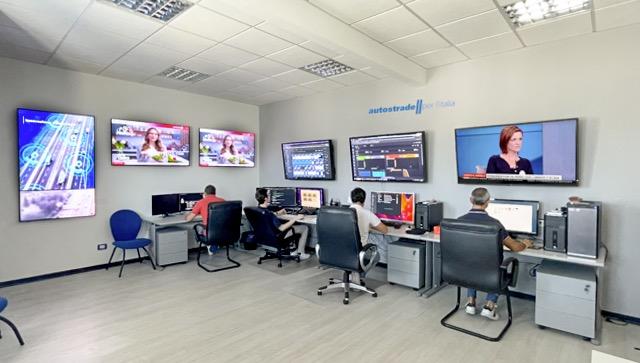
Screenlight opera con RAI, Mediaset, Università Roma Tre (dove ha installato uno schermo The Wall di Samsung), segue eventi di rilievo come l’assegnazione dei premi David di Donatello e le partite di calcio a cinque (con installazioni di pannelli LED lungo tutto il bordo campo).
Screenlight è presente anche nel settore del cinema, mediante scenografie digitali, realizzate con LEDwall dalla qualità visiva molto elevata e capaci di funzionare al meglio con le telecamere digitali.
Gabriele Lusco e Sergio Sasso
sono soci di AMS, società cooperativa piemontese, attiva su tutto il territorio, specializzata nella produzione di servizi tecnici, artistici e creativi per broadcast, streaming, eventi, produzione e postproduzione audiovisiva e multimediale, installazione e integrazione di sistemi audio-video-lucicontrollo, e molto altro. Con loro abbiamo approfondito esigenze, tecnologie e risultati della collaborazione con l’emittente sportiva Mola TV per la realizzazione di contenuti on demand e live nella sede di Torino


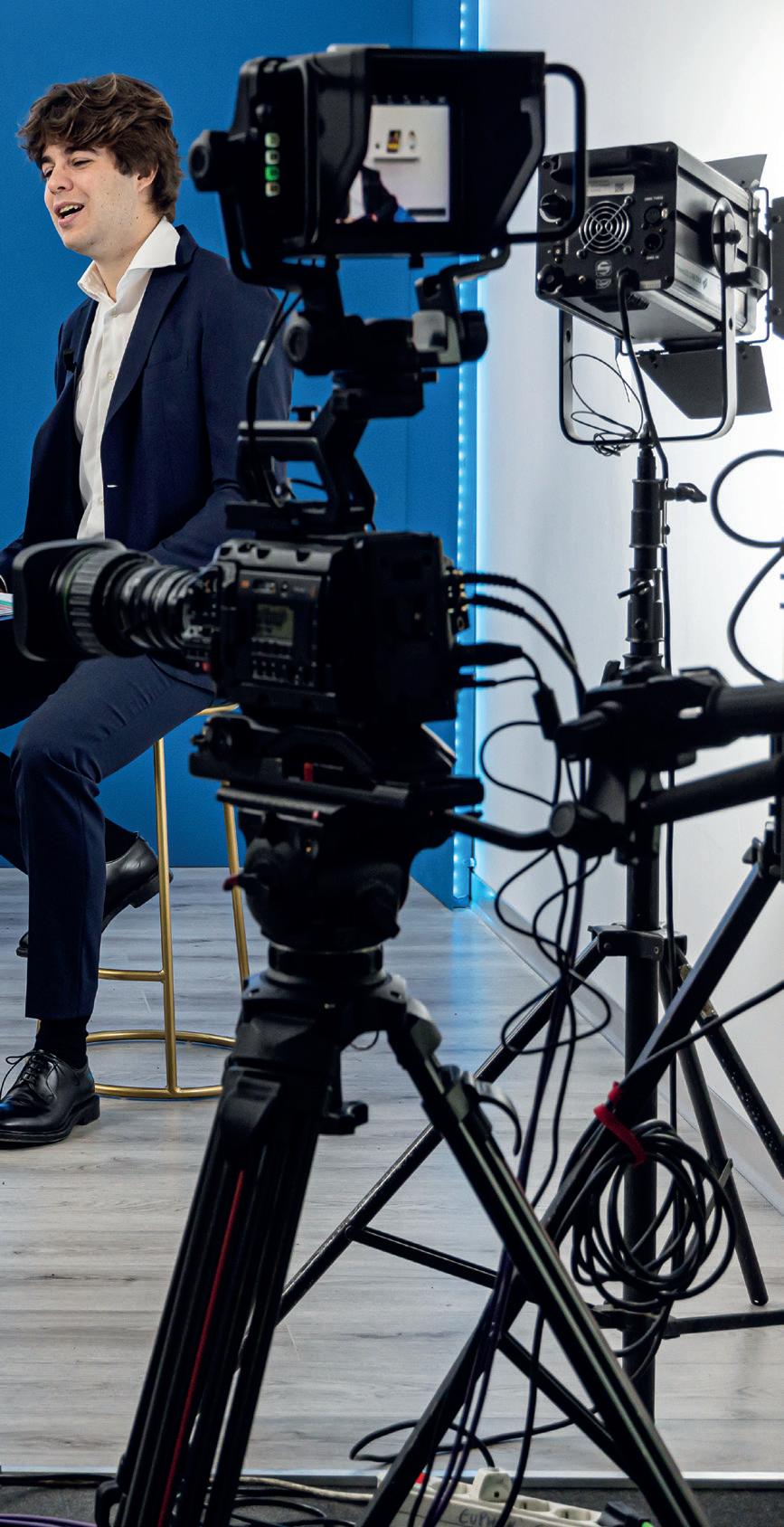
Gabriele Lusco e Sergio Sasso di AMS, società cooperativa piemontese, hanno collaborato con Mola TV per creare contenuti live e on demand a Torino.
Accendere la tv di casa, o andare al bar, per seguire partite e trasmissioni sportive? Non è più tempo di tradizione per il broadcast. Oggi, tutti noi sappiamo, a prescindere dal fatto che ne fruiamo o meno, di poter seguire competizioni sportive famose o di nicchia con contenuti on demand, sottoscrivere abbonamenti per specifici tornei e campionati, rivedere contenuti in streaming. Ovunque ci troviamo, in qualunque momento della giornata, per ogni sport. Il bello del digitale, forse l’unica eredità positiva dell’emergenza covid, che sta di fatto rivoluzionando i modelli di business degli editori e delle emittenti televisive. Ma anche di tutta la filiera di technology provider e professionisti connessi al variegato mondo dello sport. Esempio di questa evoluzione, la rapida ascesa di Mola TV, piattaforma di streaming video on demand e over-the-top indonesiana che detiene i diritti di molti eventi sportivi, in diverse nazioni, oltre a offrire una ricca libreria di film e serie TV, anche originali.
Flusso di lavoro Blackmagic Design
Telecamere
2x URSA Broadcast G2
2x Studio Camera 4K Pro
Regia
1x ATEM Television
Studio HDI8 ISO
3x Hyperdeck Studio HD Mini
1x Blackmagic Video Assist
12G HDR
2x Studio Converter
La sede italiana di questa emittente giovane e innovativa si trova a Torino ed è diretta da Goffredo d’Onofrio, con il coordinamento giornalistico del vicedirettore Enrico Zambruno. In particolare, offre contenuti on demand e in diretta su calcio, fighting e gare automobilistiche, ma il suo palinsesto è in costante aggiornamento. Tra gli eventi più seguiti, per il calcio ci sono Copa Sudamericana, Copa Libertadores, partite della Primera División argentina (con focus sui “clasicos”) ed Eredivisie, ovvero la serie A olandese. Mola TV trasmette anche gli incontri della Cage Warriors Fighting Championship (CWFC), organizzazione britannica di arti marziali miste e della Karate Combat, prima lega professionale di
karate a contatto pieno con sede a New York. Non mancano infine le auto, con la Gara Nascar, il rugby e altre new entry. Chi c’è dietro questa costante produzione di contenuti? Il team broadcast di Artistica Music & Show SCpA, in breve AMS, società cooperativa di Torino che conta 240 soci e una presenza quasi trentennale sul mercato. Con le sue divisioni, questa realtà offre infatti molteplici servizi in tema di comunicazione audiovisiva, eventi e installazioni. A occuparsi delle interviste e dei dibattiti connessi agli episodi sportivi, realizzati ogni settimana negli studi di Mola TV, sono proprio gli specialisti della divisione di AMS AMS|Multimedia, con l’ausilio delle più recenti tecnologie broadcast di Blackmagic Design.
La divisione, nonché sede secondaria di AMS a Torino, si dedica infatti alle attività di produzione e postproduzione audiovisiva e multimediale. Ancor più nello specifico, alla sua business unit The BlackStudio, fondata da Gabriele Lusco e Sergio Sasso, sono affidati tutti i progetti di Mola TV. “Avevamo già avuto modo di collaborare con Enrico Zambruno, nelle sue precedenti esperienze giornalistiche. Proprio lui ci ha ricontattato per il supporto tecnico legato a questi contenuti live e on demand”, spiegano i due professionisti. “La nostra realtà si occupa di produzione, postproduzione, regia video live multicamera, streaming, contenuti corporate, vantando una lunghissima esperienza nel mondo sportivo, motivo per cui Mola TV si è rivolta a noi”
Specialisti nella produzione
L’attività principale della collaborazione tecnica riguarda la realizzazione degli approfondimenti on demand dedicati agli eventi sportivi dei quali Mola TV detiene di diritti. In sostanza, trasmissioni con
opinionisti e telecronisti, oppure interviste a ex campioni ed esperti, che commentano in italiano gli episodi in oggetto.
I contenuti vengono poi resi disponibili sulla piattaforma ed eventualmente sul canale YouTube, in base alle necessità della programmazione social.
Il tutto avviene nello studio torinese dell’emittente, dotato di attrezzature Blackmagic Design all’occorrenza integrate con ulteriori dispositivi utili a ottenere, in base allo specifico tipo di evento e di sport, un flusso di lavoro efficiente.
“Le esigenze di Mola TV” continuano i professionisti di AMS “non riguardavano solamente la natura pratica della tipologia di produzione, bensì coinvolgevano prioritariamente la resa e la qualità dei contenuti audio video, fondamentali in ambito sportivo. Forti delle nostre competenze, abbiamo supportato l’emittente nella creazione di postazioni di regia per le dirette e le registrazioni, ottimizzando il materiale a disposizione con un’impronta tecnica capace di affiancare alla perfezione il lato giornalistico, che rimane interamente gestito da Mola TV”
Così, con la flessibilità che caratterizza, oggi, il broadcast nello sport, lo staff di The BlackStudio fornisce il “pacchetto” di contenuti e formati per gli usi di volta in volta richiesti.
Sfide tecniche e “umane”
Tra regia, diretta e post-produzione, i professionisti hanno davanti più di una sfida. Negli eventi live, per esempio, è importante utilizzare telecamere e regie particolarmente versatili, capaci di gestire diverse condizioni di luce e di clima per rispondere a incognite tecniche non sempre prevedibili. Nei palazzetti dello sport, con migliaia di tifosi urlanti, subentrano le criticità dell’audio e della comunicazione con il team.
A livello generale, al broadcasting oggi si richiede flessibilità, per garantire un risultato ottimale in ogni possibile destinazione delle immagini.
Quando si va in streaming su una piattaforma, come nel caso di Mola TV, bisogna conoscere e rispettare determinati standard. “Un requisito oggi meno stringente rispetto al passato grazie all’evoluzione tecnologica nelle capacità di conversione delle regie di Blackmagic Design, comunque accompagnate da appositi convertitori che ci permettono di intervenire in ogni circostanza”, spiegano gli intervistati. “Possiamo sfruttare il potenziale di diversi


Telecamera URSA Broadcast G2
Come spiegato dai professionisti di The Black Studio, la qualità del flusso di lavoro per Mola TV parte dalle camere URSA Broadcast G2 di Blackmagic Design. Una soluzione ideale per i broadcaster, in quanto permette di usare ottiche e batterie esistenti. Inoltre, registra sulle comuni schede SD, UHS-II e CFast 2.0 o sui dischi USB esterni nei formati più diffusi, quali H.265, ProRes e Blackmagic RAW. Risulta dunque compatibile con tutti i software video e i sistemi di gestione delle risorse multimediali del broadcast.
Possiamo sostanzialmente parlare di 3 camere in 1:
• produzioni broadcast: ideale per le emittenti, include controlli laterali in stile ENG identificabili al tatto, mentre un sensore dedicato permette di catturare immagini di alta qualità con la luce naturale;
• live in studio: integra un correttore colore YRGB avanzato e offre un controllo remoto totale, si può usare con obiettivi B4 in stile ENG o grandi obiettivi da studio, mentre gli opzionali Blackmagic Focus Demand e Zoom Demand consentono di controllare l’obiettivo dal braccio del treppiede;
• cinema digitale: l’avanzato sensore digitale 6K con attacco intercambiabile consente di usare obiettivi cinematografici digitali PL o fotografici EF; l’alta gamma dinamica e le prestazioni ottimali in condizioni di scarsa luce offrono la qualità di una cinepresa digitale.
La camera supporta anche la creazione di un piccolo file proxy H.264, oltre al file originale, durante la registrazione. Il quale può essere caricato in pochi secondi su Blackmagic Cloud, così da rendere subito disponibili i file in studio.
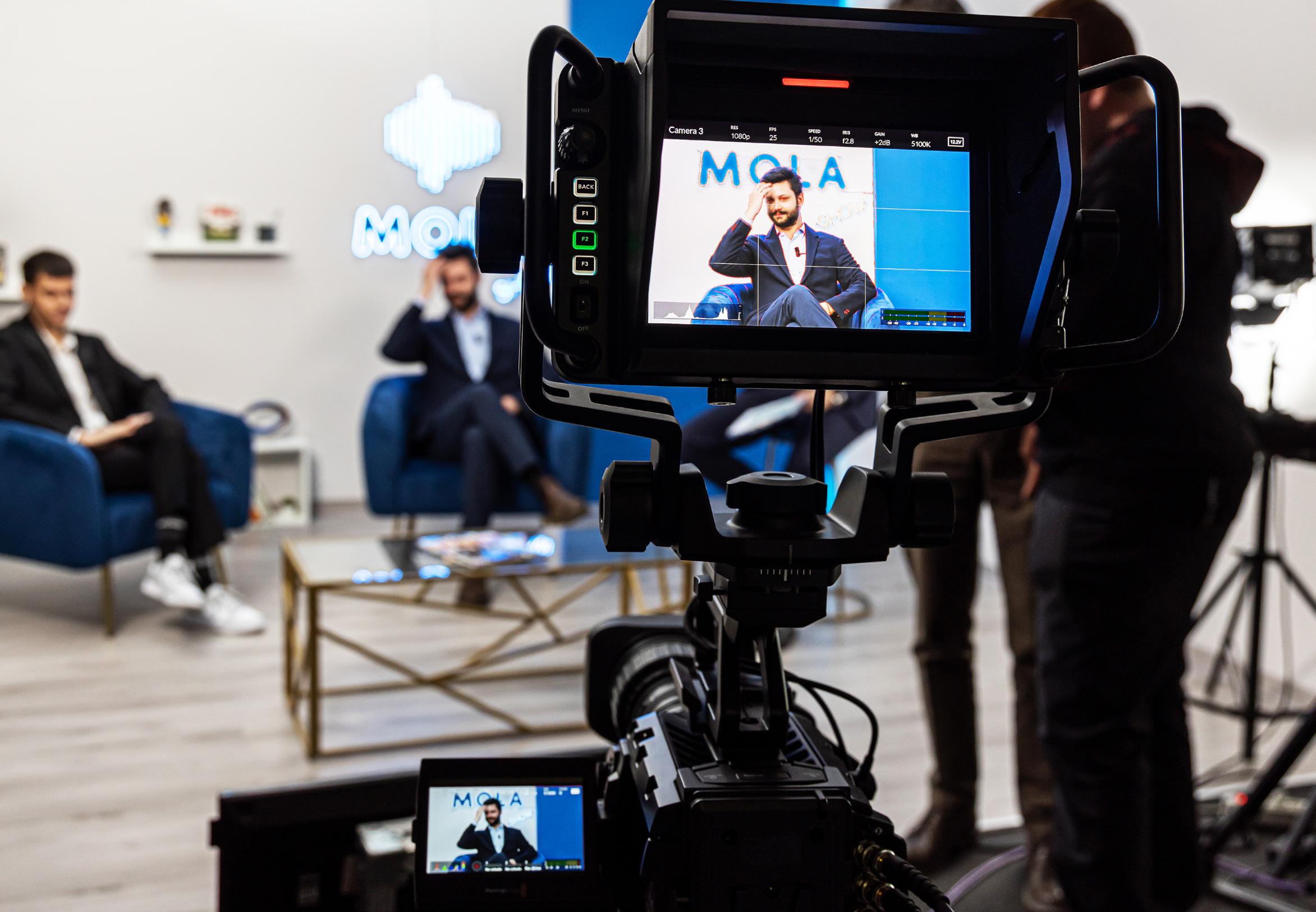
modelli di telecamere senza preoccuparci dei relativi output, poiché i dispositivi di ultima generazione centralizzano la gestione di contenuti e formati diversi, in ingresso e in uscita”.
C’è un secondo elemento, che riguarda la formazione degli operatori. Fare il tele cameraman in un evento aziendale richiede determinate competenze, coprire un evento sportivo ne richiede di completamente diverse. E non tutti gli sport sono uguali: bisogna conoscere la narrativa tipica di ciascuna categoria, perché riprendere il volley non è come parlare di ping-pong, acquisendo conoscenze specifiche per riprese e regia nei diversi ambiti. “Non a caso, tra le divisioni di AMS c’è anche quella dedicata alla formazione dei tecnici che si occupano di produzione e post-produzione, con iniziative su misura per il broadcast degli eventi sportivi. Quanto al reperimento degli operatori per le collaborazioni in atto, siamo facilitati dalla condizione di soci di cooperativa, che ci permette di attingere a un bacino ampio e qualificato”, aggiungono.
Le tecnologie in campo
Veniamo dunque al cuore tecnologico del lavoro di AMS per Mola TV. Nello studio dell’emittente operano in tutto quattro telecamere: due URSA Broadcast G2 e due Studio Camera 4K Pro. La novità è soprattutto nel primo dei due modelli: si tratta infatti di telecamere broadcast molto versatili, con caratteristiche avanzate tipiche del cinema e dell’advertising. “Abbiamo scelto le telecamere URSA Broadcast G2 perché innalzano la qualità, anche nell’ingegneria di colore, rispetto alle tradizionali soluzioni broadcast”, spiegano Gabriele Lusco e Sergio Sasso. “Ci permettono di realizzare prodotti di alto livello nell’immediato, senza dover processare ulteriormente le immagini. In particolare, sono dotate di un nucleo centrale sul quale installare tutta una serie di accessori, dalle ottiche all'eventuale convertitore di fibra. Insomma, con il giusto corredo sono valide in tutti gli ambiti del nostro lavoro. Questa proposta di Blackmagic Design ci ha aperto nuovi canali di business, anche presso clienti che finora avevano preferito
telecamere di altri marchi storicamente legati al broadcasting”.
Ad accompagnare questi modelli, le due Studio Camera 4K Pro, ritenute ideali per integrare le immagini realizzate con le URSA Broadcast G2 e completare le esigenze delle varie produzioni in corso. Quanto alla regia, i professionisti di AMS sfruttano le funzionalità all-in-one di ATEM Television Studio HD8 ISO. Una soluzione completa, che abilita e centralizza numerose attività. Permette, quando necessario, di acquisire segnali delle camere, sfruttare le diverse uscite, gestire l'audio che arriva dalle camere o dagli ingressi della regia stessa, di verificare la colorimetria delle telecamere, di controllare la registrazione di tutti i segnali, di “streamare” direttamente e gestire flussi tramite protocollo 10G di Blackmagic Design.
“La regia può fare tantissime cose, ma non è detto che servano sempre tutte, l’importante per noi è sapere di averle a disposizione”, commentano i professionisti. “Quando, per esempio, abbiamo bisogno di effettuare color correction o
gestione della luce particolari, utilizziamo l’apposito pannello Blackmagic Design. Ma in situazioni di luce controllata e camere fisse, con condizioni ambientali costanti, questo modello ci consente di impostare dal pannello dell’ATEM Television Studio HD8 ISO le regolazioni necessarie all’inizio dell’evento, senza la necessità di monitorare continuamente i parametri o di integrare altri prodotti al sistema”.
Stesso discorso per l’audio: se è una componente critica dell’evento i professionisti utilizzano un banco audio dedicato, se invece sono le tracce che arrivano sono relativamente semplici da gestire, la regia svolge direttamente anche questo compito. Con tutti i vantaggi operativi del caso. “La versatilità si traduce in agilità: nei casi meno complessi, meno attrezzature da trasportare e da gestire; nelle situazioni più delicate, invece, disponiamo comunque di tutto quello che serve per una regia completa”, aggiungono. “Inoltre, la possibilità di registrare sia le ISO camere sia il progetto in live ci permette di consegnare a fine evento il montato delle camere con piccole modifiche. Questo accorcia notevolmente i tempi di lavorazione”
Qualità del flusso di lavoro
Un cenno anche al flusso di lavoro completo per Mola TV. Tramite la regia ATEM Television Studio HD8 ISO, appunto, il contenuto esce dal setup ed entra nel sistema che proietta direttamente sulla piattaforma dell’emittente. Al contempo, il program viene registrato attraverso i dispositivi Hyperdeck Studio HD Mini, ma in alcuni casi lo staff di The Black Studio preferisce registrare le ISO camere, sempre tramite la regia, nell’eventualità di lavorazioni successive all’episodio. “La registrazione su periferiche esterne è una funzionalità strategica. Così riusciamo a offrire al cliente un servizio su misura per le sue necessità, che possono cambiare in base al palinsesto”. Perché fare broadcasting con Blackmagic Design? In parte, Gabriele Lusco e Sergio Sasso ci hanno già risposto.
Ma il senso di questa fidelizzazione, agevolata dal supporto del distributore italiano Manco Video Professionale, è soprattutto nell’evoluzione tecnologica dimostrata negli ultimi anni.
“Il susseguirsi di nuovi prodotti interessanti per questo settore ci ha permesso di costruire un magazzino di attrezzature completo e di alto livello, con ottimo rapporto

tra qualità e prezzo. Il confronto costante con lo staff di Manco ci mantiene aggiornati, insieme possiamo toccare con mano in anteprima le soluzioni da adottare”.
Un futuro di broadcast e AV
Considerato l’osservatorio privilegiato di AMS sulle produzioni sportive, abbiamo chiesto a Gabriele Lusco e Sergio Sasso un’opinione sulle tendenze in atto. Entrambi concordano sulla trasformazione del consumatore, oggi molto più esigente, in cerca di contenuti multicanale di qualità. Dall’altro lato, le produzioni non possono che diversificare l’offerta, rendendola flessibile e pronta ad accogliere nicchie inesplorate. “Le tecnologie avanzano rapidamente e noi dobbiamo studiarle e mantenerci sempre aggiornati”, affermano. “Il panorama degli eventi sportivi, poi, sta cambiando forse più radicalmente di altri.
Fino a pochi anni fa, le tv generaliste erano poche e centralizzavano la trasmissione degli eventi sportivi, principalmente legati al calcio. Con l’avvento delle piattaforme on demand e di altri sistemi di diffusione dei contenuti, si fa sempre più concreta l’opportunità di emergere con produzioni di qualità anche per sport considerati minori” Nuovi modelli di business, dunque, calibrati secondo il target di pubblico da intercettare o gli interessi economici da valutare, dal semplice streaming sui social agli accessi su abbonamento.
In conclusione, lo sport segna anche una pionieristica integrazione tra broadcast e AV. “Viviamo una posizione intermedia tra il broadcast tradizionalmente inteso delle emittenti TV e il mondo degli eventi, sempre più allineato ai concetti di streaming e contribuzione audiovisuale”

Il modello ATEM Television
Studio HD8 ISO registra
8 ingressi e supporta telecamere remote con tally individuale. Offre montaggio multicamera su software NLE, archiviazione in rete per il montaggio in tempo reale e streaming live su YouTube in H.264 con audio AAC.
www.mola.tv www.amscoop.com www.blackmagicdesign.com/it www.amsmultimedia.it
Regia ATEM
Television Studio HD8 ISO
Lo switcher di produzione live professionale, integrato in un pannello di controllo broadcast, è pensato per lavori di alta fascia. Integra otto ingressi SDI con conversione di standard, due uscite ausiliarie, quattro chiavi cromatiche, due chiavi secondarie, SuperSource, due lettori multimediali e moltissime transizioni. Offre anche funzioni da studio televisivo, come hardware di streaming, registrazione, mixer audio, talkback, multiview e archivio di rete interno condiviso opzionale.
Oltre a tutto questo, il modello ATEM
Television Studio HD8 ISO è in grado registrare gli 8 ingressi e di connettersi a 8 telecamere remote, con tally e controllo per ciascuna di esse. I file registrati si possono montare su qualsiasi software NLE multicamera, grazie alla completa sincronizzazione dei relativi timecode. Inoltre, l’archivio in rete integrato consente agli operatori di montare durante la registrazione, condividendo anche i file con altri utenti. Infine, il motore di streaming integrato trasmette gli eventi in diretta, registrando in H.264 con audio AAC per caricare i file su YouTube. Si può anche condividere la diretta della trasmissione su grandi schermi e proiettori sfruttando le uscite ausiliarie.

Matteo Fontana

Con una interessantissima e proficua chiacchierata, Giorgio Casu, CEO e fondatore dell’azienda, ci ha svelato l’universo di idee e di tecnologia all’avanguardia che sta dietro a una realtà come
Digitalis Multimedia

Volto sorridente, grande precisione nella scelta delle parole ed entusiasmo contagioso quando affronta le tematiche che più gli stanno a cuore, Giorgio Casu è uno di quegli imprenditori palesemente innamorati del proprio lavoro e del proprio settore, nella fattispecie la post-produzione cine-televisiva. Casu, però, non è nato CEO e fondatore di aziende. Anzi, come ci ha raccontato prima che entrassimo nel vivo della conversazione, i suoi esordi nel settore televisivo l’hanno visto nel ruolo di fonico, per trasmissioni pionieristiche come il celeberrimo “Drive In”. Insomma, parliamo di una persona che ha fatto la tradizionale “gavetta”, dall’audio al montaggio e quindi alla regia di una trasmissione più che conosciuta: “Superclassifica Show”, un vero must per molti anni, fusione perfetta di mondo radiofonico e televisivo. Giorgio Casu è stato il più giovane del nutrito gruppo di registi che diressero le puntate di questa celebre trasmissione.
Ma com’è che un così brillante creatore di immagini è passato a fondare e gestire un’impresa?
“La parte creativa, a un certo punto, ha dovuto cedere il passo a quella organizzativa più tipica del produttore” ci ha detto. Insomma, un salto in avanti di non piccole dimensioni, un ingresso nel mondo della co-produzione con Mediaset (e, giusto per citare un titolo, si pensi a “Colpo di fulmine”, di cui Giorgio va giustamente fiero, realizzato con le stesse telecamere ENG dedicate alla produzione di news ma perfettamente adattate a una trasmissione on the road, alla quale hanno conferito un taglio fresco e dinamico, imitato, non a caso, da varie altre trasmissioni).
L’innovazione prima di tutto
Con un “antipasto” così, ricco e interessante, ci siamo tuffati con grande curiosità nel “piatto” centrale dell’intervista: Digitalis Multimedia, brillante realtà nel panorama della post-produzione cine-televisiva.
Da dove nasce Digitalis Multimedia? Essenzialmente, dalla costante ricerca dell’innovazione. Come imprenditore, ho sempre puntato a “contagiare” il mio team con la mia stessa curiosità nella ricerca dell’innovazione e delle tecnologie all’avanguardia, e Digitalis Multimedia è stata fondata 15 anni fa proprio con questa idea, realizzare produzioni e co-produzioni televisive con passione e attenzione. Il nostro core business però è la post produzione. Abbiamo circa 60 stazioni di post produzione, suddivise nelle nostre tre sedi, e siamo un importante fornitore di Mediaset,
per esempio, Stream Look, che rende disponibili in rete, attraverso una piattaforma dedicata, i contenuti audiovisivi appena realizzati e ne consente la visione e la valutazione da parte dei clienti interessati. Si è trattato di un’innovazione di grande successo, che ha consentito di agevolare controllo e approvazione dei progetti.
Il fiore all’occhiello: SYM9
Veniamo al punto principale: Sym9! Può spiegarci di che si tratta?
Sym9 è la nostra vera innovazione, quella che ci ha spinti in territori nei quali per

per cui svolgiamo gran parte della post produzione esternalizzata. I nostri principali cardini di pensiero sono la qualità tecnologica del lavoro e la capacità di mantenere solide e corrette relazioni coi clienti.
Quali sono i vostri punti di forza, come azienda?
Anzitutto, il fatto che veniamo direttamente dalla produzione e dalla post produzione televisiva. L’azienda è nata con l’idea precisa di soddisfare determinate esigenze di cui ben conoscevamo l’esistenza, per esperienza diretta.
Inoltre, con tante workstation dedicate al montaggio e alla color correction, abbiamo a che fare coi clienti quotidianamente e questo ci aiuta a capire alla perfezione le esigenze della post produzione televisiva, anche in chiave di evoluzione.
Ci può fare un esempio? In che cosa avete anticipato una richiesta del mercato?
In base a una ricerca abbiamo realizzato,
il momento ci siamo solo noi. Si tratta di uno strumento per la condivisione della post produzione da remoto attraverso il proprio device. Insomma, è un mezzo per accorciare sensibilmente le distanze tra le varie figure che lavorano alla post di un prodotto televisivo o cinematografico. Abbiamo realizzato un Private Cloud molto performante dedicato alla TV e alla produzione in 4K, in pratica un data center la cui sede fisica è vicino a Cagliari, e che permette le più svariate applicazioni dedicate alla post produzione, non solo per il montaggio ma anche per la color correction, la parte grafica eccetera. Sym9 consente la condivisione dei contenuti a diversi livelli di post produzione, quindi, per fare un esempio, il regista, il produttore e il montatore, se anche dovessero trovarsi, come spesso accade, in città diverse, possono comunque condividere facilmente lo stato dei lavori e operare di concerto, con evidente ottimizzazione dei costi e accelerazione dei processi.
Quando è stato lanciato Sym9 e quali sono le sue attuali applicazioni?
Il lancio è avvenuto l’anno scorso con “Pomeriggio 5”, e attualmente il sistema viene usato da EI Towers per lavori dedicati allo sport, in particolare al calcio, con color correction in 4K in tempo reale, nonché da Mediaset per varie produzioni.
Quanto è importante la sicurezza, per uno strumento come Sym9?
Moltissimo, è fondamentale. Siccome il fulcro concettuale del prodotto consiste nel fatto che esso permette di svolgere quella che è, a tutti gli effetti, una remote post production, con tutti i vantaggi del caso, è ovvio che due cose vanno assolutamente garantite ai clienti: uno storage dedicato e capiente, e un livello di sicurezza che assicuri la non violabilità del materiale che ci viene affidato. Per questo abbiamo standard molto elevati garantiti da protocolli estremamente severi.
Come si lavora, all’atto pratico, con Sym9? E quali sono le sue prospettive future?
L’attività è divisa in due blocchi distinti: post produzione remota e condivisione attraverso Sym9, che non deve necessariamente essere usato in abbinamento al nostro Cloud. L’auspicio per il futuro è di dare a questa innovazione un orizzonte molto ampio visto che, anche a livello internazionale, non c’è nulla, al momento, che le somigli. Siamo fieri di essere all’avanguardia, nel nostro settore. Essendo una realtà relativamente piccola, ci muoviamo con più rapidità rispetto ai “colossi”. Non a caso, tutto è nato “sul campo”, grazie al nostro know how. Diciamo che abbiamo potuto permetterci di invertire l’ordine degli addendi: prima il Beta Test e poi lo sviluppo dell’applicativo! L’importante è che il risultato sia stato quello desiderato!
Appuntamento dunque al MAF (Milano Audiovisual Forum), a ottobre, per una demo pratica delle potenzialità di Sym9? Non vediamo l’ora! Il prodotto è molto semplice da utilizzare, cosa molto importante per i clienti, e speriamo di poter portare questo progetto a un livello molto importante. Il MAF, con una classroom dedicata, ci consentirà di dare una dimostrazione pratica a chiunque sia interessato.
www.digitalismultimedia.com https://audiovisual.forum
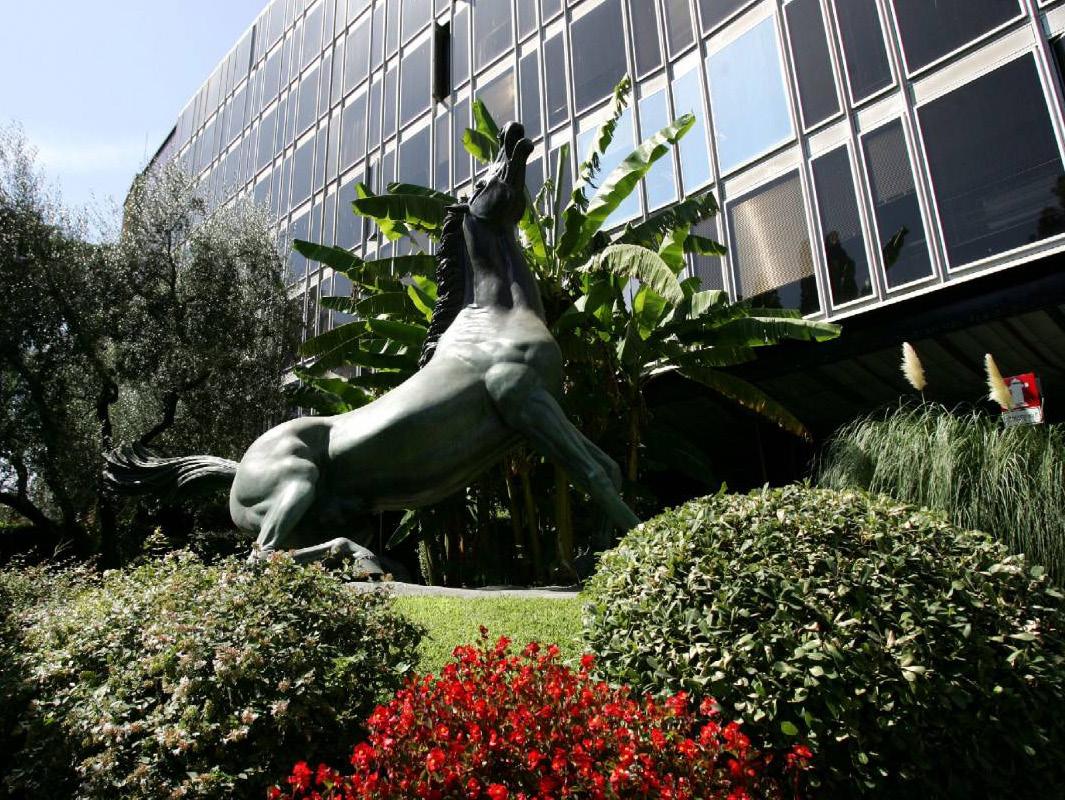




Radio Rai compie i suoi primi cento anni e li festeggia in sinergia con la TV sottolineando, col successo della Visual Radio, una contaminazione tra produzione audio e televisiva sempre più stretta ed efficace. E proprio a ottobre, in occasione del MAF (Milano Audiovisual Forum), ci sarà modo di festeggiare e parlare del futuro della radio


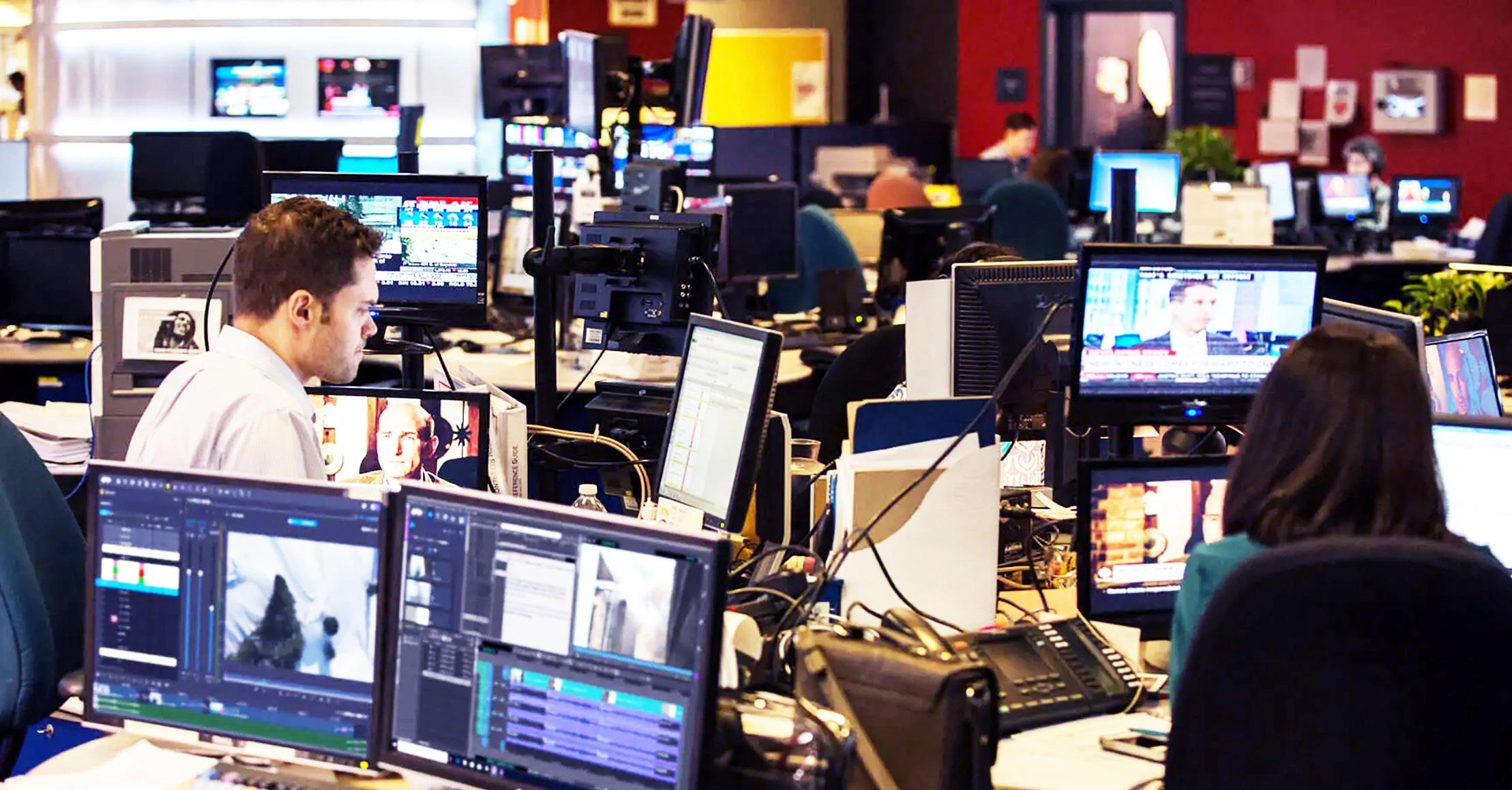
Il giorno esatto sarà il 6 ottobre 2024: scoccheranno allora i cento anni dalla prima trasmissione di Radio Rai, una storia più che degna d’essere celebrata adeguatamente. L’azienda, a livello produttivo, lo sta già facendo, con una trasmissione, in onda ogni mercoledì dal “metastudio” di Via Asiago (più avanti spiegheremo di cosa si tratta), intitolata “Rai Radio presenta 100: da Marconi al digitale”. Avviata nell’ottobre 2023, questa trasmissione è pensata per ripercorrere, durante tutto l’anno, anche con l’ausilio di materiali d’archivio e ospiti in studio o in collegamento, la storia di un’emittente in continuo sviluppo, che ha fatto la storia della radio e ha conosciuto, nell’ultimo decennio, una vera e propria rivoluzione, come ci ha spiegato l’ingegner Stefano Teodori, che abbiamo potuto intervistare non solo a proposito delle celebrazioni per il centenario della radio, ma anche – e soprattutto – circa l’evoluzione tecnologica che sta interessando il mondo della produzione audio, e che promette meraviglie anche per l’immediato futuro.
AL PRIMO POSTO

Stefano Teodori lavora in RAI dal 1993, e ha dunque una notevole esperienza dell’ambiente. Dal 2015 si occupa di radio, e dal 2017 è responsabile della parte di progettazione degli impianti di produzione di Radio Rai. La sua area di competenza si chiama “Ingegneria Esercizio e Manutenzione”, e si occupa di progettare gli impianti e pianificare gli investimenti per lo sviluppo tecnologico delle strutture produttive. Stefano tiene a specificare: “Chi realizza all’atto pratico le trasmissioni non dipende da me. Io mi occupo di studi, regie e matrici di distribuzione, ma non seguo la realizzazione dei programmi. Con la mia squadra, che è composta da persone eccezionali
sotto tutti i punti di vista, mi occupo di mettere i bravissimi colleghi della produzione nelle condizioni di lavorare al meglio.”
Cento anni di Radio Rai: visto dall’interno, com’è stato questo secolo di tecnologia audio?
Diciamo che più o meno per 90 anni la radio è stata sostanzialmente sempre uguale, ovvio, con aggiornamenti e rinnovamenti periodici, ma la tecnologia sulla quale si è basata la messa in onda è rimasta quella, FM, con i canali analogici, Radio Uno, Radio Due e Radio Tre ai quali nell’89 si è aggiunta Isoradio e poi nel ’98 GR Parlamento. Nell’ultimo decennio, invece, c’è stata un’autentica esplosione di innovazione anche dal punto di vista del concetto stesso di radio.
Ti riferisci a Visual Radio e DAB?
Soprattutto a Visual Radio e Radio Specializzate distribuite in streaming, nonché a Rai Play Sound, che hanno rappresentato un deciso punto di svolta.
Il DAB (Digital Audio Broadcasting), a ben vedere, è antecedente, perché lo standard ha visto la sua prima incarnazione a inizio anni ‘90, per poi conoscere una serie di variazioni e aggiornamenti. Se però, per la TV, il DVB (Digital Video Broadcasting) è stato favorito dalla opportunità di chiudere l’analogico e destinare le risorse frequenziali ai nuovi servizi 4G e 5G, per la radio il DAB non si sostituisce alle frequenze FM che continuano perciò ad essere un asset fondamentale per tutte le emittenti. Certamente la diffusione di autoradio DAB in tutti gli autoveicoli nuovi consente di immaginare un futuro in cui le reti DAB si affianchino interamente alle reti FM. Tema interessantissimo di cui si potrà parlare proprio in occasione del MAF!
Certo, sarà un piacere! Intanto, affrontiamo il tema “caldo” della Visual Radio. Quanto ha inciso sulla recente rivoluzione tecnologica della produzione audio? Moltissimo, come già accennavo. Per noi la sinergia col mondo televisivo ha rappresentato una grandissima spinta propulsiva, in particolare dal 2019, quando qui, in via Asiago 10, abbiamo ospitato Fiorello per Viva Rai Play, trasmissione passata sia sulla TV generalista che sulla piattaforma Rai Play.
Da allora, abbiamo cominciato a lavorare quasi come un piccolo centro di produzione TV. Nei nostri studi è entrato in maniera pervasiva il mondo TV, sia per la ripresa che per l’aspetto scenografico. Noi ovviamente non siamo così presuntuosi da dire che facciamo propriamente TV, però facciamo qualcosa di ibrido che molto spesso atterra anche nei palinsesti televisivi.
UNA PRODUZIONE IBRIDA
Come sono attrezzati i vostri studi di produzione?
A livello scenografico abbiamo strutture LEDwall, impianti di illuminazione RGBW e macchine del fumo, per creare atmosfera. Tra gli stessi spazi, oggi e in passato, intercorre una differenza pazzesca. Prima le sale somigliavano a teatri, oggi a veri e propri studi televisivi. Qui vengono prodotti alcuni programmi del palinsesto di Rai Due: Social Club, per esempio, nasce come programma radiofonico, oggi è anche in TV ed è prodotto internamente, senza nulla di appaltato. Come anche Happy Family, e I Lunatici, che va in onda a notte fonda. Ultimamente, peraltro, anche su Rai Uno, dopo lo show del sabato sera, è andato in onda Techeteche Top Ten, con Bianca Guaccero, realizzato interamente dalla produzione TV ma nel nostro nuovissimo studio R1T di Saxa Rubra. Per noi è stato un motivo di grande orgoglio. Tutto questo grazie alla spinta propulsiva del management RAI: l’azienda ha fatto uno sforzo in termini economici e il personale in termini di attività e lavoro.
Con quali attrezzature realizzate le riprese video?
Usiamo telecamere PTZ remotate, integrate da una telecamera a spalla che permette al regista di personalizzare al meglio la ripresa della trasmissione.
Negli studi più grandi, A e B, abbiamo una dozzina di camere PTZ gestite da una re-
gia, il che ci consente di sfruttare diversi angoli di ripresa. Nei due studi principali abbiamo anche dei carrelli a soffitto per dare ulteriore movimento alla ripresa.
E per quanto riguarda la gestione e la registrazione dei segnali?
Regia video e regia audio sono distinte: la parte audio è quella “classica”, radiofonica, mentre la parte televisiva è gestita con un apposito mixer ma è semplificata perché non abbiamo tutte le esigenze di una produzione puramente televisiva. Per il 90% delle produzioni, c’è una regia centrale nella quale confluiscono tutti i gli studi, in grado di gestire sia le camere che la messa in onda, insomma, la Visual Radio vera e propria. In sala A e sala B, cioè nei grandi studi, c’è anche una regia dedicata che permette di gestirli in locale, e di appoggiarsi alla regia centrale solo per la messa in onda. Abbiamo poi un NAS (Network-attached Storage) con il quale registriamo tutto quello che va in onda. Localmente, abbiamo poi un sistema che ci consente di registrare anche il segnale “grezzo”, non solo quanto viene messo in onda, e abbiamo allestito delle postazioni di montaggio. Diciamo che noi ci occupiamo di produrre, editare e codificare i files che poi consegniamo ai colleghi delle piattaforme per la messa in onda sul Web.
Quanti sono, in totale, gli studi che gestite?
Compresi i due studi di Milano, ne abbiamo sei che appoggiano sulla regia centrale della Visual Radio e sono controllati da lì. Gli altri due, A e B, come dicevo possono essere autogestiti e vanno sulla regia centrale solo per la messa in onda. Peraltro, la sede di via Asiago, che ospita la regia centrale, è stata cablata interamente in fibra nel 2019.
Quante ore di produzione realizzate al giorno?
Direi 24 ore al giorno per 12 canali. Non tutti i canali, ovviamente, hanno contenuti live, ma Radio Uno, Radio Due, Radio Tre e Isoradio li hanno. Complessivamente, facciamo più di 100 ore al giorno di contenuti live.
Da quanto detto sinora, si può evincere che la radio non sta andando incontro
ad alcuna obsolescenza, anzi, è un medium molto attuale e, per così dire, future proof. Confermi?
Basti pensare che rispetto a quando ho cominciato a lavorare in radio, nel 2015, il panorama si è completamente stravolto: rispetto a dieci anni fa, la produzione di oggi è molto cresciuta, e si è aggiunto il lato video. La radio, insomma, gode di ottima salute, a mio avviso perché unisce conservatorismo a innovazione: è rimasta sull’analogico, senza richiedere stravolgimenti tecnici per la ricezione, ma ha anche saputo proporre novità entusiasmanti.
Prima di chiederti una previsione sul futuro, ci parli del “metastudio” che abbiamo citato in apertura, da cui partono le trasmissioni celebrative per il centenario?
Volentieri. In effetti, è una scheggia di futuro che si è già inserita nel presente, se vogliamo. Si tratta di uno studio speciale, che abbiamo allestito con l’idea di permettere al conduttore di avviare da solo la trasmissione, senza alcun bisogno di supporto tecnico.
Di solito, uno studio è corredato da una regia, collocata in un ambiente separato. Il nostro metastudio, invece, è una struttura semplificata che non permette trasmissioni di grande complessità, ma supporta senza problemi un programma basato su un conduttore e uno o due ospiti, con in più la possibilità di gestire autonomamente telefonate e contributi esterni.
Non solo: c’è anche la possibilità di andare in onda col video, grazie a telecamere comandate direttamente dal microfono del conduttore. Insomma, un modo per ottenere il massimo col minimo.
Al momento, viene usato per diverse trasmissioni delle radio specializzate sul Web, con target tendenzialmente giovane, in particolare No Name Radio e Radio Live Italia.
E adesso, per concludere, non si può esimere: qual è il futuro della Radio, e della Visual Radio, dal suo punto di vista?
I temi su quali porrei l’accento sono sostenibilità, cloud e Intelligenza Artificiale. Anzitutto, credo che si vada verso la progressiva virtualizzazione di studi e regie. La parte scenografica (LEDwall, corpi illuminanti eccetera) ha senso dove è previsto un pubblico; tutto il resto può evolvere verso uno studio virtuale, con sfondo green e software che genera un ambiente intero. Si tratta di una soluzione perfetta
in particolare per gli studi molto piccoli, nei quali il LEDwall crea più problemi che altro. Meglio un piccolo green screen e un virtual set. Ovviamente bisognerà lavorare con i creatori di contenuti. Analogamente, il cloud consentirà nell’arco di una decina d’anni di avere delle regie virtualizzate e concentrate in un unico ambiente o in pochi ambienti. Oggi abbiamo in pratica una regia audio per ogni studio. In futuro, un’unica regia potrebbe governare più studi sfruttando la tecnologia del cloud. Infine, l’Intelligenza Artificiale sarà protagonista anche nel nostro settore, seppur – a mio avviso – più sul piano della creazione di contenuti. La sfida, per noi tecnici e “meccanici”, sarà dare ai creativi le soluzioni tecniche giuste per sfruttare al meglio le potenzialità, immense, dell’Intelligenza Artificiale!
www.raiplaysound.it
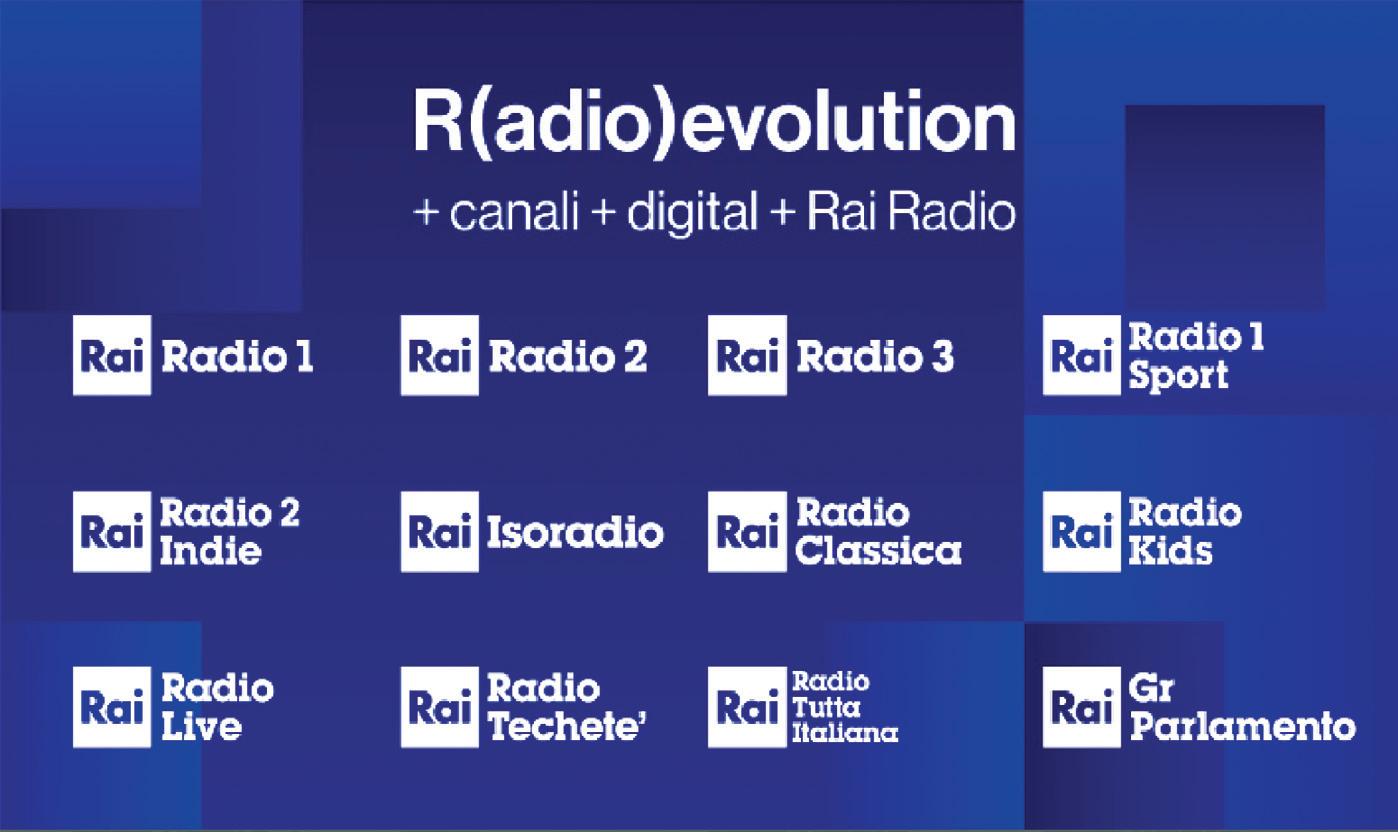
Grazie a telecamere comandate dal microfono del conduttore c'è anche la possibilità di andare in onda con video Attualmente, questo sistema è utilizzato da No Name Radio e Radio Live Italia, rivolte a un pubblico giovane.

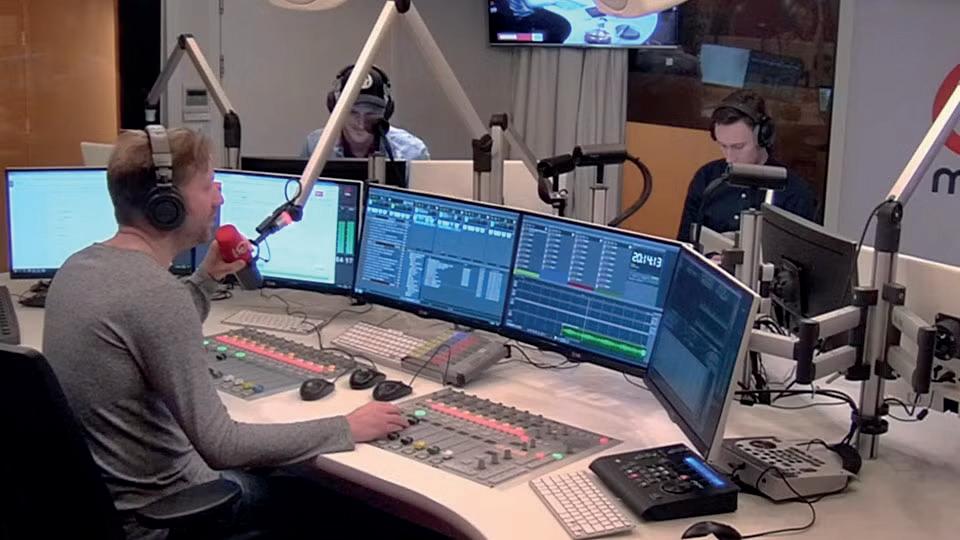
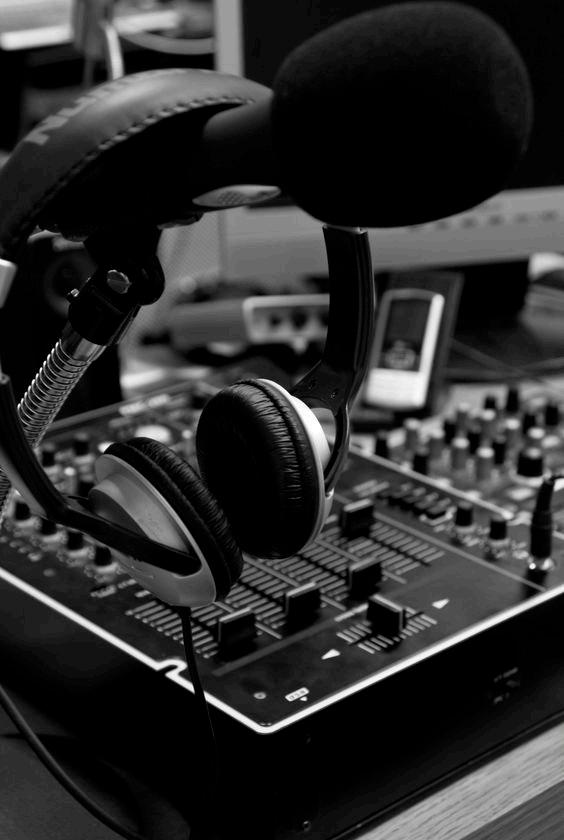

Bruno Mercuri, Presidente di ANIBA. ANIBA è un'associazione di categoria delle imprese della produzione tecnica TV del broadcast e dell’audiovisivo, costituita nel 2021.
Bruno Mercuri, Presidente di ANIBA, Associazione Nazionale Imprese Broadcast Audiovisivo, spiega come l'associazione unisce le principali imprese del settore per promuovere qualità, etica e riconoscimento economico in un mercato competitivo
Eccellenza italiana nel broadcast: operatori e tecnici dell'Associazione Nazionale Imprese Broadcast Audiovisivo (ANIBA) al lavoro per catturare l'azione sportiva con tecnologie di ultima generazione, dagli stadi alle sale di controllo.


Oggi ANIBA annovera tra i propri soci società che, insieme, sviluppano quasi il 70% del fatturato del settore in Italia: Cinevideo, DBW Communication, Erreciesse Group, Hotspot, Live Sat, L’Opera, ONE TV, Videe, VideoB, Videosystem Production
Quali sono le finalità dell’Associazione ANIBA?
L’obiettivo principale dell’associazione è di garantire alle aziende del settore del broadcast TV un adeguato riconoscimento all’interno della filiera dell’industria italiana del media sport&entertainment, in un contesto virtuoso di libera concorrenza fatto di regole condivise, trasparenza ed etica. Ciò si accompagna, perchè ad esso strettamente legato, alla tutela dei produttori e dei broadcaster: il riconoscimento del giusto valore dei servizi resi dalle aziende della produzione tecnica garantisce, infatti, la qualità del lavoro svolto nel pieno rispetto delle norme di legge e del prodotto trasmesso.
Ha davvero senso oggi un’associazione di filiera in un contesto di libero mercato?
ANIBA rappresenta e tutela la professiona-

lità, la competenza e la qualità tecnologica delle proprie associate, promuovendo una più consapevole autoregolamentazione del settore. È nostra convinzione che l’unità di intenti sia la grande forza dell’associazione e che solo insieme si possano raggiungere risultati importanti a beneficio di tutti, inclusi i produttori e le reti, ponendo un freno all'eccessivo ricorso al subappalto e all’aggiudicazione delle gare d’appalto secondo il criterio del massimo ribasso, che sviliscono il mercato. La nostra attività porterà a riconoscere un valore medio delle gare d’appalto e, nel perseguire il riconoscimento del giusto valore, migliorerà i rapporti tra impresa e produzione.
Vi muovete in un mercato competitivo e ad alto valore tecnologico. Non ritiene che per raggiungere la finalità dell’Associazione sia necessaria una maggiore rappresentanza?
Il marchio ANIBA è un segno distintivo di affidabilità e serietà e veicola un’immagine di valore dal punto di vista operativo e gestionale di cui sono espressione le nostre associate. Chiunque si riconosca in questi principi, troverà in ANIBA il proprio spazio. Stiamo già vagliando alcune richieste di adesione che ci sono pervenute recentemente.
Quest’anno ANIBA sarà presente al MAF per un appuntamento importante. Cosa ci può anticipare?
ANIBA ha commissionato alla società Formules in collaborazione con l’Università Bocconi, un'importante ricerca sul settore del broadcast TV, che verrà presentata al MAF 2024. Per la sua rilevanza nel contesto internazionale e per la specifica tipologia di pubblico e relatori del settore che vi partecipano, il Milano Audiovisual Forum è stato identificato dai soci ANIBA come luogo ideale ad ospitare tale appuntamento. Si tratta di un evento davvero molto atteso, che fornirà rilevanti contributi ad una discussione sulle regole in atto e sullo stato di salute del mercato della produzione tecnica del contenuto audiovisivo in Italia, con particolare riguardo al riconoscimento degli investimenti tecnologici necessari a garantire le richieste del settore in termini di qualità del prodotto e del servizio, della professionalità del personale impegnato, che richiede compensi adeguati, e della formazione professionale.
Quali sono gli aspetti maggiormente in-
teressanti emersi dallo studio?
Voglio innanzitutto sottolineare che si tratta del primo grande studio sul settore nel suo complesso che sia mai stato prodotto in Italia. Il lavoro di analisi è stato coordinato dal Prof. Guido Guerzoni, adjunct professor dell'Università Bocconi, e ha approfondito l'impatto economico, tecnologico, occupazionale e formativo del broadcast sull'economia del Paese. Rilevante, a nostro avviso, la comparazione tra mercato italiano ed europeo nell’ambito delle policy settoriali, dei valori economici sviluppati, della remunerazione del personale, degli investimenti tecnologici e delle politiche fiscali.
Come pensate di coinvolgere attivamente gli Stakeholder per definire le regole e per apportare qualità ai servizi che fornite? Durante l’evento di presentazione saranno evidenziati, in particolare, le condizioni economico-contrattuali che sottendono all'attività delle società di service e i limiti economico-amministrativi in cui queste operano, ivi comprese le disparità nell’accesso ai finanziamenti pubblici tra le diverse aree geografiche del Paese. Come ANIBA crediamo che sia urgente, se vogliamo immaginare un futuro per il settore e per le aziende del broadcast in Italia, un confronto serio tra tutti i player del mercato. Siamo certi che la presentazione dei risultati dello studio sarà da stimolo ad un ragionamento di filiera che vedrà tutti coinvolti, istituzioni comprese.
https://aniba.it/
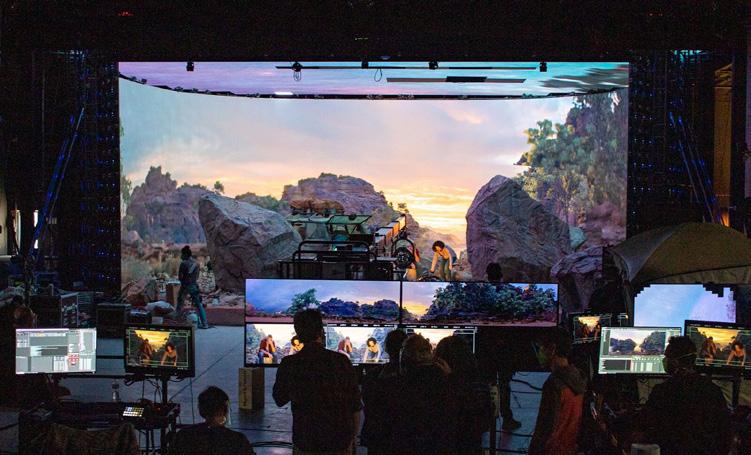


La tecnologia LED ha rivoluzionato il settore del broadcast, introducendo nuove possibilità creative e innovative nelle produzioni televisive e cinematografiche
In particolare, l'utilizzo dei LED nei virtual set ha portato a una trasformazione significativa nella creazione delle ambientazioni virtuali, offrendo vantaggi distinti rispetto alle tecnologie tradizionali.
Ruolo dei LED nei Virtual Set
I LEDwall sono diventati un elemento chiave nei virtual set grazie alla loro luminosità, risoluzione e capacità di riprodurre colori vividi e fedeli. Questa tecnologia consente la creazione di ambienti virtuali realistici e coinvolgenti, offrendo una qualità dell'immagine superiore rispetto alle proiezioni tradizionali.
La modularità e la scalabilità dei LED wall permettono di adattare le dimensioni e la configurazione del set alle esigenze specifiche di ogni produzione, garantendo flessibilità e versatilità.
Vantaggi e svantaggi dei Virtual LED Set
Tra i principali vantaggi dei virtual LED set si includono:
• Qualità dell'immagine superiore e maggiore luminosità:
I LEDwall offrono immagini più nitide e brillanti rispetto alle tecnologie tradizionali.
• Ampia gamma cromatica e fedeltà dei colori:
La capacità di riprodurre una vasta gamma di colori con alta fedeltà rende i set virtuali più realistici e coinvolgenti.
• Modularità e scalabilità:
I LED wall possono essere configurati in diverse dimensioni e forme per adattarsi alle specifiche esigenze di ogni produzione.
• Riduzione dei costi di produzione:
Rispetto alle tecniche tradizionali, i LED wall possono ridurre i costi di costruzione e modifica dei set fisici.
• Creazione di ambienti virtuali coinvolgenti e realistici:
La tecnologia LED permette di creare ambientazioni virtuali che migliorano l'esperienza visiva complessiva.
Tuttavia, vi sono anche alcuni svantaggi da considerare:
• Costi iniziali elevati:
L'investimento iniziale per l'installazione dei LED wall può essere significativo.
• Necessità di calibrazione e manutenzione accurata:
I LED wall richiedono una manutenzione regolare e una calibrazione precisa per mantenere la qualità ottimale.
• Possibili problemi di sfarfallio e moiré:
Se non gestiti correttamente, possono verificarsi artefatti visivi che compromettono la qualità dell'immagine.
Aspetti tecnici
L'utilizzo dei LED wall nel broadcast richiede competenze tecniche specifiche, tra cui:
• Risoluzione e pixel pitch:
La densità dei pixel è fondamentale per garantire immagini nitide e dettagliate, soprattutto quando la telecamera si avvicina molto al LED wall.
• Luminosità e contrasto: È essenziale che i LED wall siano sufficientemente luminosi per
competere con l'illuminazione ambientale sul set e offrono un alto contrasto per immagini vivide.
• Gestione del colore e calibrazione:
Una riproduzione cromatica fedele richiede una calibrazione accurata dei LED wall.
• Sincronizzazione con le telecamere:
Per evitare artefatti visivi come il tearing, è cruciale che i LED wall siano sincronizzati con le telecamere.
• Gestione termica:
Per mantenere le prestazioni ottimali, è necessario gestire efficacemente la dissipazione del calore prodotto dai LED.
Il futuro dei LED nel Broadcast
Il futuro dei LED nel broadcast è promettente, con continui miglioramenti tecnologici che promettono ulteriori progressi.
Si prevede un costante sviluppo in termini di risoluzione, luminosità e affidabilità dei LED wall. L'integrazione di tecnologie come l'intelligenza artificiale e la realtà aumentata apre nuove possibilità creative per i virtual set, anticipando un futuro ricco di innovazioni e nuove frontiere nel mondo delle produzioni audiovisive. In conclusione, i LED hanno rivoluzionato il broadcast, offrendo soluzioni avanzate per i virtual set. Grazie alle loro prestazioni superiori e alla flessibilità, i LEDwall sono diventati essenziali per la creazione di produzioni di alta qualità.
Il settore si prepara a un futuro entusiasmante, caratterizzato da ulteriori sviluppi tecnologici e nuove opportunità creative nel mondo dell'audiovisivo.


Il mondo del broadcast professionale sta attraversando una fase di transizione cruciale, abbandonando gradualmente gli standard SDI a favore di soluzioni basate su IP
Questa evoluzione, guidata da esigenze di flessibilità, scalabilità e riduzione dei costi, sta ridefinendo il panorama tecnologico del settore. Protocolli come NDI e SMPTE 2110 stanno emergendo come alternative valide allo storico standard SDI, offrendo nuove possibilità e sfide per i professionisti AV.
SDI: Lo standard del passato
SDI (Serial Digital Interface) è stato a lungo il protocollo dominante nel mondo del broadcast, grazie alla sua affidabilità e alla sua capacità di trasmettere segnali video e audio di alta qualità su lunghe distanze. Tuttavia, l'aumento delle risoluzioni video e delle esigenze di flessibilità ha evidenziato alcuni limiti di questo standard:
• Costi elevati per l'hardware dedicato e i cavi coassiali
• Difficoltà di scalabilità dei sistemi di routing
• Mancanza di flessibilità nell'integrazione con reti IP e tecnologie emergenti
NDI: Un nuovo paradigma
NDI (Network Device Interface), introdotto da NewTek nel 2015, rappresenta una svolta significativa nel mondo del broadcast.
Questo protocollo royalty-free consente la distribuzione di segnali video e audio su reti Ethernet standard, offrendo numerosi vantaggi:
• Costi ridotti grazie all'utilizzo di infrastrutture di rete esistenti
• Maggiore flessibilità nel routing dei segnali
• Possibilità di trasmettere canali alpha per grafica e titolazioni
• Supporto per vari formati video e frame rate
Tuttavia, NDI presenta anche alcune sfide:
• Necessità di una rete Ethernet performante e dedicata
• Compressione del segnale video che può influire sulla qualità
• Mancanza di adozione da parte di molti produttori di hardware
SMPTE 2110: Lo standard IP del futuro SMPTE 2110 è un insieme di standard che definiscono il trasporto di segnali video, audio e metadata su reti IP.
A differenza di NDI, SMPTE 2110 è progettato per la trasmissione di segnali video non compressi, garantendo la massima qualità. Inoltre, offre:
- Routing flessibile e scalabile su reti IP
- Separazione di video, audio e metadata per una maggiore flessibilità
- Supporto per vari formati video, audio e metadati
- Integrazione con tecnologie di sincronizzazione come PTP
Tuttavia, SMPTE 2110 presenta ancora alcuni svantaggi:
- Costi elevati per l'hardware e il software necessari
- Standard in continua evoluzione, con possibili cambiamenti futuri
- Maggiore complessità nell'implementazione rispetto a soluzioni proprietarie
Il futuro del broadcast: Convergenza IP
La transizione dal mondo SDI a quello IP nel broadcast professionale è ormai inevitabile. Sempre più strutture televisive e di produzione video stanno adottando soluzioni basate su IP, grazie ai numerosi vantaggi offerti:
• Maggiore flessibilità e scalabilità dei sistemi di routing
• Riduzione dei costi grazie all'utilizzo di hardware e infrastrutture standard
• Integrazione più semplice con tecnologie emergenti e applicazioni software
• Possibilità di remote production e collaborazione a distanza
Questa transizione non sarà immediata, ma richiederà un periodo di coesistenza tra sistemi SDI e IP. Tuttavia, è chiaro che il futuro
del broadcast professionale è strettamente legato all'adozione di standard IP come NDI e SMPTE 2110.
Conclusioni
Il mondo del broadcast professionale si trova di fronte a una sfida entusiasmante: abbracciare la convergenza IP per sfruttare i vantaggi offerti in termini di flessibilità, scalabilità e riduzione dei costi. Protocolli come NDI e SMPTE 2110 stanno guidando questa transizione, offrendo soluzioni innovative per la trasmissione di segnali video e audio su reti IP. Mentre NDI rappresenta una soluzione più accessibile e adottata da molti software, SMPTE 2110 si propone come lo standard IP del futuro, garantendo la massima qualità e interoperabilità. La scelta tra le due soluzioni dipenderà dalle esigenze specifiche di ogni struttura, ma è chiaro che il futuro del broadcast professionale è strettamente legato all'adozione di standard IP. I professionisti AV dovranno adattarsi a questa evoluzione, acquisendo nuove competenze e familiarizzando con le tecnologie IP. Tuttavia, l'opportunità di sfruttare la flessibilità e l'innovazione offerte dalla convergenza IP renderà questo cambiamento un passo necessario per rimanere competitivi nel mercato del broadcast professionale.
Michele Fucci
L'illuminazione è sempre stata un elemento fondamentale nel mondo del broadcast televisivo, fin dalle sue origini

Tuttavia, l'evoluzione tecnologica ha portato a profondi cambiamenti nel modo in cui la luce viene generata, controllata e applicata negli studi televisivi e nei virtual set. Storicamente, l'illuminazione negli studi televisivi si basava su sistemi tradizionali a incandescenza o alogeni. Questi apparecchi, sebbene efficaci, presentavano alcune limitazioni: alto consumo energetico, calore elevato prodotto e durata limitata delle sorgenti luminose. Con l'avvento di formati video migliorati come l'HD e il 4K, è emersa la necessità di sistemi di illuminazione più avanzati in grado di soddisfare le esigenze
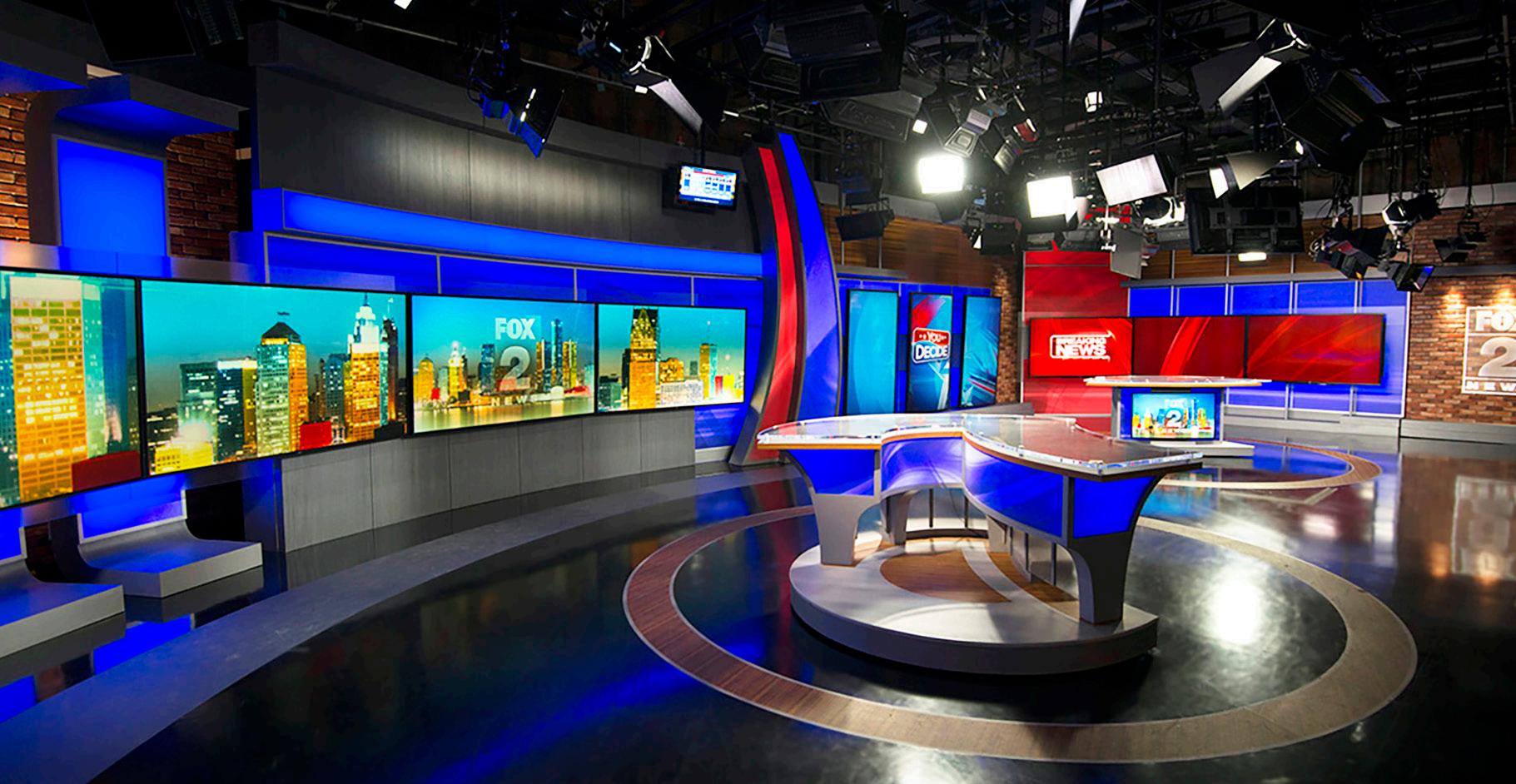
di qualità dell'immagine richieste. L'introduzione dei LED ha rappresentato una vera e propria rivoluzione nel mondo dell'illuminazione televisiva. Questa tecnologia, inizialmente utilizzata in applicazioni di retroilluminazione per schermi e segnalazioni, ha rapidamente guadagnato terreno anche nel settore broadcast.
I LED offrono numerosi vantaggi rispetto ai sistemi tradizionali: maggiore efficienza energetica, minore produzione di calore, dimensioni compatte e lunga durata. Queste caratteristiche li rendono particolarmente adatti per l'utilizzo in studi televisivi e virtual set, dove la gestione del calore e il consumo energetico sono aspetti critici. L'evoluzione dei LED ha permesso di ottenere sorgenti luminose di alta qualità, in grado di riprodurre fedelmente i colori e di essere controllate con precisione. Questo ha aperto la strada a nuove possibilità creative nell'illuminazione dei virtual set, consentendo di simulare condizioni di luce naturale o di creare effetti speciali dinamici. Inoltre, l'integrazione dei LED con sistemi di controllo avanzati ha permesso una gestione più efficiente dell'illuminazione durante le produzioni, riducendo i consumi e i costi di gestione.
Tecnologie di Illuminazione negli studi relevisivi
La scelta delle apparecchiature di illuminazione per la produzione televisiva richiede attenzione a vari parametri, suddivisi principalmente in criteri di prestazione e operativi. I criteri di prestazione comprendono aspetti come la potenza, l'emissione di lumen, l'efficacia luminosa, l'emissione spettrale e la curva di dimmerazione. I criteri operativi includono regolabilità,
funzionamento di giogo e palo, schermatura, manutenzione e sostituzione della lampada. Nonostante l'evoluzione delle tecnologie, i principi basati sull'illuminazione al tungsteno restano rilevanti anche per le sorgenti fluorescenti e LED, oggi ampiamente utilizzate nell'illuminazione televisiva, fotografica e cinematografica.
Illuminazione a LED: Pro e Contro I diodi a emissione luminosa (LED) rappresentano una tecnologia elettroluminescente che offre vari vantaggi, soprattutto per la luce colorata. La produzione di luce bianca avviene attraverso due metodi: miscelazione RGB e conversione della luminescenza. I LED RGB combinano diodi rossi, verdi e blu per creare una vasta gamma di colori, ma con una resa cromatica inferiore. La conversione della luminescenza utilizza fosfori per migliorare la qualità della luce bianca, rendendo i LED bianchi più efficienti.
I LED sono disponibili in diverse forme, tra cui LED di tipo T, SMD e COB, ciascuna con specifiche applicazioni e necessità di gestione termica. I LED ad alta potenza richiedono un'efficace dissipazione del calore per mantenere prestazioni ottimali.
Vantaggi della Tecnologia
Rispetto alle lampade al tungsteno, a scarica, fluorescenti e al plasma, i LED offrono numerosi vantaggi: non producono radiazioni UV o IR, hanno una lunga durata, sono compatti, resistenti agli urti e richiedono poca manutenzione. Inoltre, i LED hanno un basso consumo energetico, un'efficienza luminosa elevata e mantengono una temperatura di colore costante durante la dimmerazione.
Queste caratteristiche li rendono ideali per applicazioni in cui affidabilità e efficienza
energetica sono fondamentali. In conclusione, la tecnologia LED rappresenta una soluzione avanzata e versatile per l'illuminazione negli studi televisivi, con benefici significativi rispetto alle tecnologie tradizionali. Ma l'impatto dei LED non si è limitato al mondo del broadcast. Questa tecnologia ha trovato applicazione anche nell'illuminazione di spettacoli ed eventi dal vivo, dove la flessibilità e il controllo preciso della luce sono essenziali. I LED permettono di creare scenografie luminose spettacolari, con effetti dinamici e colori saturi, il tutto con un consumo energetico ridotto rispetto ai sistemi tradizionali.
In futuro, l'evoluzione dei LED continuerà a guidare l'innovazione nel campo dell'illuminazione per il broadcast e gli eventi. L'integrazione con sistemi di intelligenza artificiale permetterà di ottimizzare l'illuminazione in tempo reale, adattandola alle esigenze della produzione.
L'utilizzo di LED ad alta potenza e l'affinamento delle tecniche di controllo consentiranno di ottenere effetti luminosi sempre più realistici e coinvolgenti. Inoltre, l'attenzione alla sostenibilità porterà allo sviluppo di sistemi LED ancora più efficienti e a basso impatto ambientale. In conclusione, l'evoluzione dell'illuminazione nel mondo del broadcast e degli eventi è stata guidata dall'avvento dei LED.
Questa tecnologia ha permesso di superare i limiti dei sistemi tradizionali, offrendo vantaggi in termini di efficienza energetica, flessibilità e qualità della luce. L'integrazione con sistemi di controllo avanzati ha aperto la strada a nuove possibilità creative, destinata a evolversi ulteriormente grazie ai progressi tecnologici futuri.
Matteo Fontana
Con un bellissimo evento dedicato, tenutosi mercoledì 15 maggio presso lo Studio CR49 di STS Communication, a Bresso, Audiosales ha fatto il suo ingresso ufficiale nel mondo della Virtual Production, presentando tutte le filiere di prodotti e i marchi che può dispiegare per questo affascinante e innovativo settore


Broadcasters’ Spring Summit” è andato in scena il 15 maggio 2024 alle porte di Milano, la città italiana dell’avanguardia per antonomasia. Poteva Milano restare indietro sul terreno della Virtual Production Technology? Nient’affatto! Ci ha pensato Audiosales con un evento molto riuscito, durante il quale, alla presentazione di prodotti adatti a questa fascinosa applicazione, si
sono alternati momenti di approfondimento con tecnici ed esperti dei singoli marchi che hanno preso parte alla giornata. Da Canon a Netgear, da DirectOut a Green-Go fino a Wisycom e Roe Visual, il parterre dei brand che hanno “sfilato” sulla passerella messa a disposizione da STS Communication non ha mancato di stupire per completezza e integrazione. Ed è proprio questo, se vogliamo, il messaggio di base che è emerso


"Broadcasters’ Spring Summit" si è svolto alle porte di Milano, la città italiana dell’avanguardia per antonomasia. Audiosales ha organizzato un evento di successo, presentando prodotti per la Virtual Production Technology e alternando momenti di approfondimento con tecnici ed esperti.
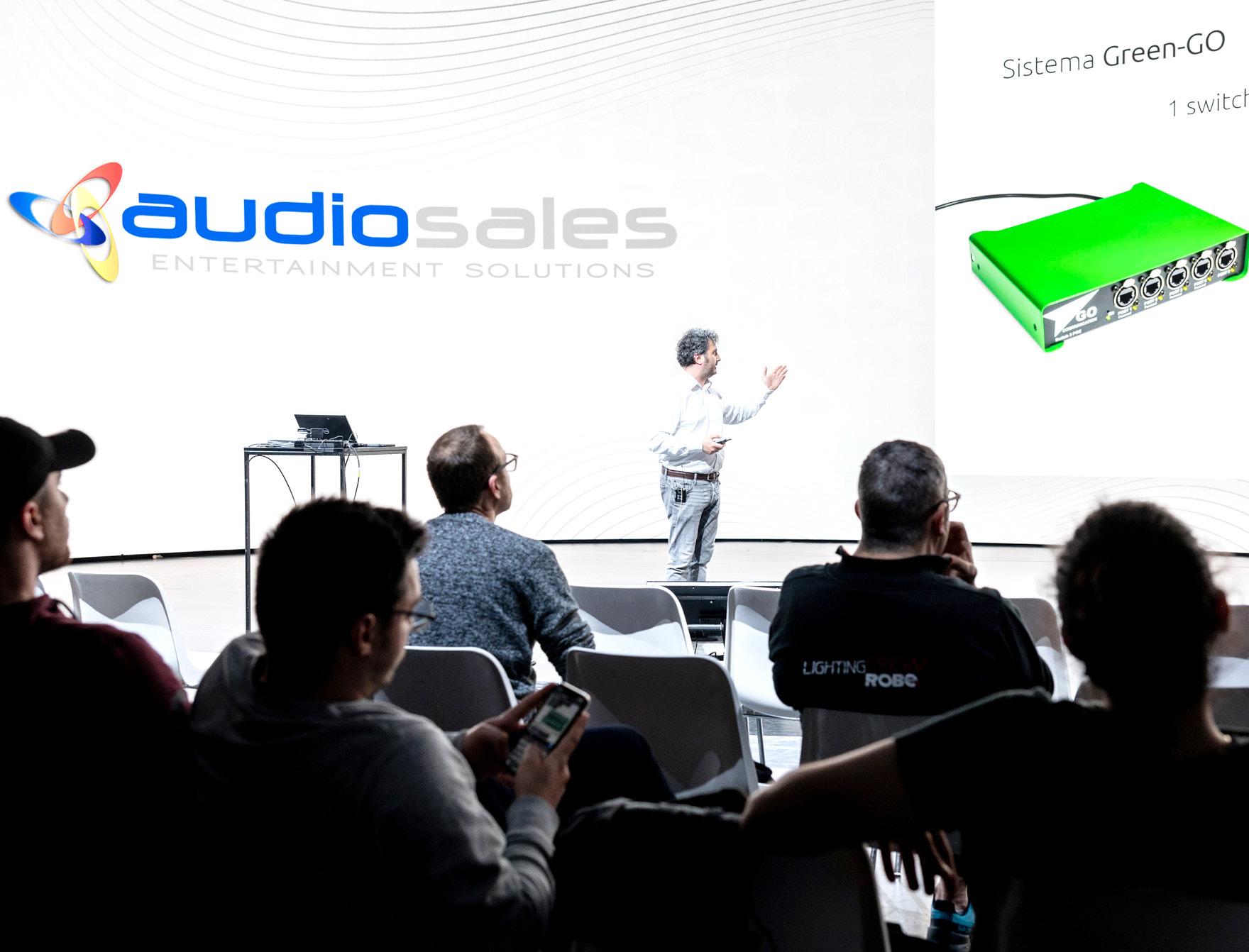
dalla giornata: la capacità di Audiosales, in quanto distributore, di fornire tutte le soluzioni necessarie per il broadcast del XXI secolo, sempre più orientato alla Virtual Production, che a sua volta si basa sull’utilizzo della tecnologia Ledwall.
La location: un dettaglio importante
Un evento simile non poteva che svolgersi nella location giusta, uno spazio che rappresentasse al meglio la principale tematica della giornata: la Virtual Production Technology. Lo Studio CR49 di STS Communication, attrezzato con la migliore tecnologia Ledwall disponibile, non ha mancato di stupire e affascinare i partecipanti.
La Virtual Production permette di fondere virtuale e reale con risultati visivamente straordinari, ed è stata adeguatamente rappresentata dai brand intervenuti all’evento, tutti – ciascuno a suo modo – in grado di coprire le esigenze del settore.
I prodotti: l’anima della festa
Se la location si è dimostrata un fattore importantissimo, non da meno sono stati i prodotti dispiegati sul campo, a disposizione dei partecipanti, curiosi di scoprirli e sperimentarli con personale tecnico specializzato a disposizione.
La novità forse più interessante è stata la piattaforma LED all-in-one Topaz di Roe Visual, new entry del portfolio Audiosales: piatta, curva o cubica, è progettata
con meccanica di alta precisione e qualità visiva di primo livello, per offrire prestazioni affidabili a costi di gestione accessibili. DirectOut ha portato invece la Serie Prodigy, vasta gamma di prodotti progettata per applicazioni live, broadcast, da installazione e registrazione. In particolare, Prodigy MP, spiegato da Lorenzo Sassi, Business Development Manager DirectOut, è un processore audio multifunzione per varie applicazioni nei settori dell’audio professionale, con pannello I/O flessibile, conversione sample-rate e sincronizzazione multipla. L’unità fornisce fino a 32 ingressi e uscite locali, mentre l’hardware supporta due opzioni MADI e due opzioni per l’audio di rete. Da Canon, invece, ecco le telecamere PTZ CR-N500, presentate da Franco Palleni Pre Sales Manager Canon, corredate dal controller RC-IP1000, elementi fondamentali in uno studio incentrato sulla Virtual Production Technology, che ha, tra le sue caratteristiche, la riduzione del personale necessario alla gestione delle attrezzature. In questo senso, le telecamere remotate, controllabili facilmente da un’unica postazione, sono fondamentali. Pensata per la produzione e lo streaming video, la telecamera PTZ dinamica CR-N500 ha un sensore 4K UHD da 1” e un sistema Dual Pixel CMOS, oltre a uno zoom ottico 15x, nonché stabilizzazione dell'immagine e funzioni di Auto Tracking e Auto Loop. Il controller RC-IP1000, dal canto suo, con-

trolla fino a 200 telecamere con touch screen multi-funzione da 7” e comandi semplici e intuitivi. Netgear, presentata da Michael Dijk, ProAV System Engineer Netgear Business, ha contribuito poi, in modo decisivo, con i suoi switch fully managed Pro AV serie M4300 1G e 10G, utili a supportare l’ampia larghezza di banda richiesta dai prodotti abilitati SDVoE, che trasportano video ad alta risoluzione, audio multicanale e controllo, con forte riduzione della latenza. Adatti a qualsiasi installazione AV over IP, questi switch sono flessibili e semplificano la vita agli installatori. Infine, l’interessante sistema modulare per quattro ricevitori MCR54 di Wisycom, illustrato da Giovanni Pigino , che arriva fino a 16 canali, in una unità rack standard 19”, con filtraggio RF e routing audio avanzato (analogico, AES3 e Dante), e il sistema Intercom portatile Beltpack X di Green-GO a 32 canali, basato su rete Ethernet e dotato di un display OLED a colori ad alta risoluzione, che mostra le informazioni su canali, segnali di attivazione e funzioni.
La parola ai protagonisti
Durante “Broadcasters’ Spring Summit” abbiamo incontrato Marco Alterini, Direttore Commerciale di Audiosales: “In
realtà non siamo nuovi nel Broadcast, da anni seguiamo molti dei principali broadcasters in Italia. Ultimamente abbiamo allargato il numero di brand che possiamo offrire, dunque l’obiettivo è ingrandire anche il parterre dei clienti.
La scelta di STS per questo evento è importante, perché dispone di una location adeguata ed è nostro cliente. Per noi, quindi, non si tratta tanto di un inizio, quanto di un importante passo avanti.”
Quali sono le principali novità su cui puntate?
Anzitutto Canon, con cui abbiamo iniziato a lavorare a gennaio.
Le camere PTZ vengono usate sempre di più nel mondo delle produzioni virtuali. Poi abbiamo Netgear, con le sue novità adatte al broadcast, e Wisycom, per microfoni e gestione segnale, di cui vogliamo far conoscere la qualità. Infine, LEDwall entra nel nostro universo con Roe Visual, con prodotti diversificati adatti sia al rental che alle installazioni.
Il LED è un mercato nel quale non è facile differenziarsi, noi abbiamo scelto la strada della qualità, anche se significa avere quotazioni più alte… Roe, d’altronde, offre un servizio di livello premium nell’assistenza e post vendita.”

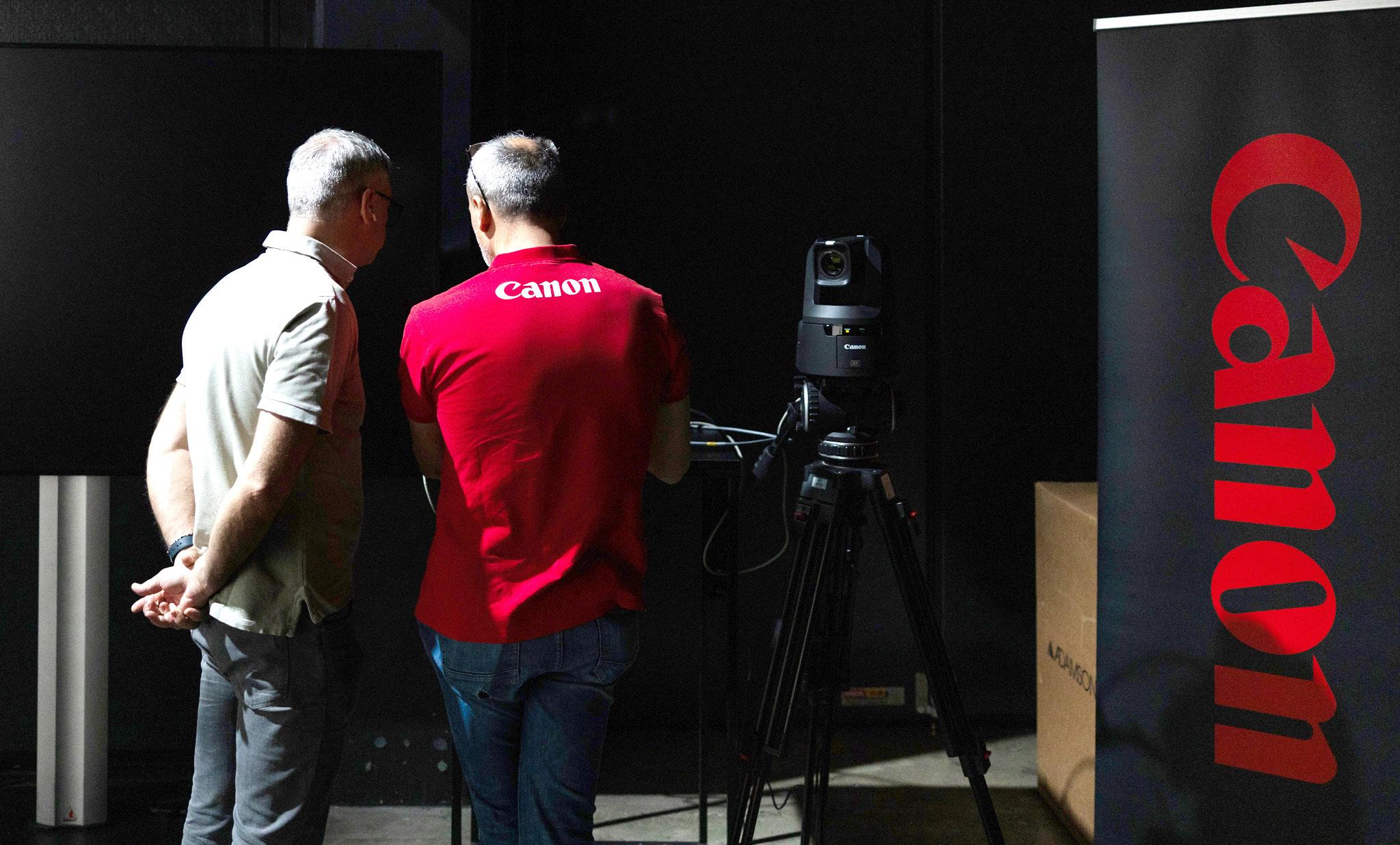
Canon offre camere PTZ per produzioni virtuali. Netgear presenta novità per il broadcast, Wisycom eccelle nei microfoni e gestione segnale, e Roe Visual con LEDwall per rental e installazioni.

Se Audiosales è stato il collettore di tanti brand e di tante proposte (e visioni), ecco le loro voci. “Per noi il broadcast è un mercato nuovo - ha riferito Salvio Celotto VAR&ProAV Sales Manager -. Gli switch di ultima generazione che abbiamo portato sono stati presentati a ISE 2024 per rispondere alle necessità di design dell’impianto e la larghezza di banda necessari in questo settore.
Audiosales è stato il primo distributore a credere in Netgear, anni fa, siamo legati da profonda stima oltre che da una uguale attenzione al cliente. Siamo felici di questa partnership. Ma siccome non è possibile parlare di Virtual Production senza parlare di LEDwall, ecco Roe Visual, nelle parole di Harro Veldhuizen: “I nostri ledwall sono utilizzabili sia in applicazioni indoor che outdoor, e offrono una grande qualità dell’immagine e versatilità. Il design è leggero e sottile, con luminosità di 1500 nits. Importante il design modulare sia dell’alimentatore che dell’HUB. La Virtual production per noi è molto importante, i nostri prodotti offrono funzionalità e versatilità, e la presenza a questo evento li esalta e li mette nella miglior luce possibile.
Tecnologie a supporto delle disabilità

Se è vero che ogni installazione è una sfida, possiamo dire che alcune installazioni sono… più sfidanti di altre! È il caso dell’aula realizzata da Auris Populi presso l’ISSR, Istituto Statale per Sordi di Roma
ISSR, Istituto Statale per Sordi di Roma, è un importante centro di ricerca, consulenza, formazione e aggiornamento sulla sordità, e ospita speciali scuole dedicate agli ipoudenti. Fondata nel 1784 dall’abate Tommaso Silvestri, e sita in via Nomentana, questa scuola è stata la prima in Italia dedicata agli ipoudenti e agli affetti da sordità, ed è ancor oggi un punto di riferimento irrinunciabile per chi è toccato da queste disabilità.
In questo delicato contesto, Auris Populi, nelle persone del suo amministratore Marco Itta e del direttore tecnico ingegner Sergio Scarpellino, ha progettato e messo in opera un sistema unico nel suo genere, sia per la scelta dei prodotti che per la soluzione applicativa, che ha richiesto più di un pizzico di… italica creatività!
Le tecnologie
Prima di addentrarci nella soluzione escogitata da Marco Itta e Sergio Scarpellino, però, diamo un’occhiata al sistema Contacta V-Series, distribuito in Italia da Audiosales, che è stato fin da subito la soluzione prescelta per la sala dell’ISSR: di cosa si tratta? In pratica, è un hearing loop che fornisce un link diretto a sorgenti audio come microfoni o impianti di diffusione audio per aiutare le persone con disabilità uditive a sentire chiaramente voci o suoni. Il parlato, infatti, dopo essere stato rilevato da un microfono, viene convertito in un segnale magnetico da un amplificatore e trasmesso agli utenti attraverso un hearing loop radio. Il segnale viene quindi captato da un telecoil situato all’interno del device d’ascolto del singolo utente (l’apparecchio acustico personale), che sarà quindi in grado di ascoltare con chiarezza. Dunque, un sistema diffuso per comunicare one-to-one con tutti gli ascoltatori ipoudenti presenti in un ambiente come un’aula scolastica, appunto. Il sistema hearing loop
V-Series Contacta installato presso un’aula delle elementari dell’Istituto dei Sordi di Roma fa parte di un progetto pilota il cui obiettivo finale è quello di dotare tutte le aule dell’Istituto di un sistema di ausilio ai bambini ipoudenti.
Il sistema è composto da tre tipologie di prodotti: anzitutto, V15A-EU è un driver compatto con sfasatore integrato, amplificatore in classe D e CPU in grado di garantire le massime prestazioni.
V15A-EU consente di ottenere un parlato

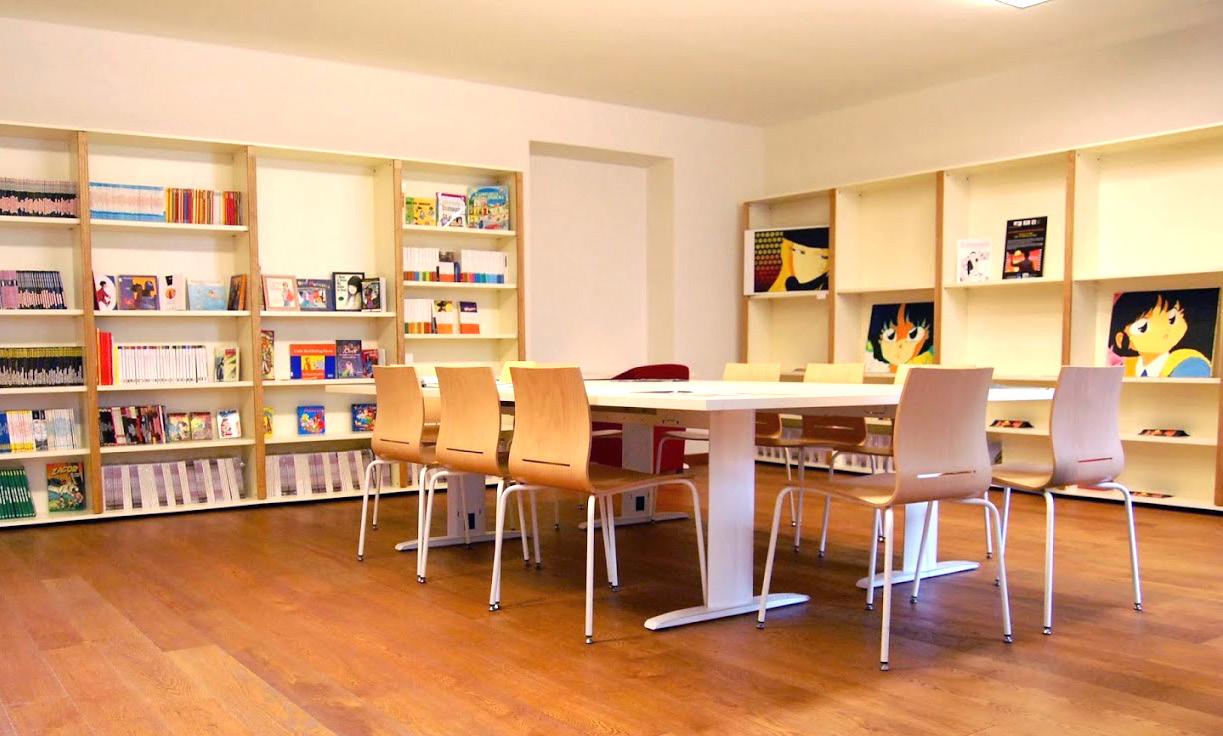
realistico e una riproduzione musicale di livello elevato, ed è esplicitamente progettato per dare supporto all’ascolto di persone ipoudenti.
Il sistema è poi completato dal loop listener IL-RX20 completo di cuffia e dal fondamentale cavo per loop a induzione CABLE-1.0TRI (rimandiamo al box per una spiegazione più estesa su cosa sia esattamente un loop a induzione).
soluzioni
Auris Populi è una frizzante realtà nell’ambito dell’audio professionale, nata nel 2010 per iniziativa del fondatore e attuale amministratore Marco Itta, oggi Auris Populi ha il suo core business nella progettazione, installazione e assistenza tecnica di impianti audio.
Per l’Istituto dei Sordi di Roma, l’azienda si è trovata davanti a un problema in particolare: come installare un sistema che solitamente si alloca nei pavimenti in un edificio nel quale non era possibile operare
un intervento così radicale, sia per limiti di budget che per questioni ambientali e strutturali? Marco Itta, che abbiamo potuto intervistare, ci spiega così la soluzione: “Era l’uovo di Colombo, diciamo: visto che non potevamo mettere i fili per terra, li avremmo messi per aria! Abbiamo pensato di montare i cavi a soffitto, e questa è la gatta da pelare che ho dato al mio direttore tecnico, l’ingegner Sergio Scarpellino, che ha accettato la sfida e, ovviamente, l’ha vinta!”
Il loop a induzione, infatti, si realizza con un cavo che ha la sezione di 1 mm e che deve correre per tutto l’ambiente da sonorizzare, creando una sorta di “bolla” uditiva.
La soluzione di Auris Populi è consistita nel montaggio di un reticolo di corde colorate, che rappresentano peraltro anche un’ottima proposta estetica per un’aula di scuola elementare, lungo le quali corrono i cavi del loop a induzione.
“L’idea ovviamente” – puntualizza Marco Itta, non senza una certa, giusta, soddisfazione – “è proponibile, in futuro, anche
Soluzione innovativa di Auris Populi per l'Istituto dei Sordi di Roma: cavi a soffitto con un reticolo di corde colorate per un'installazione funzionale ed esteticamente piacevole.



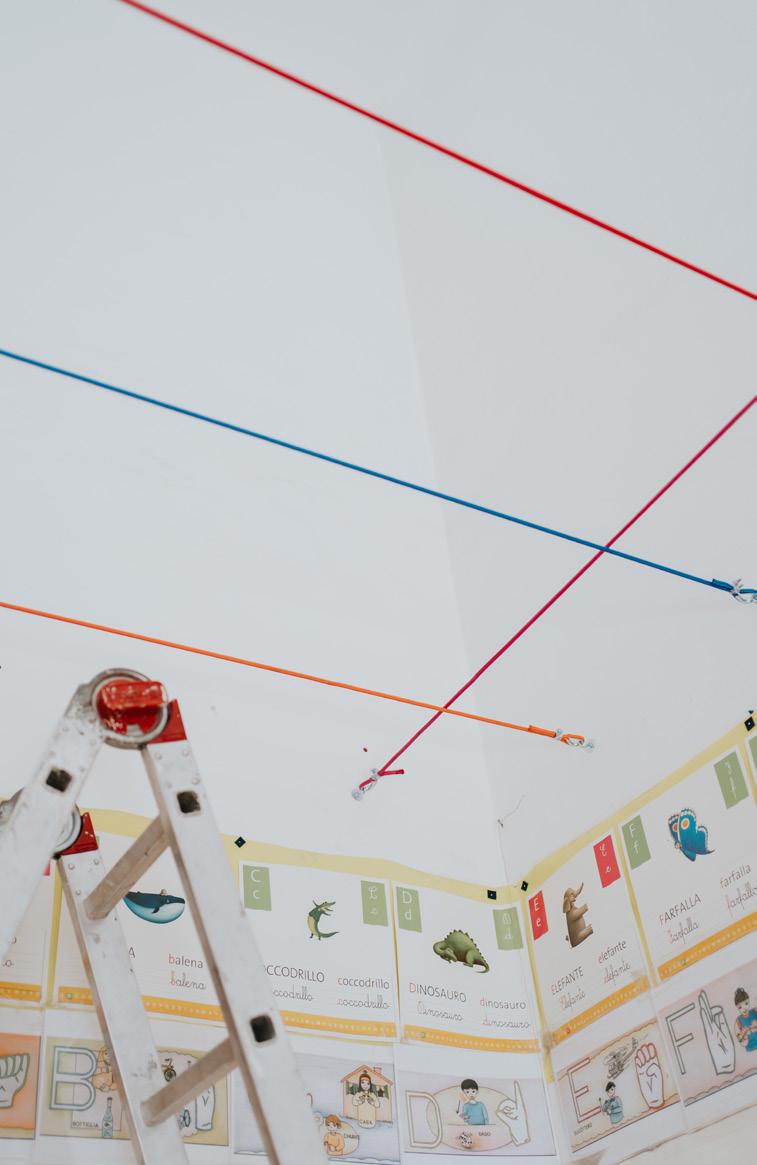

in altre location che abbiano il medesimo problema. Rifare un pavimento non è cosa da poco ed è comprensibile che non tutti gli istituti scolastici possano permetterselo, anche a livello di durata dei lavori. Mi ha fatto molto piacere che anche Contacta, il produttore del sistema, ci abbia fatto i complimenti per questa installazione!”
Quando progettazione e installazione vanno a braccetto Continua Marco Itta: “Un punto importante da sottolineare è che noi non siamo solo installatori, ma abbiamo anche uno studio di progettazione. Questo ci consente di escogitare le soluzioni più adatte per ogni realtà. Nel caso dell’Istituto dei Sordi di Roma, la sfida era trovare il modo di stendere i cavi. Abbiamo pensato anche a una canalina lungo i muri perimetrali,
ma avremmo avuto interferenze nell’aula accanto. Alla fine, la nostra soluzione si è rivelata brillante: un telaio sopraelevato composto da funi in nylon colorate.
L’uso delle funi ci ha permesso di evitare l’utilizzo di strutture rigide sospese, massimizzando così la sicurezza e accorciando i tempi di installazione.”
Ma come è stato individuato il sistema Contacta V-Series? “Il produttore è tra quelli a nostro giudizio più esperti e con una maggiore rappresentanza commerciale in Italia” – risponde Marco.
“Peraltro, grazie alle informazioni contenute nel report tecnico ricevuto dal produttore e grazie al particolare sistema di posa che abbiamo progettato e realizzato internamente, l’installazione è stata relativamente semplice. Significativo è stato
anche il supporto del reparto tecnico del fornitore Audiosales, che ci ha aiutato ad interpretare i dati di progetto e a tradurli in questa applicazione specifica.”
Gli insegnanti e gli alunni dell’ISSR che hanno già avuto modo di sperimentare la comunicazione tramite hearing loop Contacta hanno dato un chiaro feedback positivo circa il miglioramento della comprensione da parte dei bambini.
Particolarmente apprezzata è stata inoltre la facilità d’utilizzo dell’impianto, che si inserisce con naturalezza nell’ambiente scolastico ed esalta le possibilità comunicative di insegnanti e allievi.
www.audiosales.it
www.audiosales.it/marchi/contacta https://aurispopuli.com/
Cosa si intende per “sistema a induzione magnetica” o “loop a induzione”? In pratica, si tratta di un sistema di amplificazione magnetica per apparati uditivi, che “comunica” in un ambiente ben definito con i singoli apparecchi acustici degli ascoltatori, permettendo un ascolto più facile e proficuo.
Un sistema magnetico a loop è costituito da una sorgente audio (microfono, apparecchio di riproduzione di contenuti, sistema audio professionale, impianto home cinema, eccetera), da un processore/amplificatore del segnale e dal fondamentale cavo del loop, che struttura i confini dell’area di diffusione del segnale magnetico che attiva i singoli apparecchi acustici. Insomma, una “bolla audio” ben delimitata – nel caso dell’ISSR si tratta di un’aula delle scuole elementari – all’interno della quale un segnale sorgente (la voce del docente) viene ricevuto simultaneamente da tutti gli apparecchi acustici presenti, senza bisogno di collegamenti fisici o cavi che non siano quelli comuni del loop.
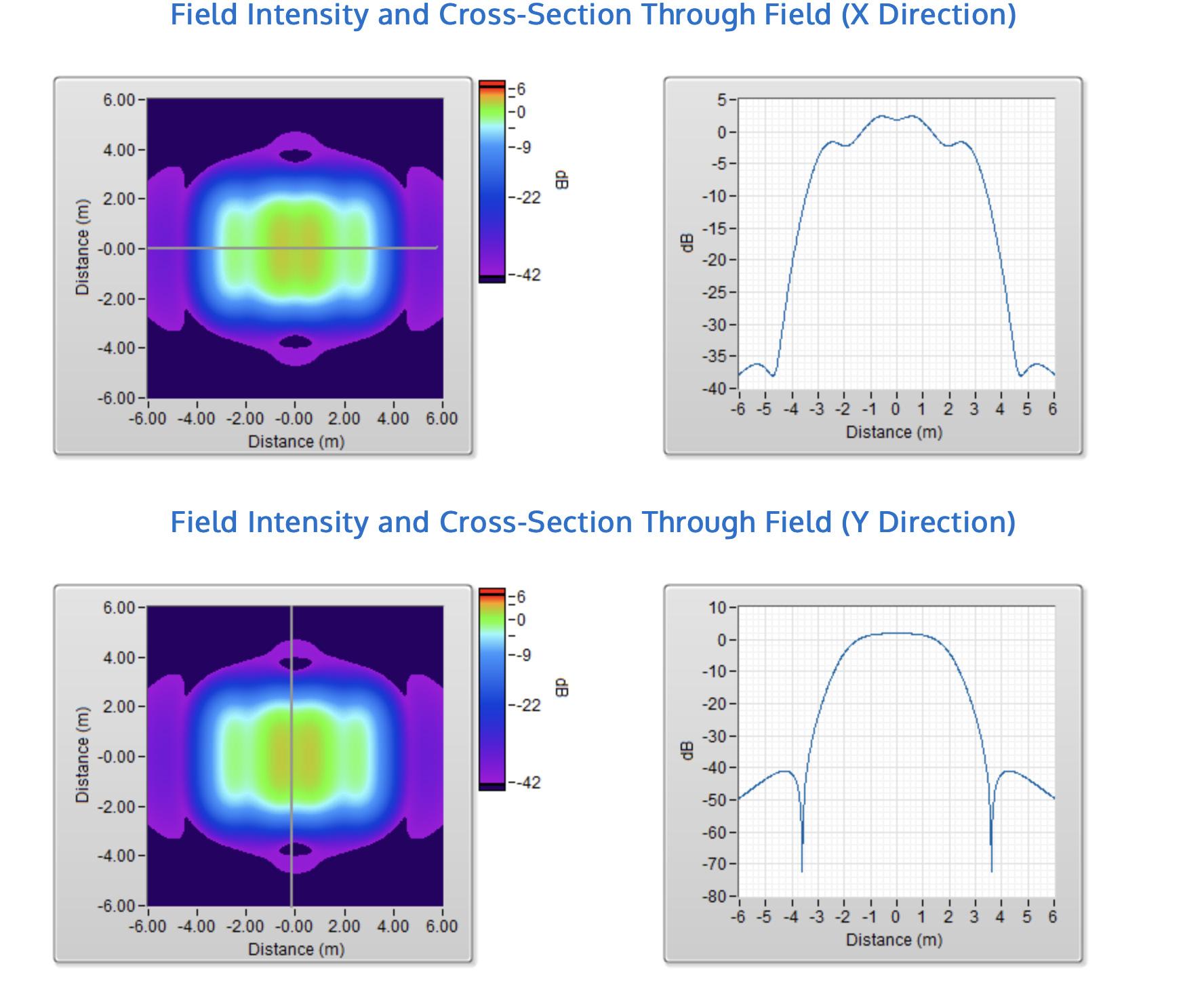
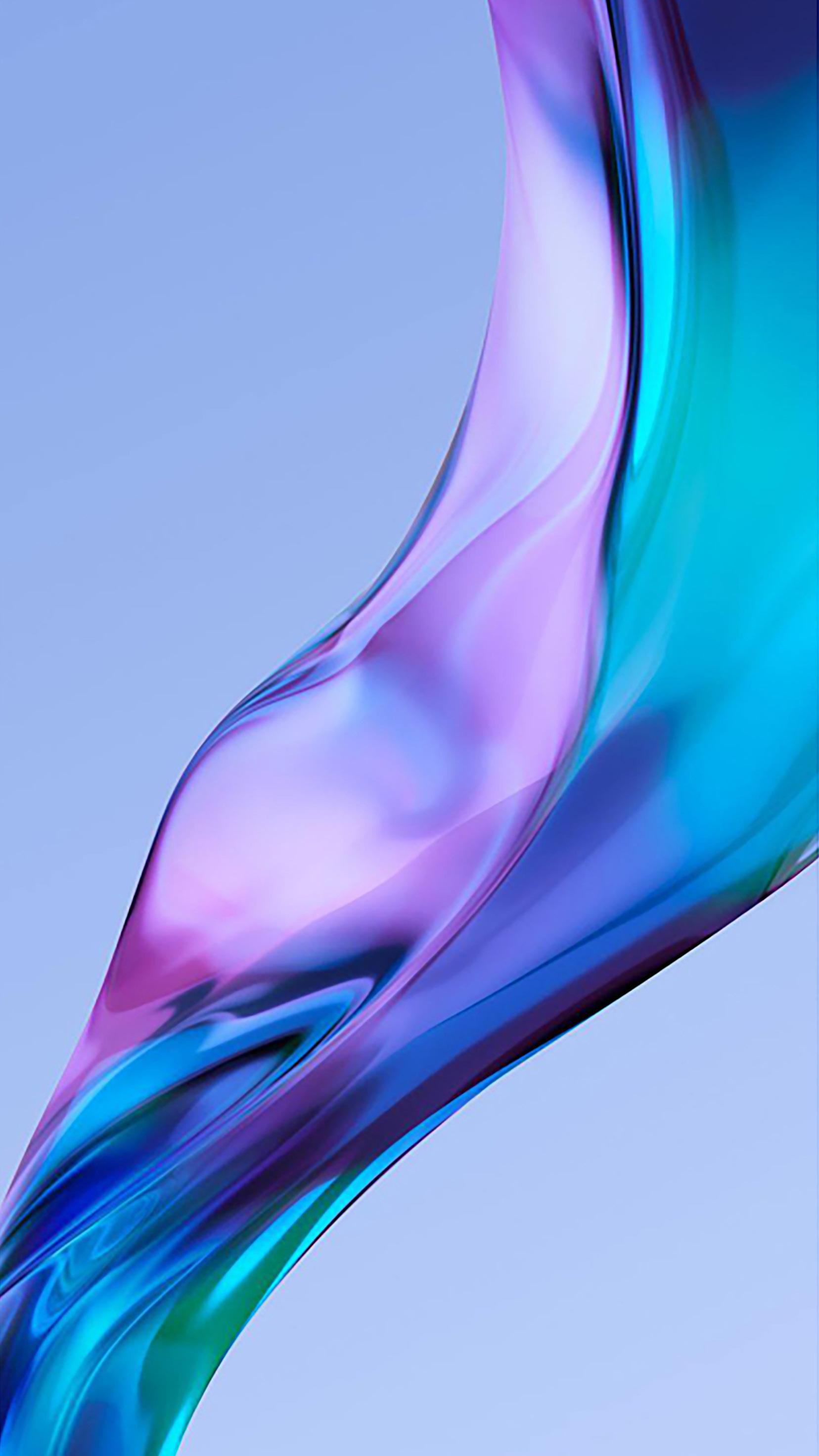
Essere il “partner giusto” per avviare processi di cambiamento, nelle aziende, nel retail, nella scuola e nella PA, ma anche nel dinamico mondo degli eventi live: l’evoluzione di Hikvision sul mercato dell’AV professionale
Focalizzazione e reattività: ci eravamo lasciati su questi due concetti-guida per la neonata attività di Hikvision sul mercato italiano della comunicazione visiva, della collaboration e del conference. A distanza di un anno, la specializzazione e la capacità di rispondere prontamente ai balzi dell’innovazione tecnologica hanno trovato una declinazione vincente. All’interno di un percorso che, per Maurizio Coates, responsabile BU Transmission & Display di Hikvision, punta dritto all’obiettivo del “total solutions provider”.
Nel mezzo, precise strategie di approccio al mercato: dal consolidamento del canale distributivo al rapporto con i system integrator, passando per l’ampliamento del business dall’installazione fissa al rental.
Settori promettenti, che si fanno strada insieme all’evoluzione della tecnologia LED, che sta raggiungendo applicazioni fino a pochi anni fa impensabili, per budget e livello di integrazione.
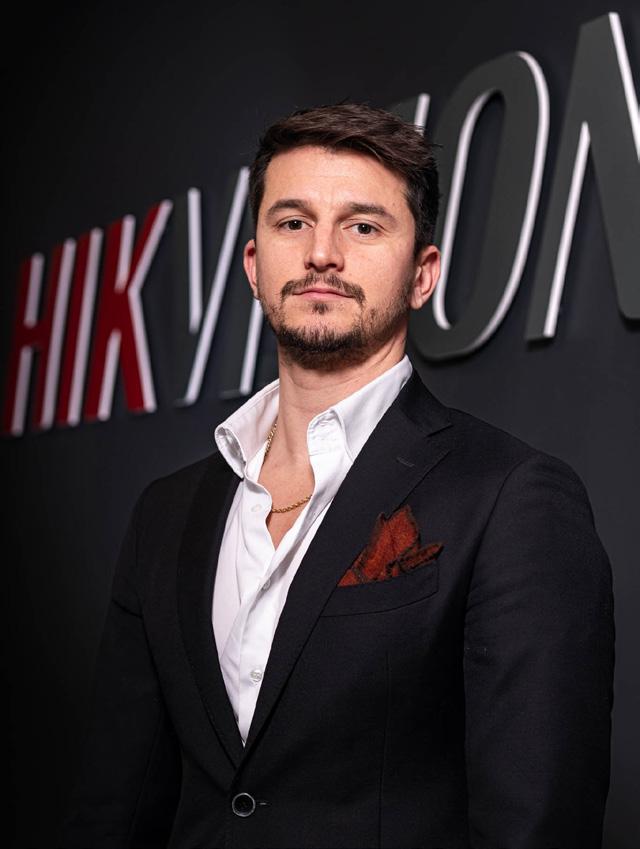
Un anno fa commentavamo l’avvio della BU dedicata alla comunicazione visiva e digitale. Oggi possiamo stilare un primo bilancio: come sta andando?
Com’è stata accolta la proposta dai clienti italiani?
Sta andando molto bene. Abbiamo dedicato il 2023 alla creazione del canale, chiudendo accordi con distributori verticali di soluzioni AV Pro, e possiamo dire di aver ottenuto la giusta capillarità territoriale con partner che ci garantiscono alta qualità nelle fasi di pre-vendita, post-ven-


dita, gestione del magazzino e altri aspetti importanti. Attualmente operiamo con tre distributori per l’installazione fissa e due specializzati nel rental. Questo perché si tratta di canali differenti con esigenze differenti, due binari paralleli che difficilmente si incontrano. Per noi è fondamentale offrire ai system integrator italiani i giusti interlocutori per ogni esigenza. Mi soffermo sul rental proprio perché abbiamo introdotto questa gamma alla fine del 2023, rafforzando al contempo il sistema di logistica in pronta consegna sul territorio italiano.
A differenza di altri vendor, che si appoggiano a stock esteri, Hikvision vanta infatti la pronta consegna, nel nostro magazzino e nei magazzini dei distributori, anche per i sistemi rental. Il prossimo
step, a breve termine, sarà strutturare ulteriormente la BU Transmission & Display inserendo nuove persone dedicate allo sviluppo di questa fetta e al rafforzamento delle altre.
Focus sui cambiamenti del mercato: quali sono, nella vostra esperienza, i punti di forza e di debolezza del contesto AV italiano?
Il principale cambiamento, nonché potenziale punto di debolezza, è dettato dallo swap tecnologico. Mi spiego meglio: il rapido susseguirsi di nuovi processi produttivi e di nuove performance nei prodotti, aumenta i rischi di “invecchiamento” precoce del magazzino per le aziende italiane che importano soluzioni hitech con investimenti importanti.
Nel nostro caso, tuttavia, il rischio connesso alla velocità dello swap tecnologico se lo accolla dapprima il vendor, che tramite un’accurata gestione del proprio stock locale riesce a mitigare le criticità per i distributori e i clienti nazionali.
Quanto ai punti di forza, notiamo il progressivo ampliamento della base clienti dei display LED dettata dalla maggiore accessibilità economica. Tante realtà commerciali, anche medio piccole, possono permettersi di installare ledwall, digital signage e schermi di grande formato a costi più contenuti rispetto al passato. Si abbassano dunque i prezzi ma aumenta il margine di diffusione in mercati a tratti inesplorati, generando per noi opportunità da non trascurare.
Le soluzioni commerciali Transmission & Display si rivolgono principalmente a retail, edu e corporate, ma avete acceso i riflettori sul rental.
Vi sono particolari evoluzioni da considerare in questi ambiti?
Ricollegandomi al retail, stiamo appunto cogliendo le potenzialità di questo business a livello più capillare, oltre ai settori già consolidati delle catene e del luxury.
L’educational si conferma invece piuttosto stabile e alimentato dai fondi erogati da
Italia e Ue. Lo presidiamo bene, con un valido network di oltre 35 system integrator che supportiamo anche nella stesura dei capitolati e dei progetti. Da circa un anno abbiamo, inoltre, iniziato a fornire anche in questo settore sistemi videowall e ledwall, per esempio nelle aule magne. A testimonianza del fatto che il LED sta avanzando veramente ovunque: dal corporate, con meeting room e showroom, al nuovo banco di prova dell’educational. Quanto alle applicazioni corporate, il discorso si fa più articolato.
Una parte dello sviluppo è legata al retrofit della tecnologia LCD, muovendosi dal videowall al ledwall, ma in alcuni casi addirittura con il salto dal videoproiettore al LED. Altrettanto interessanti, i monitor interattivi e touch mutuati dagli ambienti educational.
Questo perché migliorano la user experience nelle riunioni, in presenza o ibride, con la possibilità prendere appunti e installare app, ma anche di sfruttarne le potenzialità come schermi di computer, con sistemi operativi, applicazioni e accessori di videoconference integrati. Proprio qui, negli ecosistemi aziendali, riusciamo a esprimere la totalità della nostra proposta. Security & safety, videowall, ledwall, monitor interattivi, videoconfe-

renze: soluzioni complete che ci rendono “total solution provider”. Un unico fornitore tecnologico con un’unica piattaforma, la nostra HikCentral, che centralizza il controllo dei sistemi e dei dispositivi installati.
In tema di pubblica amministrazione, invece, la spinta del PNRR sta realmente sbloccando l’innovazione digitale?
Si tratta di un processo in costante evoluzione. Ne constatiamo i risultati sul quotidiano, con gli interventi di “svecchiamento” di un parco prodotti mai toccato per molti anni, ma ci vorrà del tempo. Anche perché sostituire l’hardware non significa fare innovazione: la componente tecnologica va accompagnata da un’adeguata formazione delle persone su come usare gli impianti e, soprattutto, sfruttarne appieno le potenzialità digitali. I system integrator che collaborano con i nostri distributori stanno partecipando a bandi per il rinnovamento della pubblica amministrazione in tal senso e siamo pronti ad accompagnarli al meglio.
Le novità del momento in termini di prodotti?
Partiamo dalla tecnologia LED: le maggiori novità riguardano la famiglia rental, con
Se la digitalizzazione sta trasformando i modi in cui le persone vivono, lavorano e studiano, i monitor interattivi riescono a soddisfare le esigenze quotidiane di comunicazione e collaborazione in diversi ambiti.
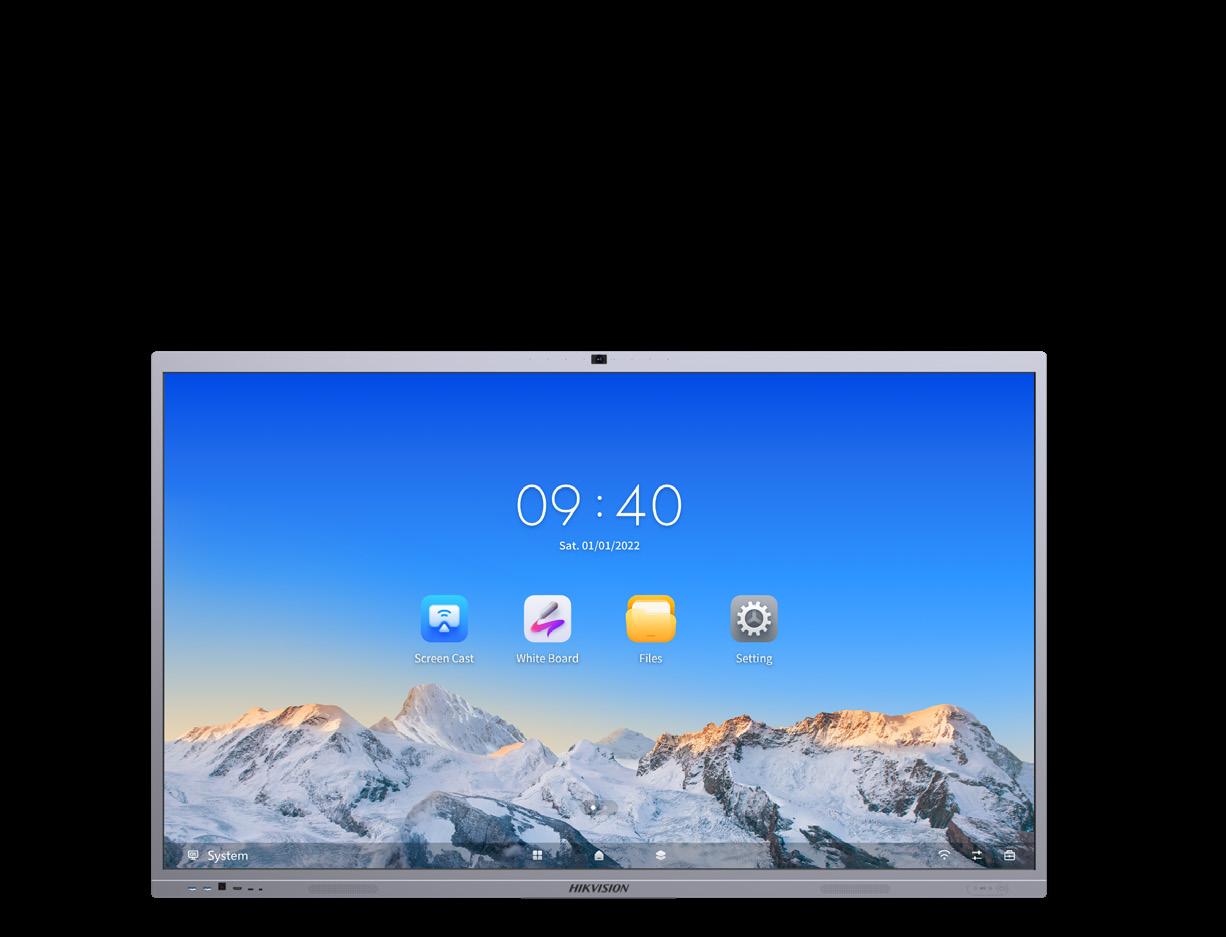
La famiglia Hikvision Interactive Flat Panel Display offre infatti applicazioni flessibili e multifunzionali con risoluzione ultra-4K, scrittura diretta sullo schermo, software per lavagne integrate, proiezione libera e integrazione più o meno complessa di accessori per la videoconferenza.
La gestione centralizzata ne migliora l’efficienza operativa, con rapidità nell’impostazione dei parametri, nella visualizzazione delle informazioni, nel lancio dei video e nell’installazione di app.
Guardando alle riunioni online, i monitor interattivi integrano una serie di componenti di qualità: le immagini ultra-HD e l'audio chiaro avvicinano i membri del team, ovunque si trovino. Quanto alle esperienze di apprendimento, il sistema Hikvision può sfruttare telecamere professionali con AI e software di ultima generazione. La soluzione integrata Classroom Hub, inoltre, unisce virtualmente più aule, reali e digitali, colmando ogni possibile divario tra studenti e docenti.
soluzioni indoor e outdoor dalle elevate performance, ancora più agili da traspor tare, montare e smontare. Interessanti anche gli sviluppi della collaboration e delle videoconferenze.
Offriamo infatti prodotti di fascia media e medio alta quali soundbar con sistema operativo Android e intelligenza artificiale e webcam da 48 megapixel.
Tengo a sottolineare, sempre in questo mercato, l’evoluzione lato software. Nel 2024 uscirà infatti una piattaforma per la gestione tecnologica e strategica dei meeting, pensata per semplificare la vita agli utenti finali. Basterà avviare l’appli cazione e, in automatico, questa si con netterà ai vari calendari.
Non dovremo più preoccuparci di come partecipare alla riunione - Zoom, Meet, Teams o altro - perché il software si muoverà in autonomia per soddisfare i requisiti impostati nella schedulazione dell’incontro. Infine, le novità edu e cor porate legate ai monitor interattivi, con la gamma Hikvision Interactive Flat Panel Display che arriverà a 98 pollici.
Chiudiamo con una valutazione sulla partecipazione a fiere ed eventi di set tore e sugli obiettivi per il futuro.
Didacta, per l’educational, e MIR, per il rental e l’AV pro in generale, si sono con fermati appuntamenti chiave.

Mi soffermo soprattutto sul secondo, al quale abbiamo partecipato per la prima volta in forma diretta: è stato un successo soprattutto in ottica di rafforzamento delle relazioni con i nostri partner e con i system integrator. Didacta, invece, era già una tappa fissa: sebbene l’evento si rivolga a un pubblico diverso, quello dei clienti finali del mondo scolastico, lo riteniamo utile per entrare in contatto con i veri fruitori delle nostre tecnologie. Quanto agli obiettivi futuri, vogliamo supportare ancora di più il network di distributori sul territorio, dialogando con i system integrator per sostenere i partner nelle fasi di preventivazione, progettazione e vendita, nonché nella risoluzione dei problemi e nella proposta di servizi mirati. Insomma, il distributore resta protagonista della nostra strategia, così come lo sono system integrator e clienti finali, ai quali ci rivolgiamo per creare un circolo virtuoso a favore del quotidiano lavoro del nostro canale distributivo.
www.hikvision.com/it
Altra novità 2024, la gamma ledwall per il mercato rental, con diversi modelli dedicati sia alle installazioni esterne sia agli spazi interni.
Quali sono le caratteristiche di questi display? La tecnologia proprietaria di elaborazione delle immagini Pix Master migliora la trasmissione dei contenuti senza la dispersione dei dettagli. Sempre Pix Master, regola automaticamente luminosità e scala di grigi: così, l'algoritmo smart aiuta anche a ridurre il consumo energetico del display del 20% circa.
I ledwall rental sono anche semplici da utilizzare, poiché il controller integrato supporta la gestione con più ingressi HDMI, mentre il software LED O&M di Hikvision garantisce manutenzione automatica, monitoraggio dello stato, eventuali allarmi e guida alla configurazione e alla risoluzione dei problemi. Il sistema offre anche un telecomando portatile per gestire modalità di visualizzazione, livello di luminosità, deumidificazione automatica e filtraggio della luce blu.
I LED indoor sono caratterizzati da un design con doppia alimentazione, che assicura più stabilità e sicurezza.
Inoltre, il cabinet in alluminio pressofuso, leggero e resistente, aumenta la precisione del sistema. Il connettore in grado di muoversi leggermente garantisce anche la planarità del modulo LED.
Quanto ai plus delle versioni outdoor, l’eccellente dissipazione del calore consente un funzionamento senza aria condizionata fino a 60°C, con prestazioni sempre al massimo grazie alla protezione IP67. La precisa distribuzione dell'elettricità per i chip LED RGB riduce infine il consumo energetico del display del 50% e oltre.

In esclusiva per Connessioni, i dettagli della nuova partnership tra Q-SYS e Shure per l’integrazione della componente microfonica nei sistemi di conferenza Q-SYS, supportata per il mercato italiano dagli specialisti di Prase Media Technologies
Semplificazione, interoperabilità, user experience: sono le parole chiave delle collaborazioni tecnologiche più riuscite, che nascono dalla concreta integrazione di know-how e dall’analisi delle esigenze dei clienti. Come nel caso di Shure e Q-SYS che hanno unito le forze per aumentare efficienza e qualità dei sistemi di conferenza. La recente adesione di Shure al Q-SYS Technology Partner Program, infatti, mette a disposizione dei professionisti AV numerosi plugin certificati nell’ambito di questo ecosistema. Ciò significa poter controllare la componente microfonica di Shure direttamente dalla piattaforma Q-SYS Designer Asset Manager, ottimizzando tempi e complessità dei progetti. Incentivando, al contempo, il percorso del mercato AV Pro verso la maggiore interoperabilità tra marchi.
I risvolti e le opportunità di questa novità, significativa soprattutto per gli ambienti corporate, educational e pubblica amministrazione, sono al centro della nostra intervista “doppia” a Samuele Apostoli, Market Development Manager di Shure, e Luca Battistelli, Systems Sales Manager di Prase Media Technologies, distributore di Shure e Q-SYS sul mercato italiano.
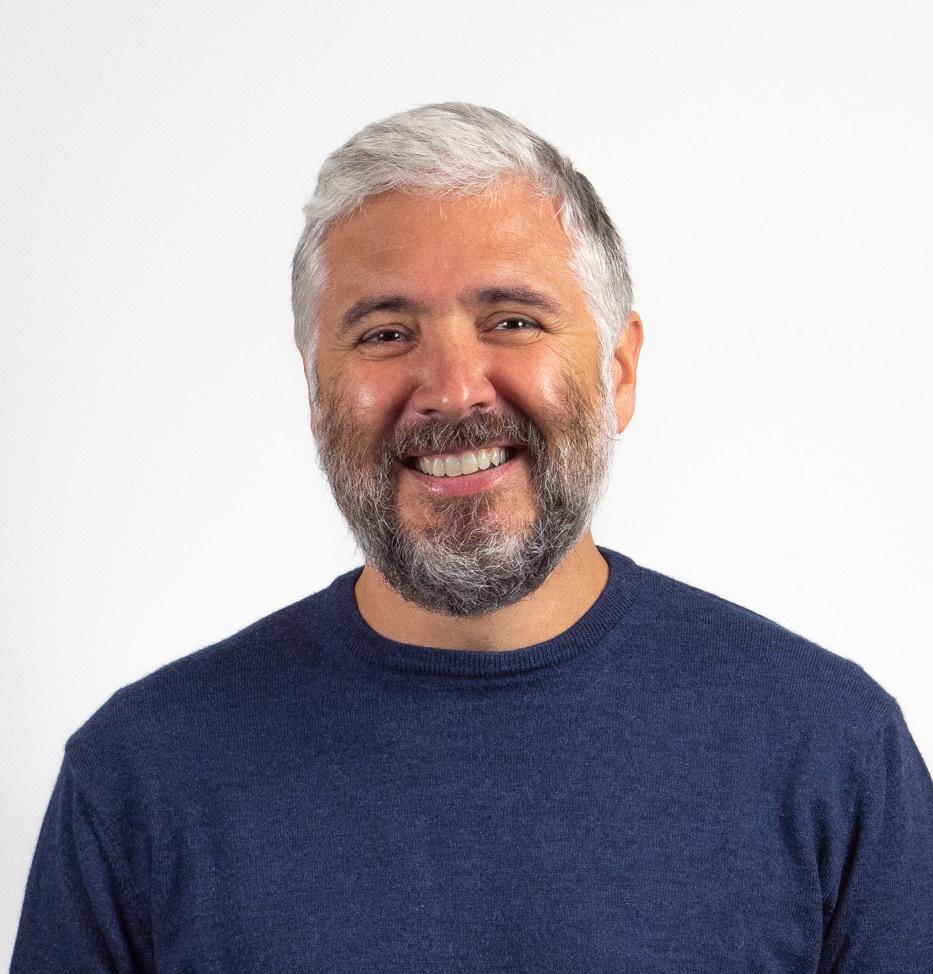
Analizzando il lato tecnico, Shure e Q-SYS hanno sviluppato “a quattro mani” l’integrazione del plugin del microfono Shure MXA920 Ceiling Array con un badge Q-SYS Certified. I professionisti AV/IT possono quindi scaricare il Control Plugin del microfono direttamente dal Q-SYS Designer Asset Manager, all'interno del software Q-SYS Designer. Una compatibilità avanzata per progetti conference più moderni e collaborativi. Non solo, il microfono MXA920 è anche selezionabile nel plugin Q-SYS Automatic Camera Preset Recall (ACPR) versione 3.1. Ciò significa che, in poche mosse, l’apparecchio diventa parte integrante del sistema di controllo delle telecamere Q-SYS, senza installare plugin aggiuntivi.
Partiamo dall’accordo: come e perché è nato?
Luca Battistelli - Dal punto di vista operativo l’integrazione era già presente, le due aziende l’hanno ufficializzata pochi mesi fa. A stimolare l’avanzamento, la natura di per sé aperta della piattaforma Q-SYS, che già consentiva l’interazione con dispositivi di terze parti e ha trovato in Shure un partner valido per sviluppare una visione comune. L'integratore, oggi, dispone di un'unica piattaforma software dalla quale controllare e gestire, nel caso specifico, anche la microfonia.
E si tratta di un’integrazione molto spinta: l’interfaccia di Shure risulta a tutti gli effetti disponibile all’interno del software Q-SYS.
Samuele Apostoli - Un altro vantaggio, di natura pratica, è quello di ottenere uno strumento più facile per lavorare. Una sola interfaccia dalla quale gestire la

L'interazione diretta del microfono con il lobo aperto, tramite il sistema con telecamera, attiva il richiamo automatico delle telecamere sulla persona che sta parlando. “Questa operazione, normalmente, comporterebbe l’integrazione di controlli di terze parti, scrittura di codice e altri passaggi complessi”, spiega Samuele Apostoli. “Con questa certificazione, invece, si riescono a installare e gestire in modo meno complesso anche gli impianti più sfidanti, passando dal concetto di programmazione a quello di configurazione”

complessità del sistema senza integrare altri prodotti e brand. Il concetto di un unico technology provider, nonostante le diverse tecnologie AV in campo, favorisce anche il rapporto con i clienti e la user-experience degli utenti. Mi spiego meglio: Shure produce microfoni di altissimo livello, ma non offre soluzioni di processo. Quando si parla di ambienti conference, entrano in gioco sistemi complessi che richiedono anche prodotti di terze parti. Ecco perché riteniamo importante offrire proposte “nativamente” integrabili, che facilitino la realizzazione di sistemi di grandi dimensioni, usando più microfoni, magari su più sale, creando scenari inediti e personalizzati. Altro aspetto, la possibilità di abilitare funzionalità che rendono ancora più immersive riunioni e lezioni, dove normalmente si usa l'inquadramento automatico delle camere, grazie al controllo domotico del sistema. Una sorta di all-in-one brand per realizzare
“super sistemi” dall’esperienza garantita per tutti i partecipanti.
Quali applicazioni traggono più vantaggi da questa novità?
Luca Battistelli - Parliamo di sistemi di videoconferenza per ambienti di medie e grandi dimensioni, auditorium ed edifici con più sale da gestire in modo centralizzato. In ambito corporate, invece, molte aziende stanno cambiando l’assetto delle sale riunioni.
Non è più tempo del classico “tavolone” contornato da sedie: si fanno largo spazi aperti e moderni, spesso arricchiti da divanetti da spostare a seconda del mood dell’incontro. In questi ambienti, la partnership tra Shure e Q-SYS permette l’utilizzo dei microfoni a soffitto integrati alle telecamere e alle coordinate geografiche di chi parla, per creare soluzioni innovative in minore tempo. Tra le applicazioni custom
ci sono anche gli ambienti universitari: posso citare l’esempio dell'Università di Torino, che ha scelto le nostre tecnologie per i sistemi AV di tutte le aule.
Finora abbiamo approfondito il lato tecnico, ma cosa comporta in termini commerciali e strategici il badge
Q-SYS Certified?
Samuele Apostoli - In primis, la possibilità di sfruttare un plugin certificato da entrambi i costruttori. Normalmente, infatti, il produttore sviluppa autonomamente un'integrazione, un codice o un plugin e

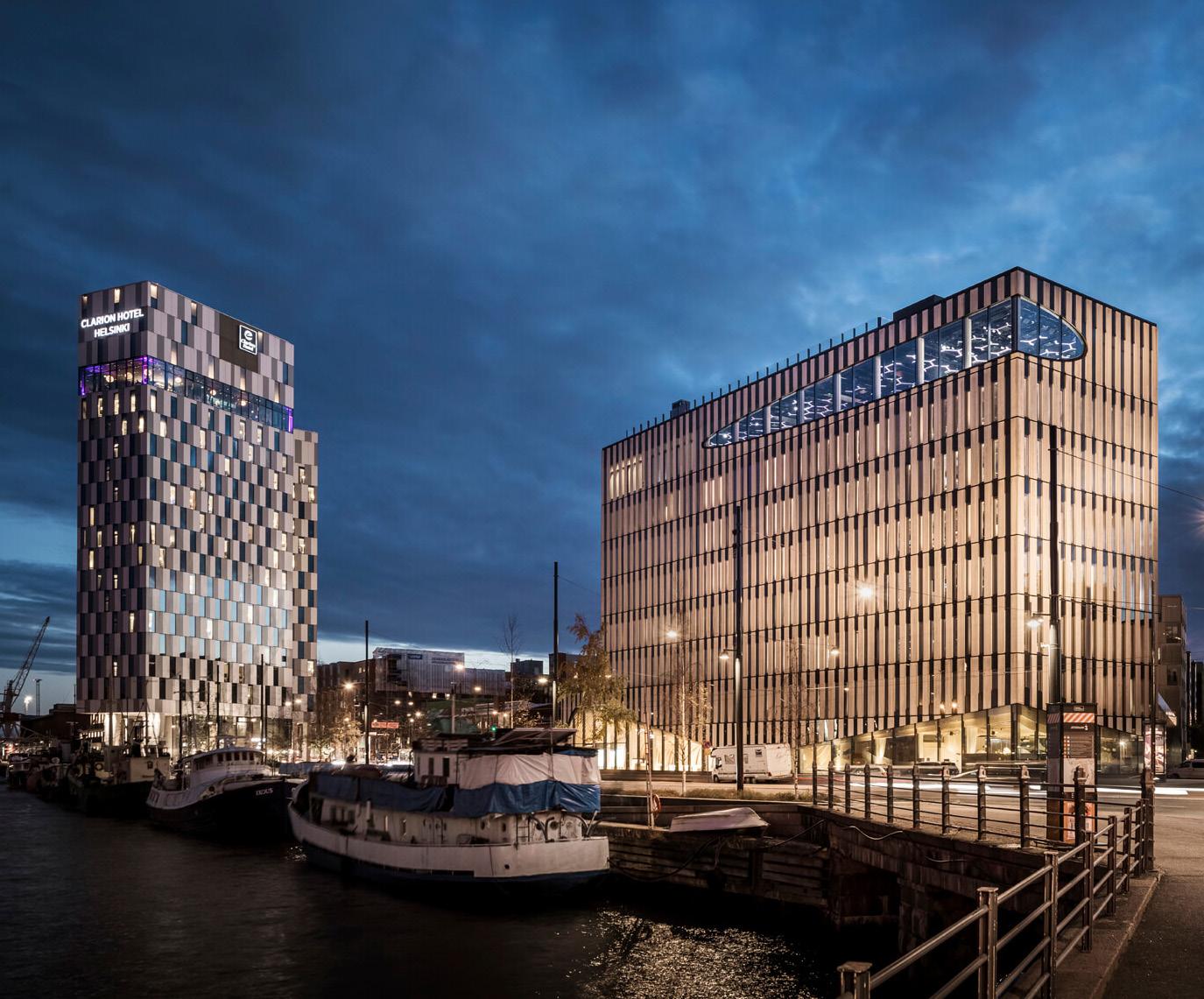
lo “autocertifica”; qui, invece, il plugin è garantito da entrambe le aziende, che lo hanno sviluppato insieme. L’integratore dovrà comunque intervenire per adattare il sistema, ma ha dalla sua parte una garanzia di funzionamento in più e, dunque, un pensiero in meno. Per l’utente finale questo comporta, nel breve nel lungo termine, più stabilità e continuità operativa.
Luca Battistelli - Dal punto di vista commerciale, il vantaggio del supporto di Prase in Italia coniuga questa integrazione, creando valore aggiunto. Nella fase progettuale, come nel commissioning, i nostri specialisti offrono ai system integrator un sostegno aggiuntivo che, unito alla certificazione di Shure e Q-SYS, si trasforma nell’opportunità di offrire ai propri clienti soluzioni che vanno anche oltre i confini dei due marchi in oggetto. Ciò significa completare i progetti con il 100% delle tecnologie necessarie in un'installazione AV professionale tramite un unico interlocutore.
Shure e Q-SYS, infatti, coesistono in un portfolio molto ampio: ecco la leva per approcciare progetti particolari, per ampliare gli orizzonti del proprio business.
La partnership tra Shure e Q-SYS è già pienamente operativa. Lo dimostrano le numerose referenze raccolte a livello globale, tra le quali spicca il progetto della sede centrale di Supercell a Helsinki. La grande società di creazione di videogiochi mobile (da qui provengono, per esempio, Brawl Stars, Boom Beach e Clash of Clans), nel 2022 si è trasferita nel nuovo headquarter della capitale finlandese, all’interno di un edificio chiamato Wood City, progettato da zero per rappresentare la cultura aziendale e incoraggiare benessere e produttività.
Nelle due sale meeting più grandi, il sistema Voice Lift utilizza una combinazione di microfoni a soffitto Shure MXA920 e altoparlanti
PoE Genelec, posizionati strategicamente per amplificare leggermente il parlato, in modo che una persona che parla da un lato della stanza possa essere ascoltata allo stesso livello anche da chi si trova nel lato opposto, anche a 30 metri di distanza. Tutta la componente audio, inoltre, viene gestita da un processore Q-SYS e quindi inviata agli altoparlanti.

Insomma, Shure e Q-SYS sono l’esempio dell’evoluzione ormai evidente verso l’interoperabilità tra marchi e la filosofia software based nel mondo AV.
Samuele Apostoli - Esatto, questo approccio nasce dalla condivisione d’intenti tra due partner che preferiscono ampliare le possibilità di integrazione, a favore di rivenditori e clienti, piuttosto che “chiudersi a riccio” sulle proprie tecnologie.
Nessuno può essere specializzato in tutto: la microfonia, per esempio, si è evoluta dal prodotto standard alle tecnologie odierne, ma senza accordi con altri costruttori sarebbe impossibile consentire ai nostri clienti di affrontare, con la massima affidabilità, un numero molto più elevato di progetti rispetto al passato. Stessa sintonia in tema di rapporto tra software e hardware. Stiamo infatti lavorando per implementare il catalogo di licenze software e sbloccare nuove funzionalità sul nostro hardware. Obiettivi, semplificare il lavoro degli installatori, aumentare le possibilità di configurazione e migliorare la user-experience negli ambienti di conferenza. Per questo, la partnership tra Shure e Q-SYS è ancora in divenire: arriveranno presto altri plugin, sempre frutto di un approccio sinergico.
Luca Battistelli - L’evoluzione delle licenze software coinvolge in positivo anche noi distributori, poiché ci permette di avvicinare nuovi player quali gli integratori dell’audio video networking.
Riusciamo infatti a fornire soluzioni che potremmo definire completamente software, poiché l’hardware di base, ovviamente presente, è composto da pc industriali standard sui quali viene installato il sistema operativo Q-SYS.
Un passaggio generazionale, se così lo vogliamo definire: le soluzioni software si svincolano da quelle hardware, diventando flessibili e “democratiche”. Inoltre, il fatto che i sistemi si possano riconfigurare tramite l'aggiunta di licenze, senza smontare gli apparecchi, favorisce l’ottimizzazione dello stock. Vale sia per il distributore sia per l’integratore, il quale non si trova più costretto a tenere numerosi ricambi per il servizio di manutenzione.
Prase si trova così a distribuire due marchi collaborativi e lungimiranti. Più che coincidenza, la possiamo definire capacità di selezionare partner giusti?
Luca Battistelli - Vista così, potrebbe sembrare una coincidenza. Shure ha avviato il
progetto di certificazione con Q-SYS, proprio nello stesso periodo in cui si ufficializzava l’accordo di distribuzione con Prase. Le operazioni, chiaramente, non erano collegate, ma l’opportunità generata da Shure e Q-SYS non è casuale, bensì frutto della scelta di legarsi solo ad aziende con le quali si condividono valori e visione di mercato. Lavoriamo quindi con due aziende che guardano nella stessa direzione, da noi ritenuta corretta, supportandole per raggiungere nuovi target di professionisti. Per esempio, chi ha grande esperienza nel settore dei microfoni e degli impianti audio ma non conosce altrettanto bene l’operatività dei software di licenza e di networking. Viceversa, è fondamentale includere nell’AV i player con competenze di processo. Questa convergenza, iniziata più di 10 anni fa, non può che completarsi. Non ci saranno più limiti, non esisterà più una distinzione netta tra AV e networking. Noi ci siamo, per continuare a sviluppare grandi progetti di integrazione.
www.shure.com www.qsys.com www.prase.it
T. +39 0444 543133
www.smartbuildinglevante.it info@smartbuildinglevante.it

14 e 15 novembre 2024 Nuova Fiera del Levante Bari: sono le date che ogni professionista dell’edilizia smart, innovativa e sostenibile deve appuntarsi in Agenda
In queste due giornate, a Bari, si svolgerà infatti la terza edizione di Smart Building Levante, Fiera Internazionale dell’impiantistica e dell’edilizia 4.0 del Mediterraneo, unico appuntamento per il Mezzogiorno, con cadenza biennale, per aziende ed esperti del settore delle nuove soluzioni e tecnologie per l’edificio e per l’urbanistica. L’evento novembrino costituisce una importante piattaforma di visibilità per produttori, specialisti, designer e integratori di soluzioni e tecnologie per l’automazione domestica e dell’edificio smart, e per i progettisti di ecosistemi urbani. Il focus sarà sull’innovazione im-
piantistica, sistemi di sicurezza, sull’energia rinnovabile, la gestione dell’illuminazione, il controllo del clima, la serramentistica, l’urbanistica dell’era digitale e l’edilizia 4.0.
In Fiera, inoltre, saranno protagoniste anche le più innovative soluzioni per l’audio video professionale e il workshop dedicato alle nuove tecnologie per l’hotellerie. In parziale contemporanea con la Fiera (13-14 novembre), si svolgerà l’evento speciale “Bari Smart City Conference”, per il quale il comitato scientifico del Convegno ha individuato nei temi: Rivoluzione digitale, Nature-based solutions, Ecosistemi urbani sostenibili, approccio ESG (Envi-
ronment Sustainable Government) nelle aree urbane, le linee guida per dibattiti e convegni che accompagneranno la più importante iniziativa dell’area orientale della regione Mediterranea.
A metà novembre, quindi, Amministratori, consulenti e tecnici della Pubblica Amministrazione, City Managers, progettisti di aziende e studi tecnici, system integrators, imprese edili, gestori finanziari di fondi Real Estate, potranno incontrarsi alla Fiera del Levante, per condividere conoscenze, esplorare possibilità di partnerships, conoscere le ultime novità della home technology, e presentare innovazioni smart.
Tre le aree di interesse per una visione a 360 gradi sul mondo dell’impiantistica, dell’edilizia e dell’urbanistica smart, con un’attenzione particolare ai cambiamenti indotti dalle politiche per la decarbonizzazione del comparto, in primis la direttiva europea sulle case green.

Home and building automation e system integration
Tutta l’innovazione impiantistica degli edifici connessi e a zero emissioni e tutti i nuovi sistemi di controllo e gestione per abbattere i consumi e aprire a tutto il mondo dell’Internet of Things

Security and safety
Dai sistemi antintrusione ai sistemi di controllo accessi, per passare alla cibersecurity e ai sistemi di prevenzione degli incendi
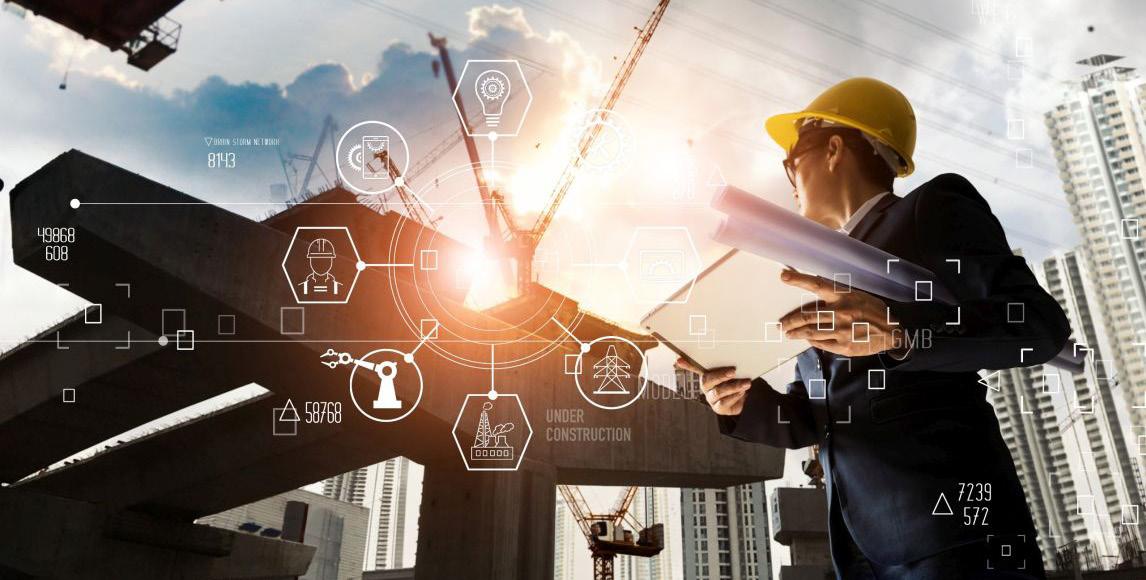
Edilizia 4.0 e Energie rinnovabili
Materiali innovativi, infissi ad elevate prestazioni, tecnologie per la produzione di energie rinnovabili e nuove tecniche costruttive per edifici sostenibili e sempre più standardizzati
Experience
L’innovazione è realizzata da chi sa fare. La Piazza “Experience” è dedicata a chi vuol far parte di quella élite di tecnici che dovrà guidare nei prossimi anni la transizione in senso digital e green. Una piazza in cui si parlerà di soluzioni e prodotti, concretamente, operativamente; un confronto tra esperti e pubblico col preciso obiettivo di sciogliere dubbi e perplessità e per conoscere da vicino gli strumenti dell’innovazione.
Mission
Per introdurre il nuovo, spesso, non è sufficiente saper fare, ma è necessario capire cosa sta succedendo nel proprio campo d’azione e in quelli complementari.
La Piazza dedicata alla “Mission” ha l’obiettivo di raccontare il presente, evidenziando le problematiche e suggerendo le soluzioni. Sotto i riflettori le norme vigenti e le buone pratiche che possono fare la differenza, indicando una strada da percorrere assieme. Vision
Senza strategia non si va da nessuna parte e un settore tutto orientato al futuro non può non avere una bussola.
Nella Piazza “Vision” presenteremo dati di mercato, riflessioni sull’ecosistema economico entro il quale ognuno opera, proposte innovative che aprono ad una visione di medio termine più chiara, per capire assieme dove stiamo andando, perché e come cambierà il nostro lavoro.


NUOVE TECNOLOGIE PER LA RICETTIVITÀ TURISTICA
14 novembre, Centro Congressi Fiera Levante
Le nuove tecnologie a supporto del concetto di qualità totale nel settore turistico alberghiero
Il mondo degli hotel e delle strutture turistico alberghiere in genere, costituisce uno dei settori economici più naturalmente interessati all’utilizzo delle nuove tecnologie applicate agli edifici e ai loro occupanti.
Il raggiungimento di standard elevati in tema di efficienza energetica, per esempio, non impatta solo sui costi di gestione in modo determinante, ma costituisce anche un fattore attrattivo per un pubblico sempre più attento alle questioni ambientali. Non di meno la qualità dell’entertainment garantito agli ospiti di un hotel è elemento distintivo, ancor più se parliamo di strutture destinate ad ospitare eventi e congressi.

MEDITERRANEAN DATA CENTER MEETING
15 novembre, Centro Congressi Fiera Levante
Digital&green: the twin transition opportunities
La Regione Puglia è nota per una elevatissima produzione di energia da fonti rinnovabili (eolico e solare in primis); dal punto di vista geologico è inoltre un territorio a bassissima sismicità, inoltre Bari è uno dei nodi fondamentali dell’infrastruttura digitale europea con le sue dorsali sottomarine nord-sud e est-ovest. Tutti questi elementi candidano naturalmente la Puglia ad essere una location ideale per i nuovi data center, garantendo loro un approvvigionamento sicuro di energia green in grado di rendere carbon neutral ed ecologicamente sostenibile una delle infrastrutture più energivore.
ASSEMBLEA SMART INSTALLER 2024
15 novembre, Centro Congressi Fiera Levante
Dalla formazione al business: la prima rete strutturata di professionisti dell’installazione in Italia Si riunisce a Bari per la prima volta la community degli Smart Installer, completamente rinnovata a seguito dall’alleanza siglata a Milano lo scorso novembre tra Pentastudio, CTA-Consorzio Tecnologie Avanzate e Smart Faber.
Una rete strutturata di quasi 250 imprese di installazione presenti su tutto il territorio nazionale, che hanno aderito al Consorzio CTA e hanno aderito al programma Smart Installer, che prevede un sistema centralizzato in grado di garantire la formazione continua degli associati e lo sviluppo di business attraverso un’attività mirata di marketing. L’assemblea sarà il momento per presentare ai potenziali stakeholder questa rete che si propone come “esemplare” a livello nazionale, garantendo standard qualitativi elevati al consumatore e servizi e benefit importanti ai suoi affiliati.


Present and future of Mediterranean cities 13 novembre, Aula Magna di Architettura del Politecnico di Bari 14 novembre, Nuova Fiera del Levante – Centro Congressi
La città intelligente – la Smart City: quell’insieme di strategie di operatività in tema di pianificazione urbanistica volte ad ottimizzare, migliorare e digitalizzare i servizi pubblici, in modo da mettere in relazione le infrastrutture materiali di una città con chi la abita e vive. Focus di una Smart City è la tecnologia, al servizio della comunicazione, dell’ambiente e della sostenibilità, dell’efficientamento energetico e utile al miglioramento della qualità della vita e delle esigenze di cittadini ma anche di imprese e istituzioni. Le infrastrutture, dunque, giocano un ruolo preponderante: dai materiali alla digitalizzazione. Di questo e molto altro si parlerà durante la due giorni della 3^ edizione della Bari Smart City Conference, in programma il 13 e 14 novembre. Sarà dunque un fondamentale momento di dibattito e di confronto sullo sviluppo sostenibile delle aree urbane che si affacciano sul Mediterraneo. Il tema sarà “Present and future of Mediterranean cities”, con focus su rivoluzione digitale, nature based solutions, ecosistemi urbani sostenibili e sull’approccio ESG nelle aree urbane.


PRESENT AND FUTURE OF MEDITERRANEAN CITIES
13 novembre 2024
Politecnico di Bari - Aula Magna Orabona i14 novembre 2024
Centro Congressi a Smart Building Levante
Integrazione internazionale
Protezione ambiente
Smart living
Mobilitazione
Opportunità di lavoro
Trasporti sostenibili
Geolocalizzazione Servizi pubblici e sociali
Produttività
Gestione sostenibile delle risorse Biodiversità
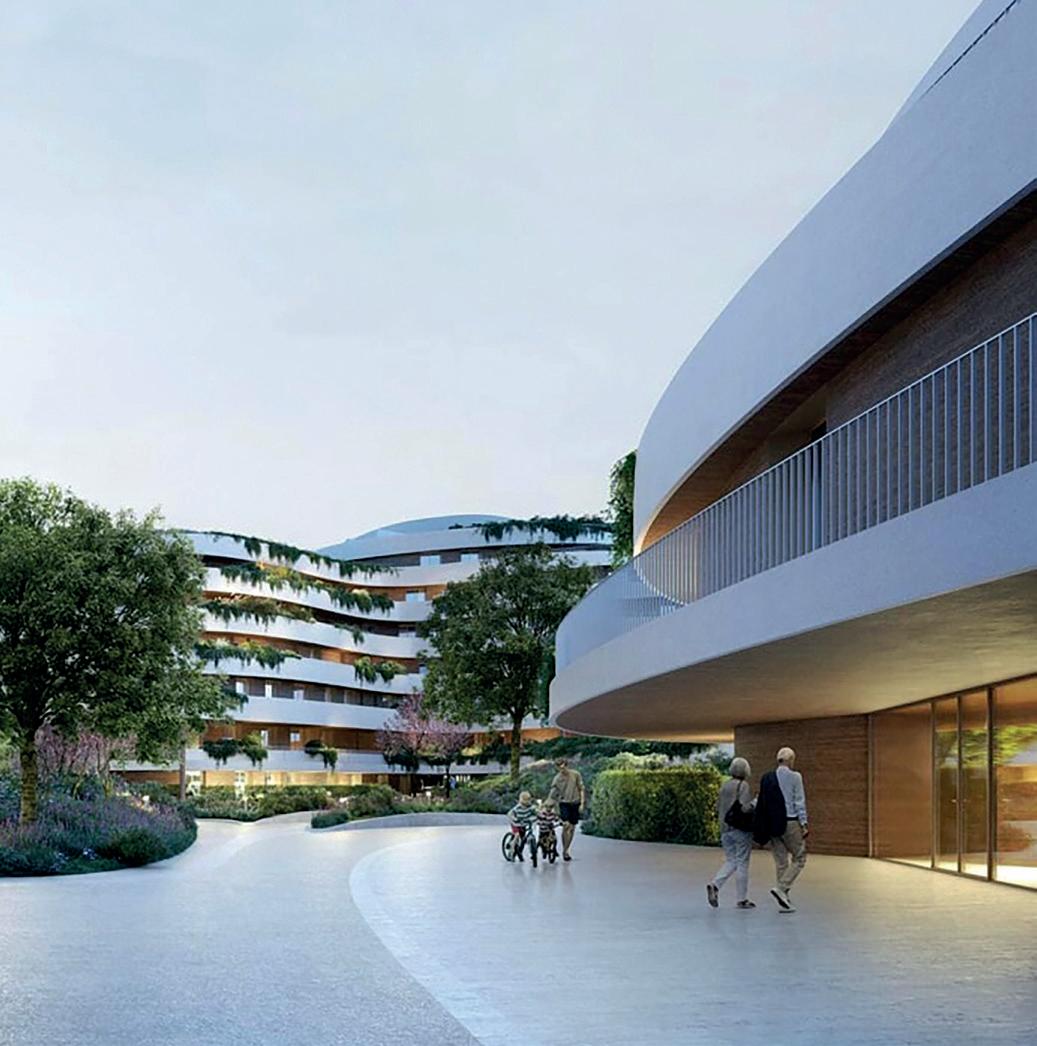
Sicurezza dei cittadini
Aumento del territorio Azioni locali
Coesione sociale
Geolocalizzazione
Imprenditorialità
Tecnologia mobile

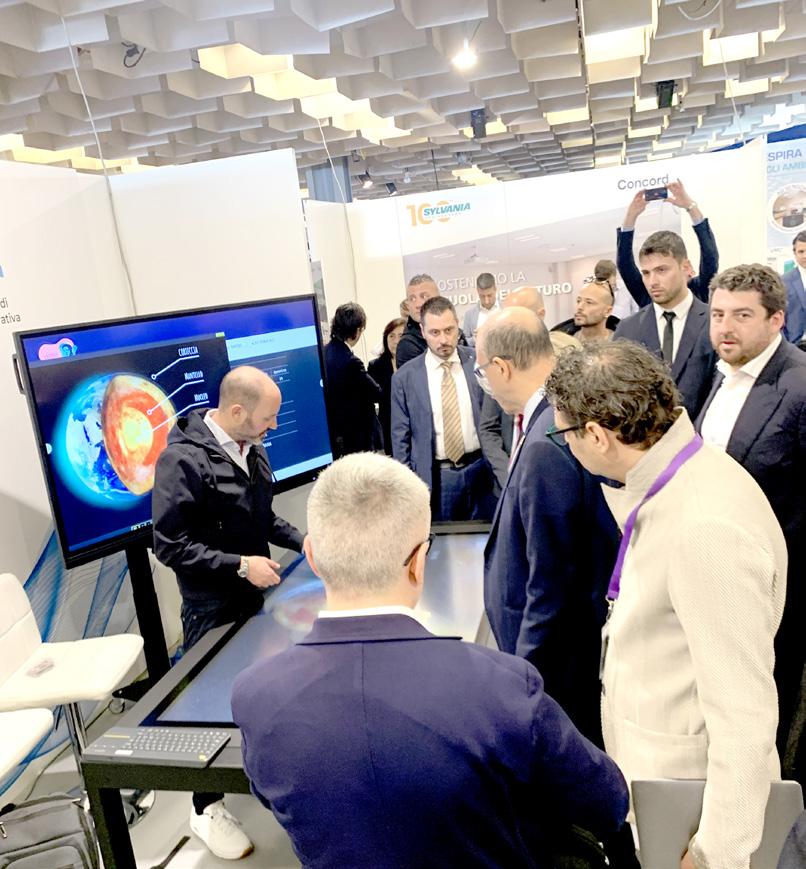

L'area espositiva di Smartbuilding.edu è suddivisa in vari settori, ciascuno dedicato a specifiche tecnologie:
• Mediazione culturale digitale e multimedialità: nuove soluzioni per migliorare l'interazione didattica.
• Infrastruttura digitale e connettività: reti e sistemi per una scuola sempre connessa.
• Gestione e controllo: piattaforme per il facility management.
• Lighting design: tecnologie per l'illuminazione efficiente.
• Efficienza energetica e autoproduzione: soluzioni per ridurre i consumi energetici.
• Sicurezza fisica e controllo accessi: sistemi per garantire la sicurezza di studenti e personale.
• Qualità dell'aria: tecnologie per monitorare e migliorare l'aria negli ambienti scolastici.

2024
Air Control, sanificazione dell’aria
Audiosales, distribuzione di sistemi multimediali
Aura Immersive, ambienti immersivi
Big Rock, accademia di formazione
H-Farm, campus, incubatore
Touchwindow, Ambienti digitali integrati Sylvania, mondo lighting
SimLab soft, software per realtà virtuale VirtuaPoint, software per lezioni immersive
SPONSOR TECNICI: Audiosales, Benq e Euromet

Chiara Benedettini
La fiera Didacta Italia 2024, che si è svolta a Firenze lo scorso marzo, ha visto il ritorno di Smartbuilding.edu. L'iniziativa, aveva l’obiettivo di fornire spunti e soluzioni per modernizzare gli edifici scolastici italiani, rendendoli più efficienti e inclusivi.
L’educazione è uno degli ambiti più importanti di applicazione delle tecnologie integrate, e proprio gli edifici scolastici possono beneficiare di interventi di risparmio energetico, gestione intelligente delle risorse, automazione, con un beneficio per tutta la comunità.
Situata al piano terra del Padiglione Spadolini, l'area Smartbuilding.edu è una iniziativa Smart Building Italia e Pentastudio e completamente rinnovata rispetto all’edizione 2023, è stato un punto di riferimento per insegnanti, dirigenti scolastici e tecnici. In particolare ha perseguito l'obiettivo di illustrare come le nuove tecnologie possano essere integrate nelle scuole per migliorarne l'efficienza energetica, la qualità dell'aria, la sicurezza e l'inclusività.
Tutte tematiche rappresentate dalle aziende che hanno animato l’area, ognuna “titolare” di una esclusiva merceologica: Air Control, Audiosales, Aura Immersive, Touch Window, Big Rock, H-Farm; sponsor tecnici, Benq e Euromet. Per il visitatore, quindi, SB.Edu è stata come una gallery di buone pratiche ed esempi delle migliori soluzioni tecnologiche per la scuola italiana. Con il Piano Nazionale di Ripresa e Resilienza (PNRR), infatti, l'Italia prevede di investire 1.19 miliardi di euro nella costruzione di 216 nuovi edifici scolastici e 4.9 miliardi per la riqualificazione di quelli esistenti. Questi fondi sono cruciali per modernizzare le scuole, migliorandone la sostenibilità e la funzionalità, a patto che rispondano alle reali esigenze del sistema scolastico.
Al centro dell’area espositiva è stata inoltre collocata una sala formativa dove, esperti del settore e rappresentanti delle aziende
partner, hanno tenuto brevi seminari su vari temi legati alle tecnologie per la scuola e in linea con i temi introdotti nell’area tramite la partecipazione degli espositori. I partecipanti hanno così potuto ricevere aggiornamenti e acquisire conoscenze pratiche da applicare nei propri Istituti. "Abbiamo progettato questa area espositiva per rappresentare una scuola ideale dal punto di vista tecnologico," ha spiegato Luca Baldin, direttore di Smart Building Italia. "Ogni azienda partecipante ha contribuito a creare un allestimento che ha mostrato concretamente come le tecnologie possono trasformare gli edifici scolastici."
Un focus sulla cittadinanza digitale e la sicurezza informatica
Durante la fiera, Smartbuilding.edu ha presentato anche una conferenza stampa con Aura Immersive nella quale sono stati presentati dati e progetti di MOIGE (Movimento Italiano Genitori): un’indagine sulla cittadinanza digitale degli studenti e i rischi legati alla cyber sicurezza, condotta in collaborazione con l'Istituto Piepoli. La ricerca ha sottolineato la necessità di educare gli studenti all’uso consapevole delle tecnologie digitali, e all’importante ruolo dei genitori nel percorso di consapevolezza dei minori.
L’inclusione come valore Audiosales oltre alla partecipazione al progetto SB.Edu, ha presentato il seminario Progettare ambienti formativi inclusivi all’interno del programma scientifico di Didacta, valido per la formazione insegnanti. L’architetto Giovanni del Zanna ha spiegato come concepire spazi per la formazione accessibili – in termini di spazi
ma anche di informazioni e servizi - per il maggior numero possibile di studenti, indipendentemente da fattori quali età, sesso e caratterisitche di disabilità, promuovendo l’inclusione. Donato Masci di Studio Sound Service ha proposto un focus sul legame tra percezione sonora/emozione/comprensione, nodo dell’inclusione in caso di sordi e ipoudenti. La sala, al completo, ha dimostrato grande entusiasmo, non solo insegnanti ma anche funzionari e progettisti di uffici tecnici e studi. L'azienda, nota per i suoi sistemi audio di alta qualità, ha presentato due marchi: Contacta, specializzato in sistemi audio a loop per ipoudenti, e Isinac, che offre pannelli fonoassorbenti per migliorare l'acustica degli ambienti.
Didacta Italia 2024
L'edizione 2024 di Didacta Italia ha registrato un'affluenza record con oltre 20mila visitatori, segnando un incremento significativo rispetto all'anno precedente. Con 1.780 eventi e 430 espositori, la fiera ha confermato il suo ruolo centrale nell'aggiornamento della filiera scolastica italiana. “Chiudiamo questa settima edizione di Didacta Italia con grande soddisfazione,” ha dichiarato Lorenzo Becattini, presidente di Firenze Fiera, alla fine della manifestazione. “L’altissima affluenza e l’atmosfera di grande energia tra i partecipanti ci spingono a continuare su questa strada. Siamo già al lavoro per i prossimi appuntamenti, tra cui la prima edizione in Puglia alla Fiera del Levante a Bari dal 16 al 18 ottobre e la prossima edizione nazionale a Firenze dal 12 al 14 marzo 2025.”
https://fieradidacta.indire.it

Girare per il Fuorisalone 2024, durante la Milano
Design Week, è stato come muoversi lungo un nastro di Moebius: dovunque si andasse, qualunque itinerario si seguisse, il binomio Tecnologia-Natura spuntava sempre fuori, anche se non sempre a proposito…

Sgombriamo subito il campo da un possibile equivoco: nonostante il velo di dubbio che abbiamo già espresso in apertura, il Fuorisalone resta un’esperienza estremamente positiva, e la Design Week è sempre, per Milano, un’occasione unica per brillare. Muoversi per la città seguendo un itinerario fatto di design e innovazione, infatti, è affascinante e coinvolgente, permette al Tempo di assumere una consistenza diversa, lo dilata e, in qualche misura, lo restringe anche, come se i giorni di Fuorisalone si offrissero ai visitatori come una splendida parentesi extra-temporale, un momento di sospensione in cui si scopre una Milano diversa e nuova, proiettata sul futuro eppure, allo stesso tempo, ben radicata nel presente.
Chiarito dunque che anche quest’anno il Fuorisalone è stato un appuntamento imprescindibile per chi ama design e innovazione tecnologica, andiamo a vedere un po’ più da vicino quali sono state le tematiche emerse in questa edizione, con qualche esempio pratico. Buon viaggio (sul nastro di Moebius) a tutti!
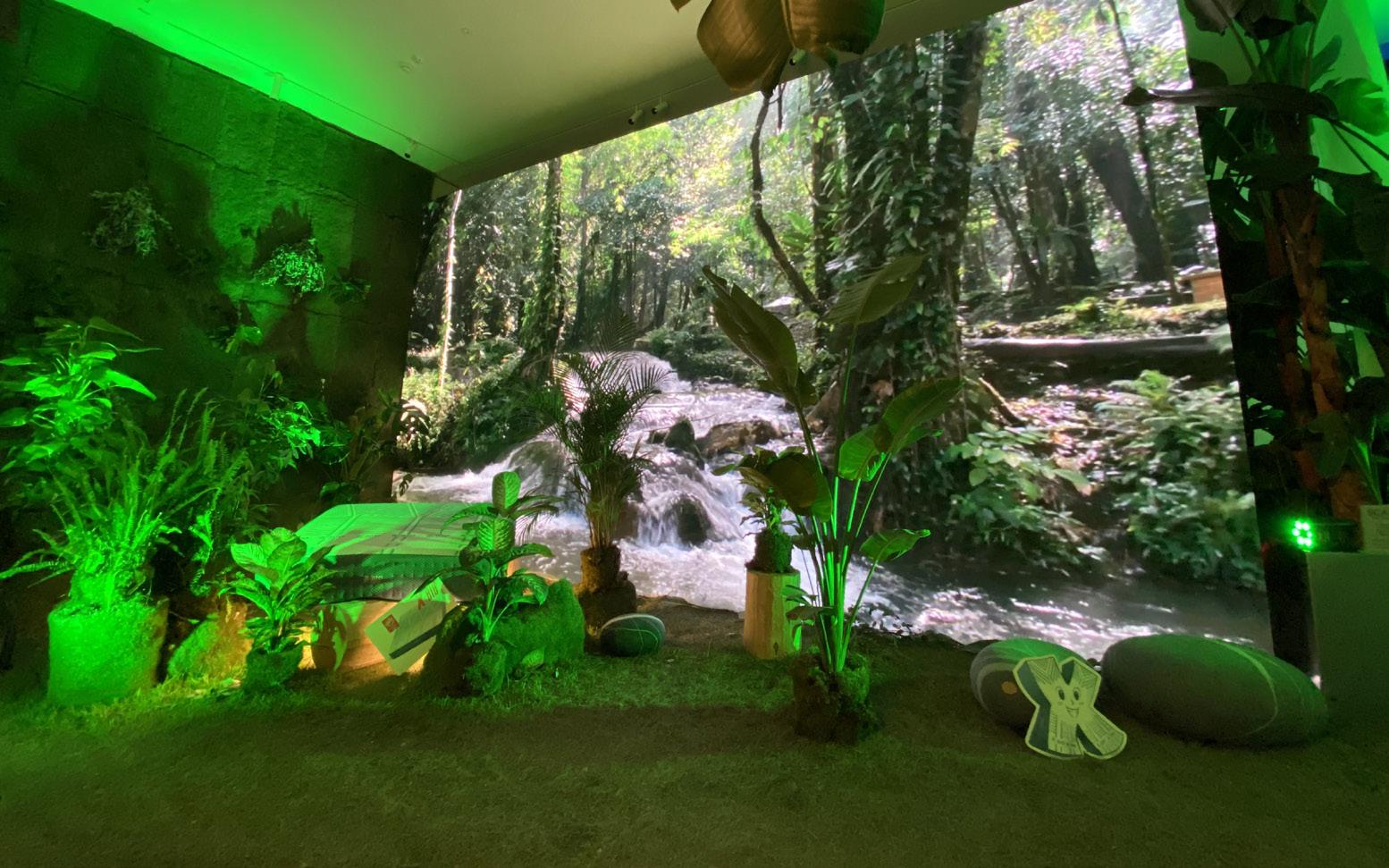
Materia e sostenibilità: una questione spirituale?


In una manifestazione da sempre nota per la sua varietà e per la quantità di punti di vista diversi che offre, quest’anno dobbiamo rilevare, al contrario, una certa compattezza, una unità d’intenti che, seppur in parte dettata dal tema scelto per la Design Week, è risultata a tratti un po’ stucchevole.
Si tende, infatti, nel mondo del design e della ricerca tecnologica, a concentrarsi molto sul concetto di sostenibilità, e molti progetti quest’anno si sono sforzati di approfondire il rapporto tra sostenibilità e materia, vedendo la prima come una virtuosa necessità e la seconda come una necessità tout court, qualcosa da cui il mondo umano non può prescindere, ogni oggetto, ogni edificio, ogni arredo è fatto di materia, noi stessi siamo materia, ma è come se il design targato Fuorisalone 2024 abbia voluto provare a spingersi verso la decisa riscoperta del lato spirituale, innegabile, dell’essere umano. L’idea, almeno all’apparenza, è che la spiritualità – dell’esistere, dell’abitare, del lavorare – abbia un maggiore grado di sostenibilità rispetto alla materia. Quindi, perché non coltivare maggiormente il lato spirituale dell’Uomo? Ecco dunque un fiorire (spesso letterale, vista l’insistenza su piante e alberi!) di installazioni tendenti a ‘riallineare’ le percezioni con un maggiore avvicinamento alla Natura intesa come ambiente incontaminato, da rispettare e far crescere e all’interno del quale crescere noi stessi, come
persone. Assumendo a volte il carattere di pura riflessione, come nelle interessanti installazioni ‘Materia Natura Conversazioni con Portanuova, in piazza Gae Aulenti, nel cuore della Milano più ‘green’, e ‘Materia in movimento’, curata da Seiko nello Spazio Formentini, a Brera. ‘Materia Natura’, del resto, era il tema portante, dichiarato, del Fuorisalone 2024. Ecco perché abbiamo deciso di iniziare il nostro percorso con le ‘Conversazioni con Portanuova’ di piazza Gae Aulenti, installazione immersiva composta da cinque video su altrettanti totem che definiscono uno spazio d’indagine sul rapporto tra uomo e ambiente, presentando diversi fattori di impatto dell’uomo sulla Natura e ponendo delle domande al visitatore. Niente domande, invece, ma moltissima attenzione ai quattro elementi fondanti della Natura – Terra, Aria, Acqua e Fuoco – nell’installazione ‘Matrex Natura’, che ha segnato il debutto di Buoninfante, azienda manifatturiera italiana nel settore materassi, al Fuorisalone. In Foro Buonaparte, l’azienda ha presentato la linea di materassi hi-tech X-BIO offrendo al visitatore un’esperienza immersiva grazie a delle proiezioni che avvolgevano il pubblico negli archetipi elementari della Natura, dai quali prende ispirazione la serie X-BIO, che punta proprio a unire Natura e Tecnologia. Un vero e proprio bosco di betulle è stato invece installato nel fascinoso Spazio Formentini, a Brera, dal celebre marchio di
orologi Seiko, a sottolineare ancora una volta il messaggio –forse un po’ abusato – della necessità a un ritorno alla Natura, e suggerendo un riallineamento delle nostre percezioni e dei nostri tempi di vita.
Forma, materia ed energia
In un Fuorisalone, come si è detto, dominato dal concetto di Natura e Materia, non sono mancate le riflessioni sulle forme che la materia può assumere, che è poi la base di ogni design. Sempre stimolante il distretto di via Tortona e via Savona, con una molteplicità di proposte tutte, in un modo o nell’altro, molto centrate tematicamente, dai vetri architettonici fotovoltaici di Onyx Solar alle Nature’s Canvas di Corian Design, esperienza immersiva che presenta una nuova collezione di colori e una gamma di estetiche ispirate alla natura, dalle scogliere alle acque fluenti, dalla vegetazione al terreno naturale.
E ancora, l’interessante ‘dOT – design Out Taste’, in una piazza San Marco trasformata in ‘mosaico di proposte per l’abitare fluido tra interni ed esterni.’ Proprio la mescolanza e, a tratti, la (voluta) confusione di interno ed esterno, come concetto, è parso emergere con una certa chiarezza dall’edizione 2024 del Fuorisalone, in molteplici installazioni, compresa la ‘Cross Vision’ allestita nel cortile dell’Università Statale, caleidoscopio Un



Bruma: tradizione e innovazione, il vetro artigianale incontra la tecnologia della luce
di proposte di design per il presente e il futuro, intersezioni azzardate di forme e materia che sembrano porre quesiti più che fornire risposte, suggerire possibili strade senza però imboccarne realmente nessuna.
Ma forse, dopotutto, è proprio questo uno degli scopi di una manifestazione come la Design Week: fornire suggestioni, spunti, idee anche allo stato grezzo.
Il Tempo farà la sua parte e ci dirà che cosa si realizzerà e che cosa no. Merita menzione, però, la curiosa iniziativa intitolata ‘Il Migliore Spreco’ (The Best Waste): in via Verdi, subito dietro il teatro Alla Scala, la coreana Peelsphere si è lanciata in un generoso e concreto tentativo di innovazione sostenibile, presentando una collezione di oggetti e indumenti (dalle scarpe ai foulard alle giacche) basati su biomateriali innovativi: alghe, bucce di frutta e caffè vengono infatti utilizzati come base materica per

la fabbricazione dei prodotti, di cui arrivano a costituire anche il 30-35%. Estetica e ridefinizione dei materiali sono qui tangibili e toccabili letteralmente con mano.
La luce come parte integrante del design
Presenza classica al Fuorisalone, la luce è stata protagonista anche quest’anno, con diverse installazioni molto interessanti. Se Re/Creation è l’installazione di gran lunga più affascinante, nella cornice di Palazzo Isimbardi, e ha il merito di concentrare l’attenzione del visitatore sull’utilizzo del vetro fuso, ridefinendo il rapporto tra vetro e architettura con le interessanti creazioni di Lasvit, non vanno trascurate le stimolanti ‘Shapes of lights’ e ‘The Light You Are’, entrambe by Masiero, nel cuore di Brera, e soprattutto ‘Bruma’, nella centralissima via San Maurilio, nuova collezione firmata Giopato di luci realizzate con vetro artigianale,


anzi, proposta di luce che incontra il vetro artigianale, con effetti – in questo caso – realmente capaci di avvicinare tecnologia e natura, o quantomeno di sposare capacità tecnologiche e abilità umane.
La proposta di Masiero, invece, si è articolata su due diverse installazioni, in location a poca distanza una dall’altra, nel Brera District. Due installazioni pensate per presentare le nuove collezioni, realizzate dallo studio MILO esplicitamente per il Fuorisalone 2024. ‘The Light You Are’ sottolinea la capacità di Masiero
di proporre in catalogo un’ampia gamma di luci, diverse per design, materiali e tipologie, progettate con stile volutamente trasversale, nonché la capacità del brand di realizzare progetti di illuminazione personalizzati.
‘The Shapes of Lights’ ha proposto elementi geometrici ritmati e leggeri, un modo di ‘disegnare’ con la luce innovativo e classico al tempo stesso, nella piena consapevolezza che la luce è a tutti gli effetti un elemento di design e, a dispetto della sua duplice natura, corpuscolare e ondulatoria, una ‘materia’ da usare e plasmare.


La mobilità sostenibile: una presenza imprescindibile
In virtù del tema di quest’anno del Fuorisalone, tutto incentrato sul rapporto tra Materia e Natura, ma anche sul tema della sostenibilità ambientale, non potevano mancare alla kermesse milanese i grandi marchi automobilistici, che non a caso già da diverse edizioni approfittano di questo palcoscenico per presentare i prototipi del futuro o per stimolare e arricchire la discussione circa la mobilità sostenibile. Quest’anno, più ancora che nei precedenti, non si sono viste soltanto vetture elettriche, bensì vere e proprie sperimentazioni di design e materiali
Al solito, protagonista il marchio Audi, che ha ripresentato la sua ‘House of Progress’ negli spazi del Portrait dell’elegante Corso Venezia, magniloquente installazione curata dallo studio internazionale Big – Bjarke Ingels Group e pensata per esaltare il valore dell’avanguardia nel mondo della mobilità. Inoltre, la celebre casa automobilistica ha presentato in anteprima mondiale la nuova Audi Q6 e-tron, primo modello basato sulla nuova architettura Premium Platform Electric.
Interessante anche l’esposizione di Ducati, che ha debuttato al

Fuorisalone con una mostra (al Museo Nazionale della Scienza e della Tecnologia ‘Leonardo da Vinci’) dal titolo ‘Forma – Feelings designed by Ducati’. La ricerca della combinazione tra bellezza, emozioni e tecnologia ha portato il concetto stesso di motocicletta su un piano più artistico che tecnologico.
Anche il marchio catalano Cupra si è concentrato sull’esaltazione della materia di cui è fatta un’auto, con proposte innovative e affascinanti nella location centralissima di Corso Como. Intitolata ‘The rebel side of design’, l’esposizione di Cupra ha il suo punto di forza nella Dark Rebel, concept car creata anche grazie al contributo dei fan del brand ed esposta in piazza XXV Aprile, proprio di fronte alla showroom aziendale.
Anche BMW, infine, si proietta sul futuro con ‘Future of Joy by BMW’, nella showroom di via Montenapoleone, in pieno Quadrilatero della Moda, ponendo attenzione ai segreti del design automobilistico e focus particolare sulla nuova berlina sportiva BMW Vision Neue Klasse, ovviamente elettrica, digitale e sostenibile. Ma per concludere, permetteteci un patriottico (ma meritatissimo) cenno a Italdesign, con ‘Asso di Picche in Movimento’, in via Tortona: anteprima mondiale che espone i principi della nuova design philosophy aziendale, con un modello di concept car in scala reale che ha celebrato i cinquant’anni del prototipo di
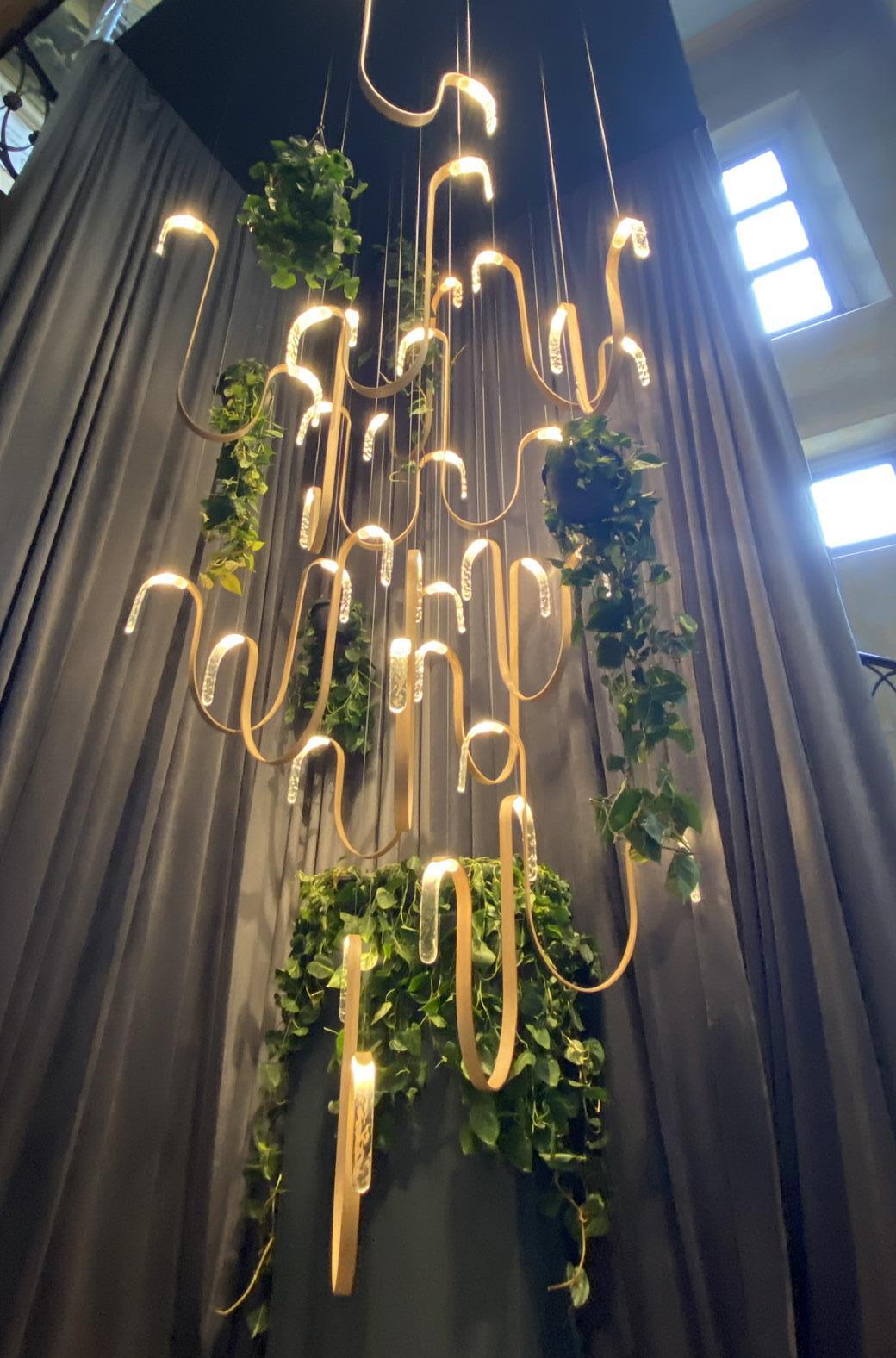
Re/Creation: vetro fuso e giochi di luce per un design sostenibile
Italdesign Asso di Picche, presentato nel lontano 1973 al Salone dell’Automobile di Francoforte. Questo per dire che, nonostante le tante visioni avveniristiche, anche dal passato il design ci parla e può influenzare la ricerca contemporanea e la sostenibilità, anche grazie alla scelta di nuovi materiali ecosostenibili.
Ovunque e in nessun
Insomma, il Fuorisalone di quest’anno è stato letteralmente dominato da un tema, cosa che - francamente - non è accaduta tutti gli anni, in tutte le edizioni di questa splendida manifestazione, che richiama a Milano visitatori da ogni parte del mondo. Pur non trovando sbagliato che così tante aziende e così tanti marchi abbiano scelto di investire su tematiche tanto connesse al futuro e all’ambiente, non possiamo che rilevare quanto la monotematicità sia apparsa fin eccessiva, come se in fondo più che le novità tecnologiche in sé, ai brand interessasse sollevare la problematica, far parlare di sostenibilità e di ambiente, e questo tanto sbandierato ritorno alla Natura, in certi casi, non ha mancato di apparirci sinceramente un po’ pretestuoso, capace, più che di generare confronto e discussione, di far somigliare una all’altra un po’ tutte le installazioni.
Ecco perché abbiamo parlato di un Nastro di Moebius, quella figura topologica nella quale, misteriosamente, è possibile cambiare faccia lungo un percorso chiuso senza accorgersene, senza che sia possibile stabilire su quale lato ci si sta muovendo. Muoversi all’interno del Fuorisalone, quest’anno, è stato un po’ come scivolare su una superficie liscia e sempre uguale, in un’armonia d’intenti certo ammirevole ma non sempre capace d’entusiasmare e di accendere l’interesse.
Lo diciamo sottovoce, ma lo diciamo: forse è mancato un pizzico di sana provocazione in più! Appuntamento all’anno prossimo!




Indubbiamente i viaggi stampa consentono di vivere una esperienza diretta e di farsi una impressione in prima persona attraverso un accesso privilegiato alle informazioni e, anche, di creare relazioni di cordialità con colleghi e aziende. Si, il viaggio stampa con Harman Professional Solutions che si è svolto tra il 23 e il 25 aprile per visitare il sito produttivo di Martin a Pécs in Ungheria, è stato tutto questo


Indubbiamente i viaggi stampa permettono di vivere un'esperienza diretta e creare relazioni cordiali. Il viaggio con Harman Professional Solutions a Pécs, Ungheria, dal 23 al 25 aprile, è stato tutto questo.
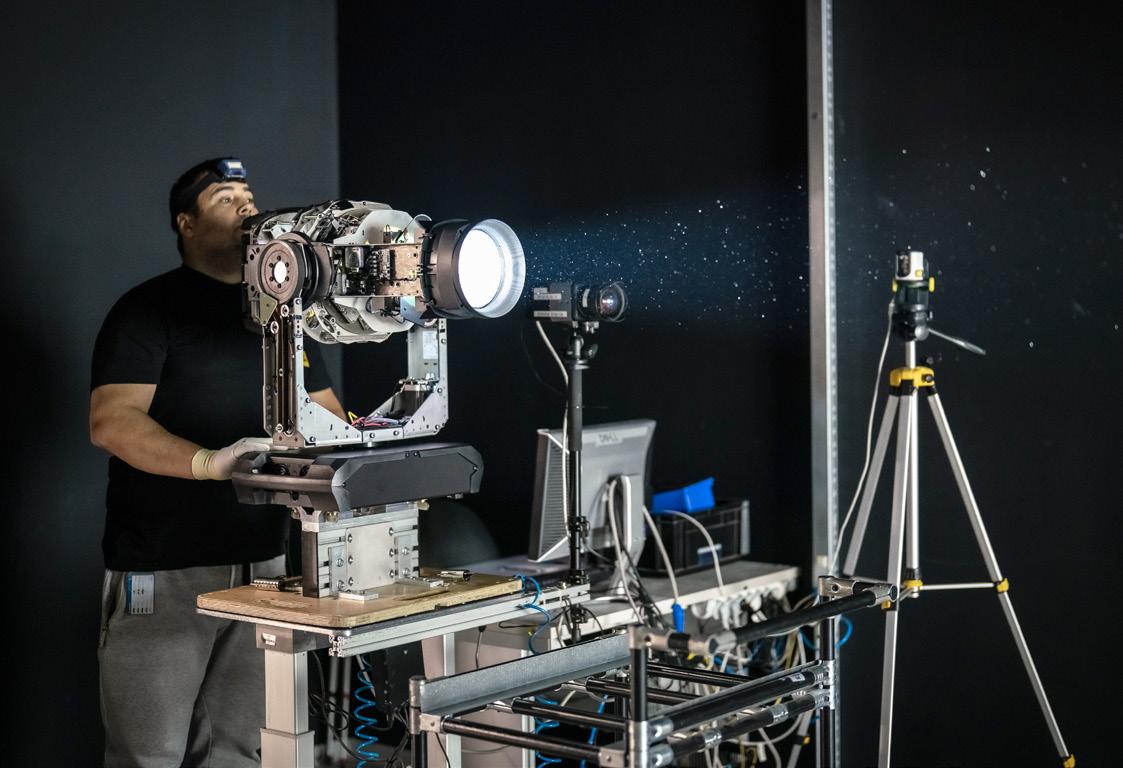

L’itinerario ha previsto l’arrivo dei giornalisti a Budapest nella mattina del 23 aprile, seguito da un lungo viaggio in bus tra boschi e campi verso Pécs che ci ha anche consentito di conoscerci meglio con gli atri colleghi, una decina, provenienti dalle redazioni di mezza Europa e dagli Stati Uniti. Nelle ore di viaggio abbiamo anche parlato un po’ con David Glaubke, Director, Global Corporate Communication di Harman, che ci ha accolto e accompagnato durante tutto il viaggio.
A Pécs ci ero già stata molti anni fa, e l’ho trovata molto cambiata: l’impressione di una piccola città di provincia ha lasciato il passo alla sensazione di città nuova, moderna, vivace, giusto preludio alla visita della mattina successiva alla fabbrica di Martin Lighting. Primo step, una esaustiva presentazione a cura delle tre persone che ci hanno accompagnato: Ben Payne Sales Director, Lighting – EMEA, sui temi aziendali e strategici della produzione, Henrik Kristensen Product Manager, Stage Lighting, coinvolto nella produzione Martin da quasi 30 anni, e András Dobre, Senior
Manager, Production and Process Engineering, referente per il sito produttivo.
Un po’ di teoria
La presentazione è stata utile per mettere a fuoco l’evoluzione delle produzioni Martin Lighting, e anticipare alcuni dei temi con cui saremmo entrati in contatto di lì a poco: la lunga storia del marchio, acquisito da Harman nel 2013, il design totalmente in house, la vocazione altamente tecnologica con l’impiego di oltre 70 ingegneri nei due uffici R&D di Aarhus (in Danimarca, negli storici headquarter) e di Shenzhen, le fasi del design e della realizzazione dei prodotti, tutti sotto la lente di un meticoloso check – oltre 70 tra misurazioni e analisi - che parte dall’ispezione della componentistica in arrivo, per passare alle parti mobili, all’elettronica e che termina solo, forse, con il test prima a tappeto e poi a campione dei prodotti ormai pronti. I vari siti produttivi di Harman Group si dividono tra Messico, Brasile, India, Cina e, naturalmente Ungheria.
Ma come nasce un prodotto in Martin? Ci risponde Ben Payne: “Naturalmente

dall’ascolto costante delle necessità del mercato: dal dialogo con i nostri clienti e partner, frequentando incontri internazionali e fiere... è un lavoro continuativo.”
Un’altra domanda importante è venuta dalla platea dei giornalisti: “Perché avete aperto qui una fabbrica?”
Nel 2015 Harman aveva già deciso di spostare a Pécs la fabbrica di Frederikshavn, ma è nel 2023 che ha inaugurato la struttura che abbiamo visitato; in precedenza la produzione era in uno spazio condiviso con il settore automotive dell’azienda, ma la necessità di ampliare le capacità produttive per il marchio Martin e specialmente per Mac One e l’ancora da venire Mac Viper XIP ha guidato il trasferimento. D’altronde l’azienda aveva già in questa regione contatti, fornitori e un indotto fertile, senza dimenticare le motivazioni di carattere ambientale; la struttura è infatti climatizzata con energia geotermica, du-
rante il 2024 la fornitura elettrica verrà interamente affidata ai pannelli solari, e da qui al 2040 aspira a divenire carbon neutral. Motivazioni non secondarie per un’azienda che ha da poco pubblicato il suo Sustainability Report.
Entriamo in fabbrica E in effetti l’impressione ricevuta dalla visita è proprio di un luogo organizzato, efficiente, all’avanguardia non solo nella produzione ma anche nei molti aspetti che la affiancano: spedizioni, gestione del magazzino, movimentazione dei materiali, imballaggi ecc. Ci viene infatti spiegato che tutto è organizzato per razionalizzare al massimo le operazioni, mantenendo alti quegli standard di accuratezza che saranno garanzia per l’obiettivo ultimo: prodotti conformi alla qualità del marchio, in linea con gli standard, ma anche a “prova di reso”. Dopo aver indossato camici bianchi

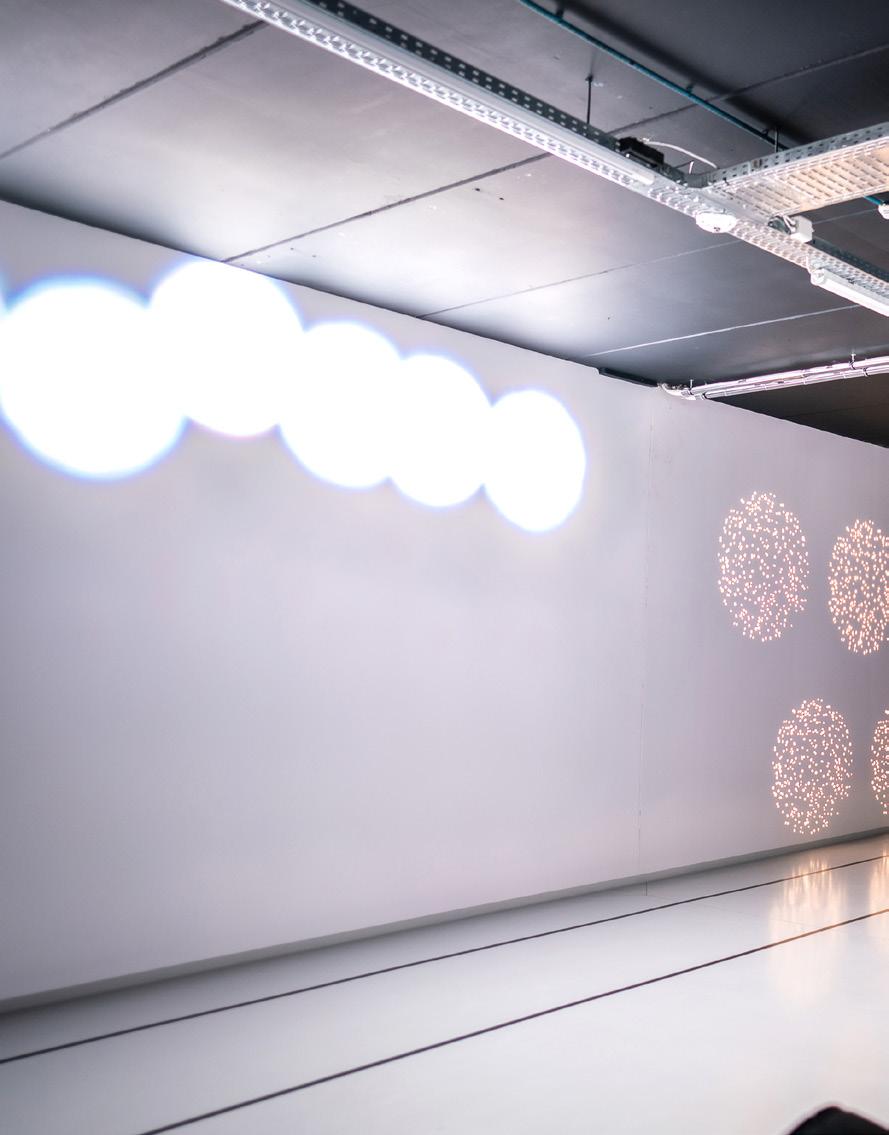


e passato i tornelli di sicurezza, la visita si è svolta percorrendo oltre 20 tappe, per vedere tutti gli step della produzione dei conosciuti MAC One (lanciati appunto nel 2023) e dei recentissimi Viper: dal rigore del magazzino alla suddivisione in aree produttive - montaggio di parti metalliche, sistemazione delle elettroniche, collocamento delle ottiche, ruote ed effetti di colore ecc. - all’organizzazione inappuntabile delle postazioni di lavoro, organizzate in serie con razionalità in modo che avvitatori, saldatori, componenti e materiali risultino a portata di mano. Non mancano le sale ristoro, ad ogni piano, a creare delle aree per la socialità tra colleghi.
É facile trovare manodopera specializzata per un lavoro tanto specifico? “Riceviamo sempre un buon numero di candidature – ci spiega Henrik Kristensen - e ci occupiamo direttamente della formazione.
Di solito i nuovi arrivati partono da incarichi più semplici e, passato un determinato tempo, vengono spostati verso altri reparti, non senza aver sostenuto un esame per accedere al livello successivo.
Anche questa mattina abbiamo avuto degli esami. Investiamo direttamente nelle nostre persone, e di solito restano volentieri con noi, il lavoro è vario e valorizzato”. Tra le ultime tappe visitate, il laboratorio per il check finale delle performance per valutare, sia attraverso strumenti e misurazione, che tramite l’osservazione empirica da parte di personale specializzato, l’uniformità dell’emissione luminosa, la
precisione di effetti e colori, delle grafiche, fino alla valutazione del braccio meccanico, sottoposto a uno rigoroso “stress test”. Avviandosi verso l’uscita, ecco la sezione imballaggio, dove si sperimentano nuove soluzioni sia per i flight case che per il trasporto classico: alloggiamenti sagomati in cartone pressato, ma anche schiuma espansa e soluzioni più possibile sostenibili. Ultimo step, la spedizione, che può essere indirizzata sia direttamente ai clienti o ai distributori, oppure verso i due magazzini di smistamento a livello globale situati in Danimarca e in California.
Verso casa
Son passate tre ore e il tempo è volato… ritornati nella hall principale e dismessi i camici, rifocillati dall’ottima ospitalità Harman, il nostro bus ci ha riportati a Budapest, molti di noi già intenti a fissare
appunti o note della visita della mattinata. Durante il viaggio non sono mancate due parole con David Glaubke: “Questo viaggio è stato un grande impegno logistico, e siamo felici di essere qui: la fabbrica di Pécs è un fiore all’occhiello per noi, ha significato grandi investimenti in termini di innovazione, produttività, ma anche scelte green in linea con le direttive aziendali. E poi è stato un piacere ritrovarsi con molti di voi che ho l’occasione di vedere, e spesso molto velocemente, solo durante le fiere”. Da parte nostra, un ringraziamento ad Harman Professional Solutions che ha voluto invitare Connessioni a questa interessante esperienza, ed è stato effettivamente come nelle premesse: l’occasione di approfondire, capire, discutere vis a vis con le persone e ricevere informazioni di prima mano è impagabile. Alla prossima!
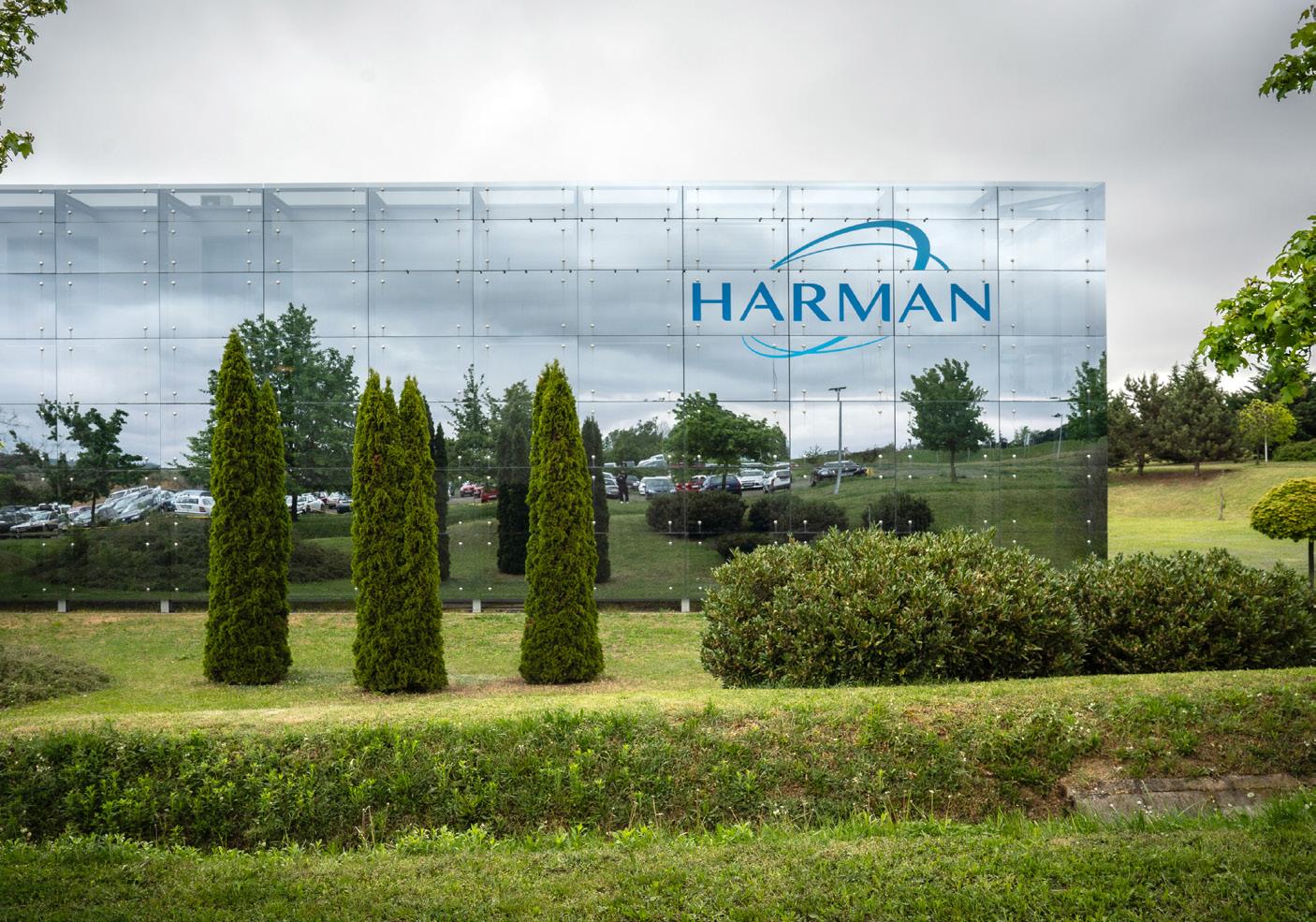
Martin Professional (Harman Professional Denmark ApS) è un produttore e distributore danese di luci per eventi, applicazioni architetturali ed effetti speciali con sede ad Aarhus, in Danimarca.
Fondata nel 1986, nel 2001 è stata acquisita dalla società industriale danese Schouw, che aveva ampliato la produzione con una nuova fabbrica a Frederikshavn ed esternalizzato parte della produzione in Cina presso Zhuhai. Il trend positivo è stato mitigato dalla crisi del 2008, durante la quale Martin ha reagito applicando le tecnologie LED ai propri prodotti e dando così vita a MAC 350 Entour, MAC Aura e MAC Viper.
Nel 2013 Harman International Industries ha completato l'acquisizione di Martin da Schouw, rilanciando l’azienda, mettendo l’illuminazione al centro del busines (la gamma di controller M-Series è stata ceduta a Elation) e dando vita, tra gli altri, alla serie MAC Ultra, MAC Aura XIP, e a nuove soluzioni per l’architetturale tra cui le barre LED Exterior Linear Pro. www.martin.com/en

IIn questo articolo renderemo un omaggio al mondo in costante evoluzione
delle produzioni virtuali
passi avanti nell'industria cinematografica sono strettamente legati ai progressi tecnologici. Quindi, non sorprende che la tecnologia abbia profondamente influenzato la produzione cinematografica, dalla pre-produzione alla post-produzione. In questo articolo, rendiamo omaggio al mondo in continua evoluzione della produzione virtuale, guardando da dove è partito, dove si trova oggi e come potrebbe essere il suo futuro.
Il passato della Produzione Virtuale
La produzione virtuale è stata al centro delle conversazioni nell'industria cinematografica per un paio di anni ma, come tutte le tecnologie, non è semplicemente apparsa dal nulla durante la notte.
Seguiamo i passi che ci hanno portato a opere come The Mandalorian e altro ancora. La produzione virtuale è un termine generico che include una vasta gamma di tecniche, tra cui il motion capture, i green screen, i LED, la previsualizzazione e qualsiasi produzione di contenuti con grafica computerizzata 3D tracciata ecc., tecniche che hanno guidato il progresso nella produzione cinematografica fin dalla sua origine. Riprendere gli attori contro un grande schermo LED che mostra luoghi lontani o inesistenti ha le sue radici nelle tecniche di proiezione frontale e posteriore. Queste tecniche di proiezione cercavano di ricreare atmosfere con una proiezione, metre il luogo e gli attori venivano registrati in tempi diversi. La tecnologia del chroma key, comunemente nota come tecnologia del fondale blu e verde, ha guadagnato popolarità intorno agli anni '30. Inizialmente, i registi usavano fondali blu invece che verdi, poiché il blu era più utilizzato nella produzione televisiva.
Col passare del tempo, i fondali verdi hanno gradualmente sostituito la maggior parte dei fondali blu ad Hollywood.
Agli albori della produzione cinematografica questi fondali venivano spesso utiliz-
zati per produrre Matte1 (o maschere, in italiano) poi utilizzate per combinare due scene diverse. Ad esempio, l'esperto di effetti speciali Larry Butler utilizzò la tecnica del "fondo blu con maschera mobile" in Il ladro di Bagdad (1940)e, negli anni, i green screen hanno incluso molte altre tecniche. Ma il problema dei fondali blu e verdi è che riflettono i colori sugli attori e, nella maggior parte dei casi, è necessaria un'illuminazione molto accurata e una lunga lavorazione in post-produzione per eliminare questi riflessi. Inoltre, la produzione virtuale basata sulla grafica computerizzata non è nuova.
L'uso precoce del CGI2 può essere visto in film come Tron (1982) e Abyss (1989), dove gli elementi generati al computer sono stati combinati con riprese dal vivo. Tuttavia, questa pratica ha cominciato a prendere forma negli anni 2000 con la diffusione degli strumenti digitali per la produzione cinematografica.
La Produzione Virtuale oggi
Attualmente, il grande trend nella produzione virtuale è l'uso del LED. La tecnica combina l'animazione in tempo reale utilizzando Unreal Engine, schermi LED e telecamere tracciate per fornire riprese degli effetti visivi in tempo reale e in camera. Unreal Engine ha permesso una grande innovazione specialmente per gli sfondi CG renderizzati in tempo reale e fotorealistici.
Se avete visto The Mandalorian avete già potuto sperimentare la potenza degli effetti visivi in camera utilizzando volumi LED e produzione virtuale in azione. Molte altre serie e film hanno seguito l'esempio. Grazie all'evoluzione della tecnologia gli attori di oggi si esibiscono sullo sfondo di un LEDwall - sostituendo il famoso green screen - che mostra l'ambiente virtuale, generato e manipolato in tempo reale dal team di produzione. Gli attori invece di esibirsi in luoghi reali o davanti a green screen si esibiscono davanti a un grande muro di pannelli LED che rirporduce sfondi animati, rispondendo al movimento della telecamera. Molte recenti produzioni importanti sono state riconfigurate per essere parzialmente o interamente girate con i LEDwall compresi Star Trek: Discovery, Thor: Love and Thunder e Bullet Train
La tecnica consente ai registi di regolare l'illuminazione, gli angoli di ripresa e molti altri elementi del set e della produzione, dando loro maggior controllo sul processo creativo. In definitiva, il progresso della produzione virtuale offre ai registi una maggiore libertà nel realizzare le proprie visioni artistiche.
Il futuro della Produzione Virtuale
La produzione virtuale potrebbe evolvere in mille modi (e lo sta già facendo) nel prossimo futuro. I progressi nella tecnologia probabilmente renderanno la produzione
virtuale più integrata con altre tecniche cinematografiche, le tendenze che plasmeranno il suo futuro includono il rendering in tempo reale, l'espansione in generi diversi e strumenti più accessibili.
Di conseguenza, la produzione virtuale permetterà ai registi di realizzare progetti più innovativi e creativi, offrendo una maggiore flessibilità ed efficienza nel processo produttivo. Il futuro appare luminoso anche per i registi indipendenti. La produzione virtuale non è limitata solo alle grandi produzioni di Hollywood: ha reso più facile lavorare con budget più piccoli producendo risultati sorprendenti, cosicché molti registi indipendenti hanno iniziato a esplorare e adottare questa tecnologia.
Con l'evoluzione della tecnologia, anche il coinvolgimento dell'intelligenza artificiale nella produzione video sta rivoluzionando la creazione e l'editing dei video, spingendo i limiti della creatività e della narrazione visiva. Cosa pensi che riserva il futuro della produzione virtuale?
www.avixa.org/


1. Matte painting - Una tecnica utilizzata
che viene quindi combinato con i personaggi o gli oggetti reali durante la fase di post-produzione.
2. CGI - Acronimo di "Computer Generated Imagery" (immagini generate al computer) ed è
tradizionali.
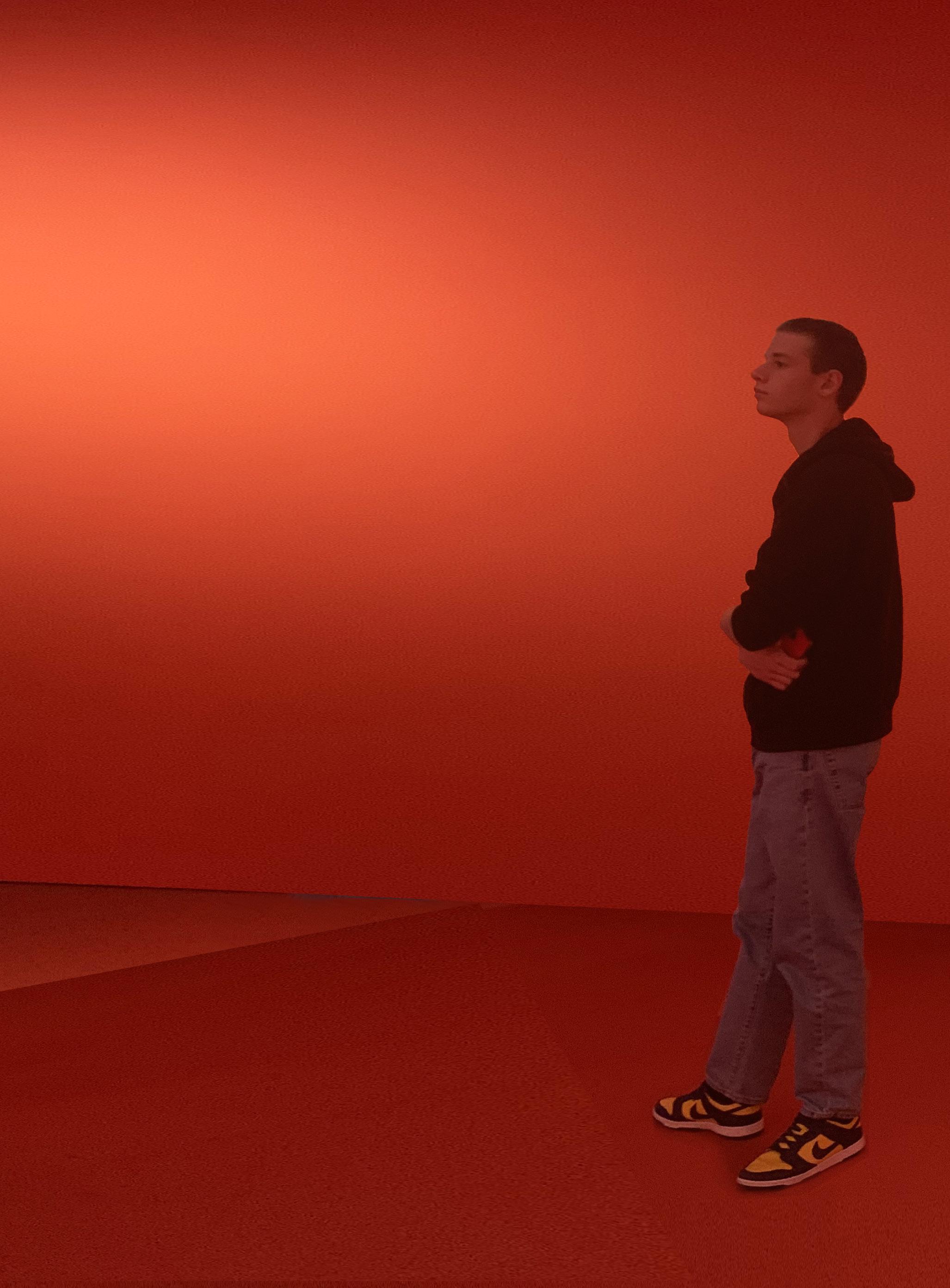
ARTIFICIALE UN FUTURO DI INNOVAZIONE E OPPORTUNITÀ
IN UN RECENTE ARTICOLO APPARSO SU LA STAMPA, VINCENZO LATRONICO HA EVIDENZIATO UN NUOVO SERVIZIO DI GOOGLE CHE METTE A DISPOSIZIONE DEGLI UTENTI
UN'INTELLIGENZA ARTIFICIALE (IA). QUESTA INNOVAZIONE HA SUBITO STIMOLATO LA CREATIVITÀ DELLE PERSONE, CON SUGGERIMENTI FANTASIOSI E A VOLTE DIVERTENTI, COME AGGIUNGERE COLLA LIQUIDA AL FORMAGGIO PER RENDERE LA PIZZA PIÙ "FILANTE" O INTEGRARE LA DIETA GIORNALIERA CON UN SASSOLINO. LATRONICO SPIEGA CHE
I MODELLI LINGUISTICI ALLA BASE DI QUESTE TECNOLOGIE SONO IN GRADO DI RACCOGLIERE UNA VASTA GAMMA DI INFORMAZIONI DALLA RETE, DIMOSTRANDO COSÌ L'AMPIA
CAPACITÀ DI APPRENDIMENTO DELLE IA. IL LIBRO "TEORIA LETTERARIA PER ROBOT" DI DENNIS YI TENEN, ANALIZZATO DA LATRONICO, ESPLORA IL CONNUBIO AFFASCINANTE TRA LINGUAGGIO E TECNOLOGIA. TENEN, EX-PROGRAMMATORE E STUDIOSO DI LETTERATURE COMPARATE, SOTTOLINEA COME L'INTELLIGENZA UMANA SIA SEMPRE STATA ALLA BASE
DELLE TECNOLOGIE CHE CREIAMO. QUESTO IMPLICA CHE L'INTELLIGENZA ARTIFICIALE È
UN RIFLESSO DELLA NOSTRA CREATIVITÀ E CULTURA. I RISULTATI PRODOTTI DALL'IA SONO
STRAORDINARI NON SOLO PER LA QUALITÀ, MA ANCHE PER LA QUANTITÀ DI DATI CHE
POSSONO GESTIRE. L'EFFICIENZA CHE L'IA PUÒ OFFRIRE È NOTEVOLE, CONSENTENDO RISPARMI SIGNIFICATIVI IN VARI AMBITI. LATRONICO OSSERVA CHE L'IMPATTO DELL'IA NON È SOLO TECNICO O FILOSOFICO, MA ANCHE POLITICO ED ECONOMICO, POICHÉ HA
IL POTENZIALE DI TRASFORMARE RADICALMENTE IL MERCATO DEL LAVORO DIGITALE. RIFLETTENDO PIÙ A FONDO, LATRONICO SI CHIEDE SE I SISTEMI PROGETTATI PER RENDERE PIÙ EFFICIENTE LA COMUNICAZIONE ABBIANO EFFETTIVAMENTE MODIFICATO ALCUNI
SUOI ASPETTI. LE PRIME FORME DI SCRITTURA, AD ESEMPIO, HANNO RIVOLUZIONATO UNA CULTURA PREVALENTEMENTE ORALE, RENDENDO I CONTENUTI PIÙ STABILI E RIGOROSI. IN "ORALITÀ E SCRITTURA", WALTER J. ONG DIMOSTRA CHE LA SCRITTURA HA TRASFORMATO PROFONDAMENTE LA MENTE UMANA, INTRODUCENDO IL PENSIERO LOGICO-ANALITICO.
JEAN BAUDRILLARD, NEL SUO CONCETTO DI "POST-MODERNO", EVIDENZIA COME L'IMMERSIONE NEGLI UNIVERSI VIRTUALI POSSA PORTARE A UNA FUSIONE CON LA REALTÀ
DIGITALE, ELIMINANDO LE CONTRADDIZIONI TIPICHE DELLA VITA REALE. ANCHE BARICCO RIFLETTE SU QUESTO, SOTTOLINEANDO COME LE IMMAGINI PURE E TRASPARENTI DEL GIOCO VIRTUALE POSSANO NEGARE L'IMPERFEZIONE DELLA NOSTRA ESISTENZA. IN CON-
CLUSIONE, L'INTRODUZIONE DELL'IA RAPPRESENTA UN ENTUSIASMANTE PASSO AVANTI CHE DIMOSTRA COME LA TECNOLOGIA POSSA AMPLIFICARE LA NOSTRA INTELLIGENZA COLLETTIVA, APRENDO NUOVE E STIMOLANTI POSSIBILITÀ PER IL FUTURO.

IN A RECENT ARTICLE THAT APPEARED IN THE NEWSPAPER LA STAMPA, VINCENZO LATRONICO HIGHLIGHTED A NEW GOOGLE SERVICE WHEREBY ARTIFICIAL INTELLIGENCE (AI) BECOMES AVAILABLE TO USERS. THIS INNOVATION IMMEDIATELY STIMULATED A CREATIVE RESPONSE IN CERTAIN PEOPLE, WHO CAME UP WITH SOME IMAGINATIVE AND OFTEN RATHER AMUSING SUGGESTIONS, SUCH AS THE IDEA OF ADDING LIQUID GLUE TO CHEESE TO CREATE A ‘STRINGY’ PIZZA-TOPPING EFFECT OR SUPPLEMENTING ONE’S DAILY DIET WITH SMALL STONES. LATRONICO POINTED OUT THAT THE LINGUISTIC MODELS UNDERLYING THESE TECHNOLOGIES ARE CAPABLE OF COLLECTING A WIDE RANGE OF INFORMATION FROM THE NETWORK, THEREBY DEMONSTRATING THE DEEP LEARNING CAPACITY OF AI. THE BOOK LITERARY THEORY FOR ROBOTS BY DENNIS YI TENEN, EXPLORED AND STUDIED BY LATRONICO, INVESTIGATES THE FASCINATING CONVERGENCE OF LANGUAGE AND TECHNOLOGY. TENEN, A FORMER PROGRAMMER AND A SCHOLAR OF COMPARATIVE LITERATURE, UNDERLINES HOW HUMAN INTELLIGENCE HAS ALWAYS BEEN A FUNDAMENTAL FACTOR IN THE TECHNOLOGIES WE CREATE. THIS IMPLIES THAT ARTIFICIAL INTELLIGENCE IS A REFLECTION OF OUR CREATIVITY AND CULTURE. THE RESULTS PRODUCED BY AI ARE EXTRAORDINARY, NOT ONLY IN TERMS OF ITS QUALITY BUT ALSO WITH RESPECT TO THE QUANTITY OF DATA THAT CAN BE MANAGED. THE EFFICIENCY THAT AI CAN OFFER IS REMARKABLE, ENABLING SIGNIFICANT SAVINGS IN VARIOUS AREAS. LATRONICO NOTES THAT THE IMPACT OF AI OCCURS NOT ONLY AT THE TECHNICAL OR PHILOSOPHICAL LEVEL, BUT ALSO WITHIN THE POLITICAL AND ECONOMIC SPHERES, BECAUSE IT HAS THE POTENTIAL TO RADICALLY TRANSFORM THE DIGITAL LABOUR MARKET. THIS CHANGE COULD LEAD TO GREATER EFFICIENCY AND NEW EMPLOYMENT OPPORTUNITIES, IF IT IS MANAGED CORRECTLY. REFLECTING MORE DEEPLY, LATRONICO WONDERS WHETHER SYSTEMS DESIGNED TO RENDER COMMUNICATION MORE EFFICIENT HAVE ACTUALLY MODIFIED SOME ASPECTS OF IT. THE EARLIEST FORMS OF WRITING, FOR EXAMPLE, REVOLUTIONISED A PREDOMINANTLY ORAL CULTURE, AND THE CONTENT BECAME MORE STABLE AND RIGOROUS. IN HIS WORK ENTITLED ORALITY AND LITERACY THE AUTHOR WALTER J. ONG DEMONSTRATES THAT WRITING HAS PROFOUNDLY TRANSFORMED THE HUMAN MIND, INTRODUCING LOGICAL-ANALYTICAL THOUGHT. THROUGH HIS CONCEPT OF ‘POST-MODERNISM’, JEAN BAUDRILLARD HIGHLIGHTS HOW IMMERSION IN VIRTUAL UNIVERSES MAY LEAD TO A FUSION WITH DIGITAL REALITY, ELIMINATING THE TYPICAL CONTRADICTIONS OF OUR REAL LIFE. ALESSANDRO BARICCO HAS ALSO REFLECTED ON THIS SUBJECT, UNDERLINING HOW THE PURE AND TRANSPARENT IMAGES OF VIRTUAL GAMES MAY CONTRADICT THE IMPERFECTION OF OUR EXISTENCE. BY WAY OF CONCLUSION, THE INTRODUCTION OF AI REPRESENTS AN EXCITING STEP FORWARD THAT DEMONSTRATES HOW TECHNOLOGY CAN AMPLIFY OUR COLLECTIVE INTELLIGENCE, OPENING UP EXCITING NEW POSSIBILITIES FOR THE FUTURE.

Marco Pellegrinato

This is the year a double anniversary will be celebrated in Italy. This very important occasion marks 100 years of radio broadcasting and 70 years since the introduction of television, which plays an important role in the day-today life of the Italian public in general. Since its appearance in 1954, it has reflected the life of Italians, their history and roots, and influencing the growth and culture of the nation. In the early days, TV would be available in public spaces where members of a community would gather and spend time together, and perhaps at a local bar near one’s home, but it gradually became an important element within the domestic sphere. This new household appliance would occupy a space of its own and people would follow a variety of programmes to increase their knowledge of the world, becoming more enriched at the cultural level and in terms of their general education. Of course, above all, it was a source of daily entertainment. In the early days, television mainly characterised the evening scenario through its presentation of programmes that were a source of information or entertainment, such as
quiz games, initially produced by RAI-Radio Audizioni Italia. The original Italian broadcasting company, the Italian Institute for Radio Auditions (EIAR), changed its name in 1944 and became RAI - Radiotelevisione Italiana on 3 January 1954, when it began its television broadcasting service.
Over time, television has increasingly influenced our daily life. During the afternoon, children's programmes having an educational purpose are broadcast. In more recent years, at trade fair events, series of old films may be presented.
Nowadays, we may not be aware of the dynamic, but traditional television resources - or more highly evolved modern programmes - keep us company for a large part of the day, profoundly characterising our daily lives, informing us about so many things and, perhaps, occasionally, in an excessively vehement manner. Moving on from its ‘generalist TV’ nature, the RAI broadcasting company became the first-ever multi-channel service. It developed a variety of thematic contents, in the sense that there are various differentiated channels which satisfy diverse preferences and requiremen-
ts of the public in general. There are even a few hundred channels dedicated to the provision of information at the local, regional and national level which transmit many news programmes and daily reports. They provide information and present discussions at any time of day.
The celebration of one hundred years of radio transmission and seventy years of television broadcasting is a particularly important event given that over the past decades radio and television have been profoundly affected by quite an extraordinary evolution, a transformation that began precisely with the form and size of television sets. They are, par excellence, the means that permits mass communication.
In the 1950s, television sets were very large and produced with a perfectly square screen and casing, and back in the ‘black-andwhite’ days the images received were often somewhat faded. A particular feature of television sets used to be their heavy weight and thick, bulky shape. However, the screen was very small (less than 15 inches) with a minimum resolution. But, despite all of this, it was a great success!
Over a period of many years television evolved in an extraordinary way. Its quality gradually improved with regard to many aspects. The images became brighter and colour television was introduced in the early 1970s. The technological features of television screens improved, with the introduction of various impressive aesthetic and functional features. Screens were rendered finer, while their size was increased and the visual resolution was improved. Suffice it to say that in the 20th century, at the end of the analogue technology era, televisions, still equipped with a cathode-ray picture tube, had reached a considerable size corresponding to 30, 32 or 33 inches. The screen, which formerly would normally have a square shape, was now more rectangular, but, above all, the depth of screens was definitely reduced with respect to those commonly used in the 1950s. However, it was with the advent of flat screens in Italian homes that the new model of Digital TV was established. Thanks to ultra-flat television sets with liquid crystal




screens and the evolution relating to LED, O-LED, Q-LED, Crystal LED or Micro LED solutions, together with the production and distribution technologies of digital television networks, the technological development of television models reached a level of quality that was quite extraordinary and unthinkable until only a few decades earlier. Extremely bright colours with over a billion colour shades were now available, presenting a high dynamic range of brightness (HDR-10), with incredible contrast ratios of 1000-1500 nits in new displays with an Ultra-HD High Dynamic Range resolution.
The new situation differed considerably with respect to the Standard Dynamic Range (SDR), with a peak brightness of just 200300 nits. Everything was now possible in models presenting an extremely reduced thickness. Televisions have also evolved in a significant manner in terms of their size. TV screens of over 100 inches are commonly found in Italian domestic settings. Nowadays, the average size of flat screens in the domestic market ranges from 48 to 52 inches, but more and more users are purchasing wall-mounted television sets with very large screens: 65, 75, and even 100 inches.
It has to be noted that in this stimulating technological evolution the experiential aspect regarding the use of television has also improved to a significant degree. Images now appear with an impeccable definition (UHD 4K and 8K). Sounds are produced in an extraordinarily precise manner, offering an embracing and immersive effect thanks to the dimension of multi-channel sound reproduction. This advantage contributes so much to the experience of spectators, who are already stimulated by vivid, faithful images appearing on the screens, which, lamentably, are still of the planoscopic type. With respect to ‘holographic’ TV, however, we will have to wait a little longer.
Through the proliferation of television channels made available thanks to the efficiency of digital television the editorial sphere of modern television productions is also advancing and over the years has seen similar progress. Television today offers an increasingly vast range of information in all possible areas, from the local and regional to the national level, and is of course characterised by the presence of countless thematic channels that present films, serials, lifestyle shows, live sports, documentaries or also ‘all-news’ programmes dedicated to the sole purpose of informing the public about current situations and events. There has been a profound transformation with respect to the times when television would be simply defined as a ‘generalist’ facility due to the fact it was capable of offering content that would be within everyone's reach, during every season and for all users.
Over the last twenty years - more or less - the hybridisation of the Internet with television has introduced a new level of maturity and freedom with regard to the choice and viewing of television programmes. This is also thanks to an ‘on demand’ form of interaction which allows one to choose a particular programme and watch it at any time. Users are thus able to establish and follow their own personal schedule. We are no longer obliged to adhere to the fixed timing of a network or an editorial team. In particular, in this evolving ‘hybridisation’ of television, it is also possible to have at one’s disposal interactive technologies that allow users to watch a programme again

and again from the very beginning. While watching a programme we can use the ‘restart’ or ‘replay’ button to flip back and repeat our experience.
Italians have now become fully familiar with all of these mechanisms and opportunities, above all because the way in which small screens are used has remained simple and unchanged. They remain in line with the way they were envisaged in the original conception. Earth-based or ‘over-the-air’ television, with transmitters located up in the mountains and with domestic antennas installed on the roofs of houses, was of the analogue type until the end of the 1990s. Since 2003, Italy has maintained the same television channel frequencies (UHF) but with digital transmission which permits a higher level of efficiency, comprising multiple channels, reduced power requirements and great versatility in the transfer of signals.
Throughout this entire period digital television has maintained the same digital technological approach (DVB) for both Earth-based platforms (DTT) and also for the satellite platform (SAT). The situation is also characterised by a usage method requiring payment (conditional access) - as in the case, for example, of the Premium or SKY channels - but also free access to public or commercial TV, such as TivùSat, which represents the Italian experience with regard to free satellite television.
This setup has allowed the Italian public to receive the same terrestrial digital pro -
grammes and network content anywhere in Italy, but via satellite. This also applies to those areas where terrestrial reception presented a critical condition.
The advent of broadband facilities also favoured what we would refer to as ‘online’ connectivity, which allowed for the hybridisation of television as a further reception point for many other producers - and not just broadcasters - capable of providing content and services via the Internet, as occurs in the case of FAST channels, commercially supported by advertising.
In particular, we are focussing on the future of linear television - as we have known it so far - and on its existence in all available platforms, including broadband Internet and 5G mobility services, in addition to the traditional DTT and Satellite systems.
At the World Radiocommunication Conference (WRC) held in Geneva at the end of 2023, criteria were established for the assignment of the electromagnetic radio spectrum for the use of UHF frequencies, which are currently still adopted for television broadcasting (‘re-farming’ - 600 MHz). With the introduction of digital television in the 2000s the radio frequency spectrum of television was subject to various frequency re-farming projects and, that is, the devolving of portions of the radio and television spectrum to the cellular mobile telephony dimension of the third (3G), fourth (4G) and fifth generation (5G), with a repurposing, respectively, of the 800 Mhz (2013), 700 Mhz
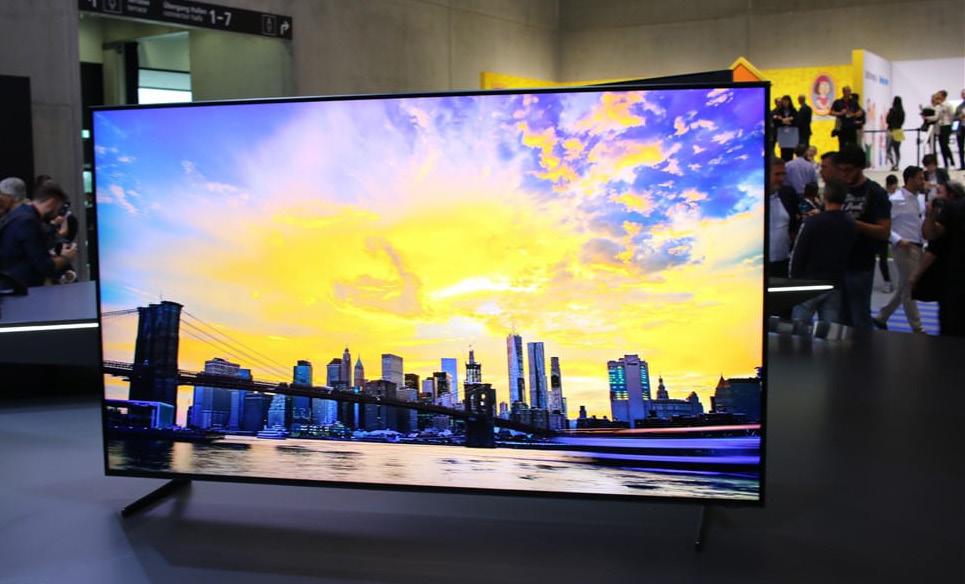
Television underwent significant evolution over decades, improving image brightness, introducing color TV in the 1970s, and enhancing screen aesthetics and functionality with finer resolution and larger sizes.

(2022) bands, and also considering the 600 Mhz band (which may occur in 2030/32). If the future reallocation of the UHF spectrum with current radio and television channelling (600 MHz.) is subject to a devolution to 5th-generation mobile devices, what will happen to the linear television we are familiar with? Will it be the same old story?
This fundamental and currently highly relevant issue is a subject of debate on the part of various European Regulatory Authorities, and also elsewhere. The question has also been posed by the British communications regulator Ofcom: “What will the future hold for TV broadcasting from the end of the current decade onwards?”
-) the migration of linear TV to the Internet. -) the elimination of terrestrial digital broadcasting or its coexistence in the electromagnetic radio spectrum with 5th-generation mobile cellular telephone services provided by telecommunications companies, but on portions of the spectrum restricted to TV
broadcasting. This may occur with new technologies with a higher level of transmission efficiency.
The major European broadcasters are discussing their future. The BBC and other independent British networks responded to Ofcom's public consultation, highlighting various critical issues regarding the feared shutdown or reduction of terrestrial broadcasting TV services, especially for elderly citizens who are less familiar with the Internet. In fact, a complete and all-round transition of linear TV to the Internet must ensure a guarantee of access, the pluralist approach, net neutrality and a quality of service typical of over-the-air broadcasting for a compatible and homogeneous result. However, at the moment telecommunications companies would not be able to certify such commitments with respect to their own current broadband network infrastructures, and this would only be possible through a review/adaptation of various system com-
ponents. A suitable upgrade will have to be introduced by 2030, even though various legislative provisions will be introduced by the European regulatory bodies much sooner. Many countries have already considered the transfer of the radio and television spectrum to mobile telecommunications companies for 5G in order to ensure suitability from a functional standpoint, and have already partially implemented this change or are currently in the process of doing so.
At the recent WRC in Geneva, a ‘no-change’ position was assumed by Italy and this is strongly supported by Italian broadcasters. This essentially implies that until 2030 the radio and television channelling of the Italian electromagnetic radio spectrum will remain focussed on Italian television broadcasting. Of course, guarantees relating to the restriction of cross-border transmission, which the frequencies are subject to with respect to neighbouring countries, have to be respected, and, more precisely, in order to
safeguard the WRC criteria. We are evidently faced with the issue of determining the best use of the electromagnetic spectrum of today's broadcasters and how to develop, in a harmonious fashion, the model of linear television in the spectrum that is adopted. At the same time it is necessary to envisage a total or partial migration of television, also through distribution via the Internet (DVB-I), at least for channels with more limited audiences, leaving the flagship networks of the broadcasters within the Earth-based digital and satellite dimensions.
So, we are once again experiencing a quantum shift in the world of television, which increasingly avails itself of technological innovations to identify solutions that will keep television simple. Users must be able to easily access and discover channels.
As television is also a unifying facility that reflects the identity and culture of the host country it is therefore necessary to ensure the simplicity and ease of access to information for all citizens, allowing television to acquire a consolidating presence in overthe-air broadcasting, but also in broadcasts via Internet.
One of the most important features of television transmission via Internet - which in fact aims to maintain the quality of the user interface, typical of television as we know it - is the DVB-I (Internet) facility. Following DVB-T (Earth-based) and DVB-S (satellite-based) transmission, this is the latest addition to the series of international Digital TV standards, defined by the Digital Video Broadcasting (DVB) project, the organisation for the definition of standards, and subsequently ratified by the European Telecommunications Standards Institute (ETSI). Television transmitted via Internet (DVB-I) was developed a few years ago and ratified as an ETSI standard in 2020. It was thus established in an important way also through the introduction of linear television channels in Internet, while maintaining the typical intrinsic qualities of usability and user interfaces.
DVB-I is a very promising standard because, while it allows television to be distributed and used through broadband Internet networks it guarantees the presence of the particular features of access and use of traditional television, without anything changing for the end user. With DVB-I, the use of digital TV with terrestrial, satellite or internet transmission is perfectly integrated, interoperable and seamless, while maintaining the same user experience, control and access to TV channels through remote control and Logical Channel Numbering (LCN),
i.e., the organisation of channels established by the local Regulatory Authority.
So, with regard to the Digital TV standards, terrestrial, satellite and internet DVB services are combined and complement each other, becoming perfectly integrated with the interactivity standard of Digital TV, namely HbbTV. DVB-I allows end users to acquire compatible television sets that can receive signals simultaneously from digital-Earth-based, digital-satellite facilities or the internet, without anything having changed. Viewers will continue to exercise the same control over their TV when switching to the various channels, by means of the same remote control devices, which have now evolved and also offer ‘voice recognition’.
Basically, DVB-I television is able to receive the best television signal among the various terrestrial, satellite or internet reception platforms, and selecting it exactly where the broadcaster is distributing it. In this case the DVB-I standard proves to be perfectly functional and well integrated for broadcasters, providing them with a new modality of interaction with the current television viewing model (DTT and Sat) and with future developments.
Broadcasters in various European countries are seeking and reflecting on the ideal approach to Internet TV and the DVB-I standard. There are various competitive aspects that characterise choices made by public and commercial broadcasters for the possible adoption of a particular model. An open-standard system, such as DVB-I, would be a preferable option for traditional broadcasters, but it is very different from the more ‘vertical’, proprietary solutions, which are ideal for FAST Channel operators, internet-only video editors or streamers, who offer their own channels in the widget galleries of TV manufacturers through adhoc commercial contracts.
Furthermore, considering one system or another, choices made are increasingly characterised by the presence of access regulation, inherent in the open DVB-I model, the TV system standard, compared to a vertical model not bound to comply with the provisions of regulatory authorities but strictly based on commercial contracts. Of course, LCN channel sorting falls only within the domain of a regulated system. In the FAST channels model, the numbering position is strictly regulated by the contract in place with the TV manufacturer. A further condition that will ensure success or may become a critical issue with regard to Internet television, above and beyond the
technological standard adopted, lies in the method of distribution through the broadband networks of the telecommunications companies and in the universal method of access which will be guaranteed to end users of a TV facility. In the current model of over-the-air TV a roof-top antenna or a satellite dish is sufficient to receive free channels provided by broadcasters without any further hidden costs.
On the other hand, with Internet TV a costly subscription will have to be arranged with a telecommunications company, together with broadband connectivity subject to a fee and consumption rates. This is a discriminating factor relating to access with regard to television broadcasting, especially in consideration of the quality of the service offered by over-the-air broadcasting technologies (continuity of service), as compared to the quality of service (best efforts) of broadband networks not equipped with point-to-multipoint technical systems (multicast).
The element of concern is that the high quality of service which digital television has so far been able to offer - 24 hours a day, 7 days a week, 365 days a year - to millions of viewers, must necessarily be guaranteed also by telecommunications companies through broadband Internet distribution. This is much more complex for telecommunications companies as Internet networks are not designed for sustained linear television traffic aimed at a large number of concurrent users.
Linear broadcasting technologies are designed for the simultaneous presence of a multitude of users, a situation that often occurs in the presence of large live events, such as the final football match of a particular tournament. In such a case, this would engender various difficulties for the Internet distribution networks given their point-topoint configuration.
This is a significant critical issue in the transition of television to Internet because it would require intervention for the adaptation or updating of broadband network technologies. This aspect would have to be addressed together with telecommunications companies in order to ensure the smooth and efficient distribution of linear television channels. In some respects it would be a bit like what happened in the case of Cable Television, which, with broadcasting technologies, allowed for television reception on the part of millions of users without risking any form of inefficiency in either transport or delivery or in the quality of the services offered, identical to that typically encountered in broadcasting.


Save the date for: 29 and 30 October for the 18th edition of the annual HD Forum Italia Conference at the Stella Polare Congress Centre of the Milan Trade Fair
The primary objective of the Milan Audiovisual Forum (MAF) project is most certainly that of addressing the concept of Open Innovation, which has been introduced in the Media and Telecommunications market and which today, more than ever, facilitates access to a vast range of ideas, solutions and skills with a view to analysing emerging technological trends that support the creation of audiovisual content.
The overall purpose is essentially to strategically integrate products and solutions with a view to enhancing visual experiences and focussing attention on the technological revolution that is redefining the paradigm of production and the distribution of multimedia content.
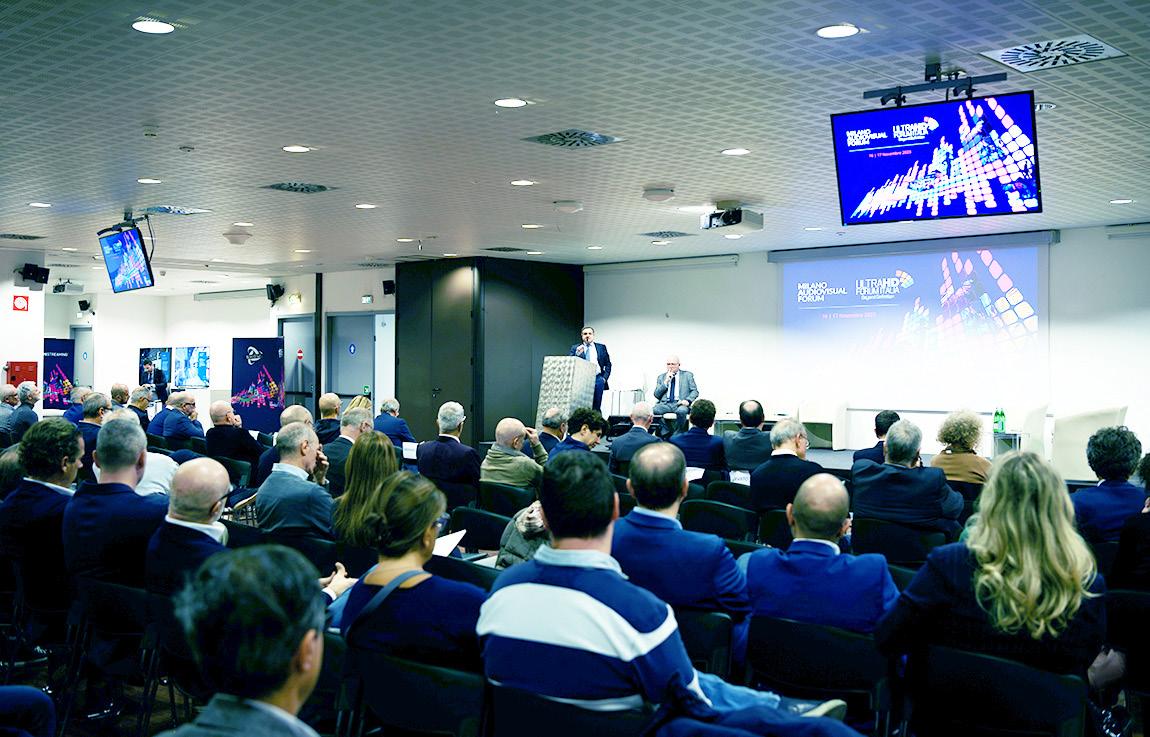

This type of content and technology will thus find its place within the sphere of the annual MAF event, which derives from a strategic collaboration between Pentastudio, HD Forum Italia and the Milan Trade Fair. The next edition of the initiative, characterised by its international scope, will be held at the prestigious Stella Polare Congress Centre of the Milan Trade Fair on 29 and 30 October 2024 and intends to present and highlight solutions having a high technological profile. The event will include a comprehensive programme of activities aimed at effecting a critical analysis of current technological transformations, and during which leading experts in the relative field will indicate guidelines that should be followed. Those present will be able to engage in an educational experience and acquire information, listen to comments and observations and reflect on analyses and assessments through a series of debates. They may also visit demonstration areas and participate in training sessions. At this venue, speakers of undisputed value will support us in our endeavours to extend
our range of skills and consolidate an operative base aimed at innovation.
The Milan Audiovisual Forum 2024 will thus be an event aimed at the entire audiovisual sector, focussing on the television and radio market, rights holders, content producers, the industrial chain of the sector, companies providing services and the integration of solutions with high added value. Attention will also be given to network operators and distribution platforms. In a constantly evolving market it is in fact crucial to understand and valorise the production and distribution of audiovisual content in all of its diverse forms in order to introduce and control changes and act in a complementary manner in the definition of new organisational setups and innovative business models.
Within the Milan Audiovisual Forum the annual HD Forum Italy conference will assume a decisive and extremely valuable role. HD Forum Italy is an associa-
tion aimed at promoting, supporting and disseminating the use of audiovisual and multimedia content, High-Definition and Ultra-High Definition products and technology and other advanced audiovisual solutions. Founded in 2006, HD Forum Italy unites within a common framework the leading Italian operators and Italian representatives of foreign companies active in the audiovisual sector with the aim of creating a centre that may facilitate experiences and stimulate interests, responding to the need to address in an appropriate manner an unprecedented evolving scenario.
The 2023 edition of the HD Forum Annual Conference supported the development of the recently-founded MAF. The event drew together experts and operators in the Italian and European market who are active in the broadcasting, telecommunication and audiovisual production sectors and was a success that went far beyond the organizers' original expectations.
Thanks to the data collected in due course it has been appraised that the MAF 2023 event attracted a very broad target of users and particular sectors, and approximately 36 per cent of the participants comprised company executives and managers. In particular, the subjects and areas considered reflected the value of this event. The topics ranged from 5G Broadcast technology for the distribution of multimedia content to the new DVB-I transmission standards, archival showcases for the valorisation and conservation of a visual heritage, the effects of Generative AI on audiovisual products and the production of important entertainment events through virtual studios.
In the 2024 edition we will venture into new areas of interest and explore in greater depth future market scenarios, in an attempt to anticipate challenges and capitalise on emerging opportunities. The conference will in fact represent an essential moment of reflection and debate with respect to fundamental issues of the sector. Experts who have acquired international fame, visionaries and leading operators in the market will discuss scenarios, perspectives and opportunities to create a learning environment in which experiences and knowledge can be shared. With regard to the traditional television

market, television serial production, content editors, producers and post-producers, ‘Over-the-Top’ platforms, satellite and terrestrial digital platforms and the radio sector we may say that everything will fit neatly into an ideal matrix with the emerging technologies.
Furthermore, thanks also to the presence of leading market industries and important companies in the fields of system integration and broadcasting and information technology, the real application of cloud applications, remote production, digital audio broadcasting (DAB) and visual radio will clearly emerge. With the support and presence of photography directors and colour correction experts we will be able to talk about virtual reality, a production process which is now becoming consolidated and which, considering its cross-sectoral nature, constitutes an element that facilitates a link within the spheres of production of cinema and television content and the realisation of TV series. All of this occurs moreover in the presence of generative artificial intelligence, with its infinite fields of application.
There will also be a focus on the market. The Subscription Video On Demand (SVOD) models provide a service subject to a fee, which in fact corresponds to almost the entire amount a consumer would have to pay, while the Transactional Video On Demand (TVOD) models, based on the purchase or the renting of individual content, are becoming increasingly marginal. In this context, the key players in the advertising

market will clarify the nature of hybrid solutions and the Ad-supported Subscription Video On Demand (ASVOD) models that are now emerging and becoming quite popular. We should also note that the MAF demonstration areas will represent an attractive feature of the event and a location where the innovation process may be explored. This will offer an opportunity to learn about products and services that will influence the future of the sector. The project will be completed through the provision of various Masterclasses, providing an opportunity to delve into topics of particular interest through highly qualified training sessions that will allow partici-
pants to acquire special skills. The event will be an opportunity for everyone to communicate with others and discuss a variety of topics, developing and consolidating relationships and stimulating an ongoing dialogue among all stakeholders. This will generate value and reinforce competitiveness and sustainability. Considering the overall significance of the event, it will help us ‘connect the dots’ of a complex and extremely fascinating ecosystem.
www.audiovisual.forum www.hdforumitalia.it
events@pentastudio.it
Tel.: +39 0444 543133
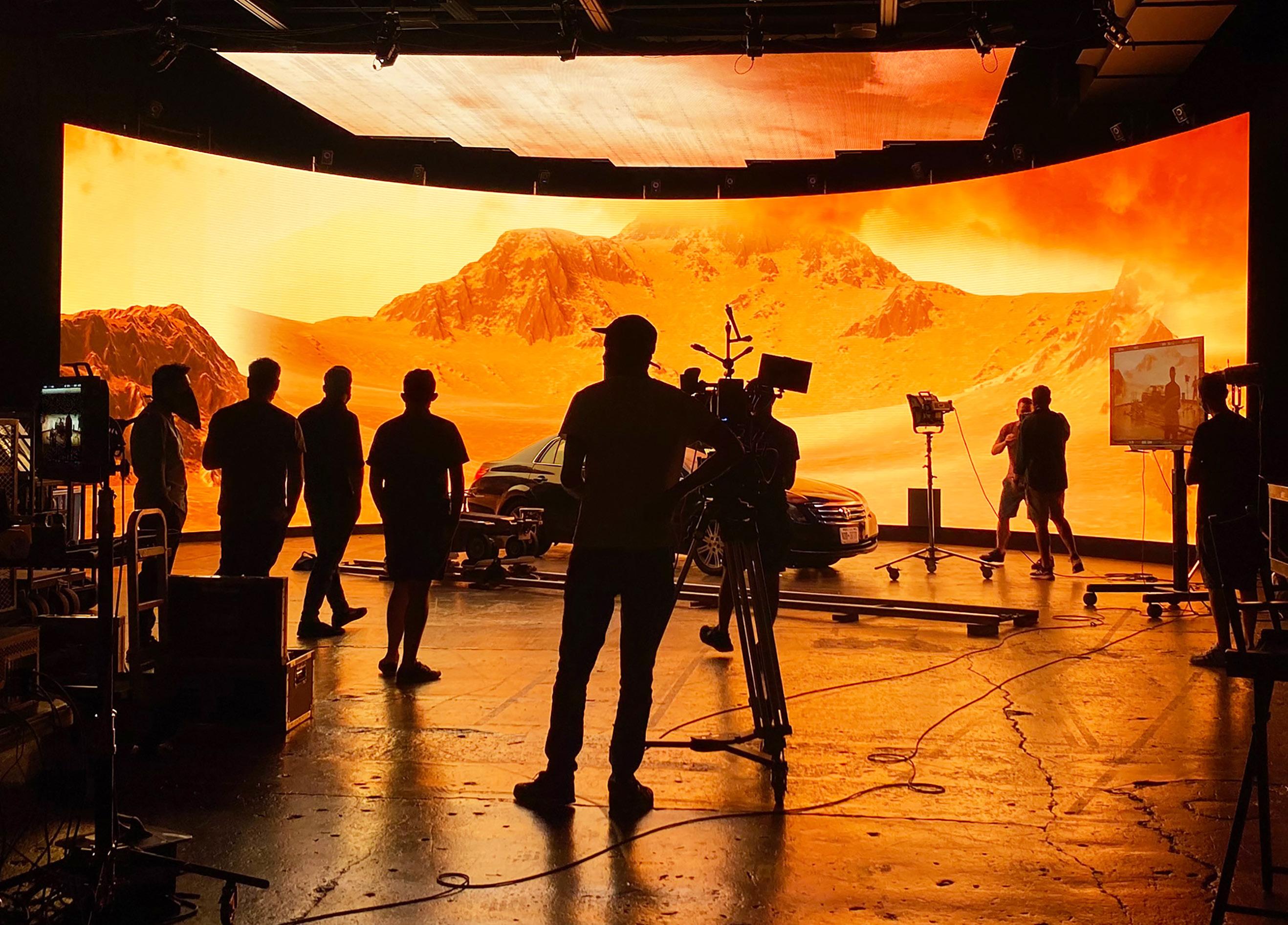
In 2023, at the Integrated Systems Europe (ISE) event some virtual studios were on display at the stands of the principal manufacturers, and especially those who produce LED screens. In 2024 the range and spectacular features of these devices has vastly increased, and AV Broadcasting has become a topic of considerable interest. We may note the progressive hybrid combination of Pro AV and broadcasting from the technological point of view but also with regard to the market in particular. Evolving at an equal pace with virtual sets, Virtual Production is progressing in both quantitative terms and with respect to quality. Simultaneously, the channels that permit access to content are increasing in number, and technologies such as Artificial Intelligence or those relating to immersive settings are gradually occupying a ‘centre-stage’ position. However, in the midst of all this, content remains a central element, as it was previously and now even more so, given that the medium is assuming a liquid state and the methods of use for users are increasingly varied.

In this article our aim will be to take stock of and review the new hybrid scenarios occurring between AV and broadcasting. We are assisted in this endeavour by the contribution of Ciàran Doran, the managing director of Deep Blue Sapphire and moderator of the Content Production & Distribution Summit event proposed for the ISE exhibition. Other sources of reference are provided by the work of Simone Madoni, a project manager for the Milan Audiovisual Forum (MAF), our own event held in collaboration with the Milan Trade fair and the HD Forum (29-30 October), and reports acquired at the ISE and the International Broadcasting Convention (IBC) trade shows, the European benchmark exhibitions for Systems Integration and Broadcasting sectors.

The forms of hybridisation occurring between the world of broadcasting and the professional Audio Video sector are now well established, but how did we reach this point?
Ciàran Doran - In recent years it has become easier to produce high-quality content: technology is performing increasingly well and virtual sets have been created. At the same time, the channels of use have multiplied, this being a trend that is still evolving. We have moved on from watching television in the living room to a situation in which we have a broad range of opportunities with regard to the use of content structured at a low or a high level, and the duration of which may be quite short or very long, on many different devices. But we have to bear in mind that a channel is only a medium.
Today we are used to a proliferation of proposals regarding content ...
Yes, and we are witnessing a new transition. If only a few years ago we experienced the growth of brief entertainment or promotional content or a mix between the two areas, initially on YouTube and then via TikTok, today we are becoming increasingly familiar with this situation thanks also to the improvement of technologies and viewing standards, with a great a leap in quality.
We are thus witnessing the birth of brand channels that reinforce the relationship with direct clients through high-profile content, communicating with users directly, without any form of mediation.
Could you give us an example of this?
About two years ago the Macallan Distillery produced a short, 8-minute film entitled The Spirit of 1926, which recounts the story of Janet Harbinson, the widow of the founder of the Scottish company. She decided to carry on the business in an era - at the beginning of the last century - in which women traditionally did not normally work, and least of all in the alcohol industry. This short film is of excellent quality, mas terfully produced under the direction of Mike Newell , and Emily Mortimer, the leading actress, portrayed the heroine of the tale. I was truly impressed as I watched the eight-minute film and, even though the whisky products remained in the background and the film focussed on a love story and empowerment, I shall not forget that the subject of the film was in fact the Macallan whisky distillery itself.
I have to say that I really wished there might have been at least one sequel. This is because what involves people is of course not a product as such but the story that is recounted and their response at the emotional level. Marketers of large groups should certainly bear this in mind.
So, do you think channels like Netflix or Prime Video will be able to replace TV?
I believe that brand channels will be increasingly gaining ground, not only by pushing aside television but through complementing and accompanying channels such as Netflix. In short, I see that brands are increasingly using pro AV technologies and those related to production and streaming in order to create their own content, which will reflect the quality of a brand and establishes a direct relationship with clients. However, I don't think that new broadcasters are wiping out traditional television, which, in turn, is seeking new forms of communication with the public, capable of supporting the cost of the creation of content.
Do you think that new productions - and, that is, virtual productions - will require new professional resources?
I don't believe that the work of a director of photography that is carried out on a traditional set will differ considerably from that performed on a virtual set, however I do believe that virtual production creates new opportunities, both qualitatively and numerically, for the existing professions. Furthermore, I notice that there is a sort of ‘democratisation’ thanks to virtual production. If, formerly, in order to carry out
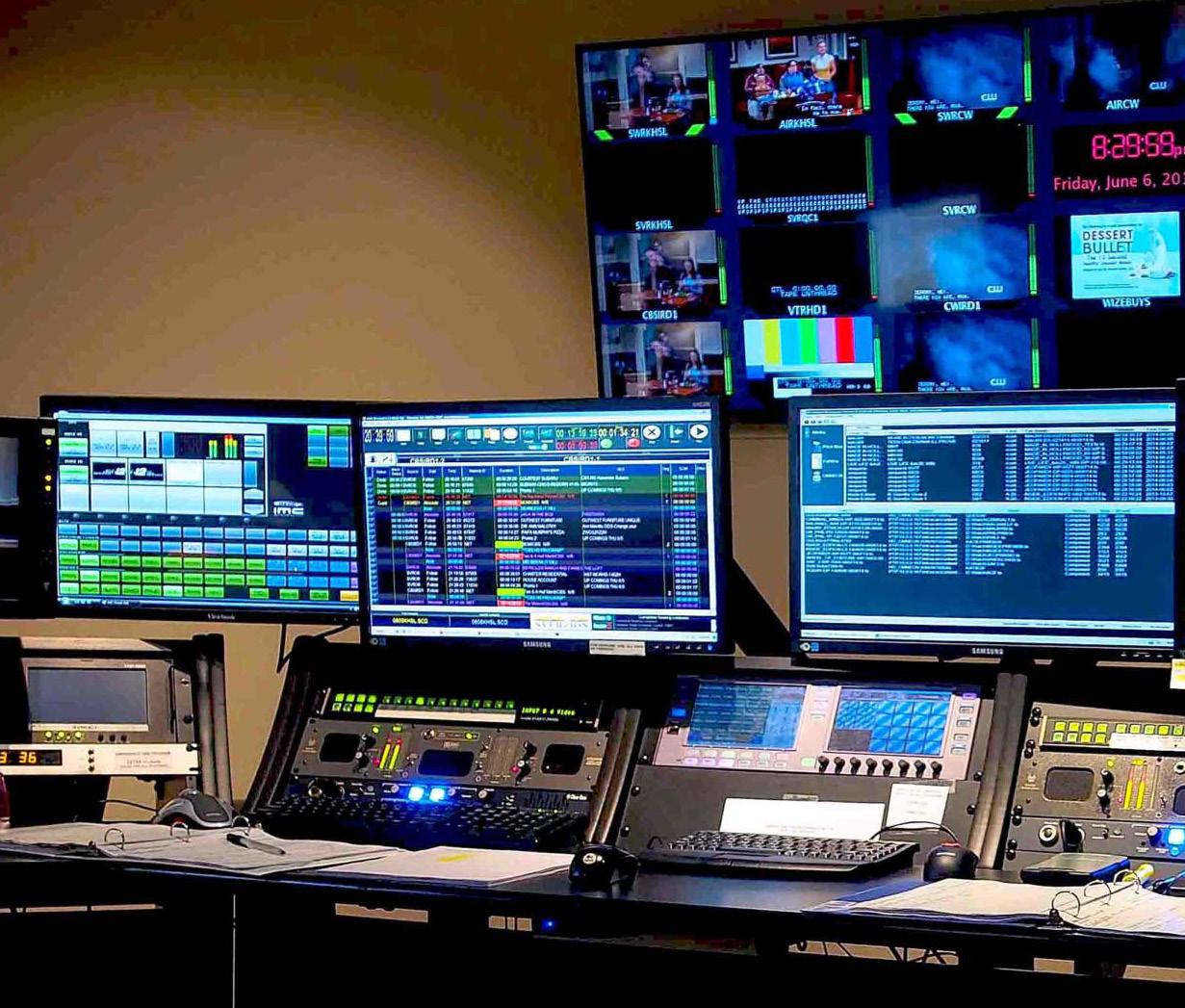
one's work it was essential to be present at a particular site or to move around when a production was transferred or relocated (a requirement which directors of sporting events would have to comply with if they take place in certain locations around the world), today, for example, it is possible to control a video camera remotely, allowing everyone to work from practically anywhere.
In your opinion what kind of relationship exists between technology and creativity? Do these key factors support each other?
It's true that new technologies - and in this sense I would refer to virtual production techniques, immersion and AI - can significantly change the final product, but at the same time I don't think we can be more creative thanks to technology. As always, to a large extent it depends on the talent of the people who use it: an excellent tool in the hands of an operator who is not very creative will in any case only provide us with a medium-level result. However, technology helps creativity; it's like an invisible assistant working behind the scenes.
Why do production teams invest in virtual studios?
Because they make life a lot easier, reducing costs and sometimes they will provide a
good solution. For example, they allow you to produce results with greater certainty in terms of methods and duration. There are no unforeseen events and there is no need to move the sets. The timing of a project will be shortened, from the early writing phase to the creation of a finished product.
Do virtual sets represent an opportunity also for technology manufacturers?
As in other sectors, here too we are witnessing a move towards innovation, which sometimes will even identify in advance the needs of users. However, virtual productions involve companies that normally used to operate in other sectors and only marginally in broadcasting, such as manufacturers of LED screens, distribution matrices and so on. The technological evolution will undoubtedly help to reduce costs and ensure even small production studios remain competitive.
What do you think about the ‘blending’ of AV broadcasting and Digital Signage?
Well, in fact, I find it hard to understand why companies like SKY, DAZN or other firms don't consider using DS networks to broaden the range of their content, and especially due to the fact they nurture strong relationships with advertising agencies. This may be my basic subject of discussion during the next Forum at the ISE event!
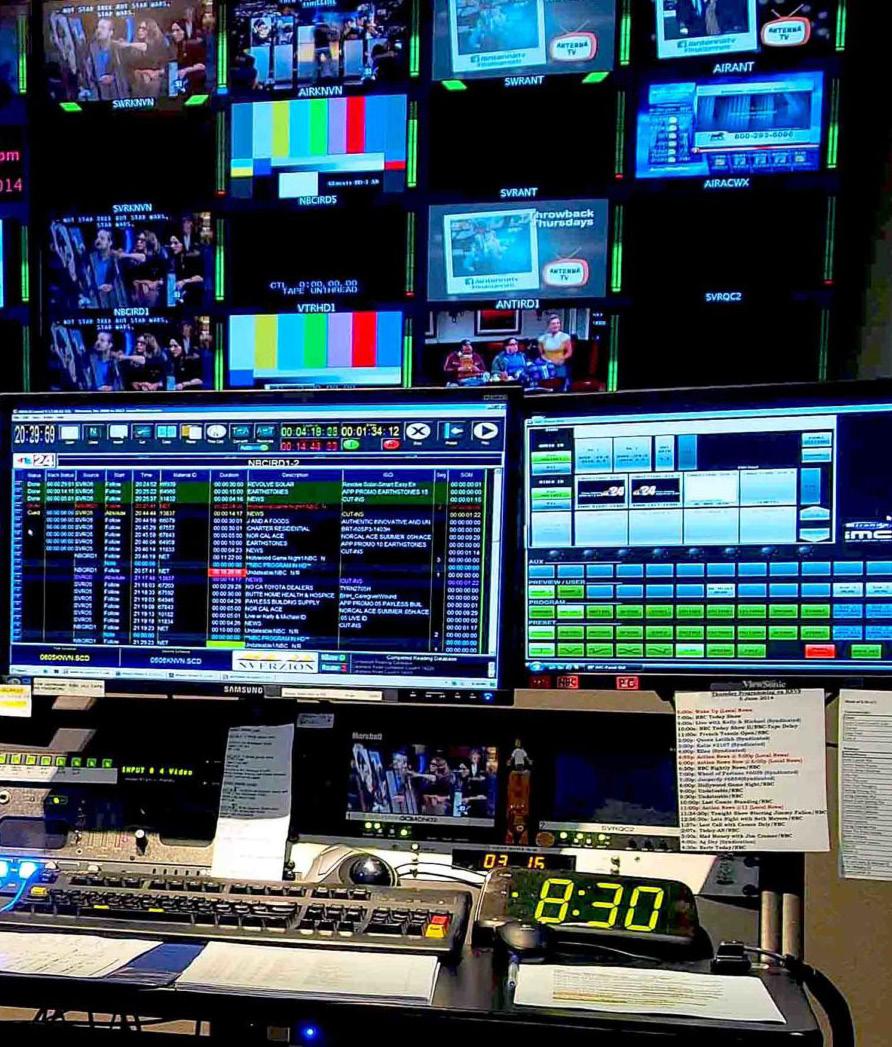
We have collected some recent examples of high-profile content produced by various brands. These are really short films that involved significant forms of collaboration and budgets, and in which the ‘story telling’ is an instrument that facilitates communication with clients. Perhaps in the near future we will create our playlists, starting from a brand and not by simply consulting the platforms.
- The Spirit of 1926 (2022). Produced by the Macallan whisky brand, this short film pays tribute to and recounts the story of Janet Harbinson (played by Emily Mortimer), the widow of the founder of the distillery, who decided to carry on and manage the business in an era when women did not usually work. A story of love and empowerment.
- The Long Goodbye, a short film directed by Aneil Karia and Riz Ahmed in 2020, was produced by WePresent. WeTransfer is often used to transfer video files, and this resulted in the WePresent editorial platform. The short film, which won the Academy Award for the Best Live Action Short Film in 2022, recounts a story of intolerance and redemption.
- RB19, a video clip designed to present the RedBull RB19 Formula 1 vehicle, produced in 2013. The vehicle appears in contexts where in actual fact one might never expect to see a car of this type, such as city streets and bridges, seafront promenades, etc. Virtual production solved the problem and made it possible to change locations very quickly and without the occurrence of unexpected events.

If we consider the technologies pertaining to the sphere of AV broadcasting, the two aspects that would currently attract the greatest interest are the compartmentalisation of visual production - which implies the consideration of both networks and connectivity and also support and channels - and the world of virtual production, with its LED screens, new issues in post-production and signal and data management.

Simone Madoni, where should we start?
We might begin by reflecting on the general habits of the public and, that is, the viewing of content. Today we are accustomed not only to the presence of a range of channels but also to the variety of ways in which the same channel may be used, with regard to support, timing and the relative methods of use.
The same content is available live or on demand. It may be viewed on the television in the living room or on a personal device, using a PC or with a Smartphone. Despite this, linear television is holding its own - at least in Italy - and the bulk of advertising revenue still comes from this source. Even if every year there is a dispersion of around 1 million viewers from linear TV, I do not think it is possible to precisely define where and how these viewers relocate and which platforms they select. The quest to identify and comprehend user loyalty is an extremely complex endeavour.
Will the fragmentation of audiences that normally use ‘over-the-top’ (OTT) streaming platforms offer more and in a different manner?
For the user it means practically unlimited on-demand content, the chance to choose a particular device and so on. It is obvious
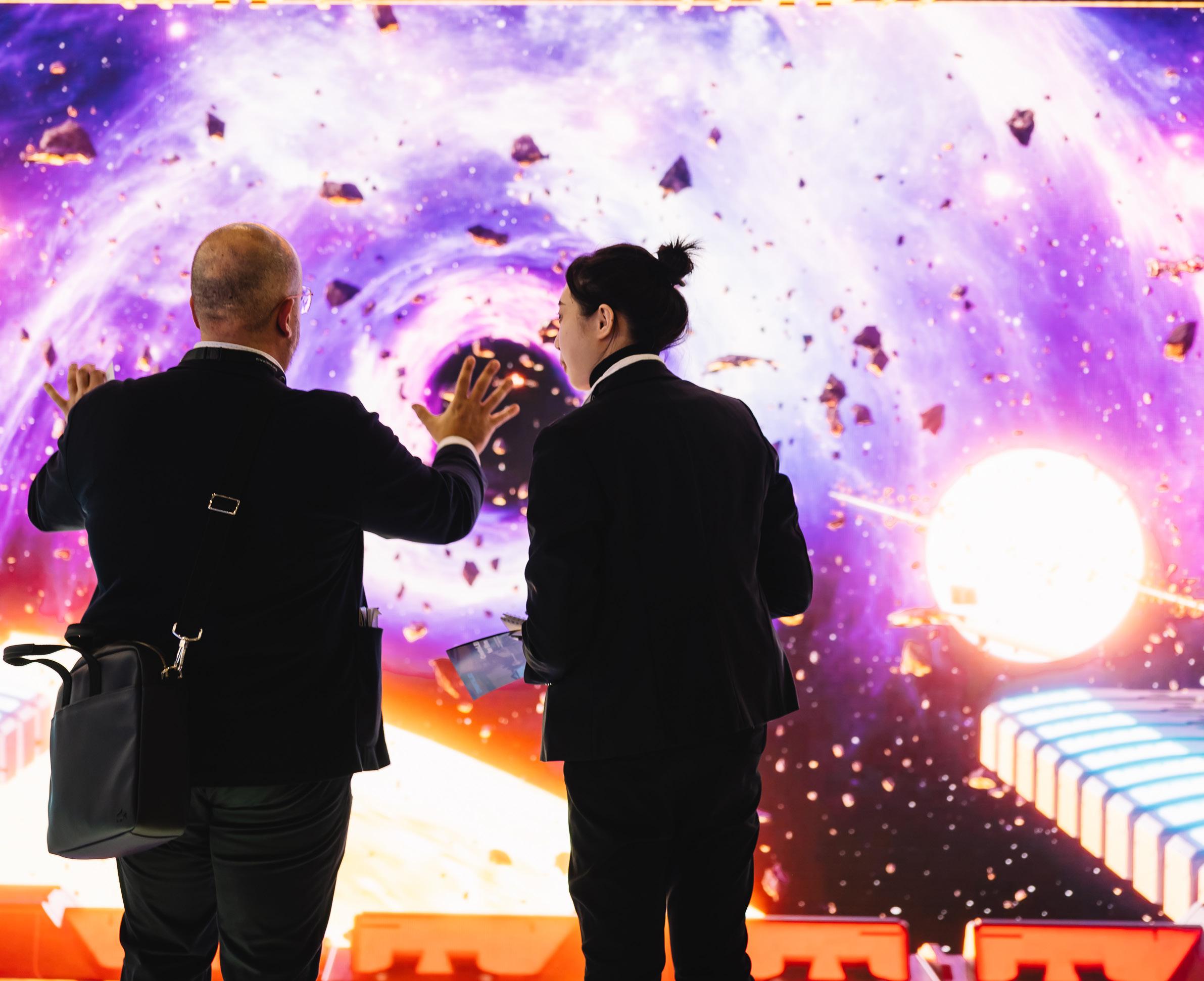
that when there is a strong content and the editorial body makes it available on all channels, one aspect will not necessarily penalise the other.
The Sanremo Music Festival this year was a beautiful experience, both visually and in terms of the content. The number of viewers reached all of the expected targets, and who would have expected it to be so successful among members of the younger generations.
The show was presented via both a live broadcast on the RAI 1 channel and also through a ‘simulcasting’ transmission with the RaiPlay video streaming platform. The complementary nature was instrumental in expanding the user base. At the editorial level, considering the total audience, the great novelty with respect to studies and analysis is represented by user profiling.
We may now reflect on Virtual Sets
The possibility of creating potentially infinite settings through the use of special effects, video servers and new LED wall models is revolutionising the production workflow, and Virtual Set systems represent an increasingly adopted solution, especially for the creation of TV series. The identified driving factors underlying their use comprise time optimisation,
flexibility and an economic advantage. However, advanced professional skills and careful intervention in the post-production phase are definitely required.
We also spoke to Ciàran Doran and asked him to express his view as to whether virtual sets might require new professions or professionalism?
With regard to training we still haven’t achieved much. We evidently need to create value because this is an emerging and complex technology.
Specific skills are necessary for each individual area of the supply chain.
What is the role of audio transmission?
As always occurs in the field of broadcasting we tend to focus more on video than audio transmission, and in my opinion this is not appropriate.
In the production of films and television series, a lot of importance is placed on audio production so as to increase involvement on the part of an audience and to place greater emphasis on stimulating an emotional response.
It seems that immersive audio is the right path, but we'll talk about this in more depth on 29 and 30 October this year at the Milan Audiovisual Forum.
Broadcasting and AV ... or AV broadcasting?
To examine in depth the increasingly strong bond between AV and broadcasting we discussed the issue with someone linked to the ISE trade fair, which represents the Pro AV market in Europe. Over the last two years the exhibition has significantly expanded its focus (training, dedicated areas, etc.) on broadcasting.
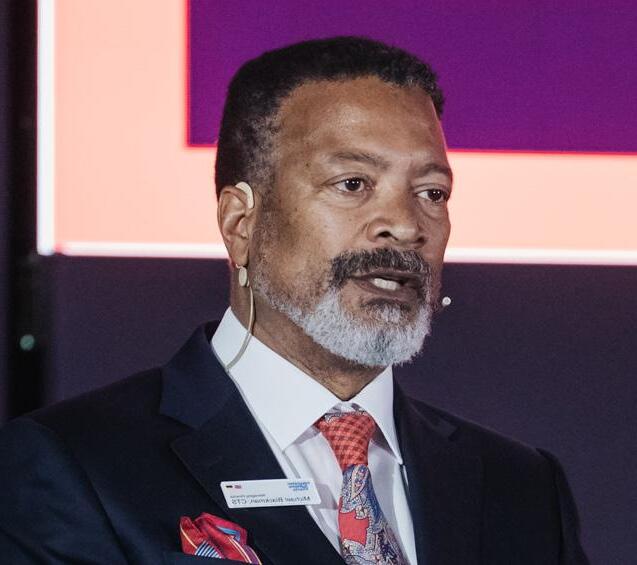
Mike Blackman, the Managing Director of ISE offered his opinion in this regard.
AV and Broadcasting are merging. When and how did you decide to include this new trend at the trade fair?
The broadcasting market, a cornerstone of the media and entertainment sector, has undergone remarkable transformations over the years. It remains relevant, but we are witnessing a growing demand for broadcasting applications within AV projects, and this may be attributed to several factors, such as the evolution of technology, consumer media usage trends etc.
This convergence has been underway for several years, but more recently there has been an acceleration.
At the ISE exhibition we responded to this tendency by actively integrating content and features that demonstrate how these technologies are complementary.
We introduced a Content Production & Distribution Technology Zone and launched the Content Production & Distribution Summit during the ISE 2023 event, and this was repeated in
2024. We will continue to develop this theme for ISE 2025. Additionally, over the years, we have presented keynote speakers from the broadcasting industry, such as Bernt Johannessen from Epic Games and the Oscar-winning filmmaker Sharmeen Obaid-Chinoy, who have conveyed their valuable insight at the Integrated Systems Europe event and have shared their observations with members of the professional AV community.
Do you think it will also have a major impact on the broadcasting market?
In addition to changes in virtual sets this transformation is revolutionising the entire broadcasting market. It's not just a passing trend. The merging of AV and broadcasting technologies facilitates the immersive effect. It increases production efficiency and opens up new paths leading to full engagement on the part of public audiences.
Brands and businesses are leveraging these technologies to create more dynamic and visually engaging content, which, in turn, is increasing interest on the part of viewers and broadening their reach.
And with regard to the broadcasting sector?
The convergence of technologies is significantly reshaping the AV market. This integration allows professionals to assume new approaches that were previously associated with broadcasting. As a result, they can adopt more sophisticated production methods and tools, improving the quality and variety of their projects.
Furthermore, the growing demand for high-quality content in real time, enabled by advanced broadcasting technologies, is driving the innovation process and creating new business opportunities within the AV sector.
www.iseurope.org

AV broadcasting may be seen as more than a technological trend

As we know, trade fairs reflect the market they represent. We asked Steve Connolly, the Director of IBC, the reference trade fair event in Europe for broadcasting, what his vision would be concerning the ever-increasing hybrid combination effect in the AV and broadcasting fields.
AV and Broadcasting are increasingly connected. Do you think it's just a technological trend or that this will have a major impact on the market?
Steve Connolly - The convergence between AV and broadcasting is more than just a technological trend, as is demonstrated by the impressive growth rates recorded in the sector.
A recent analysis conducted by Caretta Research showed that, annually, the area is expected to present a growth of nearly 3% in the period 2023-2027, highlighting significant business opportunities and an exciting impetus at the level of the entire sector. Incorporating advanced AV technologies, such as virtual production, broadcasters are able to improve the quality of their content, creating more engaging and immersive viewing experiences.
This convergence allows for the introduction of innovative narrative techniques, combining traditional broadcasting methods and cutting-edge AV tools. As these technologies become increasingly integrated into daily workflows, they will allow for the development of new business models, increasing operational efficiency and stimulating creative content, in such a way that broadcasters will remain competitive in an increasingly digital world.
Visitors at IBC 2024 will be able to view and examine many AV
innovations in the exhibition areas and also during presentations, masterclasses and demos. It will all be part of a series of contents focussing on such topics as AI, 5G, Cloud, Esports (electronic sports), immersive experiences, OTT & Streaming, AdTech and Connected Technologies.
How do you think AI will impact content production?
AI is everywhere and will be a subject of interest at the IBC 2024 show. Our new AI Tech Zone will be launched this year, presenting revolutionary companies and technologies that will enable the use of AI in the media and entertainment.
AI will have a substantial impact on content production, improving efficiency: the automation of routine tasks will help professionals focus on the more complex aspects of production. We already note that AI is influencing content creation and personalisation through an analysis of available data, a technique that allows broadcasters to personalise production. Many providers are also using AI to improve subtitling and translation services, making their content more accessible to a wider audience.
AI is also a key theme of this year's Accelerator Media Innovation Programme, which brings together end users and professionals and will address topics such as cloud-based production, misinformation in the media, sustainability or low-latency sports streaming.
The AI Media Production Lab will propose working on creativity at the narrative or storytelling level, improving engagement on the part of viewers and exploiting real-time predictive analytics to personalise the viewing of live sporting events. https://show.ibc.org/

Together with Enrico Borghesi, a manager of the firm Exertis, we explored, from both the technical and marketing point of view, a broadcasting sector linked to small productions and small studios. We should note that in this case ‘small’ means ‘simple’, and not banal
During interviews conducted for this issue of the magazine which were focused on ‘new’ trends in the world of broadcasting, attention was drawn towards a series of small studios - technologically valid, albeit quite simple - that are equipped with good quality products, often corresponding to those adopted in the professional AV sector and frequently acquired from rental companies. This is a trend that emerged during the pandemic, when communicating become rather complicated and universities, companies and training institutions set up their own channels dedicated to interacting with the public. This trend has now become stabilised and we note there are many entities that are neither broadcasters, nor film production companies or OTT channels, which have maintained and have perhaps developed channels for communication with the public that were previously launched. Additional operators comprise Web TV, agencies that deal with the streaming of events of all types, from fashion events to professional topics, figures of public renown and others from the sphere of entertainment and many YouTubers, some of whom may count on thousands of users, who have set up autonomous threads and channels. We explored this trend together with Exertis. With a view to satisfying the needs of some of its customers, mainly in the corporate dimension, this firm has initiated its own path of growth in this area of broadcasting, which has now expanded and is supported by constant approval. Enrico Borghesi, the channel manager of Exertis ProAV Italy, spoke to us about this subject. Over the last four years many of our services in the broadcasting sector have been related to Web TV, universities and companies engaged in the creation of technologically valid virtual sets - although not at the cinematographic level - where the characteristics of auto focusing, remote management and the automation of PTZ cameras are more useful than a television
video camera, and where graphic mixers assume primary importance for the management of LED screens or Green Screens. Transactions often occur through rental companies now operating in the sector, and products and solutions are indeed more frequently rented - often for very long periods - rather than sold to final clients. This constitutes an evolution also with respect to the purchasing model, which more frequently involves the acquisition of a solution together with a service rather than just the product in itself.
How have you gained recognition and earned accreditation in the broadcasting sector?
We started our business because we wanted to offer an effective response to our clients with these needs, but then smoothly entering this sphere wasn't easy. It is a rather traditionalist sector and not very open to novel technological facilities and new brands that are proposed. We entered this field thanks to the aid of some of our customers and partners already present and who have become well known in the sector. Over time we have structured a genuine business line, which my colleague Stefan Ivanovich and I are in control of.
Which brands and solutions represented the driving force?
As a company specialising in the professional AV sector we have several brands that are already well known, with products that are adopted in both the AV market and broadcasting. Our ‘Trojan Horse’, let’s say, was initially Barco, a brand already widely accredited among broadcasters and which is easily proposed, and in particular the graphic mixers, used to manage signals in an optimal manner on LED walls. From this point we entered the world of LED displays, today at an increasingly narrow pitch, now up to 0.8 mm or 0.6 mm and, again, with the Barco brand also in this case. PTZ cameras are also important and, for us,
considering the Sony and Lumens brands, which with respect to television cameras are more suitable for small studios. They are equipped with automatic movement and focusing and tracking and they can be managed remotely, fitted with a LAN connection, offering a truly hybrid solution between broadcasting and AV. Nor should we forget the audio sector, which for us is represented by Yamaha, and, in particular, considering benchtop mixers. The QL series, for example, is a high-end product that is fundamental in productions.
In your opinion, what needs will arise in the coming years?
We are moving towards agile solutions and products that correspond to multiple needs. I believe that the world of broadcasting will become increasingly varied and fragmented with a multitude of channels in the hands of operators who are not necessarily specialists. Companies, educational institutions, public figures and so on are becoming broadcasters. There will therefore be an increasingly greater need also for studios that offer quality but which are also very agile, and for those coming from the professional AV world the future prospect may be very positive. Furthermore, from the technical point of view, we believe that a merging of formats would be important. In the audio sector we have sorted this out with Dante but with regard to video production there are still various different formats. Finally, a rationalisation within the sphere of transportation would also be desirable. The progress of 4K and the tendency on the part of the public to opt for a good visual standard increase the ‘weight’ of the flows, and the management of an uncompressed signal becomes increasingly complex. Compression algorithms suitable for a specific case may be useful for both the design of an infrastructure and also the internal management of signals.
https://exertisproav.it
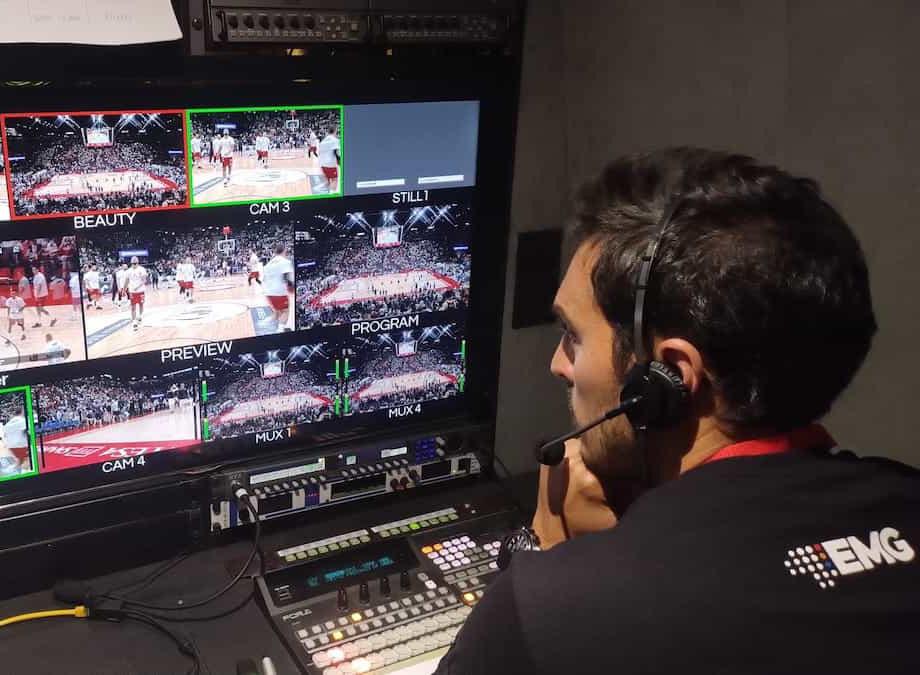
With its long-term experience acquired in the world of media and broadcasting EMG Italy can offer its clients a high degree of reliability but, above all, the company is distinguished by ongoing research with regard to technological innovation and the updating of resources which ensure its capacity to provide constantly avant-garde production services
The name itself of the broadcasting company - EMG Italy - immediately reminds us of sport and live events. Of course, this association occurs entirely with respect to television broadcasting. The company, which was formed by the merging of historic firms such as Netco Sports, 3zero2 TV and Global Production, in fact operates not only in Italy but also together with the EMG/Gravity Media group in Europe, the United States, the Middle East and Australia. It is an active partner in several important international events in both the sports sector (to name just a few: the Giro d'Italia, the Champions League and the Superbike world championship) and also in the more general world of live entertainment (and, again,
this includes widely known events such as the Eurovision Song Contest). In short, EMG is closely associated with important sports events and high-class entertainment. The specialisation of the company, which has been established thanks to its great experience, consists in providing the broadcasting world with top-quality equipment and graphic elements.
The firm constantly considers technological updates, and this is fundamental in an environment where it is always necessary to grow and to improve, not only to meet the needs of the public but also to impress viewers through the use of technologies capable of generating the so-called ‘wow effect’.

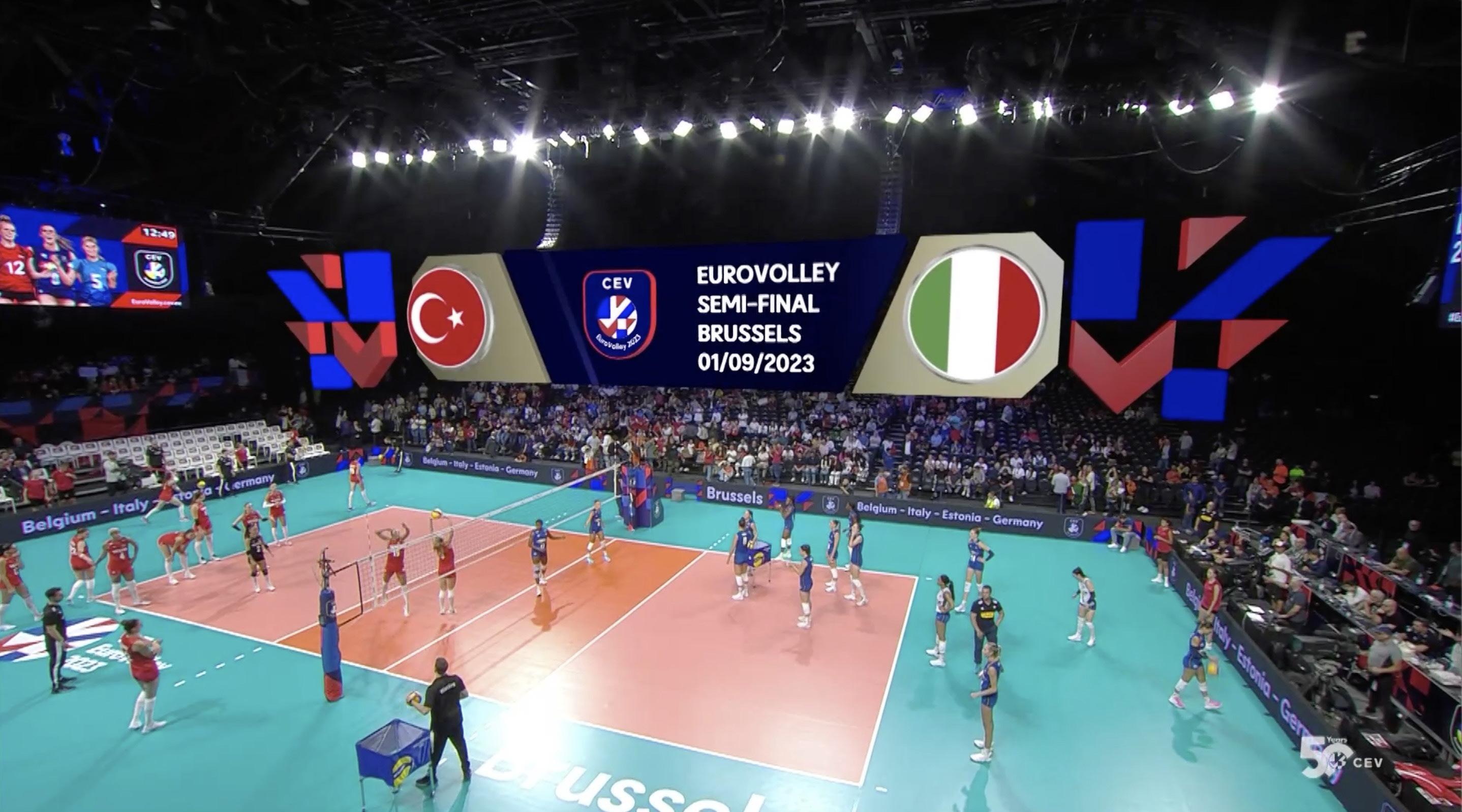
The broadcasting sector is in fact always intent on seeking forms of innovation in terms of the quality and the type of filming adopted. Suffice it to consider recent investments on the part of various large cinema brands in the broadcasting camera supply chain to introduce within the dimension of television a ‘cinema quality’ effect which will illustrate and portray in the best possible way certain sporting endeavours or artistic performances. Novel methods are sought also with respect to the very important area of real-time graphics, which, in particular, are indispensable for a truly effective presentation of sporting events, with data, statistics and information which the public cannot do without. Lastly, and again with a view to achieving the constant updating of technological devices and equipment, the installation of LED walls in film or television studios for the realisation of television and cinema projects is gaining ground over the ‘traditional’ green screen. Of course, this will depend on requirements relating to artistic and creative forms of expression. In short, it is like a poker game, in which it is always necessary to know how to reflect, start afresh and play a decent hand, let’s say, and in this case with innovations and improvements that actually affect the aes-
thetics of the television medium. In this way - as mentioned above - the ‘wow effect’ will be generated on the part of the public and this is certainly an essential, desirable result for live shows and sporting events. We were able to engage in a long chat with Alessandro Curti, the Head of Graphics Italia, which forms part of the EMG Group, who very willingly and kindly illustrated his work and the company's activities. Alessandro has been working in the EMG group since 2005 and at the beginning of this year he assumed control of the department that deals with graphics in the sports sector, focussing on planning, the management of operators and technicians and the marketing of services.
This is indeed a significant and responsible role assumed by Alessandro, who has reached the height of his career entirely dedicated to information and communication technologies for broadcasting.
Alessandro, in just a few words how would you describe the essential nature of your work?
We deal with television graphic content that has an informational and didactic nature within the sphere of sports activities, with the aim of providing everything the viewer may need to clearly understand what is happening in a match or a sports event. We have ‘graphics vans’ which we use when we travel around Italy and Europe for various productions.
Our technicians install the system on site, and everything is tested with the director. The content is subsequently verified with the editorial staff.
Our work is not purely technical; it also comprises a lot of creativity.
What are the requirements and demands of your clients?
The request we most frequently receive is that relating to the so-called ‘wow effect’. They want solutions that will arouse interest and amazement in the public.
Of course, clients are not always perfectly aware of what can be achieved from the technical point of view in this respect. We have to guide them and accompany them within our special world, also bearing in mind the potential and importance of this technology for sponsorships. Clients can ‘invest’ in cutting-edge graphics for their sponsors, and this will increase their turnover - and, thus, also ours.
The business partners of final clients benefit greatly from augmented-reality graphics, which allows for immersive and almost interactive sponsorships.
Two topics that enter the discourse in a spontaneous manner and a sense of immediacy and which we would consider as
essential elements are ‘sport as a form of entertainment’ and the application of augmented reality in the graphics dimension. A very recent sporting event, the Coppa Italia final between the Juventus and Atalanta football teams, which took place at the Olympic Stadium in Rome on Wednesday 15 May and ended with the victory of the ‘Bianconeri’, ‘black-andwhite’ Juventus squad, allowed us, literally, to earn an ‘assist’ in our endeavours to address these thematic cornerstones.
You spoke about augmented reality in relation to graphics for sporting events. Could you explain to us to what extent this new technology affects the production of these events?
Sports events are increasingly seen as ‘shows’. We have acquired more than a decade of experience in sports graphics, and the latest level of live graphics is in fact augmented reality, which is able to convey information to the public in a much more engaging way, enhancing both the product itself (TV production) and also technical data relating to a sport. For example, in the case of the Italian Cup final, an example would be the 3D figures of players on the screen and the statistics pertaining to their season.
So, is augmented reality an added value? Yes, definitely. In the world of sport, statistics and graphic data have always been important. In addition to football, we also deal with volleyball and basketball. For two seasons now, with regard to these sports we have also been taking care of the Video Assistant Referee (VAR) support system, with an instant review and ten stations where images are collected in real time. These are then delivered to the match referees, who are in contact with our operators.
In practical terms, how is your work performed?
We always start off with a briefing that is held with the client, during which the requirements are established and the templates and elements that have to be inserted are identified. Our motion designers and graphics experts create 3D elements that are matched to the customer's needs. We then meet up again and refine the version of the graphics, and at that point we enter the operational stage. The crucial point here is the fact that from on-screen graphics we move on to producing the result in
a dedicated virtual space. New technologies and new cameras make it possible to enhance 3D graphic elements and create a special overview and presentation of a sporting event, starting from the moment when the teams that will take to the field are presented.
What do you mean by ‘new’ cameras and innovative filming technologies that conform more to cinematographic rather than television-style criteria?
We also have special cameras, dedicated to certain types of events. For example, at the Olympic Stadium in Rome for the Italian Cup final we had a Robycam. It features a gyro-stabilized camera head, with innovative movement and position sensors, installed in the 3D 4-point anchoring mode and attached to cables that allow for its movement across the field. The head can provide full 360° panoramic coverage. The signal is transmitted via a fibre optic cable, so it is extremely reliable for the filming of live events. Moreover, Compass AR Tracking technology makes it possible to add virtual objects and augmented reality graphics in the video feed and in real time. Nowadays, drones are also a widespread tool. We are focussing on the development of graphics that can be used with footage produced by drones, which require accurate tracking on the three axes of movement of the camera so that the graphic element is positioned correctly.
More specifically, as we do have a recent practical example, how did the Italian Cup final go at the Olympic Stadium in Rome?
I would say it was a success. In this case our client was the LNPA and, that is, the National A-Series League, by whom we were commissioned to provide our services at the end of April, shortly before the event occurred. The match was an important occasion for us because in our partnership with the LNPA it was the first time augmented reality was actually used during a football event. Previously this had occurred only in a test we carried out in the autumn at San Siro during the Milan-Fiorentina match, but it was not broadcast. However, for the Juventus - Atalanta match in the Italian Cup final we curated all of the graphics introducing innovative elements, such as comparison sheets illustrating the teams and individual players.
For a couple of years now we have been intent on moving in this direction, and we
have created graphics with augmented reality for both volleyball and basketball events.
So, in short, will augmented reality graphics replace traditional graphics? is this what the future holds?
Well, in particular, we may say that traditional graphics and augmented reality go hand in hand; they become integrated and interact, and these systems enrich each other. In fact, we curate traditional graphics and augmented reality graphics, also in other countries, such as Germany, Belgium, Switzerland and France. For live events, the focus is on transmitting the graphics in real time. The system is developed so that it can be used in live broadcasting. Apart from the technology, operators trained specifically to manage this type of production are also required.
What are the essential features of the equipment and infrastructures upon which your work is based?
Proprietary software and hardware, as well as very powerful computers.
We have been developing the software programmes internally for thirty years now, thanks to the NEXT graphics platform, where we upload our projects.
For augmented reality we rely on the services offered by Vizrt, which develops hardware and software dedicated to television graphics.
We have ten graphics vans for Italy and about fifty which we use throughout Europe, equipped with cutting-edge equipment. The name of the Italian division of our company is EMG Italy, but on the international level, operating in Europe, USA and Australia, since January of this year we have become established as EMG/ Gravity Media.
Finally, I would like to point out that great value may be attributed to the entire team I work with, formed by a group of individuals strongly dedicated to this profession. The activities are often performed without a working-hour schedule and may require our presence during weekends and on public holidays. In particular, I would like to mention Dario Lombardi, the software development manager, Elio De Ponti, engaged in graphic design, Lorenzo D'Alessandro, who is active during the ‘playout’ sessions and at production centres, Antonello Grippo, the cycling project man-
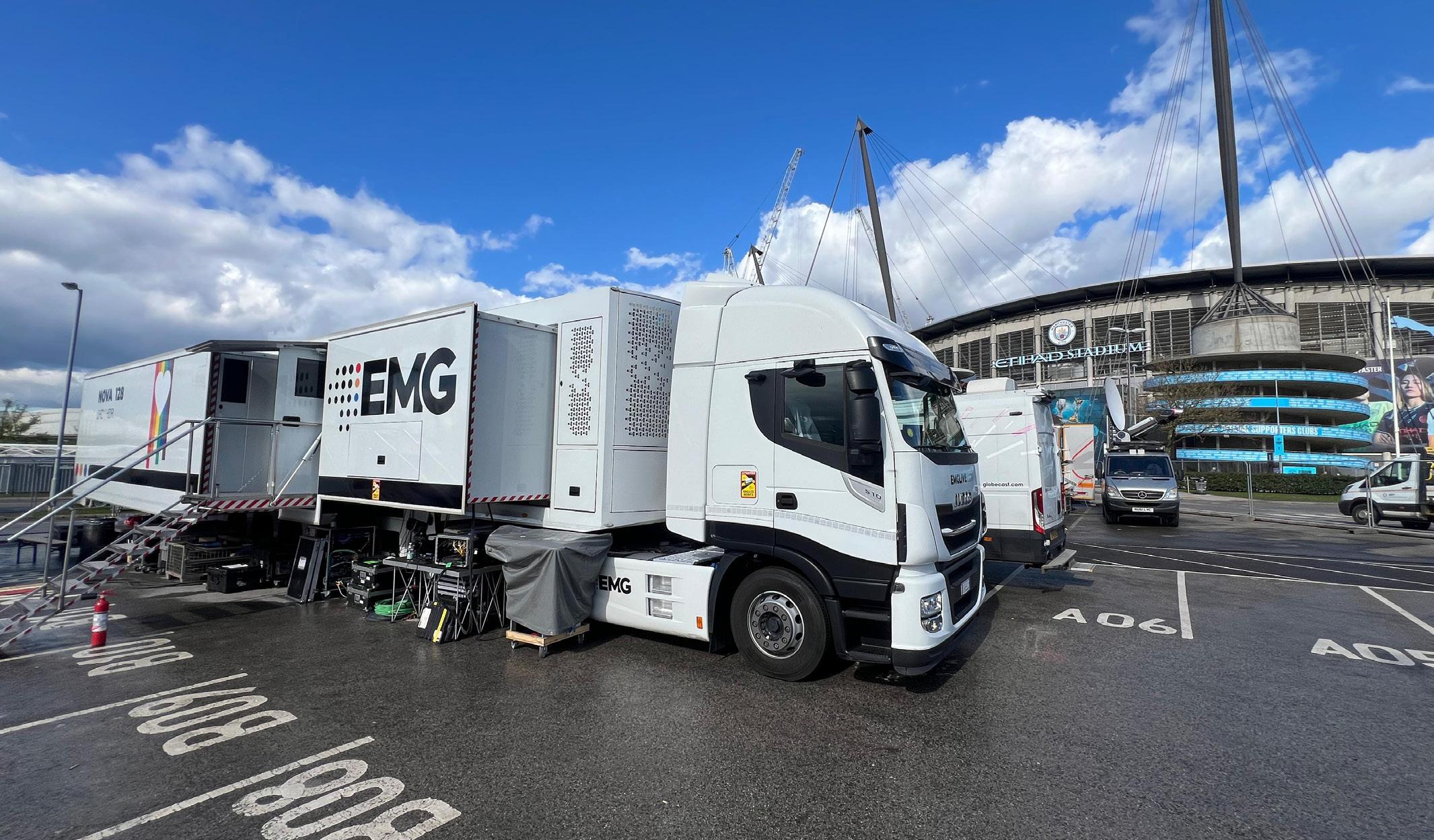
ager, and Antonio Inglese, who focuses on technical aspects and manages our equipment and materials.
One last question: how do you envisage the future of your sector? What implementations and developments may occur ?
Our business is definitely growing. With regard to the immediate future, Artificial Intelligence is the factor that is determining development in practically all sectors. It is gradually entering every sphere and, potentially, the resulting developments will be exceptional. For example, we have already carried out tests with voice commands in a television production, and we have experimented with AI in the sphere of problem solving or in the processing of very high quality images in real time. In the future, Artificial Intelligence may represent a great asset also for the management of ‘tracking’.
We are in fact already using it to automatically follow moving subjects, for example in cycling events.
During the live broadcasts of the stages of major races, cyclists are automatically followed and in-depth graphic elements or statistics are added in real time.
https://it.emglive.com


Around 800 LED screens have been installed across the entire motorway network of the ‘Autostrade per l'Italia’ group, all of which are managed from the main Screenlight control unit. Some of these displays form part of the installation at the Casilina Est service station, a benchmark site in terms of its completeness and the vast array of elements that are present.
The company Screenlight, which is based in Rome, specialises in installations having a strong visual impact, in which there are large screens suitable for the presentation of events, permanent installations and digital signage. Its range of customers includes Autostrade per l'Italia, for which it manages approximately 800 displays installed in the service areas of the entire motorway system.
Following the inauguration of the ‘Autogrill Casilina Est’ service station facility, a point of reference in terms of visual and interactive solutions, we spoke to Andrea Betti, who collaborates with Screenlight, and he described to us the special features of this particular installation.
Collaboration with Autostrade per l'Italia Screenlight's relationship with the Italian motorway group began around 14 years ago, following an initiative developed by Betti, which led to the first installation of twenty LED screens at four of the most important service stations on the motorway circuit. This intervention was financed entirely by Screenlight, with an investment aimed at demonstrating to the Autostrade group the validity and effectiveness of digital signage, which was not very well known and rarely exploited at that time. The supply of multimedia content was implemented by InfoMoving, a company of the Autostrade group, while the management of advertising was undertaken by an agency from which Screenlight obtained a third of the turnover obtained from publicity.
The project grew very quickly over time, reaching a level of 500 monitors installed in the service areas. This growth was stimulated by Autostrade with regards to financial aspects, while Screenlight was continually committed to installation, technical assistance and the management of multimedia content. After about eight years, the management of the entire system was changed, and the proprietary
Screenlight platform was replaced by Samsung’s standard, high-performance Magic INFO solution.
The latter platform allows for the management of the entire system by means of a single monitor, so as to be able to direct the various multimedia content to the various locations, with a highly-detailed and timely form of customisation. This detailed, ‘granular’ perspective is also ensured with respect to diagnostics, performed in real time and visible to the relative operators - of both Screenlight and Autostrade - via an app for mobile devices.
The Casilina Est installation
Given the excellent results the Autostrade group has financed a further growth of this system. Today Screenlight manages around 800 displays, including those present in the Casilina Est service station in the Province of Frosinone, where LED walls, LCD displays and interactive touch-screen devices have been installed, to offer visitors a complete and immersive multimedia customer experience. This is the most important and complete system managed by Screenlight. It includes approximately 300 square metres of LED screens, installed in both interior and exterior settings. This system is the prototype of future installations which the Autostrade group plans to introduce at the most important ‘Autogrill’ service stations on the network. Approximately 25 sites will be involved in this project. Following the most recent marketing trends and in full compliance with the regulations on the protection of personal data, the displays positioned at the entrance points are equipped with cameras and electronic systems which enable recognition of the age and gender of people passing by. It is thus possible to present in real time the advertising content most suited to the ‘audience’ present at a particular moment. An internal touch totem also provides the public with information relating to road conditions and safety, as it offers a direct connection to the near-
est station of the traffic police. All of the panels conform to IP67 protection class conditions and are therefore resistant to bad weather and rainfall. They are also enclosed in aesthetically pleasing metal containers, designed, manufactured and installed by Screenlight. In the design of the devices safety was taken into account, considering their resistance to disturbing weather conditions and wind.
The entire display management system for the Autostrade group is protected against cyber criminals at multiple security levels, starting from that of the Autostrade group itself, which provides dedicated and protected access to Screenlight for functions strictly related to the management and surveillance of the multimedia screens. Further protection is provided by the Magic INFO platform, which complies with all European regulations relating to cybersecurity. Finally, Screenlight is protected by its firewalls, which prevent malicious outsiders from accessing the proprietary cloud.
The video content, images and commercial advertising spots are created by agencies and companies that have signed a contract with the Autostrade group for the distribution of their content. Screenlight takes this content on board, transforms it into formats that are consistent in terms of technical characteristics (resolution, aspect ratio, audio level) and, finally, includes it in a planned schedule.
Videos must have Full HD resolution (1,920 x 1,080 pixels) and an aspect ratio of 16:9. It should be noted that all of the electronic components and displays are already compatible with the Ultra HD format (3,840 x 2,160 points), including the LED walls whose resolution derives from a very fine dot pitch of 2.5 mm. The images are thus scaled automatically to this resolution. The advertising material is accompanied by additional information flows, such as weather forecasts, provided by the Italian Air Force meteorological service, and news, which arrive in real time from Sky TG24 and which are visible in a bar that appears at the bottom of the screens.
The management of these contributions is fully automatic.The video content arrives at the service station locations via the Screenlight cloud and the Web, and it is loaded into local storage. In this way the system will continue to function even if the Internet goes down. The information is provided in real time.

The displays that Screenlight offers range from classic LCD panels to large LED walls, and also interactive touch totems. Screenlight is an exclusive provider of Samsung’s MicroLED modules from the ‘The Wall’ series with a 1.6 mm dot pitch, Unilumin LED panels (a Chinese brand, and the world's largest manufacturer of LED walls), Samsung Magic Info remote management software and a proprietary application for digital signage. Added to all of this is a complete set of broadcast-grade, audio and video equipment, such as cameras, mixers and control consoles.
Screenlight uses proprietary hardware for its installations. 300 square metres of LED walls were recently acquired, corresponding to a total of 1,200 modules. These will be used for an important broadcasting project (Virtual Studio), now close to completion. Screenlight has at its disposal a total of over 1,200 square metres of LED wall modules.
The service offered by Screenlight is complete, customised and, literally, provides ‘turnkey’ solutions. The company takes care of the definition of a project in accordance with the client’s specifications, the identification of all technical requirements, and complete on-site intervention for the installation of materials necessary to create from scratch the supports for the displays.
One of Screenlight's strong points is the control unit, where qualified personnel supervise scheduling and contents. The core of this system is the Magic INFO software, which allows for management of both content and devices in real time and remotely, from a single platform. Samsung's solution is capable of dealing with tens of thousands of screens, all of which are individually addressable. Magic INFO constantly monitors the installations and will transmit alert signals in the case of any malfunctioning - even of a single pixel - to promptly activate assistance.
Screenlight works with the RAI national broadcasting company, Mediaset and ‘Università Roma Tre’ (where it has installed a Samsung ‘The Wall’ screen). It follows important events, such as the awarding of the ‘David di Donatello’ prizes and five-a-side football matches (with the installation of LED panels along the entire edge of the field). Screenlight is also present in the cinema sector, with its scenographic digital tools and components, created with LED walls that have a very high visual quality and are capable of working best with digital cameras.
www.screenlightsrl.it
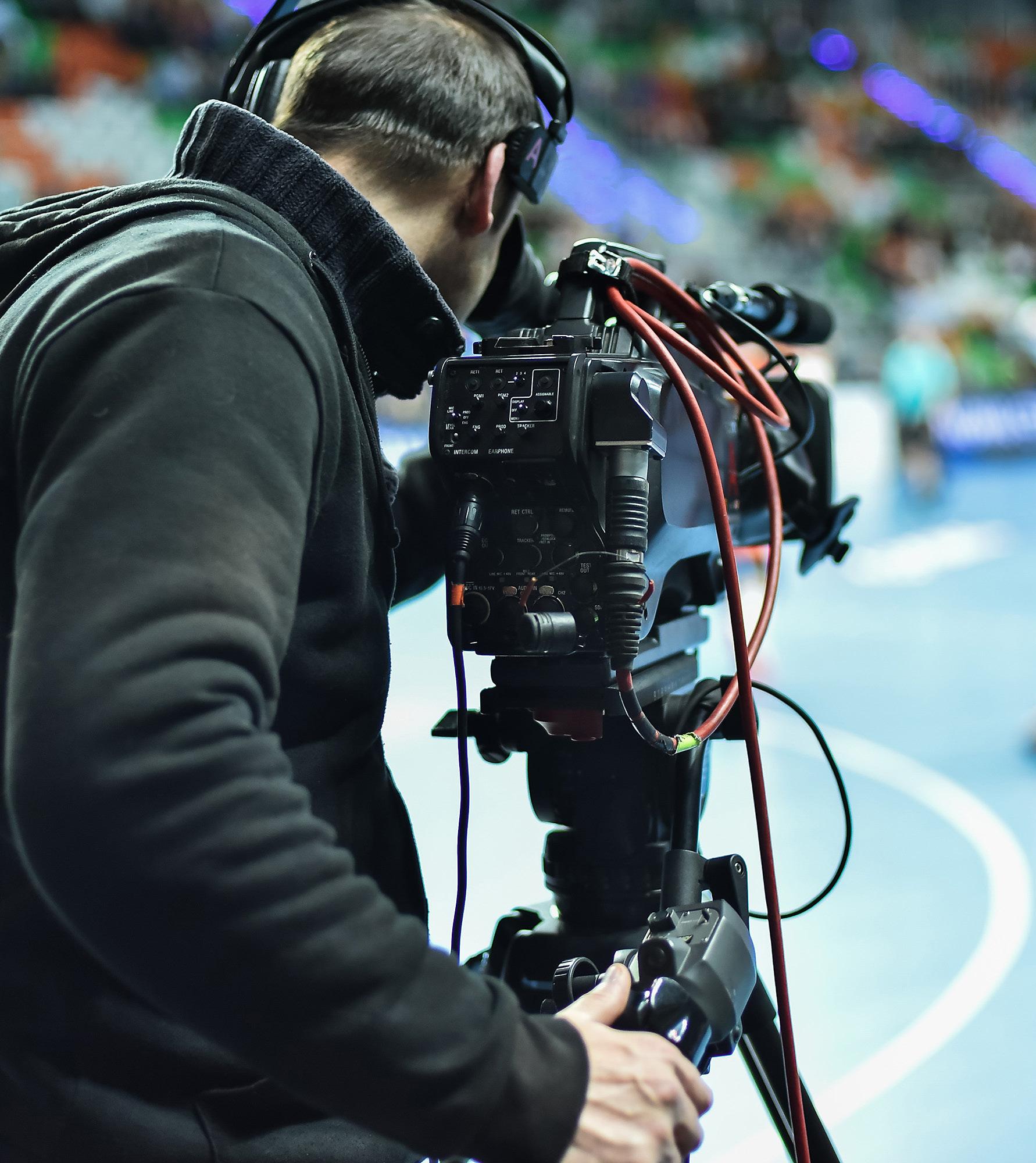
Maria Cecilia Chiappani

Gabriele Lusco and Sergio Sasso are partners of AMS, a Piedmontese cooperative company which specialises in the provision of technical, artistic and creative services for broadcasting, streaming, events, audiovisual and multimedia production and postproduction, installation and the integration of audio-video-lighting-control systems, and much more. With these representatives of the company we explored the requirements, technologies and results of collaboration with the sports broadcaster Mola TV for the production of on-demand and live content at the Turin headquarters
Should we switch on the television when we get home or shall we go over to the bar to watch our favourite matches and sports broadcasts? With regard to broadcasting we have certainly moved beyond old traditional habits. As we all know - regardless of whether or not we use modern facilities - nowadays we can follow extremely popular or national-level competitions or niche sports events with on-demand content, subscribe to specific tournaments and championships and watch streaming content. This is possible - wherever we are and at any time of the day - and applies to any sport. These possibilities represent the advantage of digital facilities and resources - perhaps the sole positive legacy of the Covid tragedy - which are in fact revolutionising the business models of publishers and television broadcasters. The entire supply chain of technology providers and professionals linked to the diverse world of sport activities is also reaping the rewards of new widespread opportunities. An example of this evolution is the rapid rise of Mola TV, an Indonesian over-the-top and on-demand video streaming platform that holds the rights to many sporting events in several countries, as well as offering rich archives of films and TV series, and also original ones.
This recently-established, innovative broadcasting facility has its Italian headquarters in Turin and is directed by Goffredo d'Onofrio, supported by the journalistic coordination of the deputy director Enrico Zambruno. In particular, the service offers on-demand and live content covering football, fighting sports and car racing events, but its schedule is constantly updated. With regard to football some of the most popular events are the Copa Sudamericana, Copa Libertadores, matches of the Argentine Primera División (with a focus on the 'clasicos') and the Dutch ‘Eredivisie’ Series-A matches. Mola TV also broadcasts events of the Cage Warriors Fighting Championship (CWFC), a British mixed martial arts organisation, and those presented by Karate Combat, the world's first, professional, full-contact karate league based in New York. And then, there are the Nascar racing events, rugby competitions and other ‘new entries’.
But who is in charge of the ongoing production of content? It’s the broadcasting team of the cooperative company Artistica Music & Show SCpA - or ‘AMS’ for short - which is based in Turin. The association has 240 members and has been present in the market for almost thirty years. With its various divisions, the company offers
multiple services relating to audiovisual communication, events and installations. The specialists of the AMS-Multimedia division are responsible for interviews and debates relating to sporting events and these are conducted every week at the Mola TV studios with the aid of the most recent broadcasting technologies developed by Blackmagic Design.
The AMS-Multimedia division, which is also the subsidiary branch of AMS in Turin, is in fact dedicated to audiovisual and multimedia production and post-production activities. More specifically, its business unit The BlackStudio, founded by Gabriele Lusco and Sergio Sasso, is entrusted with Mola TV projects. In this regard the two professionals commented on their collaboration: “We had already had an opportunity to collaborate with Enrico Zambruno, assisting him in his previous journalistic work. He contacted us again, asking us to provide him with technical support relating to live and on-demand content. Our company deals with directing, post-production, multi-camera live video production, streaming and corporate contents, exploiting the great experience we have acquired in the world of sport, and this is the reason why Mola TV turned to us.”
The technical collaboration focuses primarily on the creation of on-demand detailed accounts of sporting events with respect to which Mola TV holds the rights. Basically, the overviews are provided by announcers and TV reporters or during interviews with former champions and experts who comment - in Italian - on the events in question. The contents are then made available on the platform and, possibly, on the YouTube channel in accordance with the social programming requirements. Everything occurs at the broadcaster's studio in Turin, which is fitted with Blackmagic Design equipment. Whenever necessary, the system may be integrated with additional devices that are useful for ensuring an efficient workflow in accordance with the specific type of event and sports. The AMS professionals added a few further comments: “The needs of Mola TV were not only related to the practical nature of the type of production but would rather primarily involve the rendering and quality of the audio video content, which is fundamental in the sports sector. Strengthened and encouraged by our own skills, we supported the broadcaster in the creation of production


and control stations for live transmission and recordings, optimising the materials available with a technical approach capable of perfectly complementing the journalistic aspect, which remains entirely managed by Mola TV."
Thus, with the flexibility that nowadays characterises broadcasting within the sphere of sports activities the BlackStudio staff provides a 'package' of contents and formats for the various uses required on a case-by-case basis.
Considering production, live coverage and post-production, the professionals involved have to cope with more than just a single challenge. In live events, for example, it is important to use particularly versatile cameras and forms of production, capable of managing a diverse range of light and climatic conditions in order to contend with technical uncertainties that may arise and
which are not always predictable. At sports centres and facilities, with thousands of noisy fans screaming their heads off, critical issues may arise relating to audio effects and communication with the team. At a general level, broadcasting today requires flexibility so as to guarantee an optimal result in every possible targeted destination of the images. In the case of streaming on a platform, as in the case of Mola TV, it is necessary to be aware of and comply with certain standards. The interviewees pointed out that “The requirement is less stringent today than in the past thanks to a technological evolution in the conversion capacity of the Blackmagic Design production system. In any case, specific converters allow the production units to intervene in all circumstances. We are able to exploit the potential of various video camera models without worrying about the relative output, as the latest-generation devices centralise the management of a variety of incoming
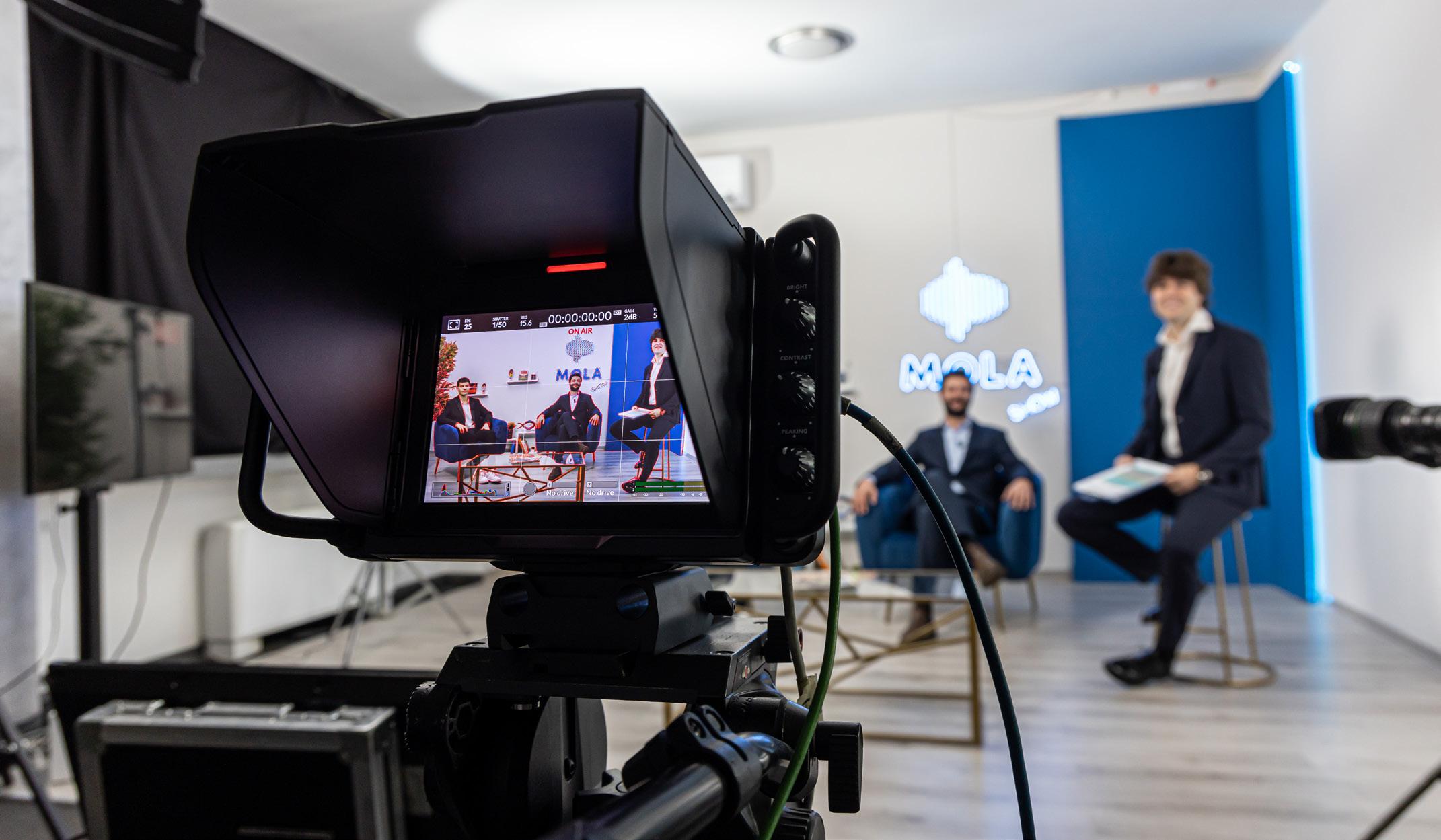
and outgoing contents and formats.”
A further element concerns the training of the technical team. Operating as a cameraman at a corporate event requires particular skills, while covering a sporting event requires an entirely different type of expertise. And not all sports are the same. you need to be familiar with the typical form and the ‘narrative’ relating to each category, because, let’s say, filming a volleyball match is not quite the same as presenting a game of ping-pong. One has to acquire specific know-how for filming and production activities within the various settings. Again, in this regard the interviewees noted that “It is by no mere chance that among the AMS divisions there is also a sector dedicated to the training of technicians who are involved in production and post-production, providing tailor-made solutions for the broadcasting of sporting events. With regard to finding operators for ongoing collaboration activities we are facilitated by our status as partners of a cooperative and this allows us to draw on a large pool of highly-qualified resources.”
We may now consider the technological core of the collaboration between AMS and Mola TV. In the broadcaster's studio, four particular cameras are used in all operations: two URSA Broadcast G2 and two Studio Camera 4K Pro model types.
The novelty lies above all in the former of these two designs. They are in fact highly versatile broadcasting cameras, with advanced features typically adopted within the spheres of cinematographic work and advertising. Gabriele Lusco and Sergio Sasso illustrated their approach: “We chose the URSA Broadcast G2 cameras because these devices enhance the level of quality - also considering colour engineering - with respect to traditional broadcasting solutions. They allow us to create high-level products directly and in the short term, without having to further process the images. In particular, they are equipped with a central core in which an entire series of accessories may be installed, from optics to a fibre converter. In short, with the right fittings they are valid options in all areas of our work. This proposal from Blackmagic Design has opened up new business channels for us, also with clients who until now had preferred cameras of other brands historically linked to broadcasting.”
Together with these models, we use two Studio Camera 4K Pro cameras, which may be considered as ideal for the integration of images created with the URSA Broadcast G2 devices and fulfil the requirements of the various ongoing productions.
As far as production is concerned, AMS professionals exploit the all-in-one fea-
tures of the ATEM Television Studio HD8 ISO live production switcher. This is a complete solution, which enables and centralises numerous activities. Whenever necessary, this model allows for the acquisition of signals from cameras, the exploitation of the various outputs, management of the audio arriving from the cameras or from the input of the production and control unit itself, verification of the colorimetry of the cameras, the control of the recording of all signals, and the direct 'streaming’ and management of flows via the Blackmagic Design 10G protocol.
We were told that “Directors can achieve many things, but their various skills may not always be required.
The important thing for us is knowing that everything is there at our disposal. For example, when we need to carry out a particular colour correction or light management we use the appropriate Blackmagic Design panel. But in situations where there is controlled light and fixed cameras, with constant environmental conditions, this model allows us to carry out the necessary adjustments at the beginning of the event, using the ATEM Television Studio HD8 ISO panel, without the need to continuously monitor the parameters or integrate other products into the system.”
The same applies to the audio element. If it is considered a critical component of the event, the professionals will use a dedi-
Blackmagic Design workflow
Cameras
2 x URSA Broadcast G2
2 x Studio Camera 4K Pro
Production
1 x ATEM Television Studio HDI8
ISO
3 x Hyperdeck Studio HD Mini
1 x Blackmagic Video Assist 12G
HDR
2 x Studio Converters

As explained by the Black Studio professionals, the quality of the workflow for Mola TV starts with Blackmagic Design's URSA Broadcast G2 cameras. This presents an ideal solution for broadcasters, as it allows for the use of existing optics and batteries. Furthermore, recordings may be made on the popular SD, UHS-II and CFast 2.0 cards or external USB drives in the most common formats, such as H.265, ProRes and Blackmagic RAW. It is thus compatible with all types of video software and systems for the management of broadcasting multimedia resources.
In practical terms we may speak about 3 cameras in a single solution:
• broadcasting production: ideal for broadcasters, it includes ENG-style lateral controls identifiable by touch, while a dedicated sensor allows you to capture high-quality images in a natural light setting;
• live in the studio: this comprises an advanced YRGB colour corrector and offers full remote control; it can be used with B4 ENG-style lenses or large studio lenses, while optional Blackmagic Focus Demand and Zoom Demand allow operators to control the lens from the tripod arm;
• digital cinema: the advanced 6K digital sensor with an interchangeable mount system allows for the use of digital PL cinematographic or EF photographic lenses; the high dynamic range and optimal low-light performance deliver the quality of a digital film camera.
The camera also supports the creation of a small H.264 proxy file, in addition to the original file, during recording. This can be uploaded to the Blackmagic Cloud in just a few seconds, making studio files immediately available.
cated audio desk, but if the tracks that arrive are relatively simple to manage the producer also carries out this task directly. And this occurs with all of the relative operational advantages.
“Versatility results in flexibility and dexterity. In less complex cases, there will be fewer devices that have to be transported and managed. However, in any case, in more delicate situations we will still have everything we need for a well-accomplished production. Furthermore, the possibility to carry out the project with the ISO camera and to effect a live recording allows us to deliver a complete, cut and edited montage at the end of the event with a few small modifications. This significantly shortens the processing time."
We should also refer to the complete workflow for Mola TV. Through the ATEM Television Studio HD8 ISO production system the content leaves the setup and enters the system which projects the content directly onto the broadcaster's platform. At the same time, the program is recorded through the Hyperdeck Studio HD Mini devices, but in some cases The Black Studio staff may prefer to perform recording with ISO cameras, under the control of the production unit, in the event of post-episode processing. “Recording on external devices is a strategic functionality. In this way we are able to offer the client a service tailored to their needs, which they may change according to the schedule."
Why is broadcasting carried out with Blackmagic Design? Gabriele Lusco and Sergio Sasso have already partially answered this question. However, the sense of this loyalty, facilitated by the support of the Italian distributor Manco Video Professionale, above all lies in the technological evolution that has become increasingly evident in recent years.
“The continuous introduction of new interesting products for this sector has allowed us to acquire a complete, top-level range of equipment, presenting an excellent quality/ price ratio. Our durable interaction and relations with the Manco staff keeps us updated, and together we can rapidly identify the solutions that should be adopted.”
Considering the primary viewpoint of AMS within the sphere of sports productions, we asked Gabriele Lusco and Sergio Sasso for their opinion on current trends.
They both agree with respect to the concept of a transformation of consumers, who are much more demanding nowadays and seek high-quality, multi-channel content.
On the other hand, the results produced can only tend towards a form of diversification; the offer will be rendered flexible and unexplored niches may be accepted. “Technologies are advancing rapidly; we have to be wary and analyse them and always remain well-informed and up to date. And then, the sports events scenario is perhaps changing in a more radical sense with respect to other sectors. Until just a few years ago there were not many ‘generalist’ TV channels. They placed a considerable focus on broadcasting sporting events, and these would mainly be football matches. With the advent of on-demand platforms and other content distribution systems the opportunity to present high-quality productions - also with regard to sports
considered as minor areas of interest - is becoming increasingly well-founded." So, new business models are growing, calibrated according to the target audience to be reached or economic interests to be evaluated, from simple streaming on social media to conditions whereby access is permitted following a subscription. Thus, to conclude, we may say that sport also marks a pioneering integration between broadcasting and the AV dimension.
“We have now reached an intermediate position between traditional programmes offered by TV broadcasting companies and the dimension of events increasingly aligned with the concepts of streaming and audiovisual contributions.”
www.mola.tv
www.amscoop.com
www.amsmultimedia.it
www.blackmagicdesign.com/it
The professional live production switcher, integrated into a broadcasting control panel, is designed for high-end work. It features eight SDI inputs with standard-conversion, two auxiliary outputs, four chroma keys, two secondary keys, SuperSource, two multimedia readers and a lot of transitions. It also offers television studio features, such as streaming hardware, recording, audio mixers, talkback, multiview and optional, shared, internal network storage. On top of all this, the ATEM Television Studio HD8 ISO model is capable of recording 8 inputs and connecting to 8 remote cameras, with tally and control for each of them. The recorded files can be edited using any multi-camera NLE software, thanks to the complete synchronisation of the relative timecodes. Additionally, built-in network storage allows operators to edit while recording, while also sharing files with other users. Finally, the integrated streaming engine broadcasts live events, recording in H.264 with AAC audio to upload files to YouTube. It is also possible to share a live broadcast on large screens and projectors using the auxiliary outputs.

Matteo Fontana
In a very interesting and informative conversation
Giorgio Casu, the CEO and founder of this company, revealed to us the vast spectrum of ideas and avant-garde technology that lies behind a firm such as Digitalis Multimedia
We were impressed by his gentle smile, the great precision in his choice of words and a contagious sense of enthusiasm conveyed as he addressed the issues closest to his heart. Giorgio Casu is one of those entrepreneurs evidently closely attached to their work and their sector, which in this case is film and television post-production. However, Casu did not start his career as a CEO and a founder of companies. Before delving more deeply into our topics of discussion he recounted his early experiences in the television sector as a sound engineer involved in pioneering productions such as the famous ‘Drive In’ show. In short, this is a person who spent a period of time as an ‘apprentice’, learning the ropes - in the traditional sense - in the fields of audio recording and editing and, subsequently, over a period of many years, directing a very popular programme, the ‘Superclassifica Show’, which was definitely a ‘must-see’ musical programme and a perfect blend of radio and television broadcasting.
Giorgio Casu was the youngest operator in the substantial group of directors who produced the episodes of this famous show. But how was it that such a brilliant creator

of images went on to set up and become the director of a business? Casu told us that “at a certain point the creative element had to give way to organisational activities, which would typically represent the role of a producer”. In short, this was a significant leap forward, achieved on entering the world of co-production with the mass-media company Mediaset. And, just to mention one particular show, we might consider the street-match-style ‘Colpo di Fulmine’ programme, which Giorgio may be rightly proud of.
The show was produced with the same ENG cameras dedicated to news events but were perfectly suitable for on-theroad broadcasts, which they enhanced by means of a youthful and dynamic form of presentation, and, by no mere chance, this was later adopted in various other programmes.
Following such a rich and interesting prologue, with great curiosity we invited the interviewees to comment on the principal subject of our encounter: Digitalis Multimedia, a brilliant operator in the film and television post-production scenario.
How did Digitalis Multimedia begin?
Well, essentially, the firm came into being as a result of the constant search for innovation. As an entrepreneur, I have always aimed at instilling within my team a sense of curiosity that would actually reflect my own inquisitiveness with regard to a search for innovation and cutting-edge technologies, and Digitalis Multimedia was founded 15 years ago on this particular idea and, that is, to create television productions and co-productions with a passionate and attentive approach. However, our core business focuses on the post-production stage. We have approximately 60 post-production units, spread across our three branches, and we are a major supplier of Mediaset. We take care of most of their outsourced post-production. The pivotal concepts of our vision are the technological quality of our work and the capacity to maintain solid and correct relationships with clients.
What are the strong points of your company?
First and foremost, the fact that our origin essentially lies in television production and post-production. The company was born with the express intent of satisfying

certain needs, the existence of which we were fully aware of on account of our direct experience. Furthermore, with many workstations dedicated to assembly and colour correction, we deal with customers on a daily basis and this helps us to perfectly comprehend the requirements of television post-production, also in terms of evolving forms of intervention.
Could you give us an example? In what areas have you foreseen and anticipated market demands?
On the basis of a particular research project we produced, for example, the StreamLook facility, which, through a dedicated platform makes newly created audiovisual content available online, and allows interested customers to view and evaluate it. This was a very successful innovation, which made it possible to facilitate the control and approval of projects.
Let's focus on the main point: Sym9. Could you please explain to us what it is and what makes it so innovative?
Of course. Sym9 is our truly innovative facility, which has drawn us into areas where for the moment we are the only operators actively present. It is a tool designed for the remote sharing of post-production activities through one's own device. In short, it is a means whereby the distance between the various individuals who are working on the post-production of a film or television programme can be significantly shortened.
We have produced a very high-performance Private Cloud dedicated to TV and
4K production. It is basically a data centre, the physical site of which is close to Cagliari in Sardinia. It allows for a highly diverse range of applications dedicated to post-production, not only for editing but also for colour correction, graphic aspects and so on. The Sym9 tool allows for the sharing of content at various levels of post production, so, to offer an example, if a director, a producer and an editor were located in different cities - as may often occur - they would still be able to easily share the status of the work and collaborate, with an evident optimisation of costs and the acceleration of the process.
When was Sym9 launched and what are its current applications?
The tool was introduced last year with the ‘Pomeriggio 5’ show, and the system is currently used by EI Towers for work dedicated to sport and, in particular, to football, with colour correction in 4K in real time. It is also adopted by Mediaset for various productions.
How important is security for a tool such as Sym9?
It's extremely important and a fundamental aspect. Given that the conceptual core of the product consists in the fact it allows for what is - to all intents and purposes - the implementation of a remote post-production, with all of the relative advantages, it is obvious that two things definitely have to be guaranteed to all clients: a dedicated and capacious storage facility and a level of protection that will ensure the full security of materials entrusted to us. This is why we have very high standards that are guaranteed by extremely strict protocols.
In practical terms, how is work performed with Sym9? And what are its future prospects, from your point of view?
The activity is divided into two distinct areas: remote post-production and sharing through Sym9, which does not necessarily have to be used in combination with our Cloud. Our wish for the future is to establish a truly broad horizon for this particular innovation, given that - also at the international level - there are no products out there that resemble it at all at the moment. We are proud to offer an avant-garde service within our sector.
As we are a relatively small company, we are able to move more quickly than the ‘colossal’ firms. It was by no mere chance that everything began out in the field, and thanks to our know-how. Let's say that we were able to go so far as to invert the order of the additional items: first the Beta Test and then the development of the application! The important thing is that we achieved the result we envisaged!
So you will be present at the Milan Audiovisual Forum (MAF) in October, where you will offer a practical demonstration of the potential of the Sym9 tool
We’re really looking forward to that event! The product is very simple to use, which is very important for our clients, and we trust we will be able to advance this project to a very important level.
With a dedicated learning space the MAF will allow us to provide a practical demonstration to those who may be interested.
www.digitalismultimedia.com/ https://audiovisual.forum/
Matteo Fontana
This year marks the 100th anniversary of the Italian Rai Radio public broadcasting corporation and this will be celebrated in synergy with the television medium, emphasising - through the success of Visual Radio - an ever closer and increasingly effective influential link between audio and television services. In October this year, on the occasion of the Milan Audiovisual Forum (MAF), there will be an opportunity to celebrate this special moment and discuss the future of radio transmission

"Rai Radio Presents 100: From Marconi to the Digital Age," airing every Wednesday from the historic 'Metastudio' in Via Asiago, Rome. This article will illustrate the content.

This event will occur on 6 October 2024, exactly one hundred years from the day when the very first Rai Radio programme was broadcast and, of course, it is certainly worth celebrating this historical occasion in an appropriate way. At the level of production the broadcasting company is already engaging in the celebration of its accomplishments through the transmission of a programme entitled ‘Rai Radio presenta 100: da Marconi al digitale’ (Rai radio presents a century of broadcasting: from Marconi to the digital age) broadcast every Wednesday from the ‘Metastudio’, situated in its historic premises in Via Asiago in Rome (the content will be illustrated in this article). Launched in October 2023, this programme was conceived as a way to retrace throughout the entire year the history of the broadcasting company and its continuous development, also using a repository of programmes and with the presence of guests at the studio or online. As one of the pioneering historical entities within the sphere of radio transmission, the RAI corporation has experienced an authentic revolution over the last decade, as we discovered during an interview with Stefano Teodori, with whom we were able to discuss not only the anniversary celebrations but also - and above all - the technological evolution which is affecting the world of audio production and is expected to introduce wonderful novelties in the immediate future.
Stefano Teodori has been working as a technician for the RAI corporation since 1993 and has therefore acquired considerable experience in the sector. Since 2015 he has been involved in radio communication, and since 2017 he has directed design projects relating to the Rai Radio production systems. His area of expertise is ‘Operation and Maintenance Engineering’ and he is responsible for designing systems and planning investments for the technological development of production structures. Responding in a slightly reserved manner, Stefano immediately felt he should clarify his area of responsibility: “I do not supervise operators who actually produce broadcasts. I deal with studios, managers and directors and the distribution matrices, but I am not involved in the actual production of programmes. With my team, formed by a group of exceptional individuals from all points of view, I make sure our excellent colleagues involved in the production of programmes are provided with conditions that will allow them to do a very good job."
One hundred years of Rai Radio. As an internal observer, how would you comment on this century of audio technology?
Well, let's say that for more or less 90 years the radio broadcasting service has essen-
tially always been the same; of course, with periodical updates and the introduction of new features, but the basic frequency modulation (FM) broadcasting technology has remained the same, with the analogical channels, Radio Uno, Radio Due and Radio Tre, to which Isoradio was added in 1989 and, subsequently, GR Parlamento in 1998. However, over the last decade there has been a very high degree of innovation, also in terms of the concept of radio broadcasting itself.
Are you referring to Visual Radio and Digital Audio Broadcasting?
In particular, Visual Radio and Specialist Radio streaming services, and also Rai Play Sound, which have represented a decisive turning point. Looking back on things, Digital Audio Broadcasting (DAB) is an older method because the standard was initially introduced in the early 1990s, and later on was subject to a series of variations and updates. However, with regard to television, if Digital Visual Broadcasting was favoured by the opportunity to close down analogue radio transmission and allocate frequency resources to the new 4G and 5G services, Digital Audio Broadcasting does not replace FM frequencies, which therefore continue to be a fundamental asset for all broadcasters. The spread of DAB car radio transmission in all new vehicles certainly allows us to imagine a future situation in which DAB networks will operate fully combined with FM networks.
This is a very interesting topic which we can discuss in greater detail at the Milan Audiovisual Forum!
Yes, it will be a pleasure to continue the conversation! In the meantime, shall we address the ‘hot’ topic of Visual Radio. To what extent has it affected the recent technological revolution of audio production?
As I previously mentioned, it has had a very strong effect. For us, synergy with the world of television has represented a strong move forward and in particular since 2019. Here, at the via Asiago studios, during that year we hosted the comedian and presenter Fiorello for the Viva Rai Play show, a programme broadcast on both generalist TV and also on the Rai Play platform. Since then, we have been operating almost like a small TV production centre. The world of television has pervasively entered our studios, with respect to both filming and also scenographic aspects and settings. We would not be so presumptuous as to state that we actually produce television programmes, but we do engage in a hybrid activity which very often also comprises the scheduling of television content.
How are your production studios equipped?
With regard to scenographic elements, we have LED wall structures and we use customised RGBW lighting systems and smoke machines to create particular atmospheres. There is an incredible difference between the way the same spaces appeared in the past and their current arrangement. Once upon a time the spaces resembled theatrical settings, but today their setup is similar to that of real television studios. Some programmes broadcast by the Rai Due channel are produced here: for example, the Social Club live show started off as a radio programme but today it is also broadcast on TV and is produced internally, without anything being outsourced. The same applies to the Happy Family and Lunatici programmes, which are broadcast late at night. The music programme Techeteche Top Ten, presented by Bianca Guaccero, was recently introduced and broadcast on the RAI Uno channel following the Saturday evening show. The show is produced entirely by TV operators but at our very new R1T studio in the Saxa Rubra district. For us it was definitely a source of great pride. All of this
has occurred thanks to the driving force of the RAI management team. The company has made an effort in financial terms and, likewise, the staff has been successful in terms of their activities and work.
What equipment do you use to produce video recordings?
We make use of remote PTZ cameras, integrated by a shoulder-mount camera which allows the director to customise the filming of content in the most suitable way. In the larger A and B studios we have a dozen PTZ cameras managed by a production unit, which allows us to exploit a variety of camera angles. In the two main studios we also have ceiling-rail systems to facilitate movement during filming.
And with regard to the management and recording of signals?
ST - Video production and audio production are distinct factors. The audio operation is the ‘classic’ radiophonic process, while the television element is managed with a special mixer, but it is simplified because we do not have to fulfil all the typical requirements of a purely television-based production. For 90% of the programmes there is a central production unit in which all of the studios converge and which is capable of controlling both the cameras and broadcasting. In short, this is ‘Visual Radio’ in the true sense. In rooms A and B and, that is, in the large studios, there is also a dedicated production unit that provides for local management and which relies on the central production staff only for broadcasting. We then have a network-attached storage (NAS) system with which we record everything that is broadcast. Locally, we have a system that allows us to record also ‘raw’ signals, and not simply what is broadcast, and we have set up editing stations.
Let's say that we take care of producing, editing and encoding files, which we then deliver to colleagues on the platforms for broadcasting across the Web.
Altogether, how many studios do you manage?
Together with the two sites in Milan, we have a total of six studios. They are subject to the central supervision of Visual Radio and they are controlled from that point. As I mentioned previously, the other two studios - A and B - can be self-managed and communicate with the central direction and control unit only for broadcasting. Furthermore, the principal studios at our
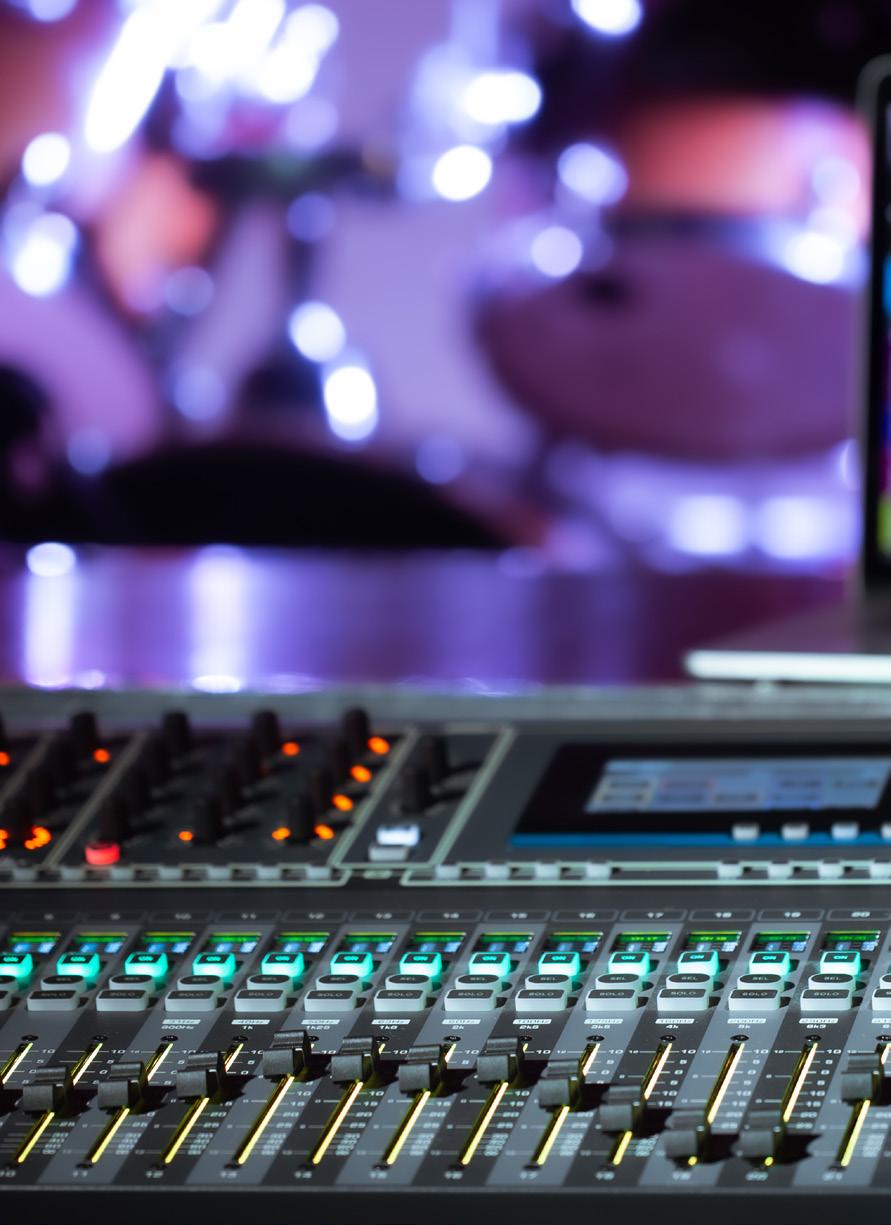
premises in via Asiago, where the central production unit is located, was fitted with an entirely fiber cable system in 2019.
How many hours of broadcasting are planned each day?
I would say 24 hours a day over 12 channels. Of course, not all of the channels offer live content, but Radio Uno, Radio Due, Radio Tre and Isoradio present this service. Overall, we offer over 100 hours of live content every day.
On the basis of your comments we may conclude that radio will certainly not become obsolete. On the contrary, it is very much in line with current trends and may be referred to as a ‘future-proof’ medium. Would you confirm this assessment?
With respect to the period when I started working in the radio industry back in 2015 the sector has undergone a vast transformation. Production has seen an extremely high level of growth over the last ten years and video programmes have been added. In short, let's say that the radio sector is doing very well. In my opinion this is because it combines a conservative approach and an innovative perception. Analogue broadcasting remains active

and no technical upheavals have been considered with regard to transmission and reception, however exciting innovations have been proposed.
We would be grateful if you could let us know what your view of the future is, but first of all could you speak to us about the ‘Metastudio’ site which we mentioned earlier on, from which the programmes focussing on the centenary celebrations are broadcast?
Yes, certainly. Well, it offers a glimpse of a future reality, let’s say, which is taking hold in the present scenario. It is a special studio which we set up with the intention of allowing presenters of a programme to start the broadcast alone, without any need for technical support. A studio will normally have a production unit, located in a separate environment. Our metastudio, however, is a simplified structure which does not implement any type of highly complex broadcasting. In a facile manner it supports programmes featuring a host and one or two guests, and with the possibility of independently managing telephone calls and external intervention. Moreover, there is also the possibility of going on air with a video coverage of events, thanks to the presence of cameras controlled directly from the presenter's microphone. Let’s say it’s a way of achieving maximum gain with minimum effort. In
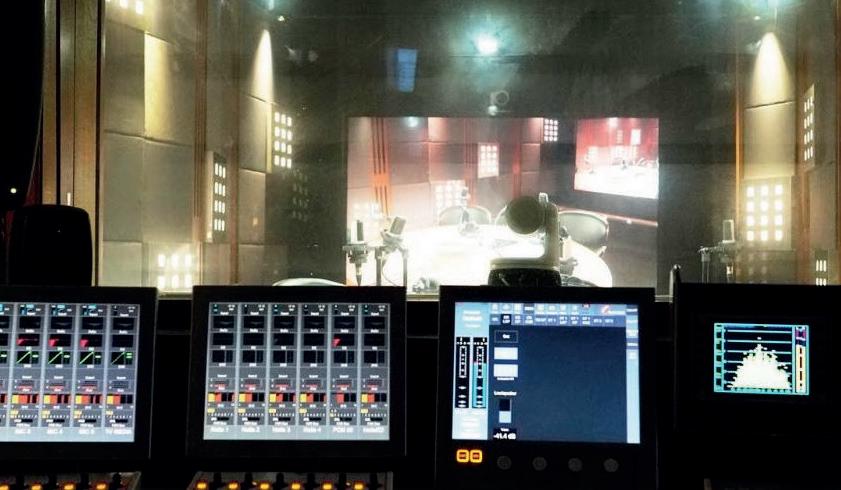

particular, the No Name Radio and Radio Live Italia stations are currently used for various Web-related broadcasts aimed at a generally young audience.
And now, to conclude, I would be grateful if you could offer us your opinion regarding what the future will be like for Radio and Visual Radio.
I would draw attention to the areas of sustainability, cloud technology and Artificial Intelligence. Essentially, I believe we are moving towards a progressive virtualisation of studios and production. Scenographic elements, such as LED walls, lighting fixtures, etc., are appropriate when the presence of a public audience is envisaged. Everything else can evolve towards the reality of a virtual studio, with a green background and software that generates a complete environment. This is a perfect solution especially for very small studios, in which a LED wall
may cause various problems. A small green screen and a virtual set would be a better solution.
Of course, we will have to work with content creators. In the same way, over a period of about ten years cloud technology will let us have a form of production and control that is virtualised and present in a single environment or in just a few locations. In practical terms we currently have an audio production unit for each studio. In the future, a single production system might supervise various studios, using cloud technology.
On a final note, Artificial Intelligence will be a fundamental pillar also in our sector, even though - in my opinion - this will occur more in terms of content creation. For us - the technicians and the ‘mechanics’ - the challenge will be to provide creative teams with the right technical solutions in order to fully exploit the immense potential of Artificial Intelligence!



Bruno Mercuri, President of ANIBA. ANIBA is a trade association of broadcasting and audiovisual TV technical production companies which was established in 2021.

Bruno
Mercuri, President of
ANIBA, the National
Audiovisual Broadcast Companies
,
Association
of
explains how the association brings together the leading companies in the sector to promote quality, ethics, and economic recognition in a competitive market
Today ANIBA counts amongst its members those companies which, together, generate almost 70% of the sector's turnover in Italy: Cinevideo, DBW Communication, Erreciesse Group, Hotspot, Live Sat, L'Opera, ONE TV, Videe, VideoB and Videosystem Production
What are the aims of the Association?
The principal aim of the association is to ensure that companies in the television broadcasting sector acquire adequate recognition within the production and supply chain of the Italian sports and entertainment media sector, in a virtuous context of free competition characterised by shared rules, transparency and an ethical approach.
A further condition closely linked to this objective is the protection of producers and broadcasters.
Recognition of the fair value of the services provided by technical production companies in fact guarantees the quality of the work carried out in full compliance with the law and the products that are broadcast.
Does a supply chain association really make sense today within a free-market context?
ANIBA represents and protects the professionalism, competence and technological quality of its members, promoting a more conscious self-regulation of the sector. It is our firm belief that a unity of purpose is the great strength of the association and that only together can we achieve important results for the benefit of everyone, including producers and networks, restricting an excessive recourse to subcontracting and the awarding of tenders according to the maximum discount criterion, which would tend to degrade the market. Our activity will lead to the recognition of an average value of tenders and, in pursuing recognition of the right
values, will improve relations between businesses and production.
You are active in a market that is extremely competitive and which presents a high technological value. Do you not think that greater representation would be necessary to achieve the aim of the Association?
The ANIBA ‘brand’ is a distinctive sign of reliability and seriousness and from the operational and management point of view, conveys a sign of value as is reflected in the work of our associates. Anyone strongly associated with these principles will find their space in ANIBA. We are already examining membership requests that we have recently received.
This year ANIBA will be present at the MAF for an important event. What can you tell us in advance?
ANIBA has commissioned the company Formules srl - in collaboration with the Bocconi University - to carry out an important research project regarding the TV broadcasting sector, and this will be presented at the MAF 2024 event. Considering its relevance within the international context and the specific type of audience and speakers from the sector who will be participating on this occasion, the Milano Audiovisual Forum has been identified by ANIBA members as the ideal place to host such an event.
This is a truly highly anticipated event, which will provide significant contributions in a discussion on the rules that are in place and the state of health of the market for the technical production of audiovisual content in Italy. In particular, attention will be paid to the recognition of the technological investments necessary to support the requests of the sector in terms of product and service quality, the professionalism of operators involved, who require adequate compensation, and professional training.
What are the most interesting aspects that emerged from the study?
First of all, I would like to underline that this is the first major study relating to the sector in its entirety that has ever been conducted in Italy. The analysis process, coordinated by Prof. Guido Guerzoni, an Adjunct Professor of the Bocconi University, explored the economic, technological, employment-related and training-level impacts of broadcasting on the country's economy. In our opinion, a comparison between the Italian and European markets is relevant in the context of sectoral policies, economic values that have developed, the remuneration of staff, technological investments and tax policies.
How do you plan to actively involve all stakeholders to define the rules and to ensure the quality of the services you provide?
In particular, during the presentation there will be a focus on the economic-contractual conditions underlying the activities of service companies and the economic-administrative limits within which they operate. The overview will include disparities arising among the various geographical areas of the country with respect to the possibility to access public funding.
As members of ANIBA we believe that if we want to envisage a future for the sector in general and for broadcasting companies in Italy, the initiation of dialogue and a serious exchange of views between all players in the market is an urgent requirement. We are certain that the presentation of the results of the study will be a stimulus towards achieving a collective form of reasoning within the supply chain that will see everyone involved, including the various institutions.
https://aniba.it/
Michele Fucci
LED technology has revolutionised the broadcasting sector, introducing new, creative and innovative solutions in television and film production. In particular, the use of LEDs in virtual sets has resulted in a significant transformation in the creation of virtual environments, offering distinct advantages with respect to traditional technologies

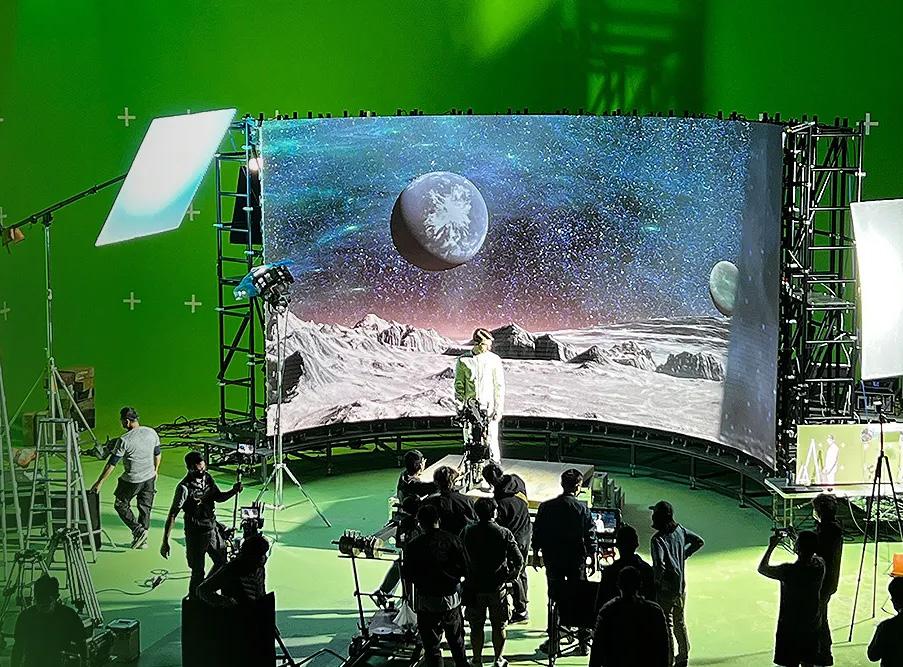
LED walls have become a key element in virtual sets thanks to their brightness, resolution and capacity to reproduce vivid and true, lifelike colours. This technology allows for the creation of realistic and immersive virtual environments, offering an image quality that is superior with respect to traditional forms of projection. The modularity and scalability of LED walls allow for an adaptation of the size and the configuration of a set in accordance with the specific requirements of each production, guaranteeing flexibility and versatility.
and disadvantages
The main advantages of virtual LED sets include:
• Superior image quality and a higher level of brightness: LED walls offer images that are sharper and brighter when compared to those produced by traditional technologies. A wide range of colours and enhanced chromatic fidelity: the capacity to reproduce a vast range of colours ensuring high fidelity makes virtual sets more realistic and engaging.
• Modularity and scalability - LED walls can be configured in a variety of sizes and forms, allowing for adaptation to the specific needs of each production.
• Reduction of production costs - With respect to traditional techniques, LED walls can reduce expenses relating to the construction and modification of physical sets.
• The generation of immersive and realistic virtual environmentsLED technology allows for the creation of virtual settings which will improve the overall visual experience.
However, there are a few disadvantages that should be taken into consideration:
• High initial costs
The initial investment for the installation of LED walls may become a significant factor.
• The need for careful calibration and maintenance.
LED walls require regular maintenance and precise calibration to ensure optimal quality is maintained.
• Possible flickering issues and the ‘moiré’ pattern effect
If these issues are not managed properly, visual artefacts may occur and this will compromise the quality of images.
The use of LED walls in broadcasting requires particular technical specifications, including:
• Resolution and the pixel pitch - Pixel density is critical for ensuring sharp and well-detailed images, especially when a camera moves very close to the LED wall.
• Brightness and contrast - An essential requirement is that LED walls are bright enough to compete with ambient lighting on the set and offer a high contrast for vivid images.
• Colour management and calibration **
- Precise chromatic reproduction requires accurate calibration of the LED wall.
• Synchronisation with cameras ** - To avoid visual artefacts, such as ‘screen tearing’, it is crucial that the LED walls are synchronised with the cameras.
• Thermal management ** - To maintain optimal performance, it is necessary to manage in an effective way the heat dissipation produced by the LEDs.
The future of LEDs in broadcasting is certainly promising, with constant technological improvements that will ensure further advancements. Constant development is envisaged in terms of resolution, brightness and the reliability of LED walls. The integration of technologies such as artificial intelligence and augmented reality introduces new creative opportunities for virtual sets, anticipating a future characterised by many innovations and new frontiers in the world of audiovisual production. By way of conclusion we may affirm that LEDs have revolutionised broadcasting, offering advanced solutions for virtual sets. Thanks to their superior performance and flexibility, LED walls have become essential for the creation of high-quality productions. The sector is preparing for an exciting future, characterised by further technological developments and new creative opportunities in the audiovisual world.
The world of professional broadcasting is undergoing a crucial transition phase, gradually abandoning Serial Digital Interface (SDI) standards in favour of IP-based solutions. This evolution, driven by requirements relating to flexibility, scalability and cost reduction, is redefining the technological landscape of the sector. Protocols such as NDI and SMPTE 2110 are emerging as viable alternatives to the historic SDI standard, offering new possibilities and challenges for AV professionals
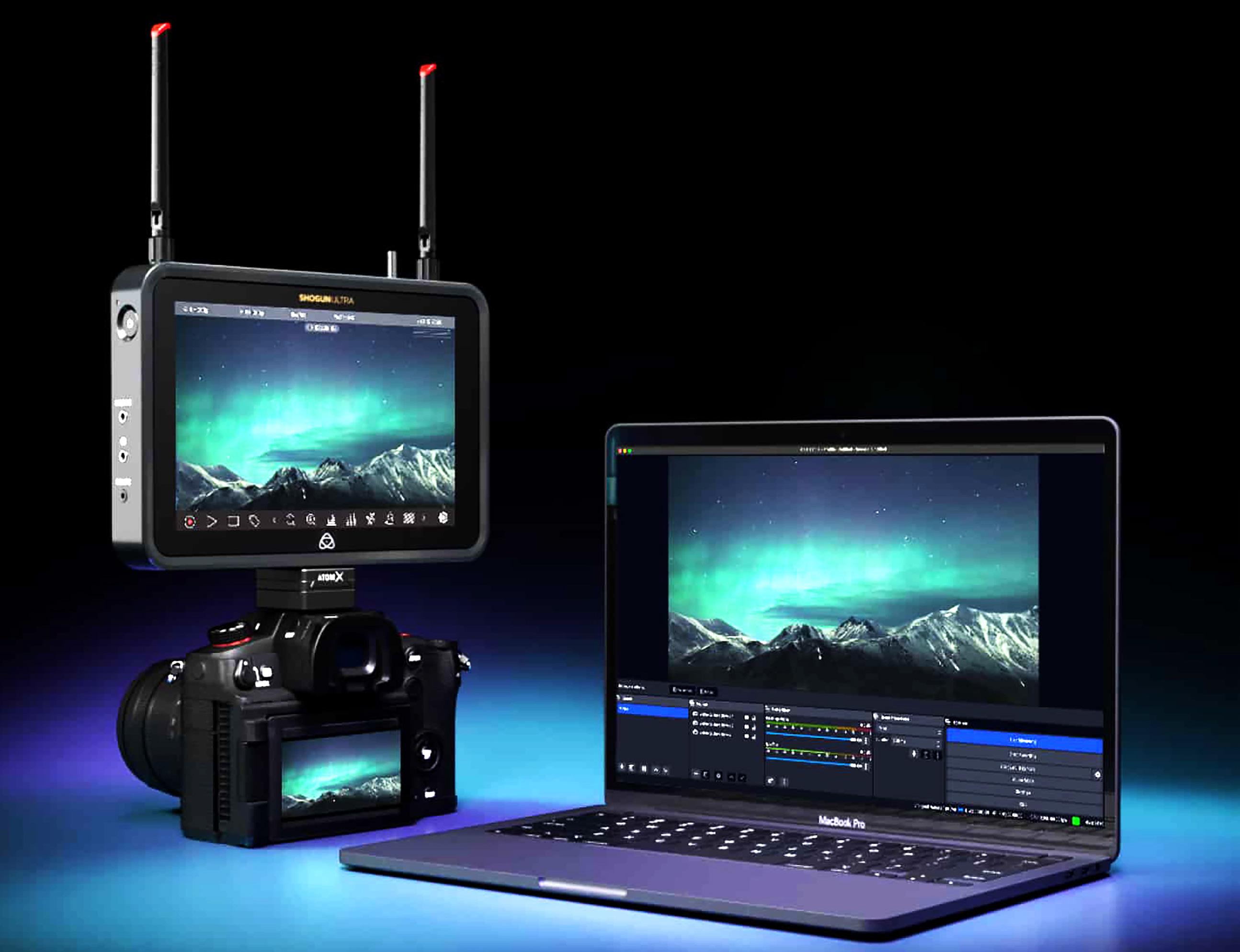
SDI: The standard of the past SDI has long been the predominant protocol in the broadcasting world, thanks to its reliability and its capacity to transmit high-quality video and audio signals over long distances. However, the increase in video resolutions and flexibility requirements has highlighted some limitations of this standard :
• High costs for dedicated hardware and coaxial cables
• Difficulties in the scalability of routing systems
• A lack of flexibility in integrating with IP networks and emerging technologies
The Network Device Interface (NDI), introduced by NewTek in 2015, represents a significant breakthrough in the broadcasting world. This royalty-free protocol permits the distribution of video and audio signals over standard Ethernet networks, offering numerous advantages:
• Reduced costs thanks to the use of existing network infrastructures
• Greater flexibility in signal routing
• The capacity to transmit alpha channels for graphics and titles
• Support for various video formats and frame rates
However, NDI also presents certain challenges:
• The need for a high-performance, dedicated Ethernet network
• Compression of the video signal which can affect quality
• The lack of its adoption on the part of many hardware manufacturers
SMPTE 2110: the IP standard of the future
SMPTE 2110 is a set of standards that define the transmission of video, audio and metadata signals over IP networks.
Unlike NDI, SMPTE 2110 is designed for the transmission of uncompressed video signals, ensuring the highest quality. Furthermore, it offers:
- Flexible and scalable routing on IP networks
- The separation of video, audio and metadata for greater flexibility
- Support for various video, audio and metadata formats
- Integration with synchronisation technologies, such as PTP
However, SMPTE 2110 still presents some disadvantages:
- High costs for the necessary hardware and software
- Constantly evolving standards, with possible future changes
- Greater complexity in implementation compared to proprietary solutions
The future of broadcasting: IP convergence
The transition from the SDI world to the IP dimension in professional broadcasting is now inevitable. An ever-increasing number of television and video production facilities are adopting IP-based solutions, thanks to the numerous advantages offered:
• Greater flexibility and scalability of routing systems
• Cost reduction through the use of standard hardware and infrastructure
• Easier integration with emerging technologies and software applications
• The possibility of remote production and long-distance collaboration
This transition will not be an immediate development, but will require a period of coexistence between SDI and IP systems [2]. However, it is evident that the future of professional broadcasting is closely linked to the adoption of IP standards, such as NDI and SMPTE 2110.
The world of professional broadcasting faces an exciting challenge, which is that of embracing IP convergence to exploit the benefits it offers in terms of flexibility, scalability and the reduction of relative costs. Protocols such as NDI and SMPTE 2110 are guiding this transition, offering innovative solutions for the transmission of video and audio signals over IP networks. While NDI represents a more accessible solution adopted by many software products, SMPTE 2110 is proposed as the IP standard of the future, guaranteeing maximum quality and interoperability.
The choice between the two solutions will depend on the specific needs of each structure, but it is clear that the future of professional broadcasting is closely linked to the adoption of IP standards. AV professionals will have to adapt to this evolution, acquiring new skills and familiarising themselves with IP technologies. However, the opportunity to take advantage of the flexibility and innovation offered by the IP convergence will make this change a necessary step to remain competitive in the professional broadcasting market.
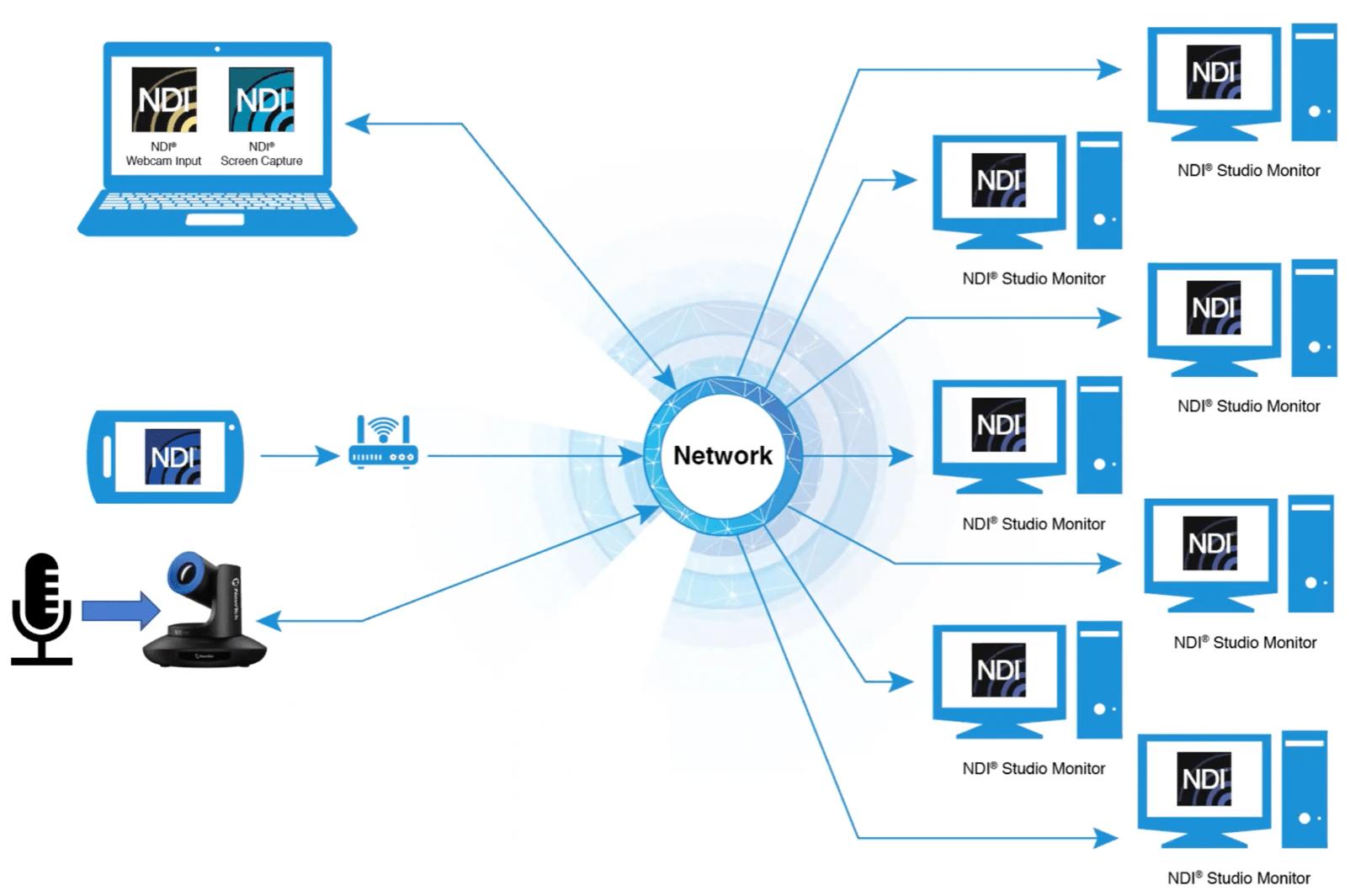
From the very outset of television broadcasting lighting has always been a fundamental element in this field. However, technological evolution has led to profound changes in the way light is generated, controlled and applied in television studios and virtual sets

Once upon a time, lighting in television studios was based on traditional incandescent or halogen systems. The former systems and devices were effective, however they did present certain limitations, such as intense energy consumption, the high level of heat produced and the short life of the light sources. With the advent of improved video formats, such as HD and 4K, the need arose for more advanced lighting systems capable of satisfying requirements relating to image quality. The introduction of LEDs represented an authentic revolution in the world of television lighting. This technology, initially adopted in backlighting applications for screens and signalling, rapidly gained ground also in the broadcasting sector. LEDs offer numerous advantages compared to traditional systems: greater energy efficiency, lower heat production, compact dimensions and durability. These characteristics make them particularly suitable for use in television studios and virtual sets, where heat management and energy consumption are critical issues. The evolution of LEDs has made it possible to obtain high-quality light sources, which are capable of faithfully reproducing colours and may be controlled in a precise manner. This has opened the path towards new creative solutions in the lighting of virtual sets, allowing for the simulation of natural light conditions or the creation of special dynamic effects. Furthermore, the integration of LEDs with advanced control systems has allowed for a more efficient management of lighting during production phases, reducing consumption and management costs.
Lighting technologies in television studios
The selection of lighting equipment for television production involves a focus on various parameters, principally determined by performance and operational criteria. Performance criteria comprise such aspects as power levels, lumen output, luminous efficacy, spectral output and the dimming curve. Operational criteria include adjustability, yoke and pole oper-

ation, shielding, maintenance and lamp replacement. Despite the evolution of technologies, the principles based on tungsten lighting remain relevant also for fluorescent and LED sources, now widely used in television, photographic and cinema lighting.
LED illumination: Pros and cons
Light-emitting diodes (LEDs) are an electroluminescent technology that offers various advantages, especially for coloured light. The production of white light occurs through two methods: RGB mixing and the conversion of luminescence. RGB LEDs combine red, green and blue diodes to create a wide range of colours, but with lower colour rendering. Luminescence conversion uses phosphors to improve the quality of white light, augmenting the efficiency of white LEDs. LEDs are available in several forms, including the T-type, SMD, and COB LEDs, each of which presents specific applications and thermal management requirements. High-power LEDs require effective heat dissipation to maintain optimal performance.
Advantages of LED Technology
With respect to tungsten, discharge, fluo -
rescent and plasma lamps, LEDs offer numerous advantages: they do not produce UV or IR radiation, they have a long life and they are compact, impact-resistant and require little maintenance. Moreover, LEDs present a low level of power consumption and high luminous efficiency and maintain a constant colour temperature during a dimming cycle.
These characteristics make them an ideal solution for applications in which reliability and energy efficiency are key factors. By way of conclusion, LED technology represents an advanced and versatile solution for lighting in television studios, with significant benefits compared to traditional technologies.
But the impact of LEDs has not been limited to the world of broadcasting. This technology has also been adopted in the lighting of live shows and events, where flexibility and the precise control of light are essential aspects.
LEDs allow for the creation of settings with spectacular lighting, with dynamic effects and saturated colours, and this being with reduced energy consumption with respect to traditional systems.
In the future, the evolution of LEDs will continue to drive innovation within the sphere of lighting for broadcasting and events. Integration with artificial intelligence systems will allow for the optimisation of lighting in real time, adapting it to production requirements. The use of high-power LEDs and the refinement of control techniques will make it possible to obtain increasingly realistic and engaging lighting effects.
Furthermore, the focus on sustainability will lead to the development of even more efficient LED systems presenting a low environmental impact.
To conclude we may say that the evolution of lighting in the world of broadcasting and the presentation of events has been driven by the introduction of LEDs.
This technology has made it possible to overcome the limits of traditional systems, offering advantages in terms of energy efficiency, flexibility and the quality of light. In fact, integration with advanced control systems has paved the way towards new creative solutions, and there will be further stages of evolution thanks to future technological advancement.
With a beautiful dedicated event, held on Wednesday 15 May at the STS Communication CR49 Studio at Bresso, in the Province of Milan, Audiosales made its official entry into the world of Virtual Production, presenting all of the product chains and brands it can offer for this fascinating and innovative sector

Matteo Fontana
The Broadcasters' Spring Summit was held on 15 May 2024 just outside Milan, the Italian city endowed par excellence with an avant-garde culture. Could Milan have remained in the background with regard to Virtual Production Technology? No, absolutely not! Audiosales sorted this out with a very successful event, during which the presentation of products suitable for this fascinating area of interest was alternated with moments of in-depth analysis with technicians and experts representing the various brands that participated in the event. From Canon to Netgear, from DirectOut to Green-Go and then Wisycom and Roe Visual, the range of brands that appeared on the catwalk made available by STS Communication did not fail to amaze visitors thanks to a complete and well-integrated selection of products.
And we may say that this is precisely the basic message that emerged on this day: the capacity of Audiosales - as a distributor - to provide all of the necessary solutions for 21st-century broadcasting, an activity increasingly oriented towards Virtual Production and, in turn, this is based on the use of LED wall technology.
The location: an important detail
It was very important to select an appropriate location for such an event.
The edifice and spaces would have to be the most suitable for an effective presentation of the main theme of the day and, that is, Virtual Production Technology. Visitors present at the venue were certainly quite amazed and fascinated by the STS Communication CR49 Studio, equipped with the best LED wall technology available. Virtual Production allows for the merging of virtual and real dimensions with extraordinary visual results, and this was adequately represented by the brands present on this occasion, all of which - and each in their own way - were capable of meeting the needs of the sector.
If the location itself proved to be a very important factor, the products illustrated were of course also vital elements. They were presented to the participants, who were curious to discover their value and investigate their potential with the assistance of specialist technicians at their disposal. The most interesting novelty was perhaps
the Topaz LED all-in-one platform offered by Roe Visual, a new entry in the Audiosales portfolio. Flat, curved or with a cubic design, the platform is designed with high-precision mechanical components and provides excellent visual quality, which will ensure reliable performance at affordable operating costs. DirectOut presented the Prodigy Series, a wide range of products designed for use in live sound, broadcasting, installation and recording setups. In particular, the Prodigy MP model, presented by Lorenzo Sassi, the Business Development Manager of DirectOut, is a multifunctional audio processor that will satisfy a variety of requirements in the professional audio sector, with a flexible I/O panel, sample-rate conversion and multiple synchronisation.
The unit provides up to 32 local inputs and outputs, while the hardware provides two MADI options and two network audio options. The Canon PTZ CR-N500 cameras, presented by Franco Palleni, a Pre-sales Manager of this company were accompanied by the RC-IP1000 controller
These devices are fundamental elements in a studio that focuses on Virtual Production Technology, which - in itself - and with its


various features, offers an opportunity to reduce the number of resources required to manage the equipment. In this sense, remote-control cameras, which can be easily controlled from a single location, are essential. Conceived for video streaming and production, the PTZ CR-N500 dynamic-range camera has a 1" 4K UHD sensor and a CMOS Dual Pixel system. It also has a 15x optical zoom and provides image stabilisation and Auto Tracking and Auto Loop functions. The RC-IP1000 controller supervises up to 200 cameras with a 7" multi-function touch screen and simple, user-friendly controls.
Netgear, presented by Michael Dijk, the ProAV System Engineer, presented its contribution in a decisive manner with its fully managed Pro AV M4300 1G and 10G-series switches , useful for supporting the large bandwidth required by SDVoE-enabled products, which deliver high-resolution video, multi-channel audio and control, with strong latency reduction. Suitable for any AV over IP installation, these switches are flexible and make life easier for installers. Finally, there was the interesting Wisycom
Audiosales has accumulated numerous brands and many proposals, offering a variety of perspectives. The following comments illustrate the firm's vision: Salvio Celotto, the VAR & Pro AV Sales Manager: “From our point of view broadcasting is a new market. The latest generation switches we have brought to the event were presented at the ISE 2024 exhibition to respond to the needs of system designs and the bandwidth required in this sector. Audiosales was the first distributor that placed a lot of trust in Netgear, years ago, and we are linked by a sense of mutual esteem and our common approach with regard to the attention paid to customers. We are happy with this partnership.”
As it is not possible to talk about Virtual Production without considering LED wall options, we should also reflect on the Roe Visual approach, as expressed in the words of Harro Veldhuizen: “Our LED walls can be used in both indoor and outdoor installations, and offer great quality in terms of images and versatility. We offer a light, slim design, with a brightness rating of 1500 nits. The modular design of both the power supply unit and the HUB is an essential factor. Virtual production is very important for us. Our products offer functionality and versatility; their value is highlighted and at this event they have been presented in a truly appropriate manner.”
modular system for four MCR54 receivers, illustrated by Giovanni Pigino
The system offers up to 16 channels, in a standard 19" rack unit, with RF filtering and advanced audio routing (analogue, AES3 and Dante). The 32-channel GreenGO Beltpack X portable intercom system was also presented.
This Ethernet-based system is equipped with a high-resolution colour OLED display, which reveals information on channels, activation signals and functions.
During the Broadcasters' Spring Summit event we met Marco Alterini, the Commercial Director of Audiosales, who commented on his work: “In actual fact we are not newcomers with respect to broadcasting. For years now we have been following many of the principal broadcasters in Italy. We recently increased the number of brands we can offer, so the goal is also to extend our range of clients.
The choice made by STS with regard to this event is important, because it can exploit a suitable location and they are one of our
clients. So, from our point of view, it is not so much a beginning but an important step forward.”
What principal innovative products are you focusing on?
First and foremost, those offered by Canon, with whom we started working back in January. PTZ cameras are being used more and more in the world of virtual production. And then we have Netgear, with its innovative solutions specifically designed for broadcasting, and Wisycom, with respect to microphones and signal management. We will certainly want to disseminate awareness of the quality of these products. Finally, the LED wall screen solutions have entered our universe. Roe Visual offers a diverse range of products suitable for both rental services and fixed installations. The LED sector is a market in which it is not easy to differ significantly with respect to competitors. We have decided to focus on quality, even though this implies higher prices. Roe, on the other hand, offers a premium-level service through its assistance and post-sales services."
www.audiosales.it
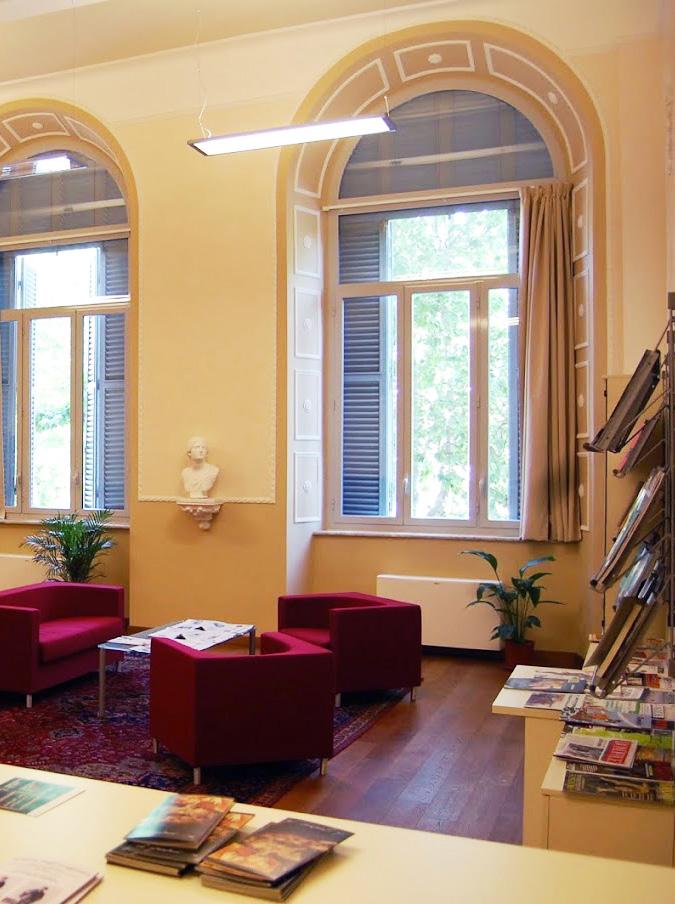
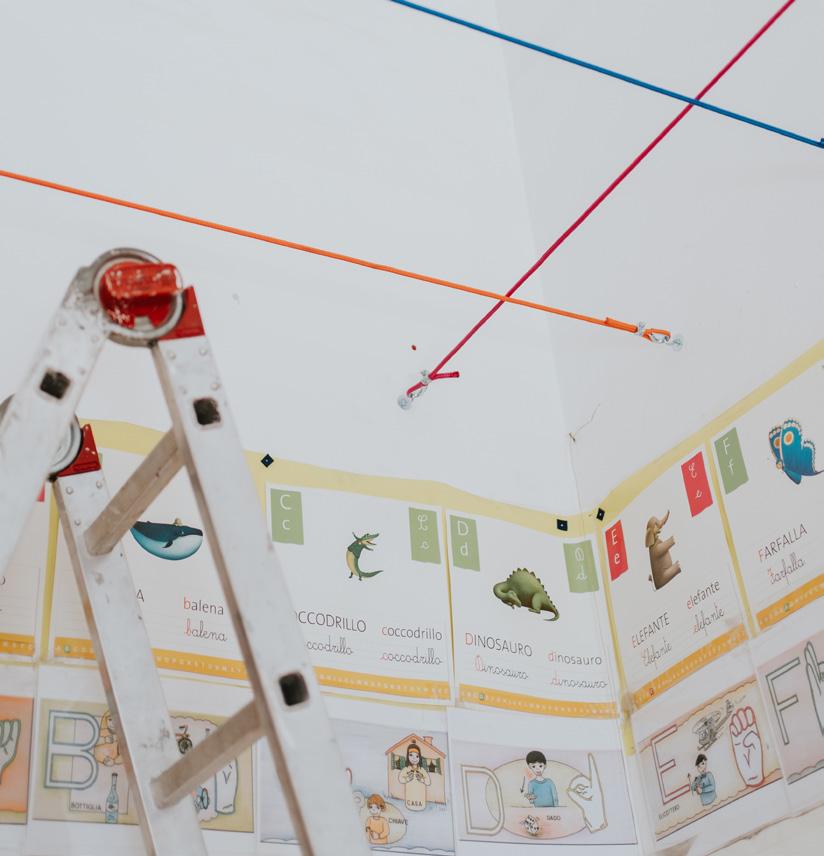
The State Institute for the Deaf (ISSR) in Rome is an important centre for research, consultancy, training and updates relating to the condition of deafness. The institute also comprises special schools dedicated to subjects who suffer from hearing impairments. Founded in 1784 by the Abbot Tommaso Silvestri and located in via Nomentana, this school was the first institute in Italy to be dedicated to individuals with hearing impairments and those affected by deafness, and is still an indispensable point of reference for those who suffer from such disabilities.
In this delicate context, Auris Populi, repre -
Yes, it's true, every installation is a challenge ... but some installations are more challenging than others! And this may be said with regard to the classroom created by Auris Populi at the State Institute for the Deaf in Rome
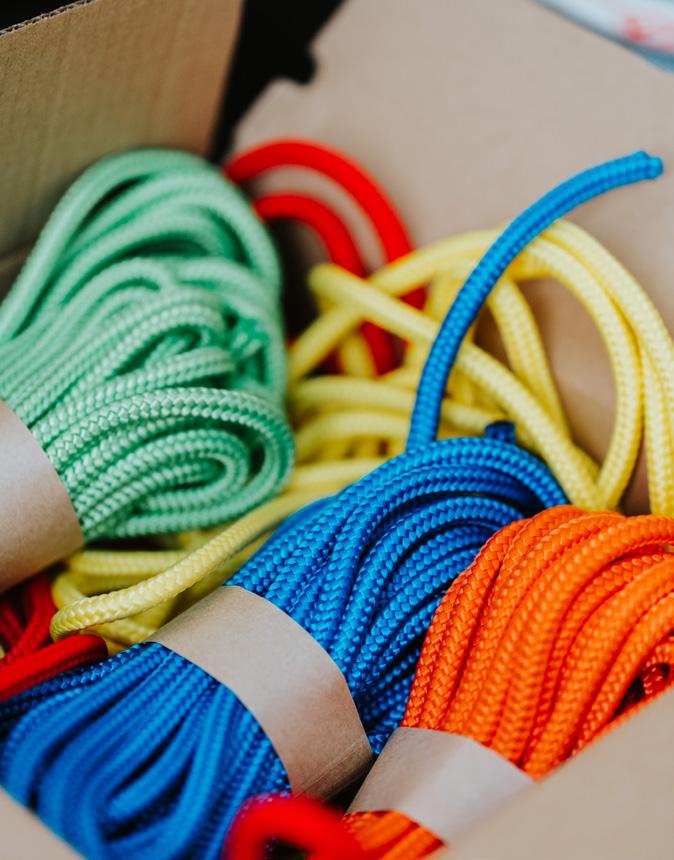
sented by its administrator Marco Itta and its technical director Sergio Scarpellino, has designed and implemented a system that is unique of its kind with respect to both the selection of products and the solution relating to its application, and which required more than just a pinch of … Italian creativity!
The type of technology that was chosen Before we delve more deeply into the solution devised by Marco Itta and Sergio Scarpellino we should however reflect on the Contacta V-Series system, distributed in Italy by Audiosales, which, from the very beginning, was the chosen
solution for the space within the ISSR. So, what are we referring to? Basically, it's a ‘hearing loop’ which provides a direct link to audio sources such as microphones or audio dissemination systems to help people with hearing impairments to hear voices or sounds clearly. After being detected by a microphone, speech is in fact converted into a magnetic signal by an amplifier and transmitted to users by means of a hearing loop radio. The signal is picked up by a telecoil located inside the hearing device (personal hearing aid) of an individual user, who will then be able to hear clearly. So, this is a widely-used system for communicating on a one-to-one basis with all hearing-impaired listeners present in a particular space, such as a school classroom. The V-Series Contacta hearing loop system installed in a classroom of the primary-school section of the Institute for the Deaf in Rome forms part of a pilot project the final objective of which is to equip all of the classrooms of the Institute with a helpful system for hearing-impaired children. The system comprises three types of products: first and foremost, V15A-EU is a compact driver with an integrated phase shifter, a class D amplifier and CPU capable of ensuring maximum performance. The V15A-EU hearing loop driver allows for the production of a realistic quality of speech and a high level of reproduction for music, and it is explicitly designed to support people with hearing impairments.
The system is completed by an IL-RX20 loop listener provided with headphones and the fundamental CABLE-1.0TRI induction loop cable (a more extensive explanation of the use and purpose of an induction loop is provided below).
Solutions proposed by Auris Populi Auris Populi, a lively reality in the professional audio sector, was established in 2010 at the initiative of its founder and current administrator Marco Itta. Today the core business of Auris Populi is the design and installation of audio systems and the provision of relative technical assistance. For the Institute of the Deaf in Rome the company found itself faced with a particular problem. It had to determine how it should set up a system that is usually installed in flooring within a building in which it was not possible to carry out such a radical form of intervention, due to both the budget and also environmental and structural issues. We arranged an interview with Marco Itta, who commented on the firm’s solution: “It was an ‘egg of Columbus’ situation, let's say: as we couldn't install the wires at ground level, we would have to put them in place somewhere up in the air! We thought about mounting the cables on the ceiling, and this was the hard nut that had to be cracked. My technical director Sergio Scarpellino had to sort everything out. He accepted the challenge and, of course, he overcame the difficulty with flying colours!”
The induction loop is in fact created using a cable with a 1 mm cross-section which has to stretch across the entire space where sound has to be introduced, creating a sort of auditory ‘bubble’. Auris Populi's solution consisted in the assembly of a network of coloured cordage, which moreover represents an excellent aesthetic solution for a primary school classroom. The induction loop cables would run across this network.
Marco Itta conveyed a fully comprehensible sense of satisfaction:
“Of course, the idea can also be proposed in future in other locations that present the same problem. Refurbishing a floor is no small undertaking and it is quite understandable that not all schools can afford a request for this type of intervention, also considering the duration of the works. I was very pleased to learn that Contacta, the manufacturer of the system, also complimented us with regard to the installation!”
When design and installation go hand in hand
Marco Itta further enlightened us with
a few more comments: “An important point to underline is that we are not only installers; we also have a design studio. This allows us to come up with the most suitable solutions for each particular situation. In the case of the Institute for the Deaf in Rome the challenge was to find an appropriate way to lay the cables. We also thought about a duct along the side walls, but there would have been moments of interference in the next room. In the end, our intervention turned out to be a brilliant solution. We installed an overhead array of coloured nylon ropes.
The use of ropes allowed us to avoid the use of rigid suspended structures, thereby maximizing safety and shortening the installation times.”
But how was the Contacta V-Series system identified?
“The manufacturer is one of those operators who - in our opinion - are the most experienced and have acquired a significant presence at the commercial level in Italy. And then, thanks to the information
The induction loop
contained in the technical report received from the manufacturer and thanks to the particular installation system that we planned and created internally, the installation was relatively simple. The support of the technical department of the supplier Audiosales was also a significant factor, which helped us interpret the project data and refer to the available information to create this specific application.”
The teachers and students of the ISSR who have already had an opportunity to experience communication via the Contacta hearing loop have given positive specific feedback regarding an improvement in comprehension on the part of children. Moreover, the ease of use of the system was also definitely well appreciated as it fits naturally into the scholastic environment and enhances the possibility to communicate on the part of teachers and students.
www.audiosales.it /www.audiosales.it/marchi/contacta https://aurispopuli.com/
What is a ‘magnetic induction system’ or ‘induction loop’?
In practice, this is a magnetic amplification system for hearing apparatuses. In a well-defined environment the system is linked with the listeners' personal hearing aids, allowing for easier and more effective reception and comprehension of audio stimuli. A magnetic loop system consists of an audio source (microphones, content playback devices, professional audio systems, home cinema systems, etc.), a signal processor/amplifier and the fundamental loop cable, which defines the borders of an area of magnetic signal diffusion that activates the individual hearing aids. In short, this is a well-defined ‘audio bubble’ - a primary school classroom in the case of the ISSR - within which a source signal (the teacher's voice) is received simultaneously by all of the hearing aids present in the area, without any need for physical connections or cables, apart from those that are common elements of the loop.


With regard to the initiation of processes relating to the occurrence of transformation and innovation in companies, in schools, within public administration structures and in the retail sector and also in the dynamic world of live events the ever-evolving approach of Hikvision in the professional audiovisual market aims to ensure it is the ‘right partner’

It is quite evident that the adoption of a clear focus and reactivity have been two essential concepts characterising the activities of Hikvision. These attributes were recently introduced in the Italian market and relate to visual communication, collaboration and the conference sectors. After just one year, the firm's specialist approach and its capacity to promptly respond to growth within the sphere of technological innovation have certainly had a positive effect. Maurizio Coates, the head of the Hikvision Transmission & Display business unit, pointed out that this strategy derives from the aim to intervene as a ‘total solutions provider’.
Specific market approach strategies also come into play and involve the consolidation of distribution channels and relationships with system integrators. Of course, the expansion of the business, ranging from permanent installation to rental services, is an important factor. These are promising sectors that present a strong growth potential, together with the evolution of LED technology currently used in applications that were inconceivable until only a few years ago, in terms of budget variables and integration levels.
A year ago we spoke about the launching of a business unit dedicated to visual and digital communication. What would an initial assessment reveal? How are things proceeding in this sector? How have Italian clients perceived the services that are offered? Everything is going very well. We dedi-
cated the year 2023 to the creation of the distribution channel, establishing agreements with vertical distributors of AV Pro solutions, and we may say that we have acquired an appropriate territorial spread with partners who guarantee a high level of quality in the pre- and post-sale phases, the management of stocks and with respect to other important aspects. We are currently collaborating with three distributors for permanent installations and two other entities that specialise in rental services.
The reason for this is that they are unrelated systems that present different requirements or two parallel dimensions, let’s say, which are unlikely to influence or have an effect on each other. We believe that a fundamental factor is the capacity on our part to offer Italian system integrators the right interlocutors for every need that arises. Considering rental opportunities in particular, we should note that our range of services was introduced at the end of 2023, simultaneously reinforcing a prompt delivery system within the Italian territory. Unlike other vendors, who rely on foreign stock, Hikvision provides a prompt delivery system, at our own warehouse and at the distributors' depots, also for the rental systems. In the near future the next phase will involve the development of the transmission and display business unit, with the introduction of new operators dedicated to the development of this sector and the strengthening of other operative areas.
With regard to changes occurring in the market, on the basis of your own experience what are the strengths and
weaknesses of the Italian AV sector?
The main change - and potential weak point - is determined by the ‘technological swap’. More specifically, the rapid introduction of new production processes and new levels of product performance augment the risks of a premature ‘ageing’ of stock for Italian companies that import hitech solutions involving significant investment. However, in our own case the risk associated with the speed of a technology swap is initially assumed by the vendor, who, through a careful management of local stock will be able to mitigate critical issues for distributors and clients at the national level.
With regard to respective advantages a progressive expansion of the relative LED display customer base determined by greater economic accessibility is certainly worthy of note. Many commercial entities - and also those in the medium-small category - can afford to install LED walls, digital signage display technology and large-format screens at a cost lower than that typically encountered in the past. So, prices are not as high as they used to be but the rate of distribution in partially unexplored markets has increased, generating for us opportunities that should not be overlooked.
Transmission & Display business solutions are principally aimed at the retail, educational and corporate sectors, however you have focused attention on rental services. Are there particular developments that should be considered in these areas?
With regard to retail, we are in fact seeking to exploit the potential of this business at an increasingly pervasive level, in addition to the already well-consolidated sectors of active chains and luxury services. The educational sector, on the other hand, remains quite stable and is supported by funds provided by Italy and the EU. We manage and monitor the situation very well, with a valid network of over 35 system integrators whom we also assist in the drafting of specifications and project plans. Furthermore, also in this sector, about a year ago we started supplying video and LED wall systems which are used, for example, in main lecture halls. This confirms that LED technology is advancing practically everywhere: from the corporate and business sector, with respect to meeting rooms and showrooms, to new testing grounds within the educational sphere.
In the case of corporate applications, the situation is somewhat more complex. The development is, in part, linked to LCD Retrofit technology, with the replacement of video walls and the introduction of LED wall systems, but in some cases even moving on from video projector systems to LED applications. Equally interesting are the interactive and touch-screen monitors introduced in educational settings. This is because the relative technology and devices improve user experiences at meetings, whether these occur entirely in person or are of a ‘hybrid’ nature. The technology offers the possibility to take notes and install apps, and also to exploit their potential through the use of computer screens, with integrated operating systems, applications and video-conferencing accessories. It is at this level in particular, in the corporate ecosystems, that we are able to convey a sense of the global nature of our services. With regard to security and safety, video
walls, LED walls, interactive monitors and video conferences, thanks to our complete products we may indeed present ourselves as a 'total solution provider'. As a single source of technological applications operating through a single platform, our HikCentral surveillance and management system centralizes the control of installed systems and devices.
Considering the public administration sector, is the Italian National Recovery and Resilience Plan (PNRR) having an effect and really unlocking digital innovation? We are dealing with a constantly evolving process. We observe the results on a daily basis, with the ‘revamping’ and renewal of a series of products that has not been modified for many years, but it will take time. We should also note that the replacement of hardware does not necessarily imply a form of innovation. A focus on technological factors must go hand in hand with the
adequate training of people with respect to the manner in which the systems should be used and, above all, the digital potential must be fully exploited. System integrators who collaborate with our distributors are participating in tenders for the renewal of public administration in this respect and we are ready to accompany and assist them in the best way possible.
What novelties have arisen in terms of products?
First of all, with regard to LED technology the most significant innovations concern the range of rental products and services, with high-performance indoor and outdoor solutions that are increasingly easy to transport, assemble and disassemble. Developments occurring in the field of collaboration and video conferences are also interesting. We do in fact offer medium and medium-to-high range products, such as soundbars with the Android operating sys-

If digitalisation is transforming the manner in which people live, work and study, interactive monitors are able to satisfy daily requirements relating to communication and collaboration in various fields. The Hikvision Interactive Flat Panel Display series of products in fact offers flexible and multifunctional applications with ultra-4K resolution, direct writing on screens, software for integrated whiteboards, free projection and the integration - presenting a varying degree of complexity - of video-conferencing accessories. Moreover, centralised management improves their operational efficiency with the rapid setting of parameters, the display of information, launching videos and installing apps.
During online meetings, interactive monitors integrate a number of high-quality components. Ultra-HD images and clear audio systems help team members interact closely with each other, wherever they may be. With regard to learning experiences the Hikvision system can exploit professional camera systems with AI and leading-edge software. Furthermore, the integrated Classroom Hub solution virtually unites multiple classrooms, both real and digital, bridging any possible gap between students and teachers.
tem and artificial intelligence and 48-Megapixel webcams. Again, with respect to this market, I would like to draw attention to the evolution of software. In 2024, a platform designed to simplify the activities of end users will in fact become available for the technological and strategic management of meetings. All you have to do is launch an application and it will automatically connect to the various scheduling calendars. We will no longer have to worry about how to participate in a meeting - using Zoom, Meet, Teams or other tools - because the software will operate autonomously to meet the requirements established in the timing of a meeting. Finally, there will be new facilities relating to the use of interactive monitors within the sphere of educational and corporate activities, with the series of Hikvision Interactive 98” Flat Panel Displays.
By way of a conclusion, what would your assessment be of your firm's participation in trade fairs and special sector events and its objectives for the future. The Didacta trade expo, for the educational/training sector, and the MIR expo, for rental services and the AV Pro world in general, may be certainly recognised as key events. I would place importance on the latter event in particular, at which we have now participated directly for the first time. It was a successful occasion, especially in terms of the opportunity to strengthen relationships with our partners and system integrators. Didacta, on the other hand, was in fact already a regular meeting point. While the event is actually aimed at a different audience and, that is, final clients in the scholastic world, we consider it useful for establishing contact with the real ‘consumers’ of our technological products. As far as future objectives are concerned our intent is to increasingly support the network of distributors within our territory of interest, communicating with system integrators to support partners in the quotation, design and sales phases, and also with respect to problem solving and troubleshooting activities and the proposal of targeted services. So, in short, the distributor remains a leading actor in our strategy and, likewise, the system integrators and end customers, to whom we turn to generate a ‘virtuous circle’ encompassing the daily work of our distribution channel, are prime points of reference.
www.hikvision.com/it
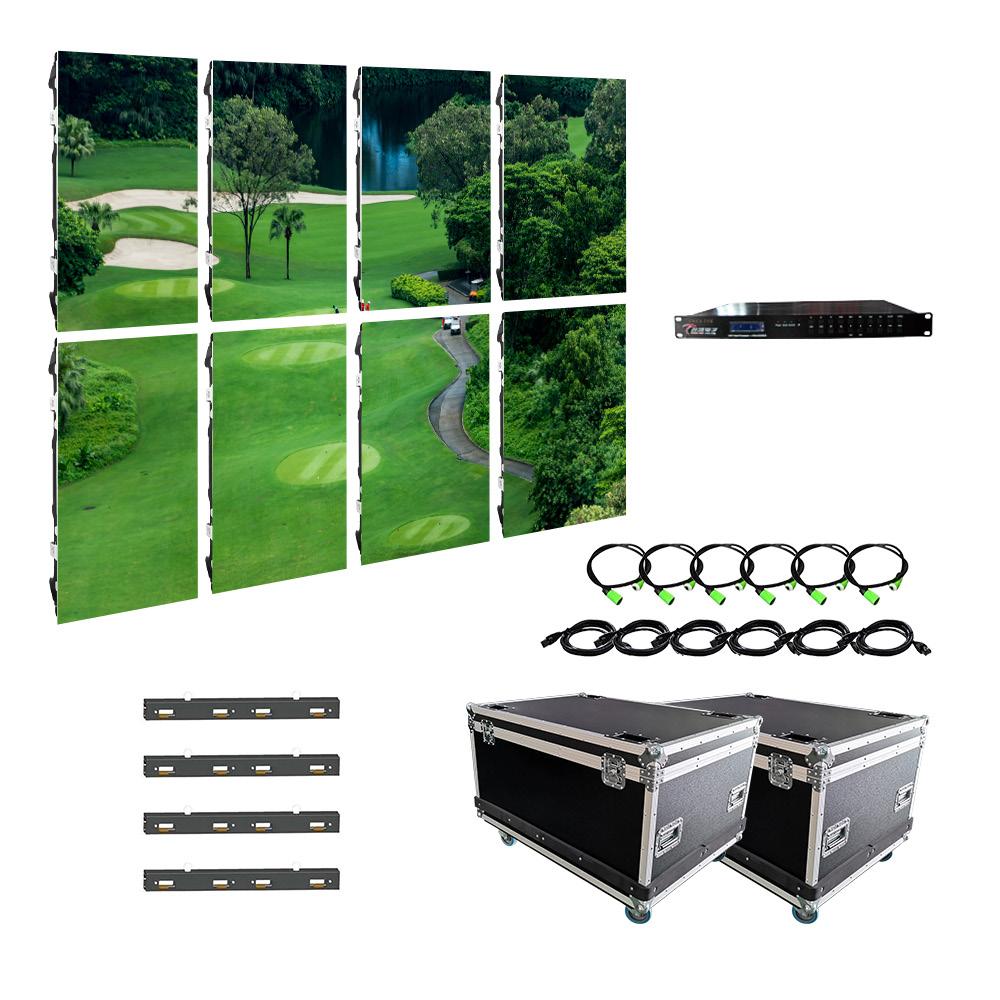
Another new product made available in 2024 is the LED wall range for the rental market, with various models dedicated to both external installations and internal spaces. What are the features of these displays? Proprietary Pix Master image processing technology improves content transmission with no loss of detail. Pix Master automatically adjusts brightness and the grey scale and in this way the smart algorithm also helps to reduce the energy consumption of the display by approximately 20%. The rental LED walls are also user-friendly as the integrated controller supports management with multiple HDMI inputs, while Hikvision's LED O&M software guarantees automatic maintenance, status monitoring, the presence of any possible alarms and provides guidance in the configuration of problems and troubleshooting. The system also provides a portable remote control device with which it is possible to manage display modes, brightness levels, automatic dehumidification and blue-light filtering.
Indoor LEDs are characterised by a dual-power design which ensures greater stability and safety. It should also be noted that the lightweight, durable, die-cast aluminium cabinet increases the precision of the system. The connector, which is capable of moving slightly, also ensures the flatness of the LED module. With regard to the advantages of outdoor versions, the excellent degree of heat dissipation allows for operation without air conditioning up to 60°C, with constant high-levels of performance thanks to the IP67 protection class. It is also worth noting that the precise distribution of electricity for the RGB LED chips reduces the power consumption of the display by 50% and more.
An exclusive overview provided to Connessioni, highlighting details of the new partnership established between Q-SYS and Shure for the integration of microphone components into Q-SYS conference systems. For the Italian market this endeavour is supported by the specialists of Prase Media Technologies
Simplification, interoperability and user experience are the key words of the most successful forms of technological collaboration deriving from the effective integration of know-how and the analysis of customer requirements. Such an achievement may be identified in the case of the companies Shure and Q-SYS, which have joined forces to augment the efficiency and quality of conference systems. In fact, thanks to Shure's recent participation in the Q-SYS Technology Partner Program numerous certified plugins are rendered available to AV professionals within the framework of this ecosystem. This means it is possible to control the Shure microphone component directly from the Q-SYS Designer Asset Manager platform, optimising the timing and the complexity of projects. At the same

time, the decision on the part of the AV Pro market to follow the path towards achieving a higher degree of interoperability between brands is clearly motivated. The implications and opportunities deriving from this innovation, which may be seen as significant especially in the case of corporate, educational and public administration environments, are core issues in our ‘double’ interview with Samuel Apostoli, the Market Development Manager of Shure, and Luca Battistelli, the Systems Sales Manager of Prase Media Technologies, which operates as the distributor of the firms Shure and QSC in the Italian market.
Connessioni - So, let's start by reflecting on the agreement. How and why was it established?
Luca Battistelli - From the operational
point of view, the integration was already present and the development was officially approved by the two companies a few months ago.
Progress was stimulated by the essentially ‘open nature’ of the Q-SYS platform, which already permitted interaction with third-party devices and which identified Shure as a valid partner in the development of a common vision. At the present time, the integrator has a single software platform from which, in this specific case, it is possible to control and manage also the microphone system. And it's a very thorough form of integration. The Shure interface is to all intents and purposes available within the Q-SYS software.
Samuele Apostoli - A further advantage, of a practical nature, is that of acquiring a tool

Analysing the technical aspects, Shure and Q-SYS have jointly developed the integration of the Shure MXA920 Ceiling Array microphone plugin with a Q-SYS Certified badge. AV/IT professionals are thus able to download the microphone Control Plugin directly from the Q-SYS Designer Asset Manager, within the Q-SYS Designer software. This represents a form of advanced compatibility for more modern and collaborative conference projects.
Apart from this, the MXA920 microphone can also be selected in the plugin Q-SYS Automatic Camera Preset Recall (ACPR) version 3.1. This means that, in just a few steps, the device becomes an integral part of the Q-SYS camera control system, without the need to install additional plugins. Direct interaction of the microphone with the open lobe, via the camera system, activates the automatic focussing of the cameras on a person who is speaking. As Samuele Apostoli points out,“This operation would normally involve integrating third-party controls, writing code, and other complex steps. With this certification, however, it is also possible to install and manage in a less complex way the most challenging systems, moving on from the concept of programming to that of configuration”.
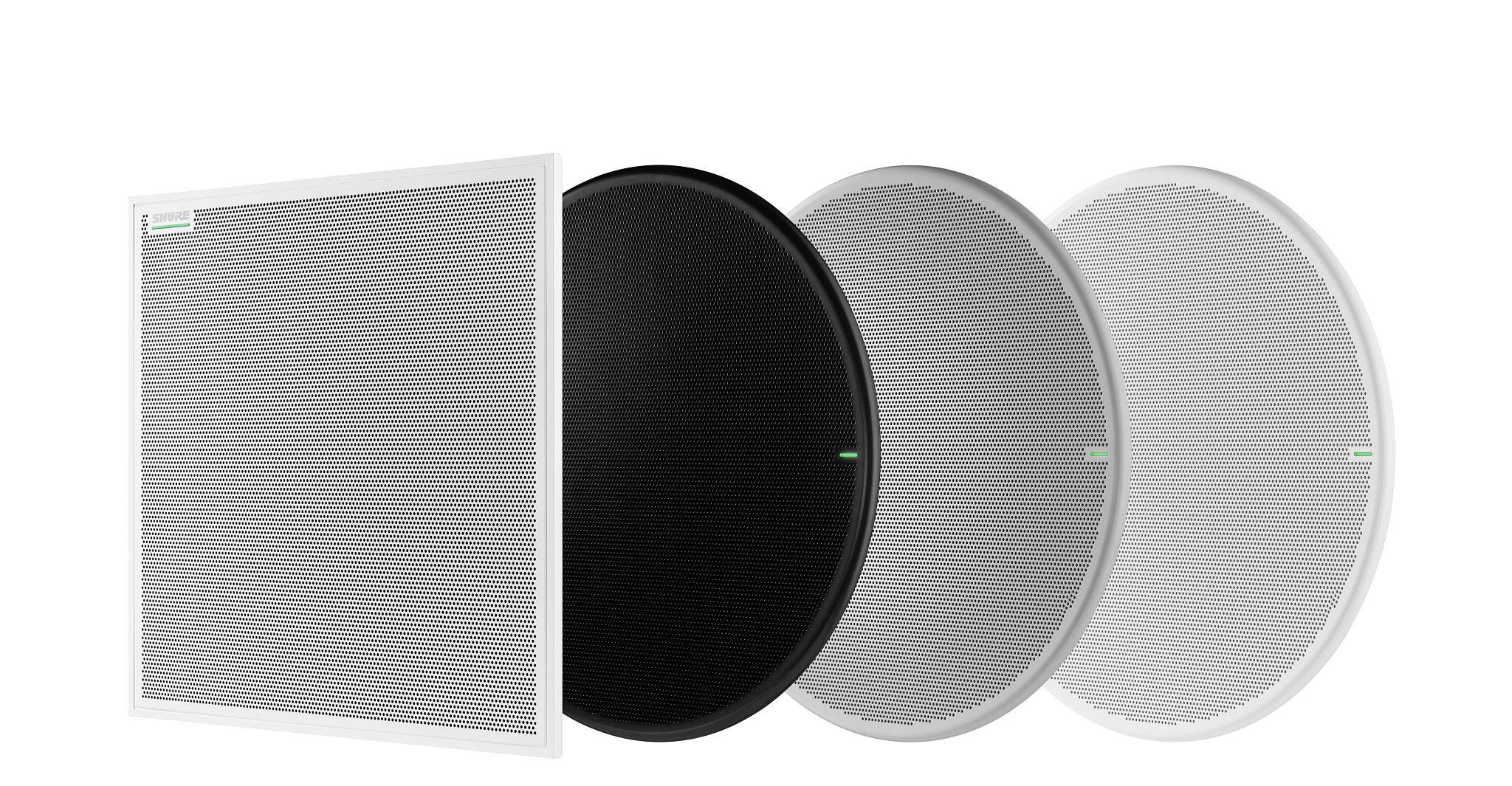
that is easier to work with. There is a single interface, from which one can manage the complex system without integrating other products and brands. Despite the presence in this field of a variety of AV technologies, the notion of a single technology provider also favours the relationship with clients and the user experience. I'll illustrate this point more clearly. Shure produces really high-quality microphones, but it does not offer process solutions. With regard to conference settings, complex systems come into play that will also require third-party products. This is why we believe it is important to offer solutions which may be intrinsically integrated and will facilitate the creation of large systems, using multiple microphones - perhaps in a set of different rooms - creating original, customised scenarios.
Another aspect is the opportunity to enable functionalities that will render meetings and lectures even more immersive, at sites where an automatic identification of internal spaces is normally adopted, thanks to the interior ‘domotic’ control of the system. The aim is to offer a sort of ‘all-in-one’ brand to create super systems that are guaranteed to provide a wonderful experience for all participants.
Which applications benefit most from this innovation?
LB - Well, we are talking about video-conferencing systems for medium and largesized spaces, auditoriums and buildings with various halls/rooms that have to be managed from a central control point. In the corporate sector, however, many companies are changing the layout of their meeting rooms. We are no longer in that period when the classic boardroom/meeting tables were used, surrounded by a lot of chairs. The current trend is to make use of open, modern spaces, often enhanced by the presence of sofas that can be easily moved, depending on the style and degree of formality of the meeting.
In environments such as these the partnership between Shure and Q-SYS allows for the use of overhead ceiling microphones integrated with video cameras and also the geographical coordinates of the speakers, in order to create innovative solutions in less time.
Among the custom applications there are also university structures and spaces. For example, the University of Turin decided to adopt our technologies for the AV systems in all of its lecture halls and learning spaces.
So far we have spoken about technical aspects. What does the acquisition of a ‘Q-SYS Certified’ badge imply in commercial and strategic terms?
SA - Apart from anything else it confers the possibility of using a plugin that is certified by both manufacturers. In fact, normally, the manufacturer will independently develop an integration, a code or a plugin and self-certify it. In this case, however, the plugin is guaranteed by both companies, and they developed it together. In any case, the integrator will still have to intervene to adapt the system, but the operator in question has an extra guarantee in terms of product quality and will be thus less preoccupied. For the end user - in both the short and long term - this will result in greater stability and operational continuity.
LB - From the commercial point of view the advantage of Prase's support in Italy is a focus on this integration, creating added value. In the design phase and also during a commissioning procedure our specialists offer additional support to system integrators and, together with the Shure and Q-SYS certification, this results in an opportunity to offer clients a series of solutions also exceeding the limits of the two individual brands in question. This means that projects can be completed with the entire range of technologies required in a professional AV installation through the assistance of a single supplier. Shure and Q-SYS, in fact, collaborate in their provision of a truly extensive product portfolio and this represents the key lever for undertaking particular projects and broadening the horizons of their business.
In short, Shure and Q-SYS are a prime example of the currently evident evolution towards the achievement of interoperability between brands and a software-based philosophy in the AV world. SA - Yes, exactly. This approach stems from the sharing of common aims between two partners that prefer to expand the possibilities of integration, to the benefit of retailers and customers, rather than remaining closed in on themselves and their own technologies. No one can become a specialist in every field. Microphones, for example, have evolved from basic standard products to those featuring today's technology. However, without having established an agreement with other manufacturers it would be impossible to allow our customers to contend in a perfectly reliable manner with a far higher number
of projects compared to the past. The same ideal level of synchrony occurs with regard to the relationship between software and hardware. In fact, we are engaged in the implementation of a software licence catalogue and introducing new features in our hardware. The objectives are to simplify the work of installers, increase possibilities relating to configuration and improve the user experience in conference spaces. For this reason, the partnership between Shure and Q-SYS is still evolving. Other plugins will arrive soon and, again, it is the result of a synergistic approach.
LB - The evolution of software licences also has a positive effect on us - the distributors - because it allows us to approach new players, such as audio-video networking integrators. In fact, we are able to provide solutions we might define as entirely software-based, as the essential hardware, which is obviously present, comprises standard industrial PCs in which the Q-SYS operating system is installed. We might define it as a sort of generational shift. Software solutions become disassociated from those relating to hardware; they become flexible and present a ‘democratic’ nature, let’s say. Furthermore, given the fact that systems can be reconfigured by adding licences, without dismantling the devices, stock optimisation is enhanced. This applies to both the distributor and the integrator, who is no longer bound to hold on to numerous spare parts for the maintenance service.
Prase thus finds itself distributing two collaborative, forward-looking brands. More than simply a coincidence, might we define it as the ability to select the right partners?
LB - Seen in this way, it would appear to be a coincidence. Shure started the certification project with Q-SYS at the very same time when the distribution agreement with Prase was made official. These moves were evidently not connected, but the opportunity generated by Shure and Q-SYS is not a random act, but rather the result of a choice to link up only with companies with which they share particular values and a vision of the market.
We thus cooperate with two companies that are moving in the same direction, and we deem this endeavour to be appropriate. We support them with a view to reaching new targets with respect to professional operators. For example, the operators in
question would include those who have great experience in the field of microphones and audio systems but are not so highly aware of the operative capacity of licensing and networking software. Inversely, in the AV sector it is essential to include operators with skills regarding the relative process. This convergence, which began more than 10 years ago, will most certainly be completed. There will no longer be limits, and there will no longer be a clear distinction between AV and networking. We are here, committed to continuing the development of great integration projects.
www.shure.com www.qsys.com www.prase.it
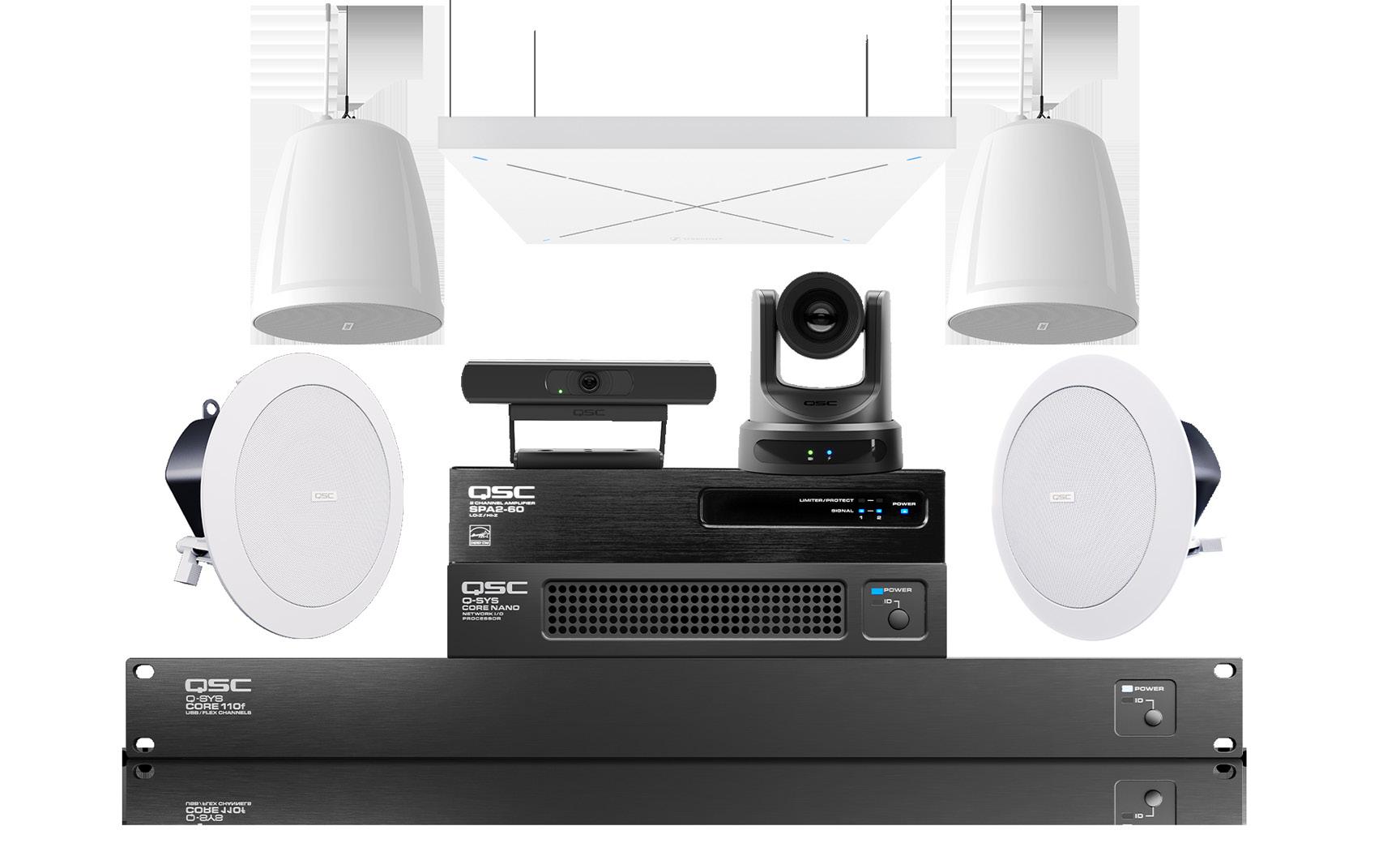
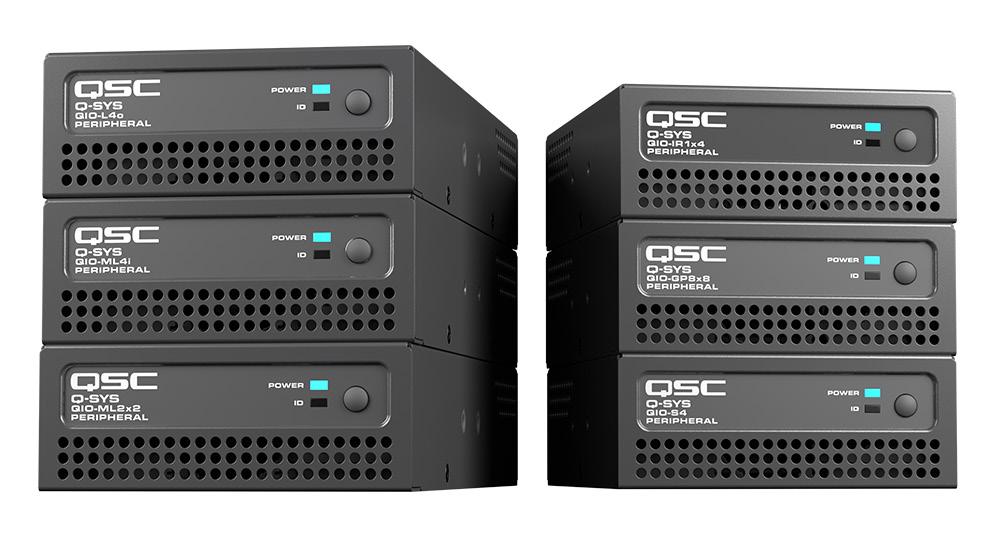
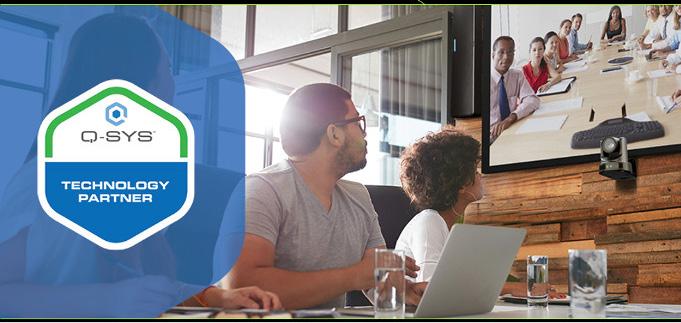
The partnership between Shure and Q-SYS is already fully operational. This is demonstrated by the numerous references collected at the global level, amongst which the project developed at the central Supercell site in Helsinki is certainly a prominent example. The large company, which is engaged in the creation of mobile video games (for example, Brawl Stars, Boom Beach and Clash of Clans) moved to the Finnish capital in 2022. Its new headquarters are located inside a building called ‘Wood City’, designed from scratch to reflect the company culture and to encourage well-being and a productive approach.
In the two largest meeting rooms, the Voice Lift system uses a combination of Shure MXA920 overhead ceiling microphones and PoE Genelec speakers, strategically positioned to slightly amplify voices, so that a person speaking on one side of the room can be heard at the same level by someone on the opposite side, and even at a distance of 30 metres. Furthermore, the entire audio component is managed by a Q-SYS processor and then transferred to the speakers.
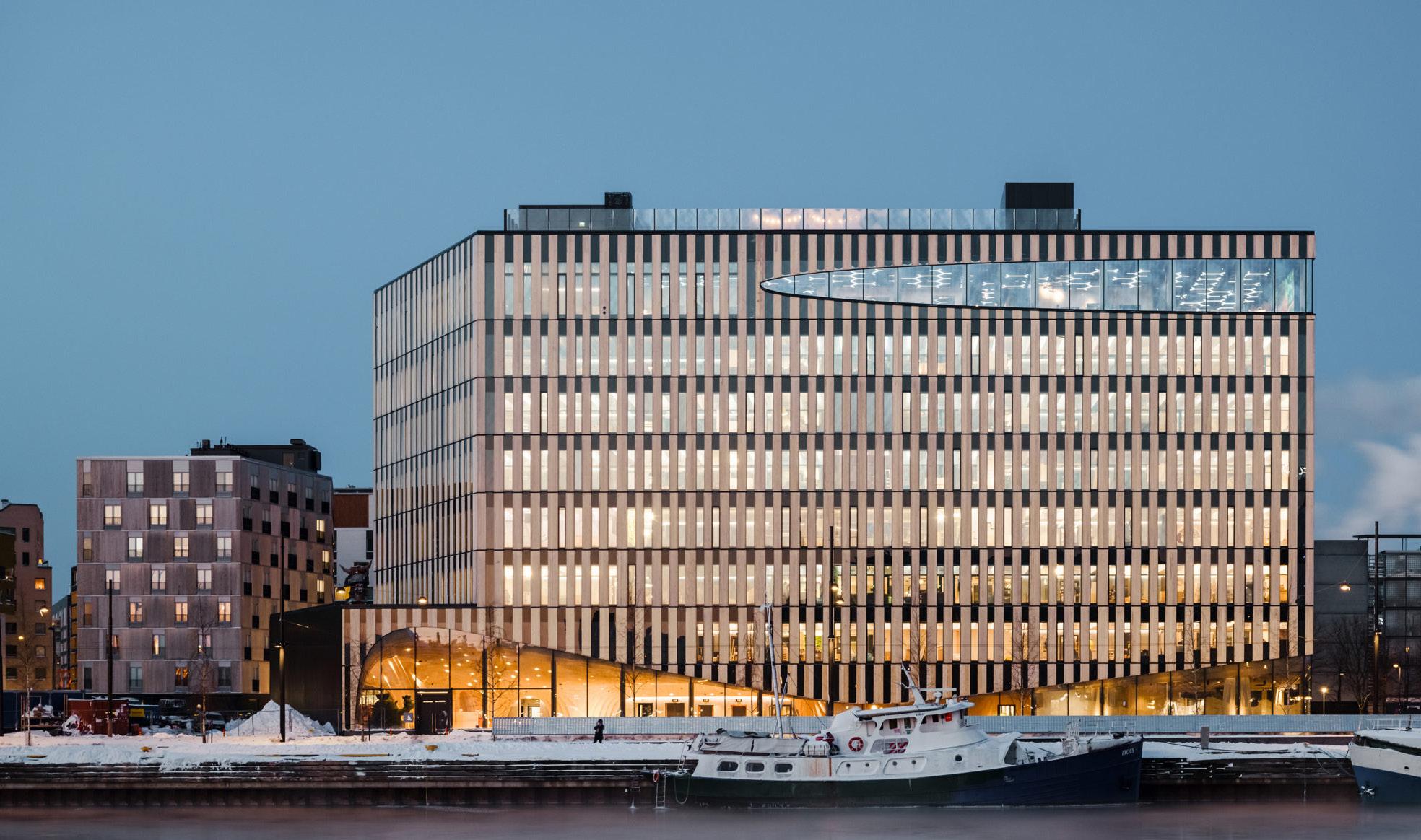
Ilaria Rebecchi

The event will take place on 14 and 15
November
2024 and professionals active in the sector of innovative, sustainable and smart building should certainly take note of the dates and plan their visit
On these two days the third edition of the Smart Building Levante M editerranean International Trade Fair for Technical Systems and Facilities and Construction 4.0 will be held in the city of Bari. This event, which occurs every two years in the Southern Italian ‘Mezzogiorno’ area, represents an important opportunity for companies and experts active in the sector specialising in the introduction of new solutions and technology for buildings and urban planning. The November event will be an important visibility platform for manufacturers, specialists, designers and integrators of solutions and technologies for home automation and the creation of ‘smart buildings’ and for the designers of urban ecosystems.
Attention will focus on the innovation of technical systems and facilities, security systems, renewable energy, lighting management, climate control, the manufacturing of doors and windows, digital-era urban planning and novel ‘construction 4.0’ practices and solutions. Moreover, the most innovative solutions for professional audio video and a workshop dedicated to new technologies for the hotel and accommodation sector will also have a leading impact at the exhibition. A practically simultaneous event, partially coinciding with the Trade Fair (13-14 November), will also be held. For the special Bari Smart City Conference the relative scientific committee has identified the following topics: Digital revolution, Nature-based solutions,
Sustainable urban ecosystems and the Environment Sustainable Government (ESG) approach in urban areas. Guidelines will be provided for debates and conferences that will accompany the most important initiative in the eastern area of the Mediterranean region. Thus, in mid-November, administrators, consultants and technicians of Public Administration bodies, city managers, designers of companies and technical studios, system integrators, construction companies and the financial managers of Real Estate funds will be able to meet up at the Fiera del Levante with a view to sharing knowledge, exploring possible partnerships, learning about the latest developments in home technology and presenting smart innovations.
Three areas of interest have been established to offer an all-round 360-degree view of the world of technical systems and facilities and structural engineering, construction and smart urban planning, with particular attention dedicated to changes introduced by policies regarding the decarbonisation of the sector and, primarily, the European directive on green homes. Home and building automation and system integration
The full range of innovation relating to internal technical systems and facilities of connected, zero-emission buildings and all of the new control and management systems introduced to lower levels of consumption and open up to the entire world of the ‘Internet of Things’ (IoT).
Security and safety
From anti-intrusion systems to access-control systems, and moving on to cybersecurity and fire prevention systems.
Construction 4.0 and Renewable Energy
Innovative materials, high-performance frames and fixtures, technologies for the production of renewable energy and new construction techniques for sustainable and increasingly standardised buildings.
Experience
Innovation is achieved by those who are fully capable of introducing new systems and methods. The ‘Experience Square’ is dedicated to those who want to form part of that elite group of technicians who will have to lead the digital and green transition in the coming years. The ‘square’ we refer to is a place where one can talk about solutions and products, in a concrete manner and in operational terms. The open stage and setting will allow for discussions between experts and the public, with the precise aim of dispelling doubts and perplexities and becoming familiar with the tools of innovation.
The Mission
In order to introduce novel technology or systems it is often simply not enough to know how we should proceed, and it is necessary to understand what is happening in one's own field of action and in complementary areas. The square dedicated to our Mission aims to illustrate the present situation, highlighting problems and suggesting solutions. Attention is paid to the current regulations and best practices
which may make a difference, indicating a path we can follow together.
Vision
Without a strategy we cannot embark on any particular endeavour and a sector that is entirely oriented towards the future cannot fail to have a compass. In the ‘Vision’ square we will present market data, reflections on the economic ecosystem within which everyone operates, innovative proposals that open up to a clearer medium-term vision in order to comprehend together where we are going and the reason why and how our work will change.
NEW TECHNOLOGIES FOR TOURIST
ACCOMMODATION SERVICES
14 November, Centro Congressi Fiera Levante
New technologies to support the concept of total quality in the hospitality/tourism sector
Hotels and tourism/accommodation facilities in general form one of the economic sectors highly interested in the use of new technologies applied to buildings and their occupants. The achievement of high standards in terms of energy efficiency, for example, not only has a decisive impact on management costs, but also constitutes an attractive factor for a clientele increasingly aware of environmental issues. Likewise, the quality of entertainment provided for hotel guests is certainly a distinctive element, and even more so if we are talking about structures that will host events and conferences.
15 November, Centro Congressi Fiera Levante
Digital&Green: the twin transition opportunities. The Apulia region is known for its very high production of energy from renewable sources (primarily, wind and solar). From the geological point of view it is also a territory which presents a very low level of occurrence of seismic phenomena. Moreover, the city of Bari is one of the fundamental nodes of the European digital infrastructure with its north-south and eastwest submarine ridges.
All of these elements naturally make Apulia an ideal location for new data centres, guaranteeing them a secure supply of green
energy capable of rendering one of the most energy-intensive infrastructures carbon neutral and ecologically sustainable.
‘SMART INSTALLER’ ASSEMBLY
15 November, Centro Congressi
Fiera Levante
From training to business: the first structured network of installation professionals in Italy. The Smart Installer community, which has been completely renewed following an alliance agreed upon in Milan last November between Pentastudio, CTA-Consorzio Tecnologie Avanzate and Smart Faber, will meet in Bari for the first time. The structured network is formed by almost 250 installation companies present throughout the national territory, which have joined the CTA Consortium and have adhered to the Smart Installer programme. This programme provides for a centralised system capable of ensuring the ongoing training of associated parties and business development through a targeted marketing activity. The meeting will be the right moment to present to potential stakeholders this network which presents itself as an ‘exemplary’ model at the national level, guaranteeing high-quality standards for consumers and important services and benefits for its affiliates.
The Present and future of Mediterranean cities
13 November 2024
Hall of the Architecture Department of the Polytechnic Institute of Bari
14 November 2024
New Levante Trade Fair - Congress Centre at Smart Building Levante
The second edition of the Bari Smart City Conference offers an important opportunity for debate and discussion on the sustainable development of urban areas bordering the Mediterranean sea. The topic of debate selected by a Scientific Committee subject to the supervision of the prestigious Polytechnic Institute of Bari is the ‘Present and Future of Mediterranean Cities’, with a focus on digital revolution, nature-based solutions, sustainable urban ecosystems and Environmental, Social and Corporate Governance (ESG) in urban areas.
www.smartbuildinglevante.it
Tel. +39 0444 543133
info@smartbuildinglevante.it
Chiara Benedettini
The Didacta Italia 2024 trade fair, which was held last March in Florence, saw the return of Smartbuilding.edu. The initiative aimed to provide ideas and solutions for the modernisation of Italian school buildings, making them more efficient and inclusive
Education is one of the most important fields of application of integrated technologies, and scholastic buildings in particular may benefit from interventions aimed at energy saving, intelligent resource management and automation, with advantages for the entire community. Located on the ground floor of the Spadolini Pavilion, the Smartbuilding. edu area, designed by Smart Building Italia and Connessioni and fully renovated with respect to the 2023 event, was a point of reference for teachers, the heads and managers of schools and technicians. In particular it pursued the objective of illustrating how new technologies can be integrated into schools to improve their energy efficiency, air quality, safety and inclusiveness. These topics were the subjects of interest of the companies present in the area, each of which is the ‘owner’ of an exclusive product: Air Control, Audiosales, Aura Immersive, Touch Window, Big Rock, H-Farm and the technical sponsors, Benq and Euromet. For the visitors present at this event the SB.Edu expo thus presented a gallery of best practices and examples of the best technological solutions for Italian schools. In fact, with the National Recovery and Resilience Plan (NRRP) Italy plans to invest 1.19 billion euro in the construction of 216 new school buildings and 4.9 billion euro for the refurbishment of existing structures. These funds are crucial for modernising schools, improving their sustainability and functionality, provided that they respond to the real needs of the scholastic system. A training room was also placed at the centre of the exhibition area where industry experts and representatives of partner companies held short seminars on various subjects. These sessions highlighted school-related technologies and were in line with the topics introduced in the area thanks to the participation of the exhibi-
tors. Participants were thus able to receive updates and acquire practical knowledge which they would be able to refer to in their institutions. Luca Baldin, the director of Smart Building Italia, commented on the underlying rationale: "We designed this exhibition area with the aim of offering a vision of schools that are ideal from the technological point of view. Each participating company has contributed towards the installation of an exhibition that clearly reveals how particular technologies can transform school buildings."
A focus on digital citizenship and cybersecurity
During the trade fair event SB.Edu also held a press conference with Aura Immersive, focussing on projects organised by the Italian Parents' Movement (MOIGE) and illustrating the relative data. In particular, attention was paid to a survey on the digital citizenship of students and risks relating to cybersecurity conducted in collaboration with the Piepoli Institute. The research underlined the need to educate students with respect to a fully-conscious use of digital technologies, and the important role of parents in the process of raising awareness on the part of minors.
Inclusion considered as a value
In addition to its participation in the SB.Edu project Audiosales presented the seminar The design of inclusive educational environments within the Didacta scientific programme, providing a valid contribution for teacher training. The architect Giovanni del Zanna explained how we should conceive accessible training areas - in terms of the actual spaces in question but also with respect to information and services - for the highest possible number of students, regardless of factors such as age, gender and the characteristics and types of disa-
bility, thereby facilitating inclusion. Donato Masci of Studio Sound Service proposed a focus on the link between sound perception, emotions and comprehension, which would represent the crux of inclusion in the case of persons who are deaf or suffer from a hearing impairment. The event instilled a strong sense of enthusiasm amongst the participants, who were not only teachers but also officials and the designers of technical offices and studios.
The company, well known for its high-quality audio systems, presented two brands: Contacta, specialising in loop audio systems for people with a hearing impairment, and Isinac, which provides sound-absorbing panels for the improvement of the acoustics of environments.
The 2024 edition of Didacta Italia achieved a record level of attendance with over twenty thousand visitors, marking a significant increase with respect to the previous year. With 1,780 events and 430 exhibitors, the trade fair confirmed its central role in the updating of the supply chain relating to Italian scholastic institutions.At the conclusion of the event Lorenzo Becattini, the president of Firenze Fiera shared his view of the results: “We are closing this seventh edition of Didacta Italia with a great sense of satisfaction. We have been stimulated by the very high level of participation and a strong sense of enthusiasm on the part of visitors and we shall certainly continue along this path. We are already working on the next events, including the first edition in the Apulia region at the Fiera del Levante in the city of Bari from 16 to 18 October and the next national-level edition which will be held in Florence from 12 to 14 March 2025.”
https://fieradidacta.indire.it
The Smartbuilding.edu exhibition area is divided into various sectors, each of which is dedicated to specific types of technology:
• Digital cultural mediation and multimedia: new solutions for the improvement of didactic interaction.


• Digital infrastructure and connectivity: networks and systems for permanent, ongoing connection within a school.
• Management and control: facility management platforms.
• Lighting design: technologies for efficient lighting.
• Energy efficiency and self-handling: solutions for the reduction of energy consumption.
• Physical security and access control: systems that will ensure the safety of students and staff.
• Air quality: technologies
Air Control, air sanitisation
Audiosales, distribution of multimedia systems
Aura Immersive, Environments of an immersive nature
Big Rock, youth training academy
H-Farm campus, venture incubation services
Touchwindow, Integrated digital environments
Sylvania, world lighting
SimLab soft, virtual reality software
VirtuaPoint, software for immersive lessons
Technical sponsors:
Audiosales, Benq e Euromet



Visiting and perusing the various Fuorisalone 2024 trade fair hubs during the Milan Design Week was like moving along a socalled ‘Möbius strip’: wherever you went, whatever itinerary one might decide to follow, a reference to the associated dimensions of Technology and Nature would always suddenly appear before us, albeit perhaps not always in an entirely appropriate manner ...

We should immediately remove any risk of a misunderstanding. Despite the veil of doubt we feel may be cast by the proposed relationship existing between the dimensions referred to in the title of this article, the Fuorisalone event remains an extremely positive experience. In every respect, for Milan, the Design Week always offers a unique opportunity to present to the public particular skills and talent. Moving around the city, following a route where we note a clear focus on design and innovation, is in fact quite a fascinating and engaging activity, and time itself may assume a somewhat different feel and become ‘dilated’. On the contrary, to some extent, it may be narrowed down if the Fuorisalone event is seen as a period in which visitors enjoy a splendid interlude ‘beyond time’ or, let’s say, a break during
which one may discover a new, rather different scenario, projecting us into the future and yet, at the same time, remaining well-rooted in the present. Having thus clarified that, once again, the Fuorisalone expo was a not-to-be-missed event for those who nurture a passionate interest in design and technological innovation, we may now take a closer look at some of the themes that emerged in this edition of the expo, offering a few practical examples. So, everyone, enjoy your trip as we follow the ‘twisted’ Möbius band!
Matter and sustainability: a spiritual issue?
In an event that has always been known for its variety and a vast range of different points of view that are presented, on the contrary this year we noted a certain degree of ‘compactness’, and a unity of purpose which - although partially dictated
by the theme chosen for the Design Week - was a bit tiring and fastidious at times. In the world of design and technological research there is in fact a tendency towards a strong focus on the concept of sustainability, and many projects have strived this year to delve more deeply into the relationship between sustainability and the use of materials, considering the former as a virtuous necessity and the latter as a necessity, pure and simple, which the human world cannot ignore or do without. Every object, every building and each element of interior decor is produced using a particular material and we ourselves are formed by matter itself. However, it is as if the designs presented at the ‘Fuorisalone 2024’ venues have the purpose of drawing us towards a tangible rediscovery of the undeniable spiritual dimension of our human reality. It would at least appear that the underlying rationale suggests that spirituality - associated with our existence, our dwelling place and our work - presents a greater degree of sustainability than matter. So, perhaps we should cultivate more intensely
the spiritual side of our human existence. So, before us, we now encounter the flourishing presence - and often in the literal sense, given a constant focus on plants and trees - of installations which would tend to 'realign' our perceptions through an invitation to come into closer contact with Nature, perceived as an uncontaminated environment that has to be fully respected. We should indeed stimulate the growth of the natural world, within which we ourselves, as human beings, can grow and develop. Visitors at the expo are occasionally invited to participate and engage in pure reflection, as may occur in the interesting installations presented with the titles 'Materia Natura: a Conversation with Portanuova', situated in Piazza Gae Aulenti, in the heart of the most ‘green’ district of Milan, and 'Materia in Movimento', curated by Seiko at the Spazio Formentini location in the Brera district. 'Materia Natura’ (lit. ‘Matter - Nature’) was moreover the established essential theme of the Fuorisalone 2024 event. Hence our decision to start our journey at the 'Conversations
with Portanuova' site in Piazza Gae Aulenti, an immersive installation occupying a space in which five totem-mounted videos present an investigation into the relationship occurring between humans and the environment, depicting various factors and elements of our impact on Nature and inviting visitors to respond to a few questions. No questions were asked, but a lot of attention was placed on the four essential elements of Nature - Earth, Air, Fire and Water - in the 'Matrex Natura’ installation, which marked the debut of Buoninfante, an Italian manufacturing company operating in the mattress sector, at the Fuorisalone event. At the Foro Buonaparte in the centre of Milan the company presented its line of hi-tech X-BIO mattresses.
Visitors were certainly offered an immersive experience engendered in particular by video recordings that drew the attention of the public towards the archetypal elements of the natural world. These elements provided a source of inspiration for the X-BIO series, which specifically aims to unite Nature and Technology.
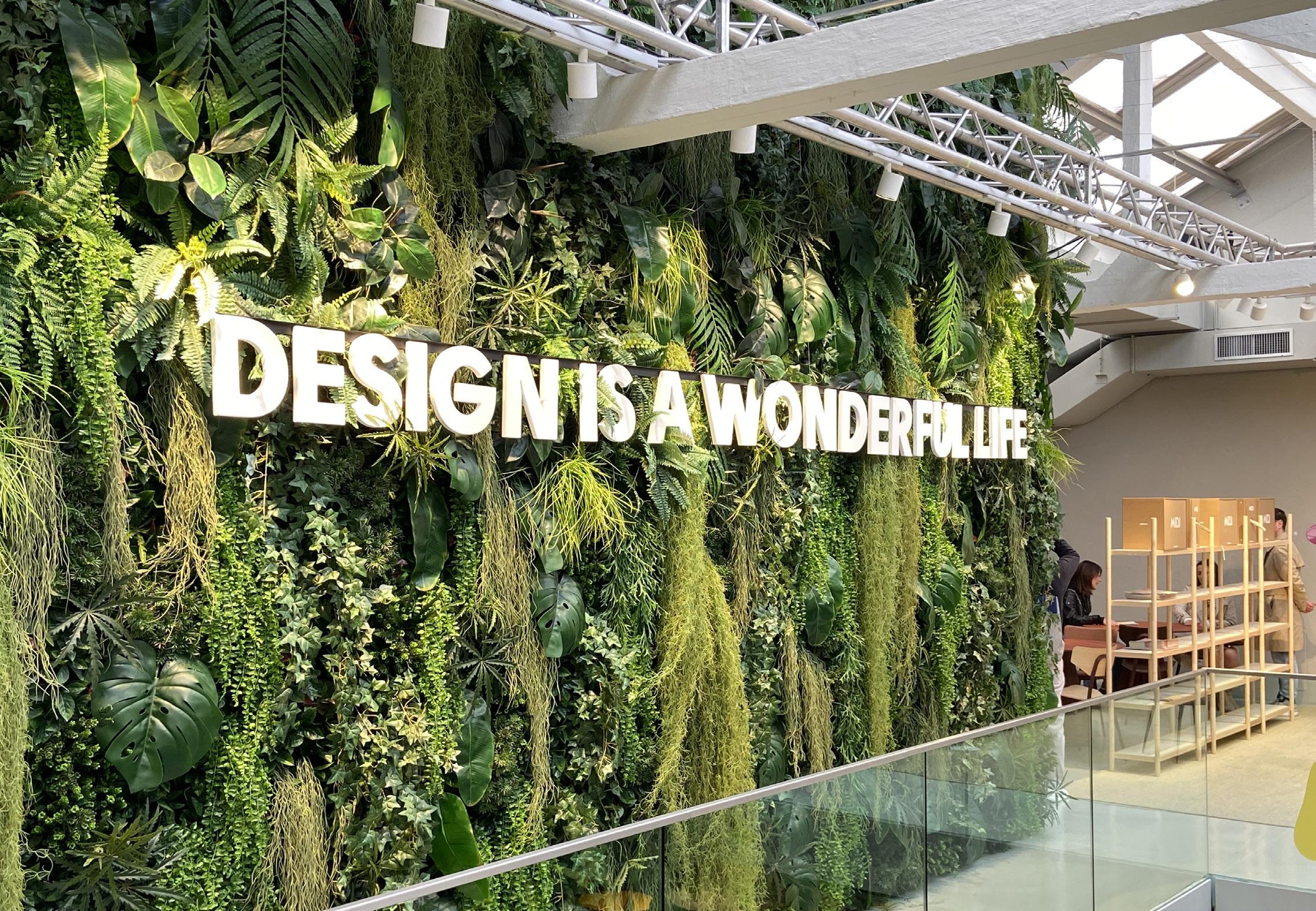

An authentic birch wood was installed at the fascinating Spazio Formentini site in the Brera district by the famous watch brand Seiko in order to once again underline the message - perhaps somewhat wantonly misused - that conveys a sense of the need to return to Nature, and suggesting a realignment of our perceptions and life-time experiences.
During the Fuorisalone expo event whichas previously mentioned - was dominated by a focus on ‘Nature and Matter’ an effort was also made to reflect on the various forms natural materials may assume, and which constitute the basis of every design.

The via Tortona and via Savona area is always a stimulating district thanks to the great variety of products presented and a focus on particular themes, from transparent photovoltaic glass for buildings produced by Onyx Solar to the Nature's Canvas, a fascinating showcase of works by Corian Design, offering an immersive experience that presents an innovative collection of colours and a range of aesthetic phenomena inspired by natural scenarios, from cliffs to gently flowing streams of water, from vegetation to the natural terrain. In particular, the interesting ‘dOT’ (‘design - Outdoor Taste’) event held at Piazza San Marco, a location transformed in an ad-hoc manner into a mosaic of proposals relating to ‘fluid living experiences’ in interior and exterior settings, was certainly worthy of note. In particular, the blending and, at times, the (deliberate) merging of interior and exterior settings, as a conceptual point of reference, appeared to emerge with a certain degree of clarity at the 2024 edition of the Fuorisalone expo venues. This was evident at multiple installations, including the 'Cross Vision' exhibition set up in a courtyard of the State University, with a kaleidoscopic overview of designs advocated for the present and for the future, and hastily conceived intersections of forms and matter that seem to pose questions rather than provide answers, suggesting possible paths, however
without actually following any of them. But then, all things considered, this element in particular is perhaps one of the vital aims of an event such as the Design Week: to present ideas, suggestions and insight. Moreover, this may even occur in an unrefined manner. Only time will tell and eventually reveal to us what is destined to be and what is not. However, the curious initiative entitled 'Il Migliore Spreco’ (The Best Waste) is certainly worthy of note. In via Verdi, immediately behind the Teatro alla Scala opera house, the South Korean company Peelsphere became engaged in a generous and concrete attempt to promote sustainable innovation, presenting a series of objects and garments (including shoes,
light-fabric scarves and jackets) featuring innovative bio-materials. Seaweed, fruit peel and coffee are in fact used as basic materials in the manufacture of products such as these, and may constitute as much as 30-35% of the fabrics or materials required. Aesthetics and a redefinition of the relative materials may be seen as essential and, literally, tangible factors in this approach.
Light as an integral element of design Regularly present at the Fuorisalone event, ‘light’ was once again a well-vaunted subject of interest this year at several very interesting installations. Re/Creation, present in the setting of the Palazzo Isimbardi,

is by far the most fascinating installation and has the merit of focussing the visitor's attention on the use of molten glass, redefining the relationship between glass and architecture with Lasvit's interesting creative works. However, also worthy of note are the stimulating ‘Shapes of Lights' and 'The Light You Are' exhibitions - both of which are presented by Masiero - in the heart of the Brera district and, above all, the 'Bruma' exhibition, in the central Via San Maurilio, at which Giopato presented a new collection of lights made with artisan-crafted glass. The light products are characterised by carefully-crafted glass, having effects - in this case - truly capable of drawing technology and the natural dimension closer together or, at least, of integrating technological capacity and human skills. The presentation of works produced by the firm Masiero, however, occurred at two separate installations, at hubs located quite close to each other in the Brera District. The exhibitions were conceived as a means to present the firm's new collections, specifically created by the MILO studio for the Fuorisalone 2024 event. 'The Light You Are' exhibition underlines Masiero's capacity to propose in its catalogue a wide range of lighting solutions, offering a variety of designs, materials and special characteristics. The products are designed with an intentionally ‘transversal’ style. The show also reflects the company's ability to produce tailor-made, customised lighting solutions. 'The Shapes of Lights' exhibition proposed light, ‘rhythmic’ geometrical elements, and presented



an innovative and yet classic approach in the design of lighting solutions. The products reveal a full awareness that light is to all intents and purposes an element of design and - despite its dual corpuscular and undulatory nature - we may consider it an 'element' that can be used and shaped.
By virtue of the theme proposed this year for the Fuorisalone expo, centred entirely on the relationship between Matter and Nature but also focussing on the theme of environmental sustainability, the large automotive brands could not miss this event held in Milan. Not surprisingly, these entities have taken advantage of the stage offered by the event on numerous occasions to present future prototypes or to stimulate and enrich the discussion concerning sustainable mobility. This year - and to an extent surpassing that possible on previous occasions - we were able not only to see electric vehicles. Visitors also had an opportunity to reflect on authentic experiments relating to design and materials. As usual, a leading role was played by the
Audi brand, which once again presented its 'House of Progress' expo in the setting of large spaces available at the Portrait Hotel premises along the elegant Corso Venezia. The magnificent installation was curated by the Bjarke Ingels Group (BIG) international studio and was designed to emphasise the value of avant-garde technology and solutions in the world of mobility. Furthermore, the famous car manufacturer presented a world-premiere exhibition of its Audi Q6 e-tron electric SUV, the first model based on the new Premium Platform Electric architecture.
The exhibition entitled ‘Forma - Feelings designed by Ducati’ organised by the famous motorcycle company was definitely very interesting. Present for the first time at the Fuorisalone event, the firm held its show at the premises of the 'Leonardo da Vinci’ National Museum of Science and Technology. The endeavour to combine beauty, emotions and technology has resulted in a transformation of the actual concept of a motorcycle, whereby it is endowed with features that are more artistic than technological.
The Catalan automobile brand Cupra also
focused on the exaltation of particular materials with which a car may be produced, with its innovative and fascinating proposals on view at the central Corso Como venue. Entitled 'The rebel side of design', the highlight of the Cupra exhibition was the Dark Rebel, a concept car created thanks also to the contribution of the brand's fans and exhibited in Piazza XXV Aprile, right in front of the company showroom.
BMW also adopts a forward-looking approach with its 'Future of Joy’ by BMW Design project presented at the showroom located in via Montenapoleone, at the centre of the Fashion District, focussing on the secrets of automotive design and in particular a new sports sedan, BMW Vision Neue Klasse, which is obviously an electric, digital and sustainable vehicle.
From a patriotic viewpoint, let’s say, we might conclude our overview by drawing some well-deserved attention to a project by Italdesign.
The 'Ace of Spades in Motion’ design concept was presented in via Tortona.
As a world preview the exhibition illustrates the principles of the new design philosophy of the company, with a full-scale

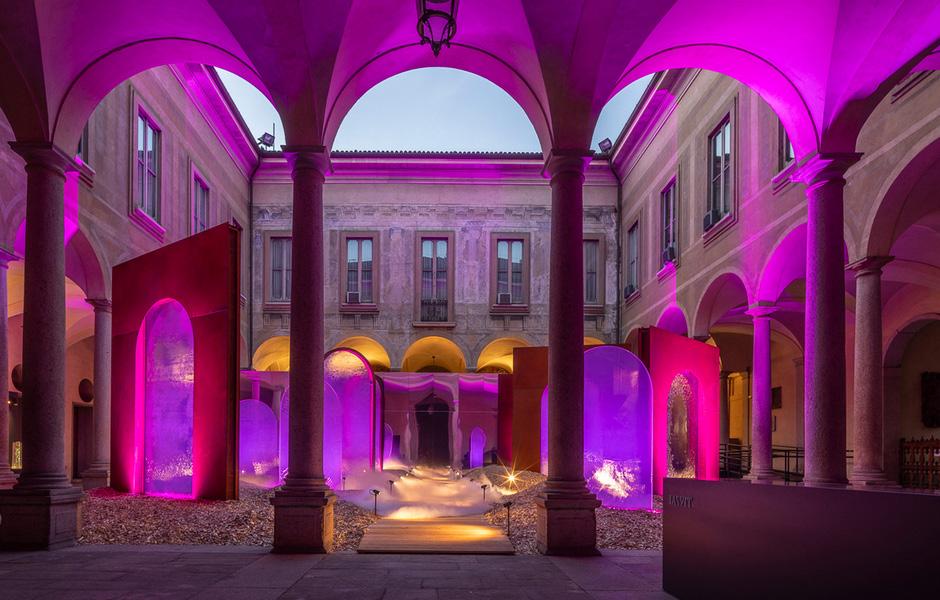

Fascinating Installations, Even if Not Always Provocative: This is Also, and Above All, the Fuorisalone!
‘concept car’ model, and celebrating the fiftieth anniversary of the Italdesign Ace of Spades prototype which was introduced way back in 1973 at the Frankfurt Motor Show. In this way we may note that, despite the numerous futuristic visions, the world of design also transmits messages from the past and can influence current research and the question of sustainability, thanks also to the choice of new eco-sustainable materials.
In short, this year's Fuorisalone show was literally dominated by a particular theme. Quite frankly, this had not occurred over the years in all of the previous editions of this splendid event, which attracts visitors to Milan from all over the world. While we find nothing wrong in the fact that so many companies and brands have chosen to invest in particular issues closely related to the future and the environment, we might suggest that an inflexible monothematic approach would appear to be excessive. Basically, rather than the question of technological innovation per se it is as if the brands are interested simply in emphasising subjects of concern, inviting people to discuss matters relating to sustainability and the environment.
This much-vaunted focus on the natural dimension, in certain cases, seems to be rather self-serving or somewhat specious and, rather than stimulating a comparative analysis and debate, it would be capable of rendering all the installations quite similar to each other. This is why we spoke about a Möbius strip, the topological figure in which - in a rather mysterious way - it becomes possible to modify the appearance of an object or an element along a closed path without our realising it, and without it being possible to determine which side we are moving on. Moving around the hubs and spaces of the Fuorisalone exhibition this year was a bit like sliding along a smooth, never-changing, fairly enigmatic and complacent surface, along a path where every particular point resembled all of the others, conveying a sense of harmony of intent. This would certainly be an admirable feature but this kind of dimension may not always actively stimulate any great interest on the part of those present.
Well, between you, me and the gatepost, dare we suggest that the environment might have been improved by a touch of hale and hardy provocation? We look forward to seeing you again next year.
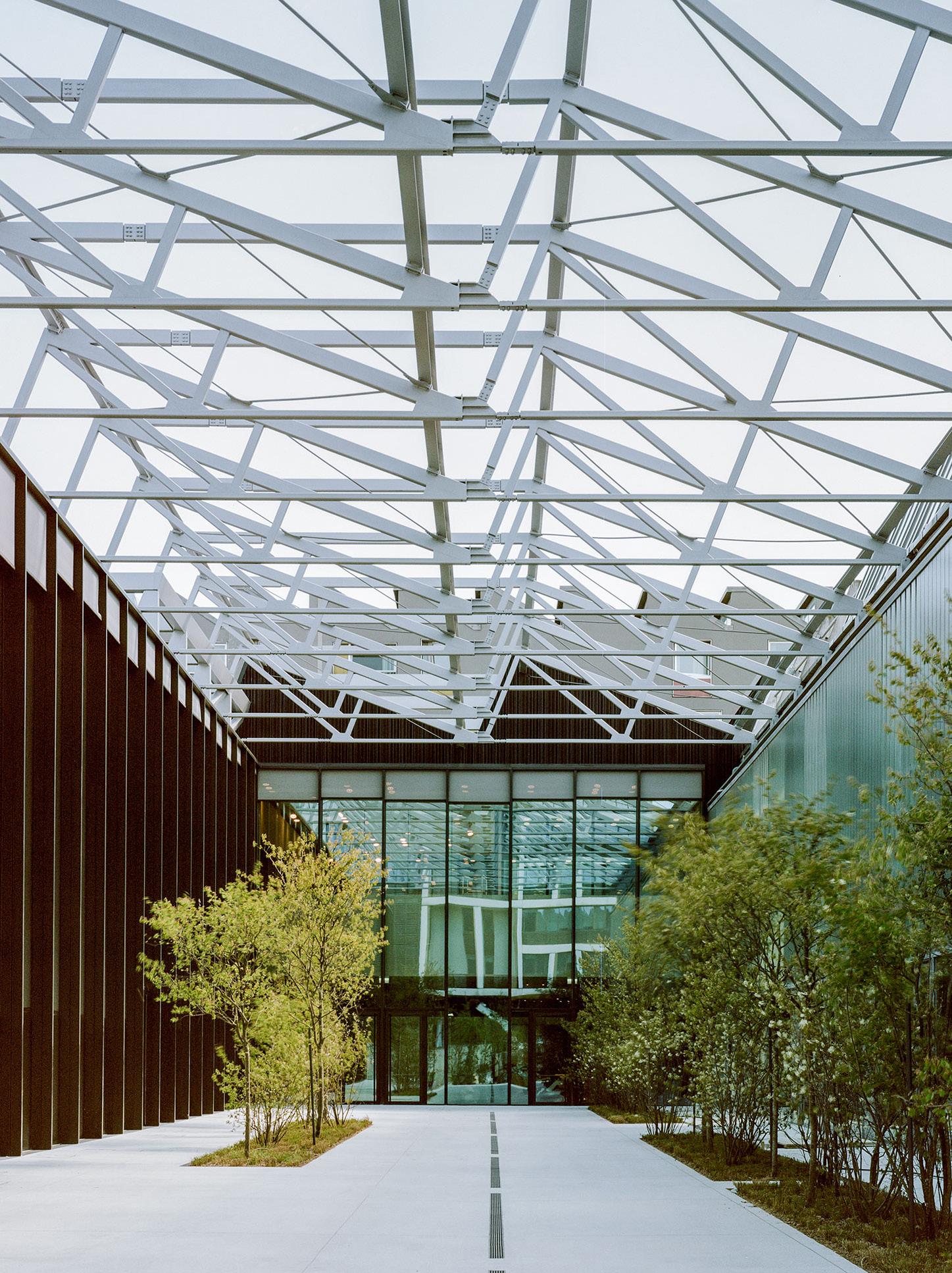
Chiara Benedettini
Undoubtedly, press trips allow a direct experience and forming a firsthand impression through privileged access to information, and also creating friendly relationships with colleagues and companies. Yes, the press trip with the Harman Professional Solutions, which took place between April 23rd and 25th to visit the Martin production site in Pécs, Hungary, was all this
The itinerary involved ten journalists arriving in Budapest on the morning of April 23rd, followed by a long bus journey through forests and fields to Pécs.
The trip also allowed us to get to know each other better with the other colleagues from editorial offices from across Europe and the United States, and to talk a bit with David Glaubke, Director of Global Corporate Communication at Harman, who welcomed and accompanied us throughout the trip.
I had already been to Pécs many years ago, and I found it much changed: the impression of a small provincial town gave way to the feeling of a new, modern, lively city, a fitting prelude to the visit the following morning to the Martin Lighting factory. The first step was a comprehensive presentation by the three people who accompanied us: Ben Payne, Sales Director, Lighting - EMEA, on the company's business and strategic production themes, Henrik Kristensen, Product Manager,
Stage Lighting, involved in Martin production for almost 30 years, and András Dobre, Senior Manager, Production and Process Engineering, the referent person for the production site.
The presentation was useful for focusing on the evolution of Martin's productions and anticipating some of the themes we would soon come into contact with: the long history of the brand, acquired by Harman in 2013, the entirely in-house design, the highly technological vocation with the employment of over 70 engineers in the two R&D offices in Aarhus (Denmark, in the historical headquarters) and Shenzhen, the phases of design and realization of the products, all under the lens of meticulous checks - over 70 measurements and analyses - which start from the inspection of incoming components, to the moving parts, electronics, and end perhaps only with the blanket test and then a sample test of the products now ready.
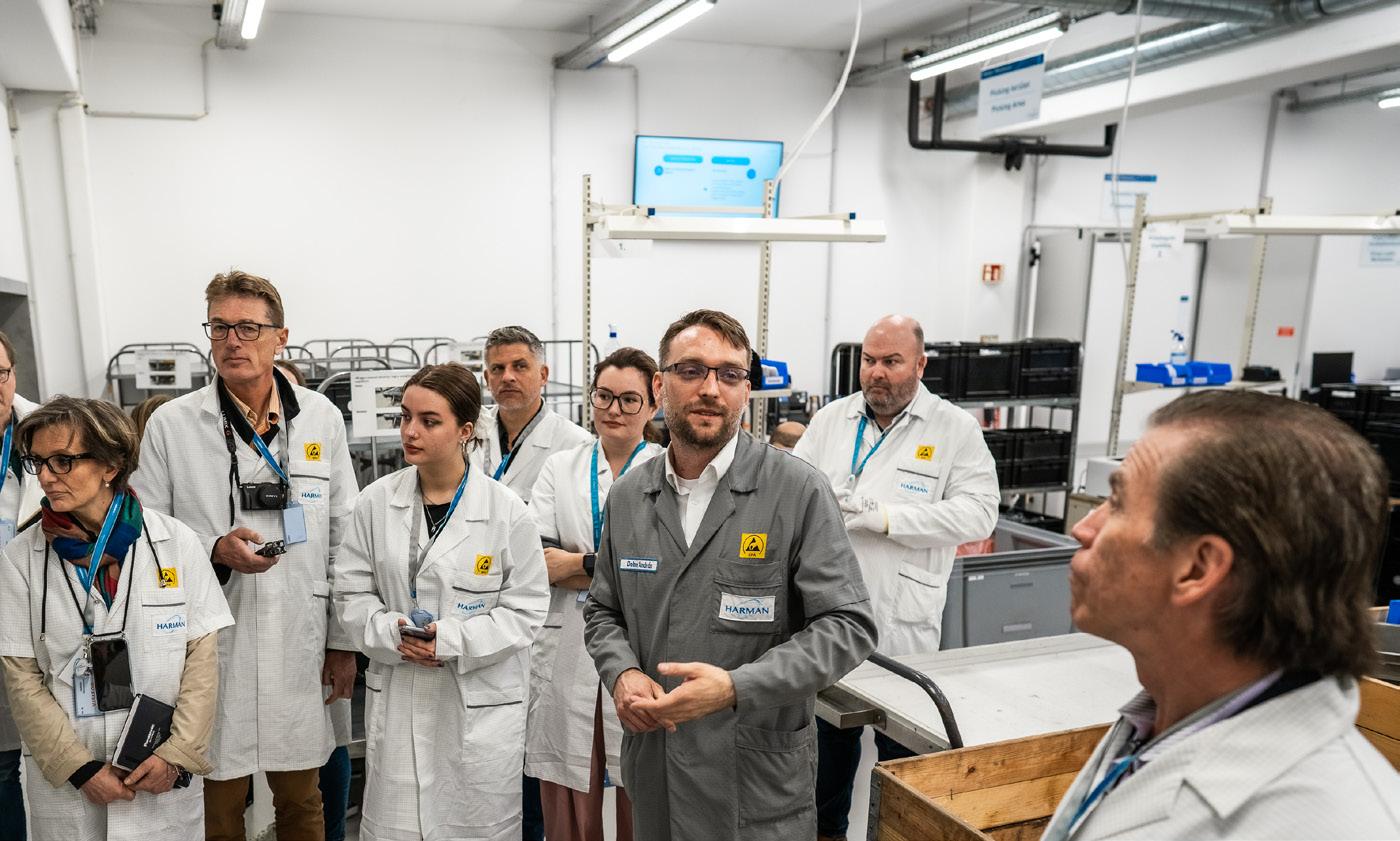


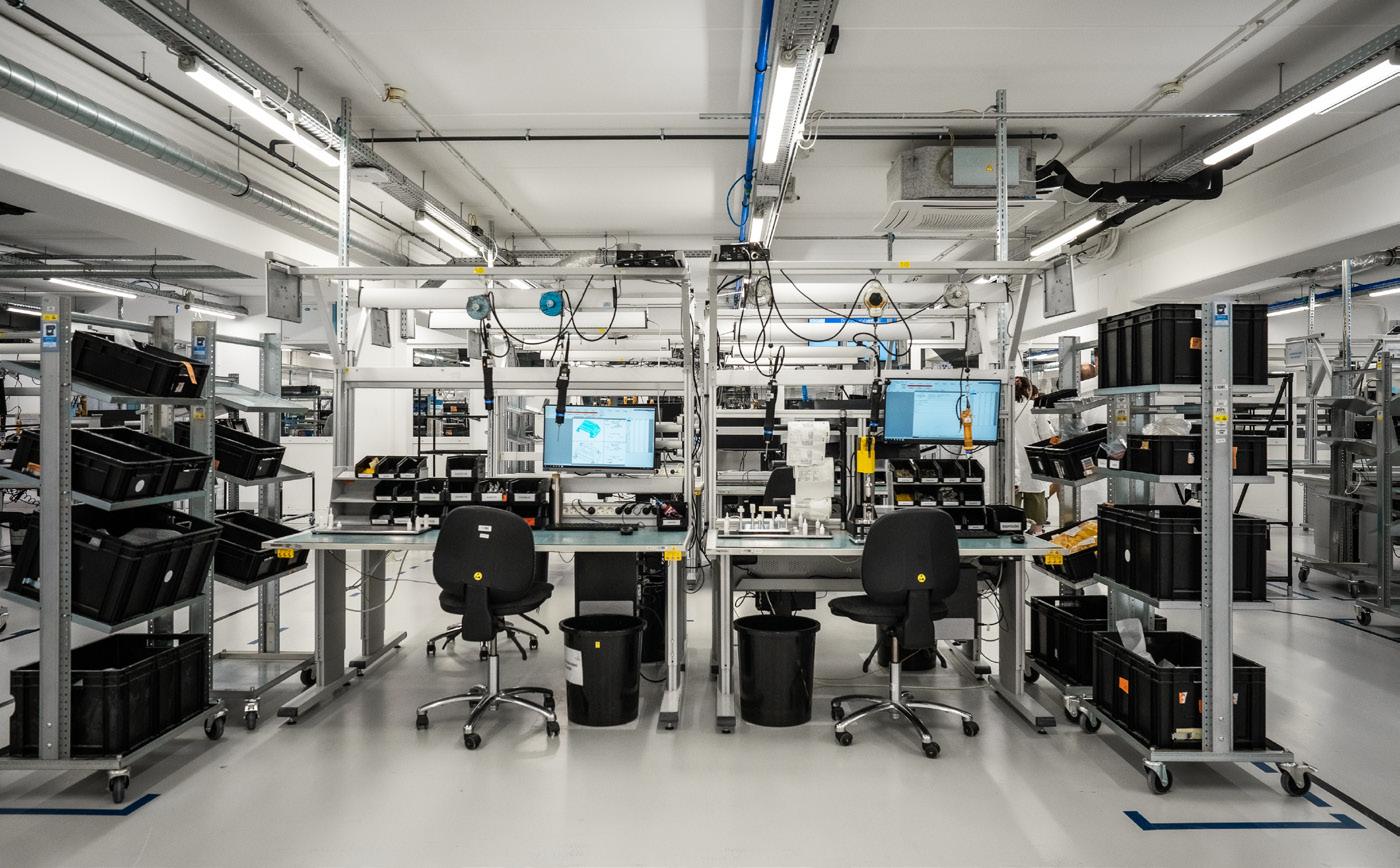
Harman Group's various production sites are divided between Mexico, Brazil, India, China, and, of course, Hungary. But how does a product in Martin come about? Ben Payne answers: "Naturally from constant listening to the market's needs: from dialogue with our customers and partners, attending international meetings and fairs... it's continuous work." Another important question came from the audience of journalists: "Why did you open a factory here?" In 2015, Harman had already decided to relocate the Frederikshavn factory to Pécs, but it was in 2023 that they inaugurated the facility we visited.
Previously, production was in a space shared with the automotive sector of the company, but the need to expand production capacities for the Martin brand, especially for Mac One and the upcoming Mac Viper XIP, drove the move. Moreover, the company already had contacts, suppliers, and a thriving industry in this region, not to mention environmental considerations.
The facility is air-conditioned using geothermal energy, and by 2024, electricity supply will be entirely sourced from solar panels, with aspirations to become carbon neutral by 2040. These are significant motivations for a company that has recently published its Sustainability Report.
And indeed, the impression received from the visit is of an organized, efficient, cutting-edge place not only in production but also in the many aspects that accompany it: shipments, warehouse management, material handling, packaging, etc. We are, in fact, explained that everything is
Harman Group has production sites in Mexico, Brazil, India, China, and Hungary. Ben Payne says their products are developed based on market needs and customer feedback.

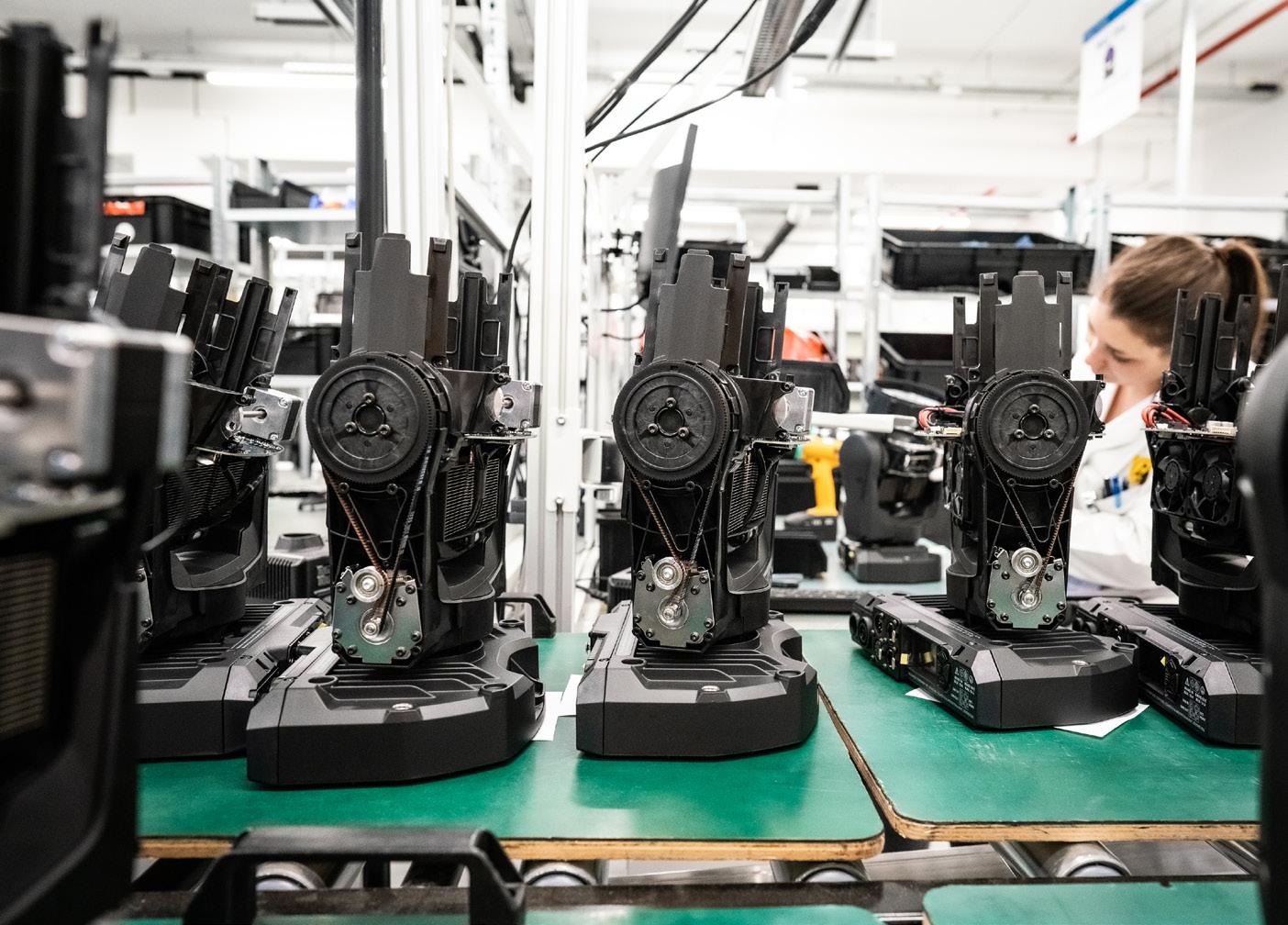

organized to rationalize operations to the maximum, maintaining those high standards of accuracy that will be a guarantee for the goal: products in line with the brand's quality, with standards, but also "return-proof".
After donning white coats and passing through security turnstiles, the visit took place through over 20 stages, to see all the steps of the production of the wellknown MAC One XIP (launched precisely in 2023) and the very recent Vipers XIP: from the rigor of the warehouse to the division into production areas - assembly of metal parts, arrangement of electronics, placement of optics, wheels, and color effects, etc. - to the impeccable organization of workstations, organized in series rationally so that screwdrivers, welders, components, and materials are within reach.
There are also break rooms, on each floor, creating areas for socializing among colleagues. Is it easy to find specialized labor for such a specific job? "We always receive a good number of applicationsHenrik Kristensen explains to us - and we directly deal with training. Usually, new apprentices start with simpler tasks and, after a certain time, are moved to other departments, not without having taken an exam to access the next level. This morning too, we had exams. We invest directly in our people, and they usually stay with us willingly, the work is varied and valued."
Among the last stages visited, the laboratory for the final check of performance to evaluate, both through instruments and measurement, and through empirical observation by specialized personnel, the uniformity of light emission, the precision of effects and colors, graphics, up to the evaluation of the mechanical arm, subjected to a rigorous "stress test".
Heading towards the exit, here is the packaging section, where new packaging solutions are experimented with both for flight cases and for traditional transport: molded cardboard housings, but also expanded foam and more sustainable solutions.
Last step: shipping, which can be addressed directly to customers or distributors, or to the two global sorting warehouses located in Denmark and California.
Heading home
Three hours have passed and time has
flown... back in the main hall and after removing the coats, refreshed by Harman's excellent hospitality, our bus took us back to Budapest, many of us already busy jotting down notes or notes from the morning visit. During the journey, there were also a few words with David Glaubke: "For us, it was a great logistical commitment, and we are happy to be here: the Pécs factory is a flagship for us, it meant large investments in terms of innovation, productivity, but also green choices in line with company directives. And then it was a pleasure to meet many of you whom I have the opportunity to see, and often very quickly, only during trade shows." On our side, thank you to Harman who wanted to invite Connessioni to this interesting experience, and it was indeed as promised: the opportunity to deepen, understand, discuss face to face with people and receive firsthand information is priceless!


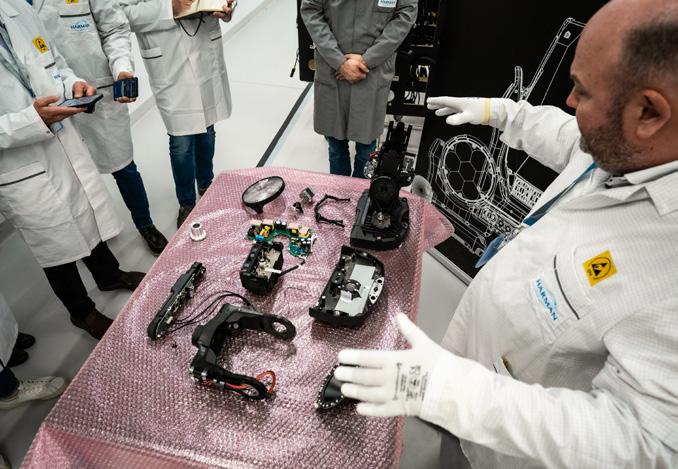
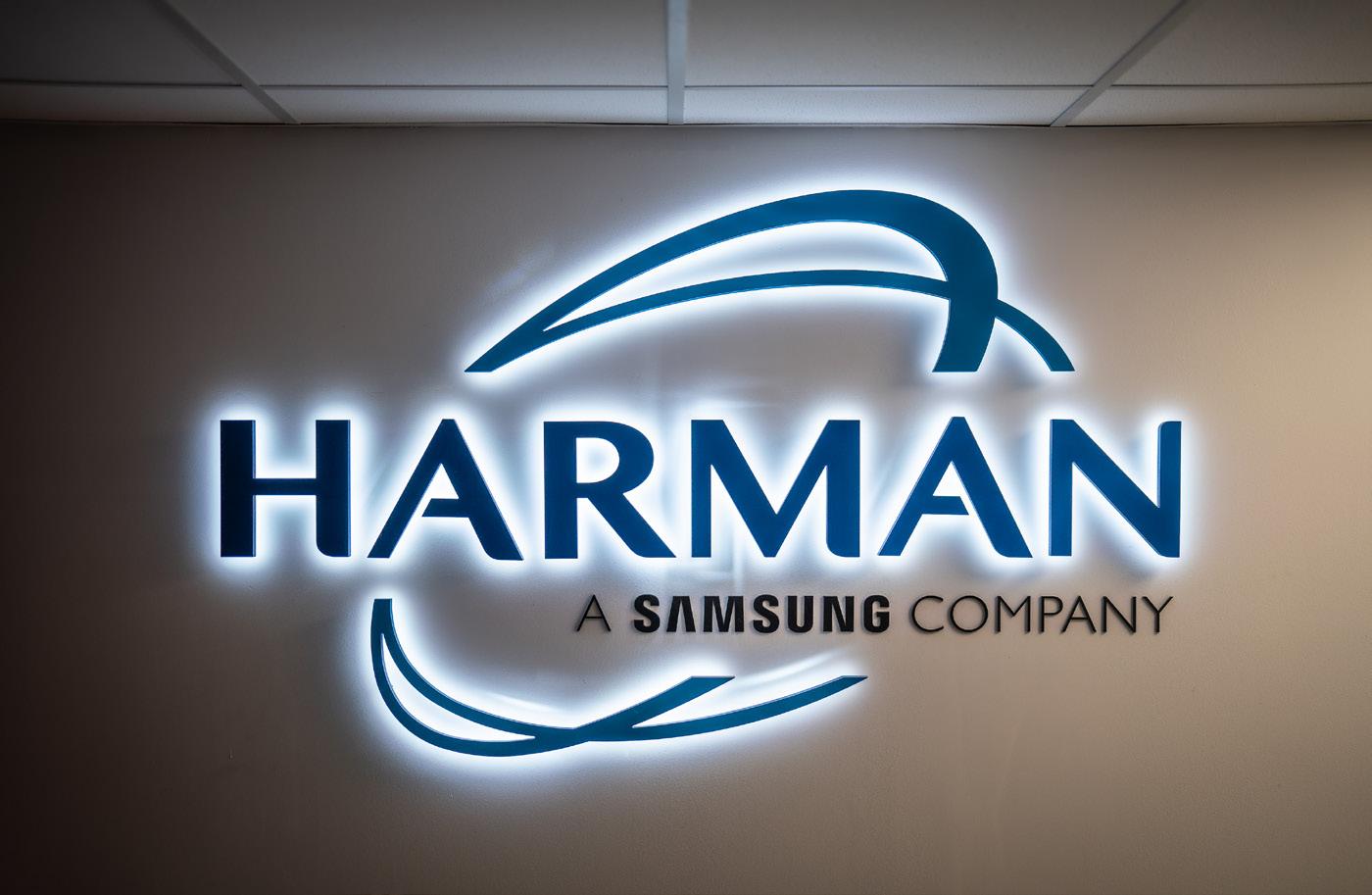
Martin Professional (Harman Professional Denmark ApS) is a Danish manufacturer and distributor of event lighting, architectural applications, and special effects based in Aarhus, Denmark. Founded in 1986, in 2001 it was acquired by the Danish industrial company Schouw, which had expanded production with a new factory in Frederikshavn and outsourced part of the production to China in Zhuhai. The positive trend was mitigated by the crisis in 2008, during which Martin reacted by applying LED technologies to its products, thus giving rise to MAC 350 Entour, MAC Aura, and MAC Viper. In 2013, Harman International Industries completed the acquisition of Martin from Schouw, relaunching the company, putting lighting at the center of the business (the M-Series controller range was sold to Elation), and introducing, among others, the MAC Ultra series, MAC Aura XIP, and new solutions for architectural lighting including the Exterior Linear Pro LED bars. www.martin.com/en




Iulia Popescu, Coordinator, Digital Content, AVIXA
In this article, we pay homage to the ever-evolving world of virtual production
Advances in the film industry are closely related to technological advances. So, it’s no wonder that technology has deeply impacted filmmaking, from pre-production to post-production. In this article, we pay homage to the ever-evolving world of virtual production – looking at where it started, where it is today, and what its future might look like.
Virtual production has been on everyone’s lips in the film industry for a couple of years, but like all technology, it didn’t simply poof into existence overnight. Let’s trace the incremental steps that brought us to the likes of The Mandalorian and more. Virtual production is an umbrella term given to a whole suite of techniques, including motion capture, green screens, LED volumes, pre-visualization, and any content production with tracked 3D computer graphics, which have been driving progress in filmmaking since its inception. Filming actors against a large LED screen displaying distant or non-existent locations has its roots in front- and rear-pro -
jection techniques. These projection techniques attempted to recreate atmospheres with a projection, where the location and actors were recorded at different times. Chroma key technology, commonly known as blue and green screen technology, first gained popularity around the 1930s. Filmmakers initially used blue screens instead of green screens, as blue was more popular for TV production. Eventually, green screens would gradually replace most blue screens in Hollywood. In the early days of filmmaking, these screens were often used to produce mattes, which were utilized to combine two different scenes. For example, special effects artist Larry Butler, used the "blue screen traveling matte" technique in The Thief of Bagdad (1940)
Over the years, green screens have expanded to include much more. But the problem with blue and green screens is that they reflect those colors onto the talent. In most cases, it requires careful lighting and post-production processing to eliminate the color spill. Additionally, computer graphics-based
virtual production is not new. The early use of CGI can be seen in movies such as Tron (1982) and The Abyss (1989), where computer-generated elements were combined with live-action footage. However, the concept began to take shape with the rise of digital filmmaking tools in the 2000s.
Currently, the big trend in virtual production is using LED volumes. The technique combines real-time game engine animation using Unreal Engine, LED screens, and tracked cameras to deliver visual effects shots live and in-camera. Unreal Engine allowed a massive breakthrough: real-time rendered, photo-realistic CG backgrounds. If you’ve watched The Mandalorian, you’ve already witnessed the power of in-camera visual effects using LED volumes and virtual production in action. Many other shows and films have since followed suit.
With the evolution of technology, actors nowadays perform against an LED wall –replacing the famous green screen – that displays the virtual environment, which


the production team generates and manipulates in real time. Instead of actors performing in real-world locations or green screens, they perform in front of a giant volume of LED panels with animated backgrounds that respond to the camera’s movement with accurate parallax.
Many recent major productions have been reconfigured to be partially or entirely shot on LED volumes, including Star Trek: Discovery, Thor: Love and Thunder, and Bullet Train. The technique allows filmmakers to
adjust lighting, camera angles, and other elements on the set as well as during production, giving them more control over the creative process.
As virtual production progresses, it grants filmmakers more freedom to actualize their artistic visions.
There are boundless ways that virtual production can evolve (and is already doing so). Advancements in technology are likely to make virtual production more integrat-
ed with other filmmaking techniques. Some trends shaping its future include real-time rendering, expansion into different genres, and more accessible tools. As a result, virtual production will permit filmmakers to produce more innovative and creative projects while offering greater flexibility and efficiency in the production process.
The future looks bright for indie filmmakers as well. Virtual production is not just limited to big-budget Hollywood productions. It has made it easier for indie filmmakers to work with smaller budgets while producing dazzling results, leading to many independent filmmakers exploring and embracing this technology. As technology continues to evolve, the involvement of artificial intelligence in video production is also revolutionizing how videos are created and edited, pushing the boundaries of creativity and visual storytelling. What do you think the future of virtual production looks like?
www.avixa.org
Fiera Internazionale dell'integrazione tecnologica per l'edilizia e l'urbanistica
19 | 20 | 21 Novembre 2025
Fiera Milano Rho
